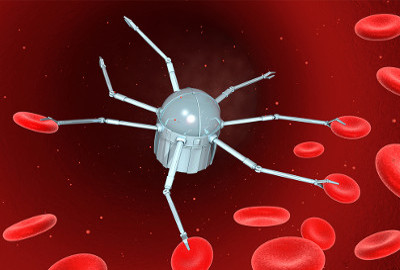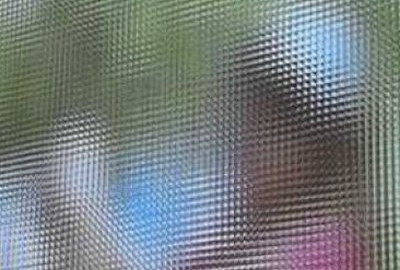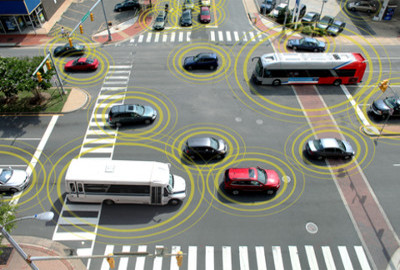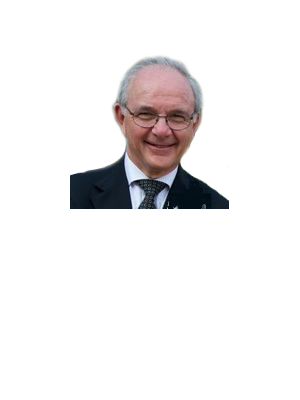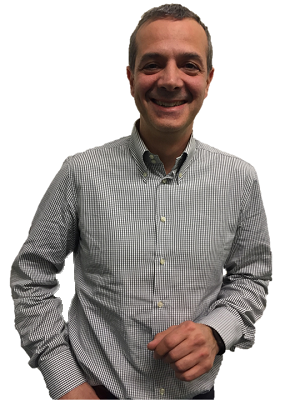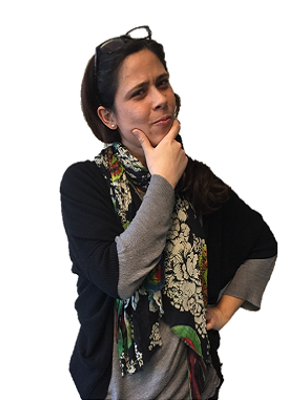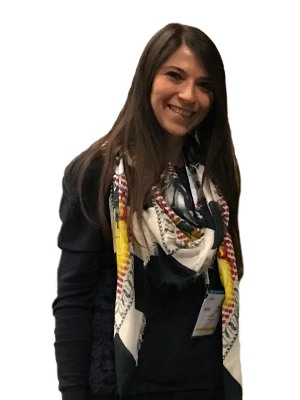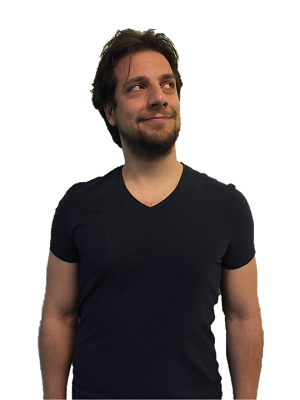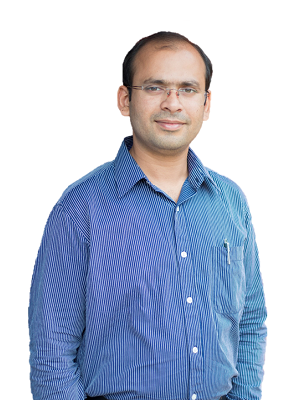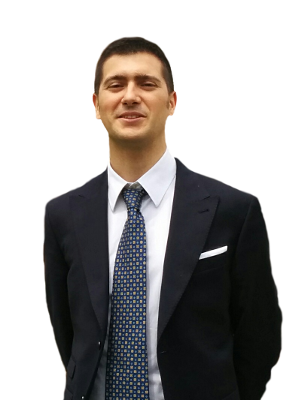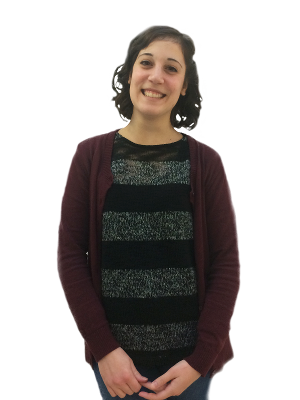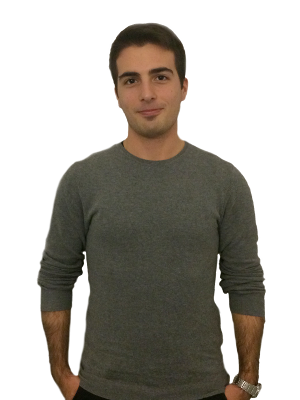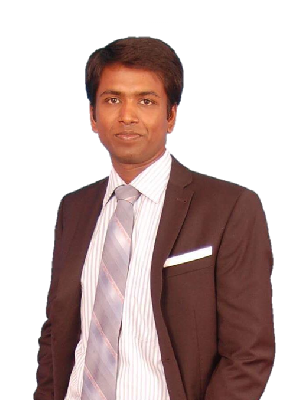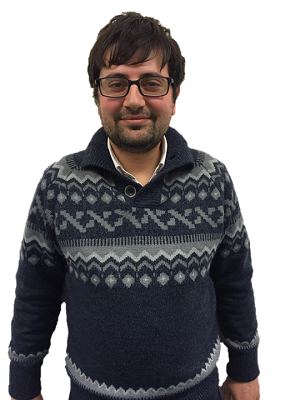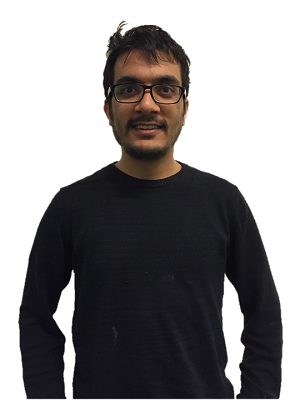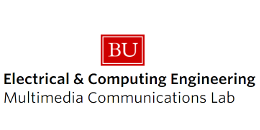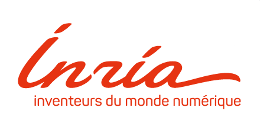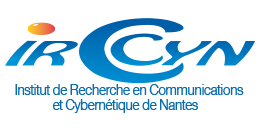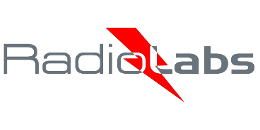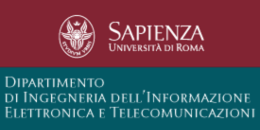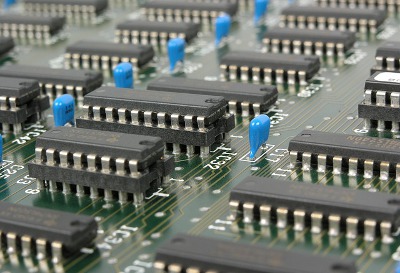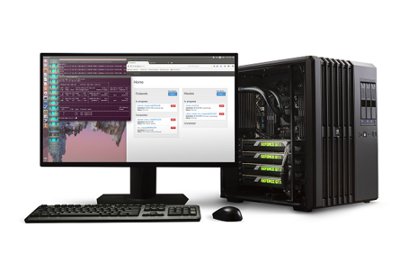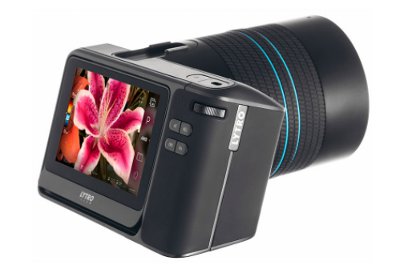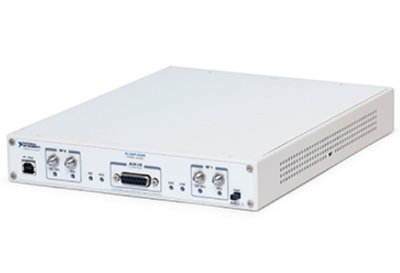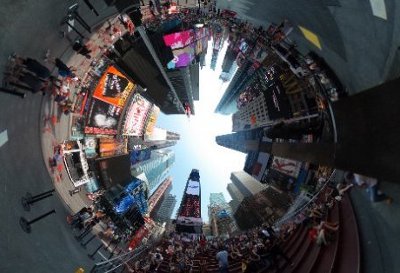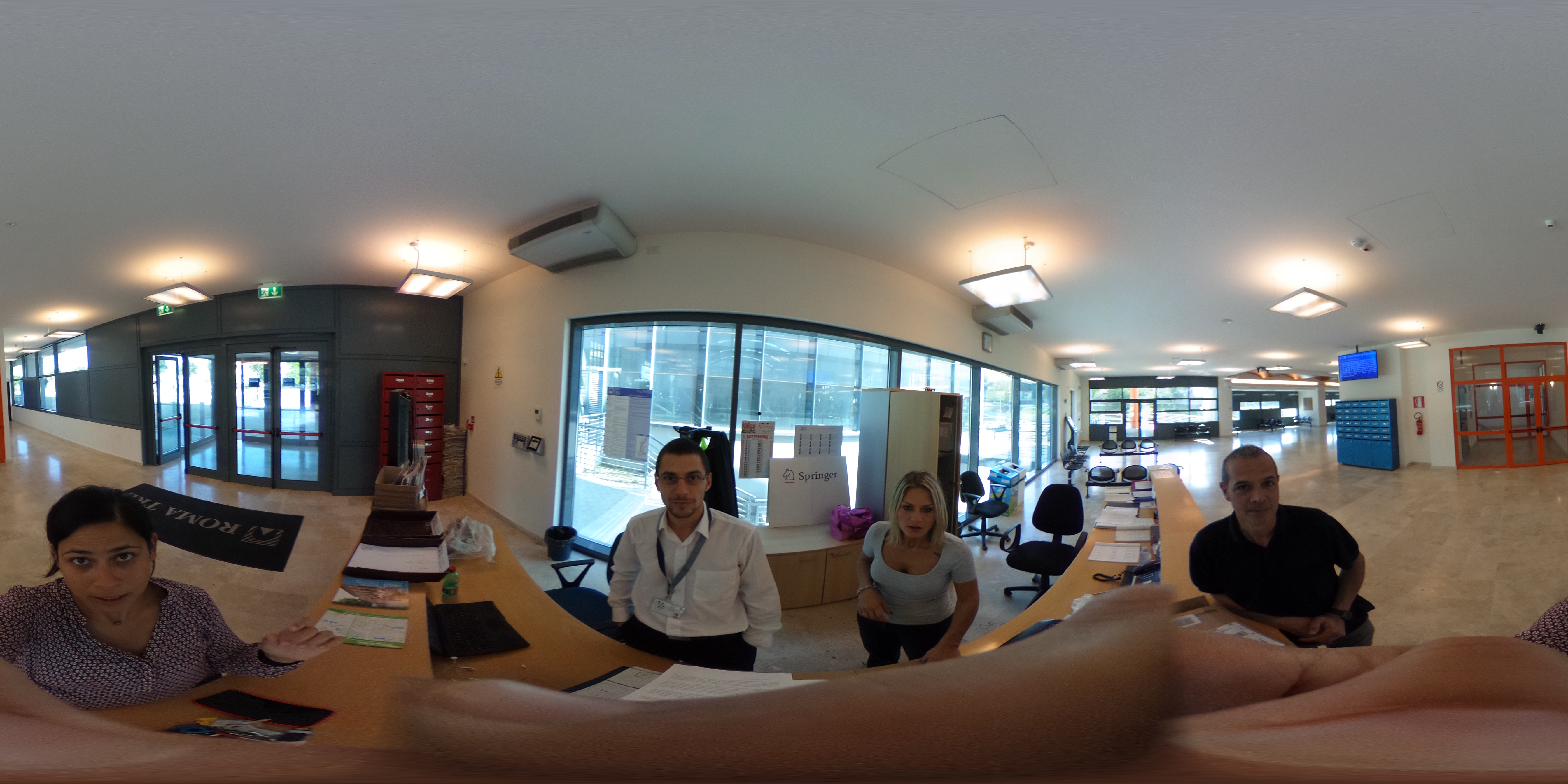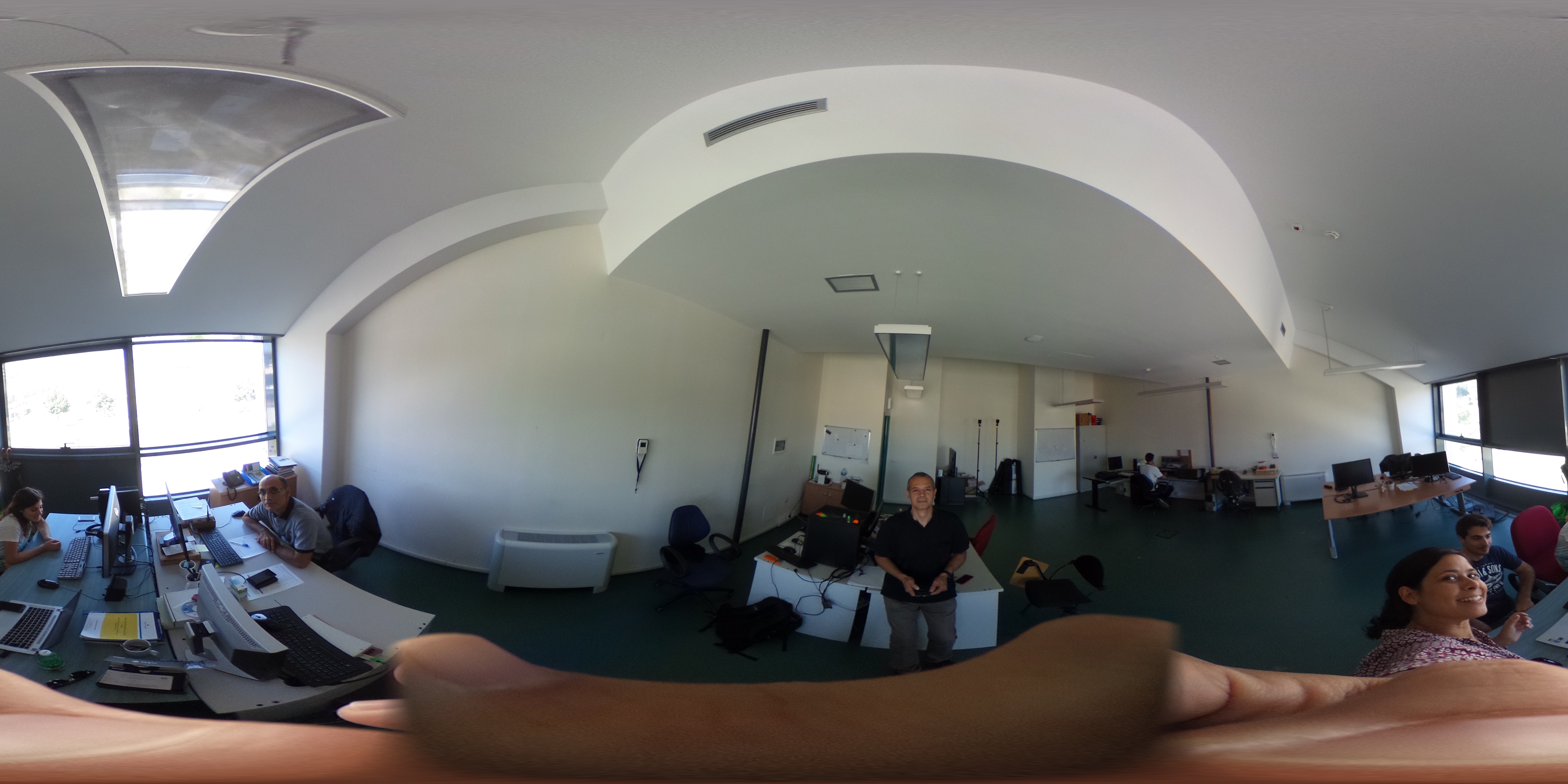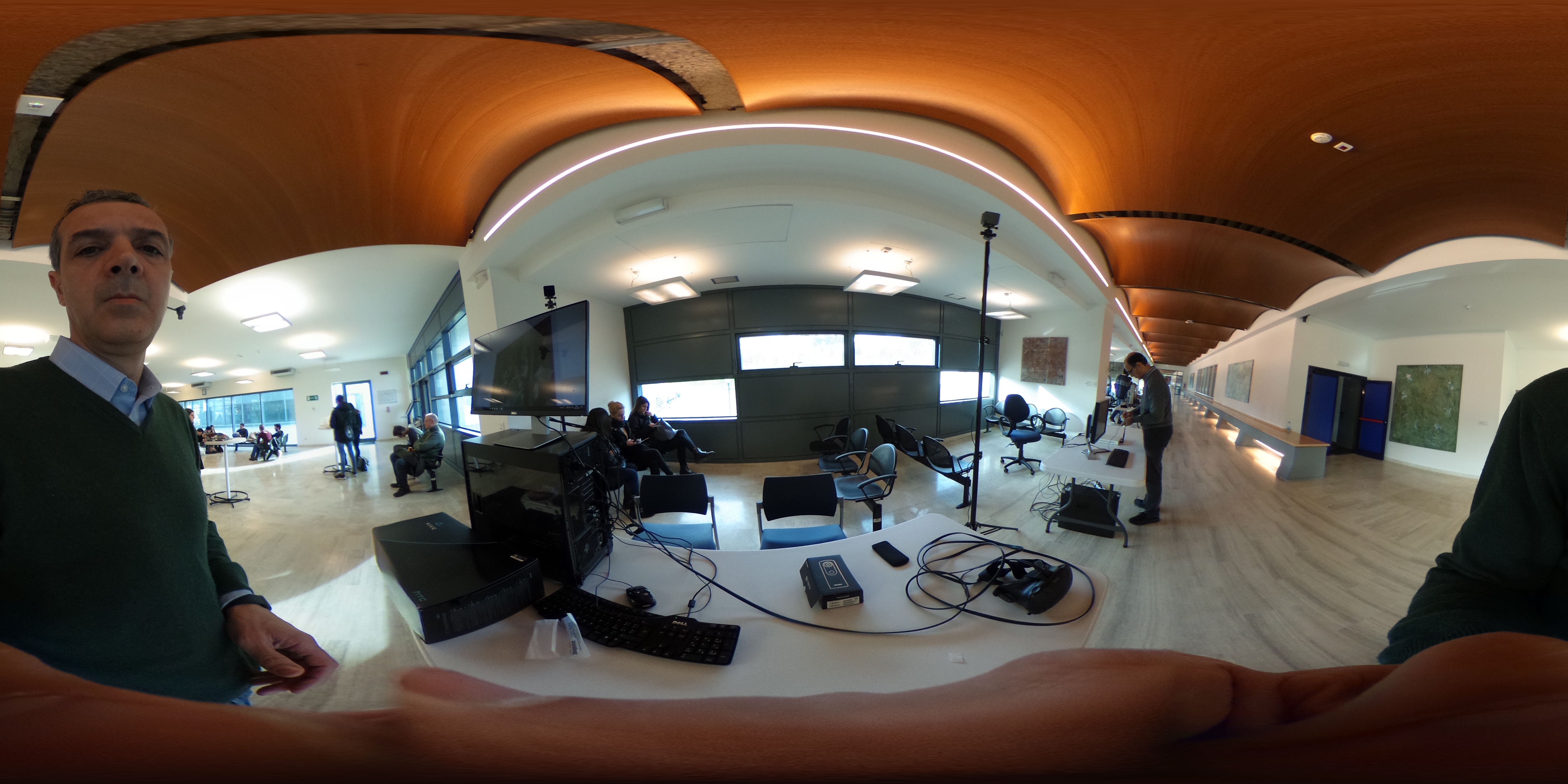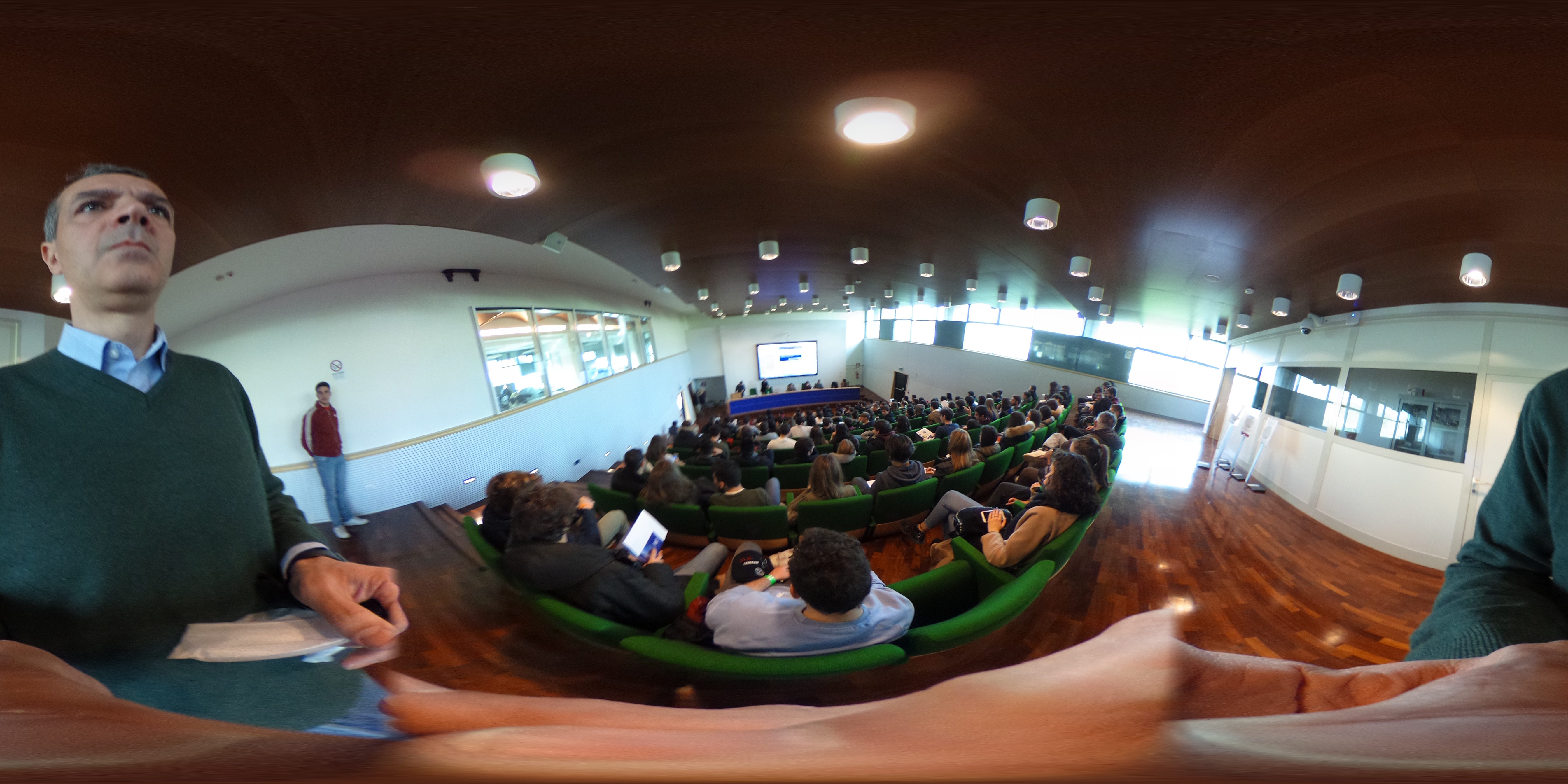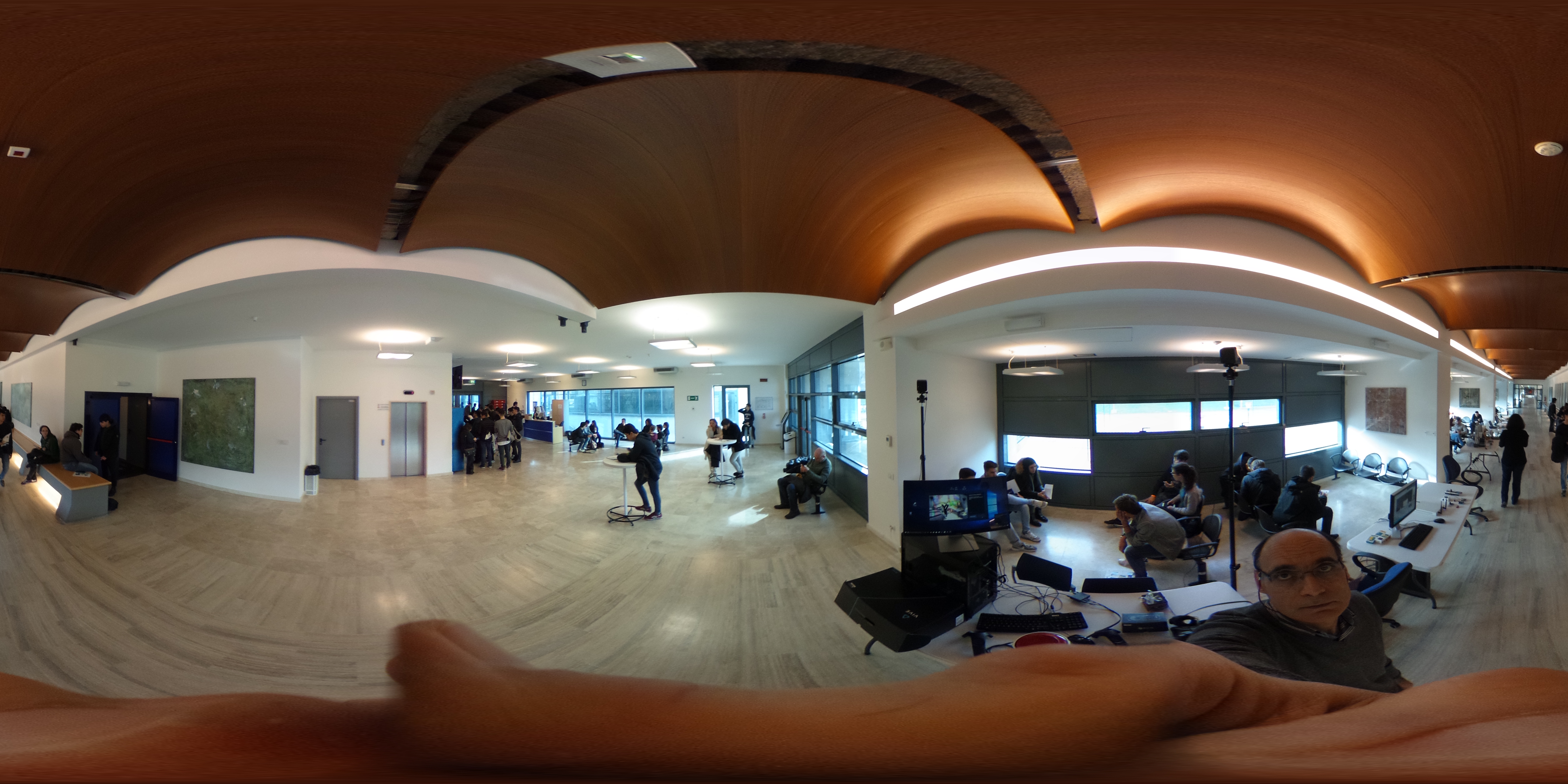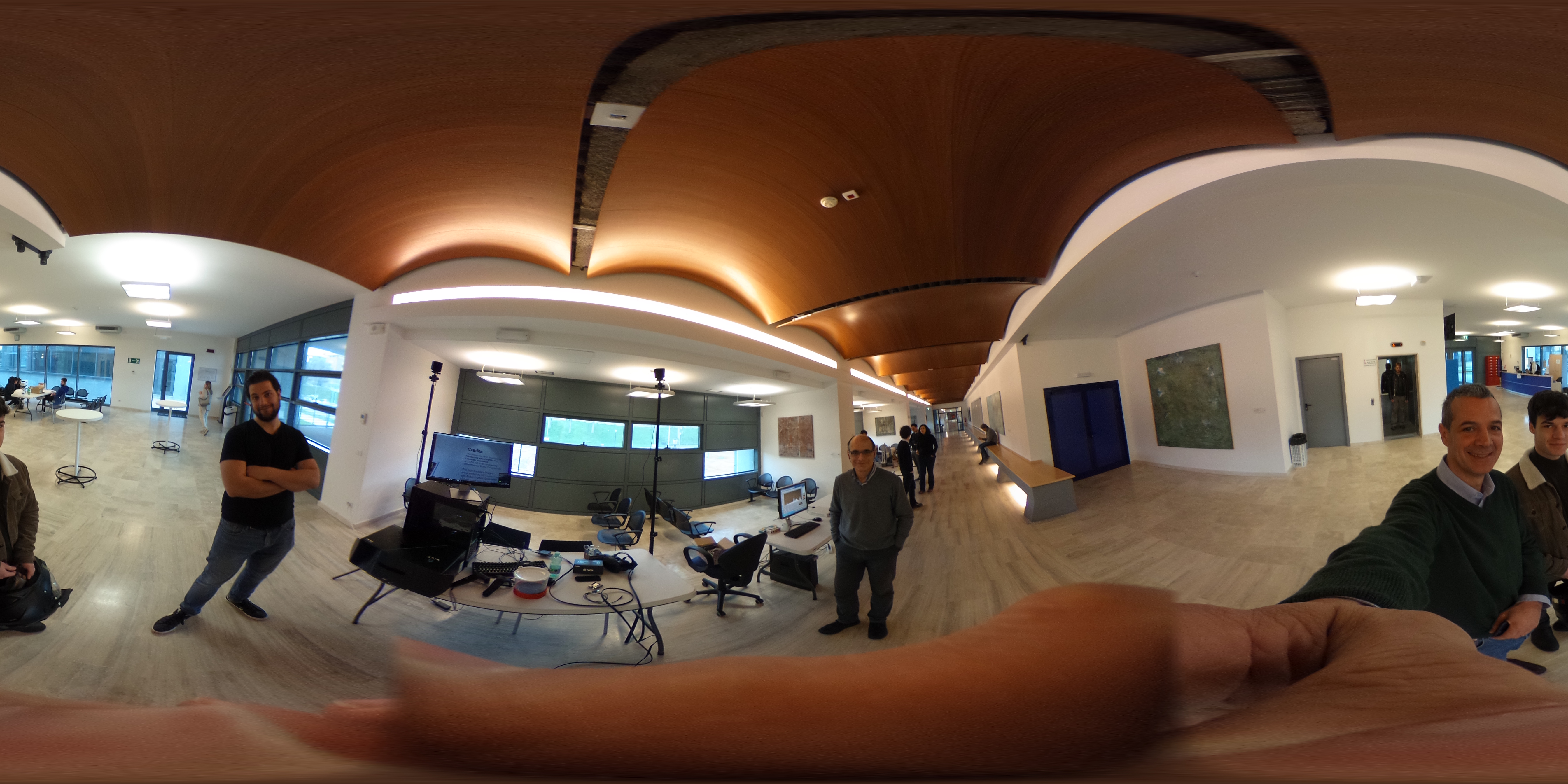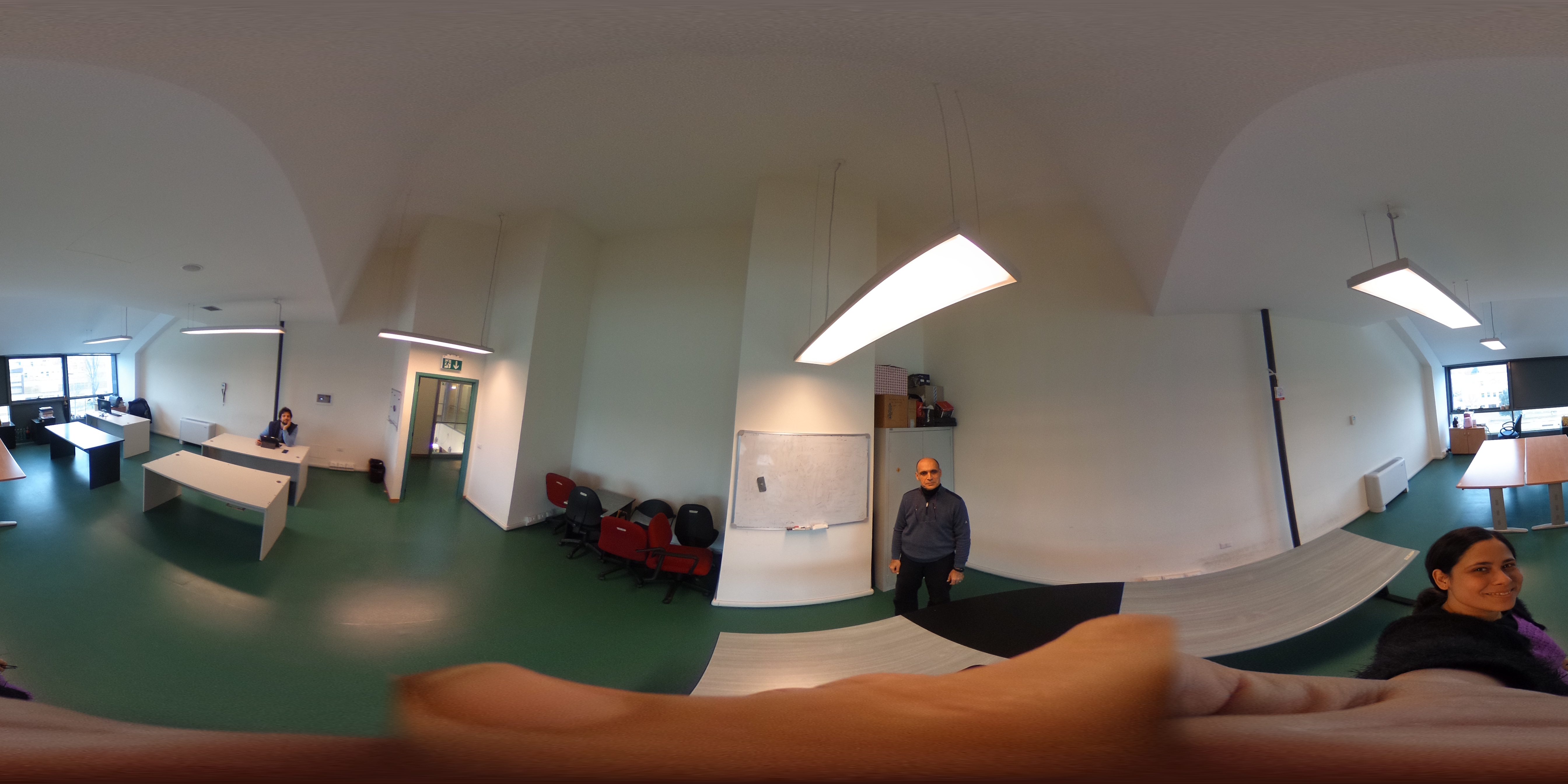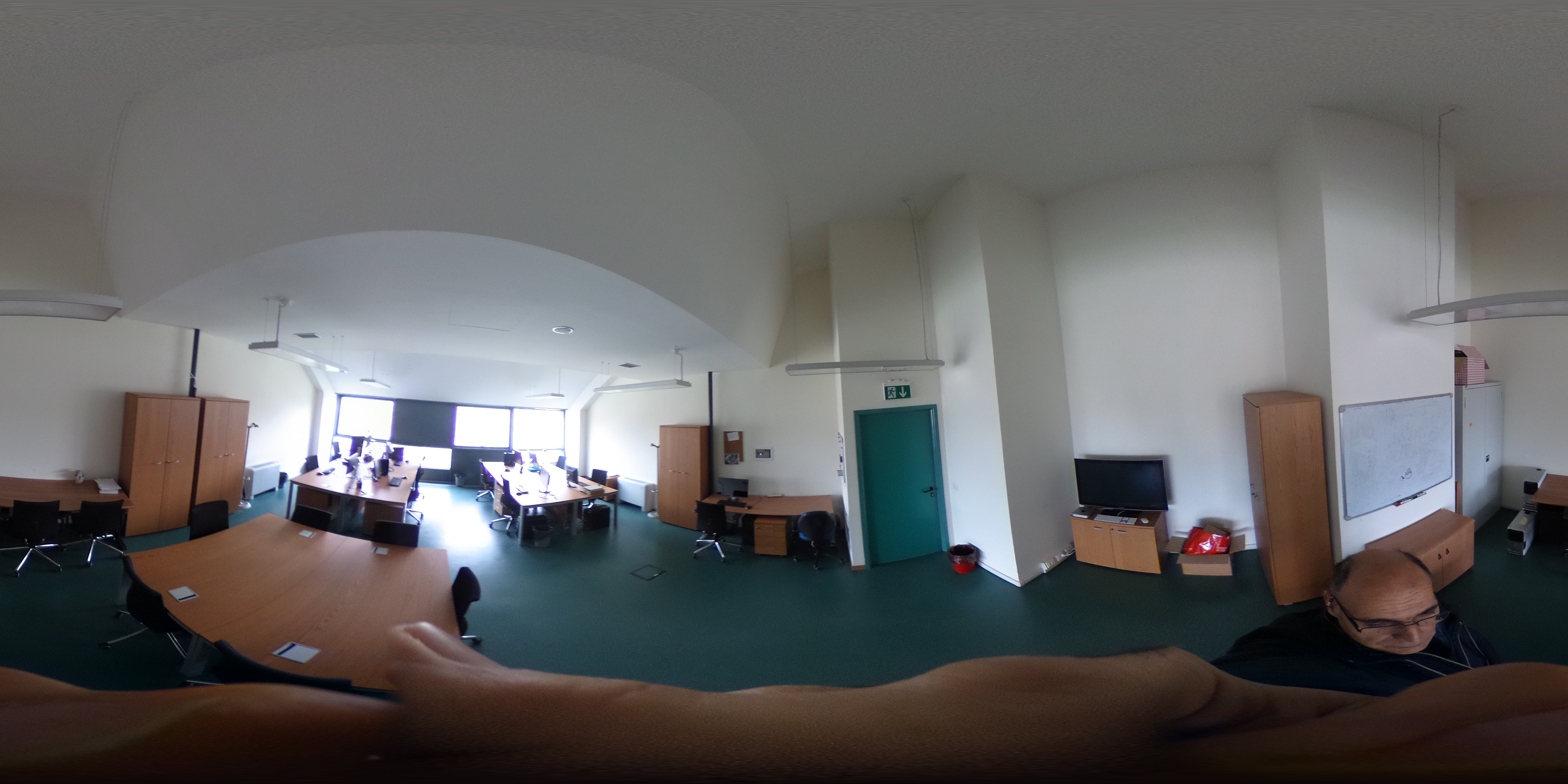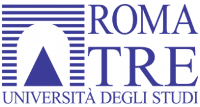COMLAB
DIGITAL SIGNAL PROCESSING
MULTIMEDIA & OPTICAL COMMUNICATIONS
- Image 01
Software Defined Radio
- Image 02
Augmented reality
- Image 03
Plenoptics
- Image 04
Multimedia quality
- Image 05
Multimedia security
- Image 06
Localization
- Image 07
VANET, Visible Light Communication, Nano-scale communication
Welcome to the Comlab Laboratory
Comlab is dedicated to the study of telecommunication and multimedia systems, with particular attention to the security and evaluation aspects of the Quality of Experience of the New Immersive Systems
It is part of the Department of Industrial, Electronic and Mechanical Engineering at University Roma TRE located in Roma, Italy
It is directed by Prof. Alessandro Neri
- Sorry... no news at the moment
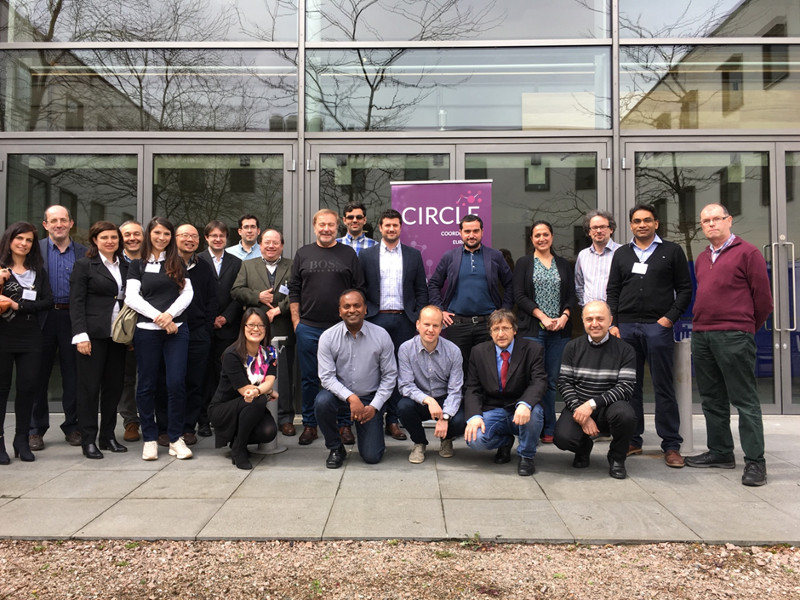
1st Workshop on Molecular Communications - H2020 FETOpen CIRCLE Project 2016 - Cambridge
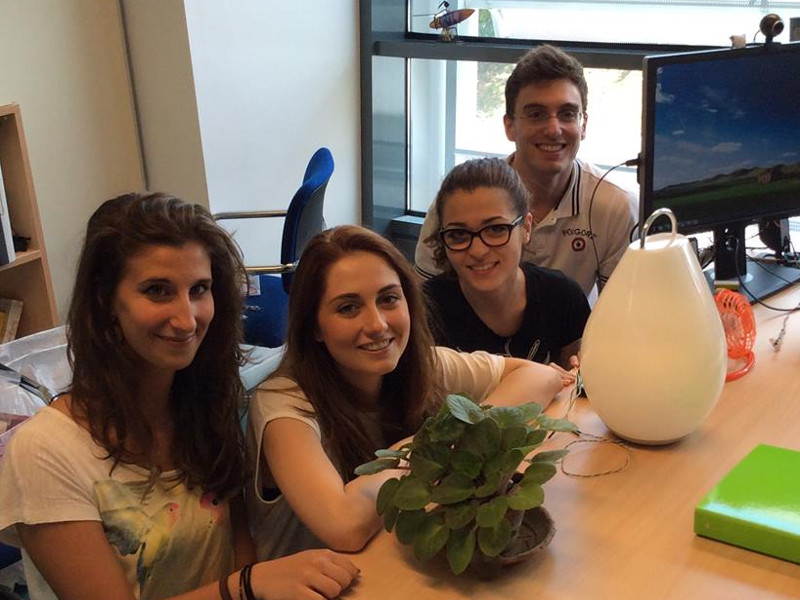
Pic. 2/33
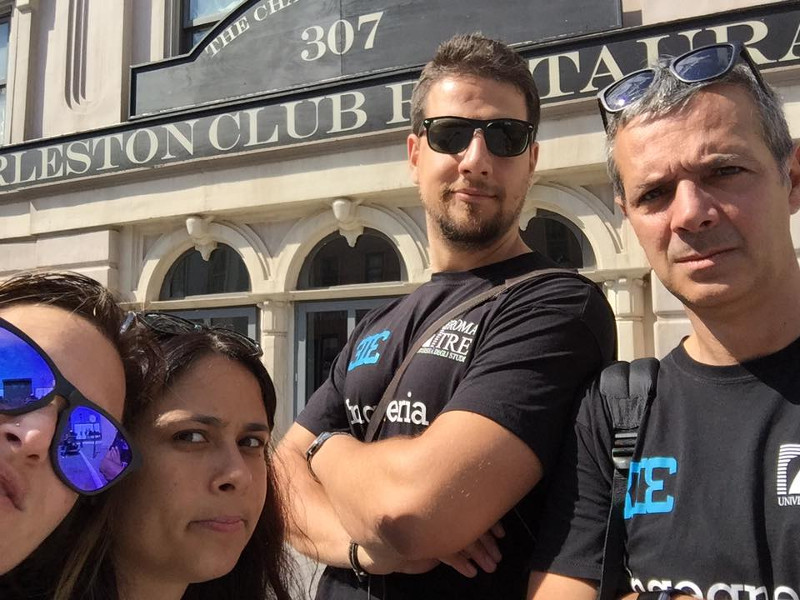
4cameras testing at Cinecitta World
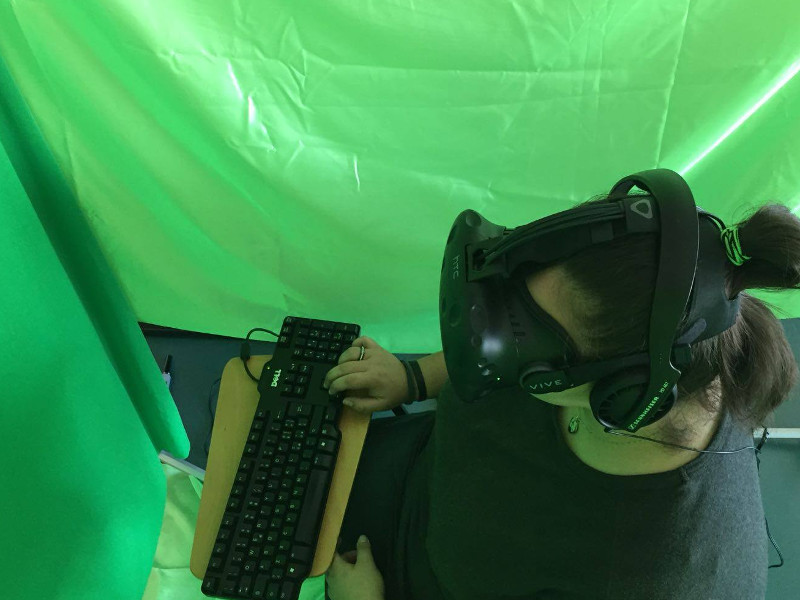
Elicopter simulator in action
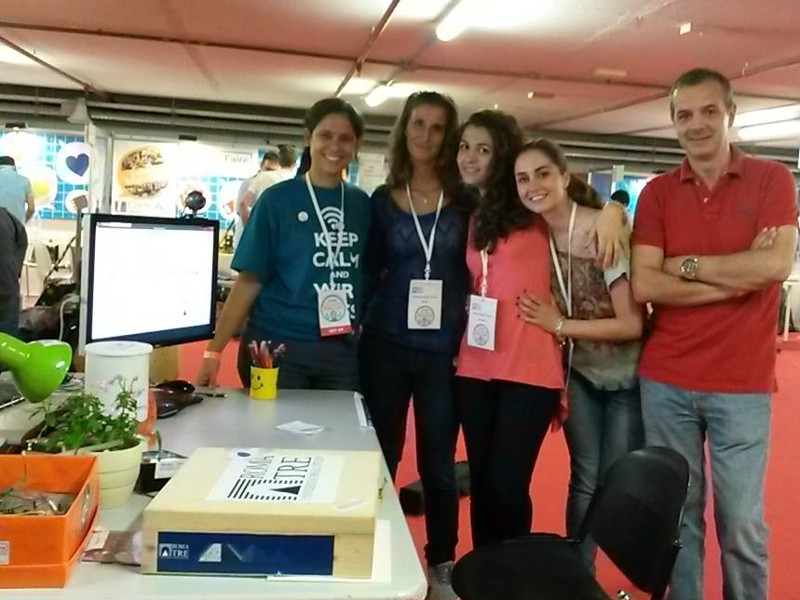
Smart Desk at Maker Faire 2014
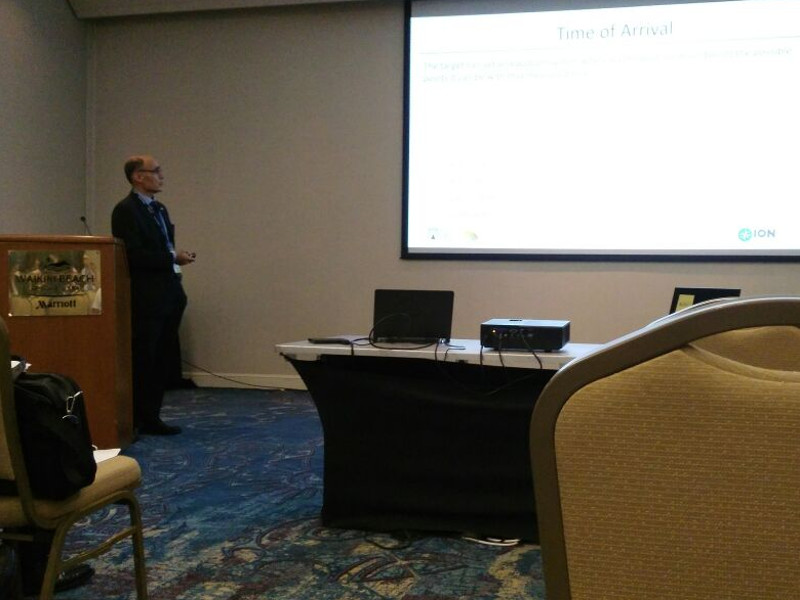
Indoor positioning - ION-PNT 2017 - Honolulu
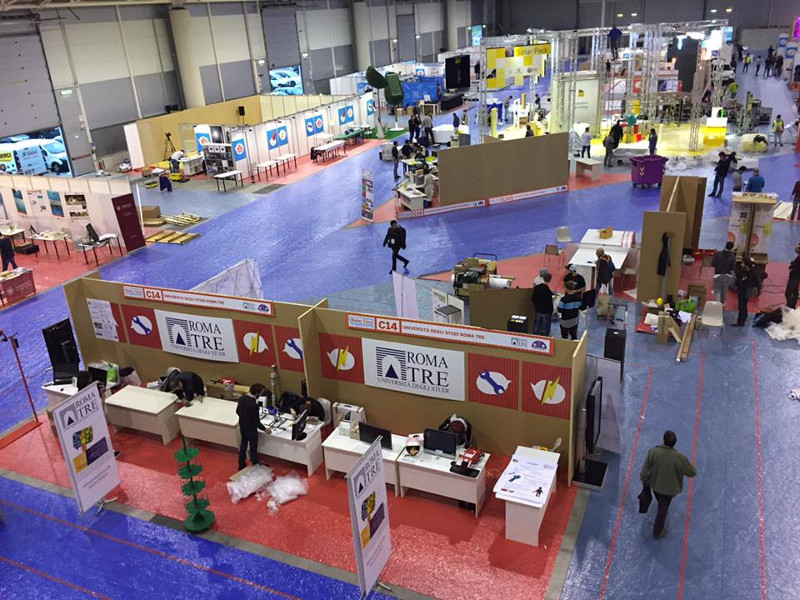
Roma Tre booth at Maker Faire 2016

Meteo Station team
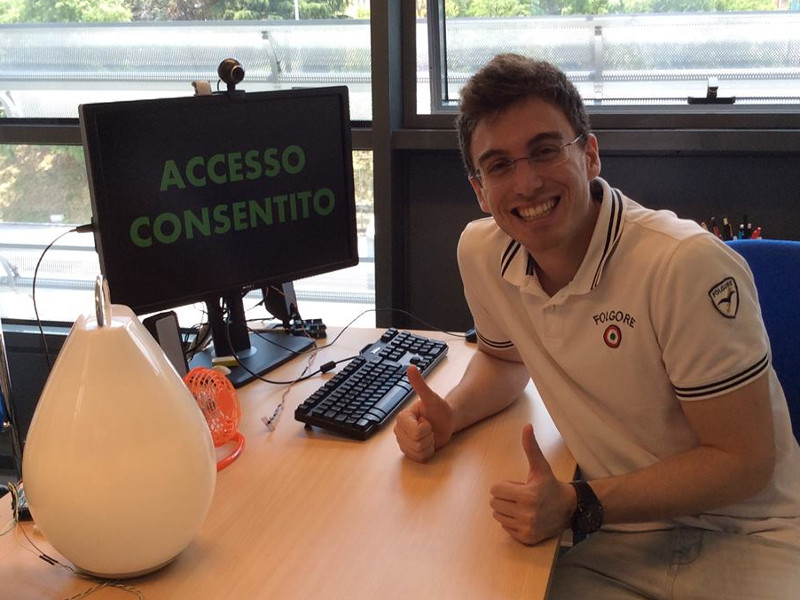
Smart work using Smart Desk
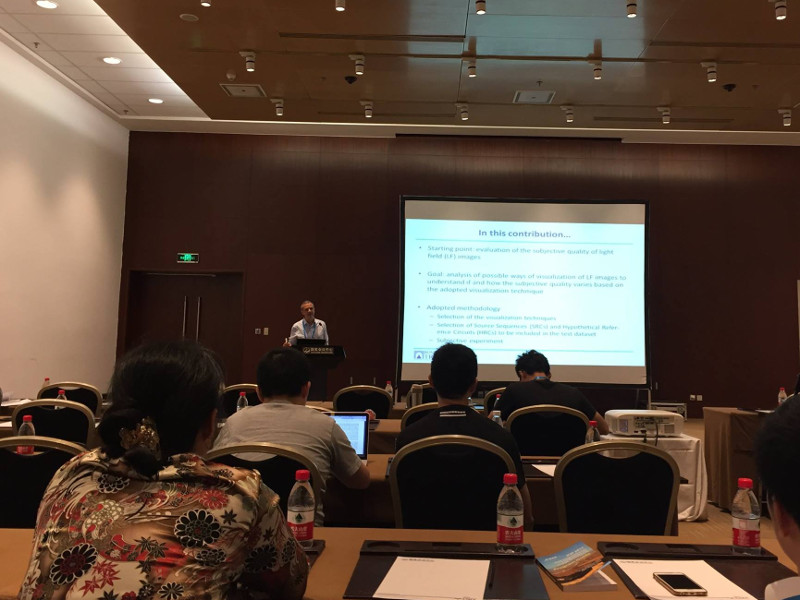
ICIP 2017 - Bejing
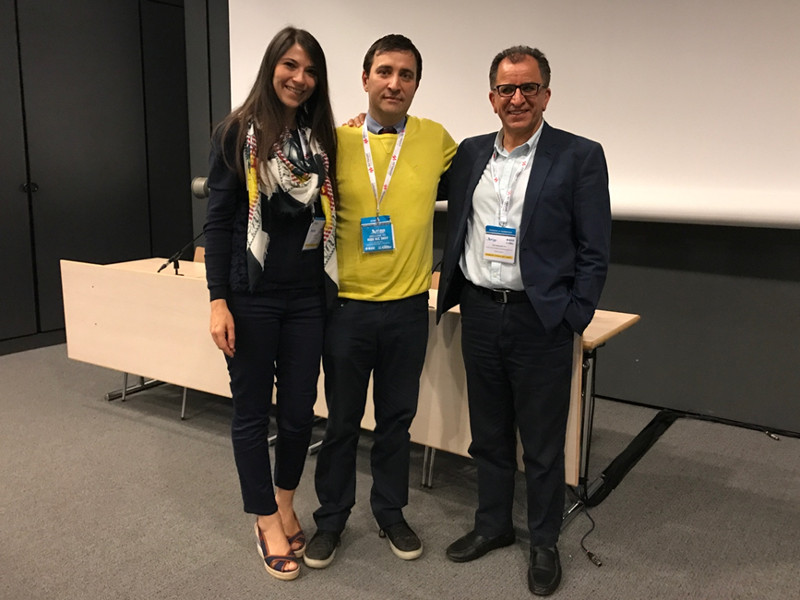
3rd Workshop on Optical Wireless Communications - IEEE ICC 2017 - Paris
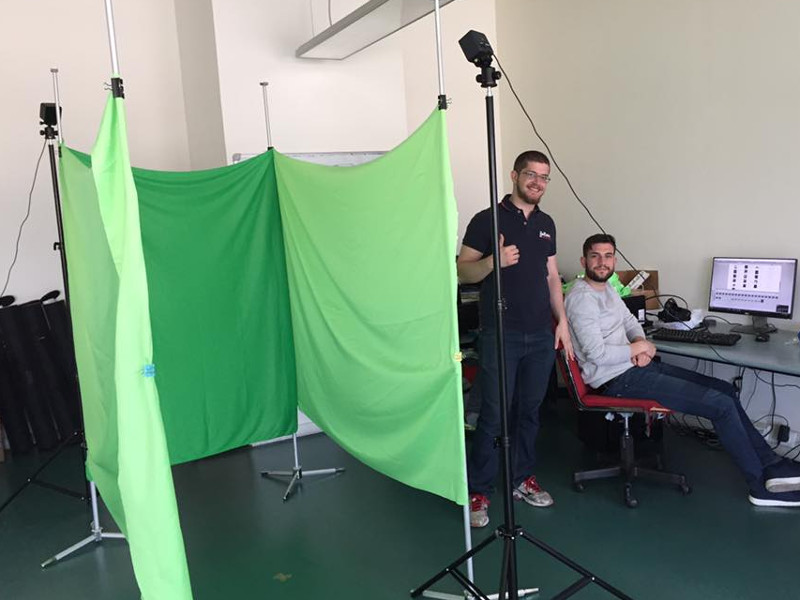
Elicopter simulator team
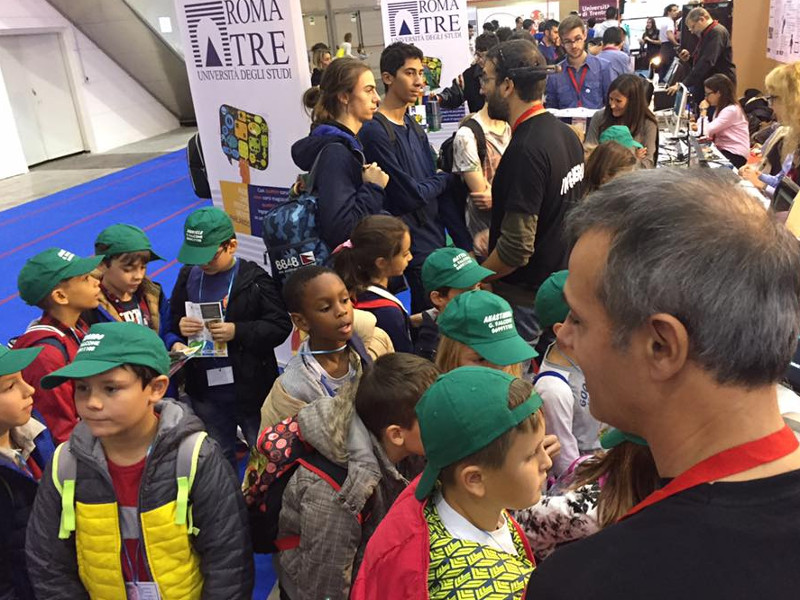
Pic. 13/33
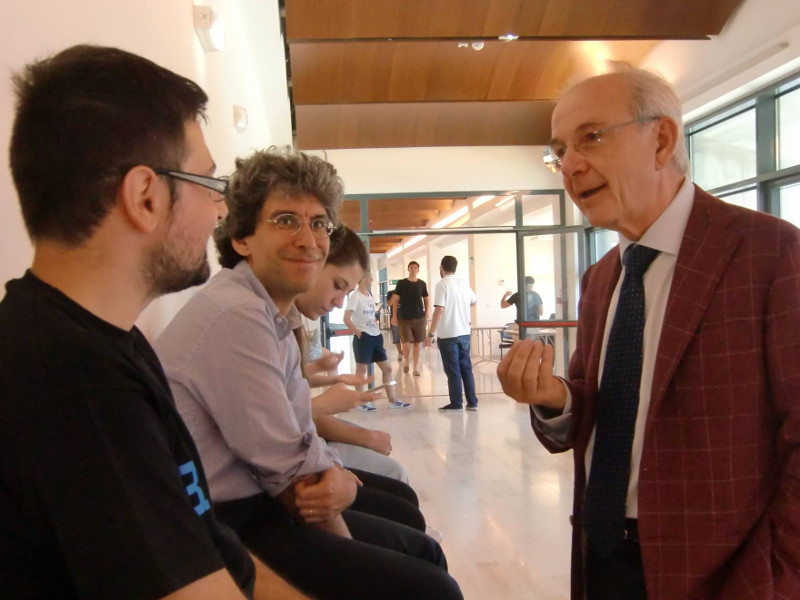
Pic. 14/33
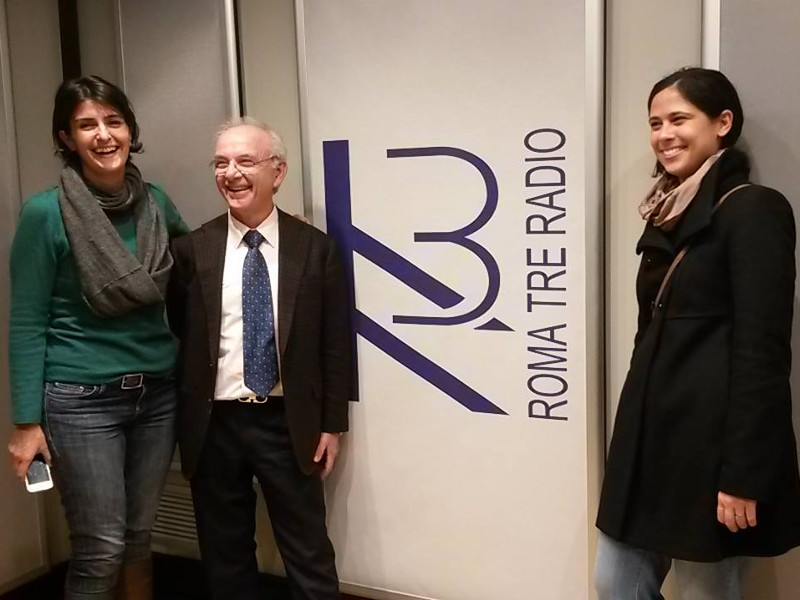
Roma Tre Radio is a reality

Smart desk team
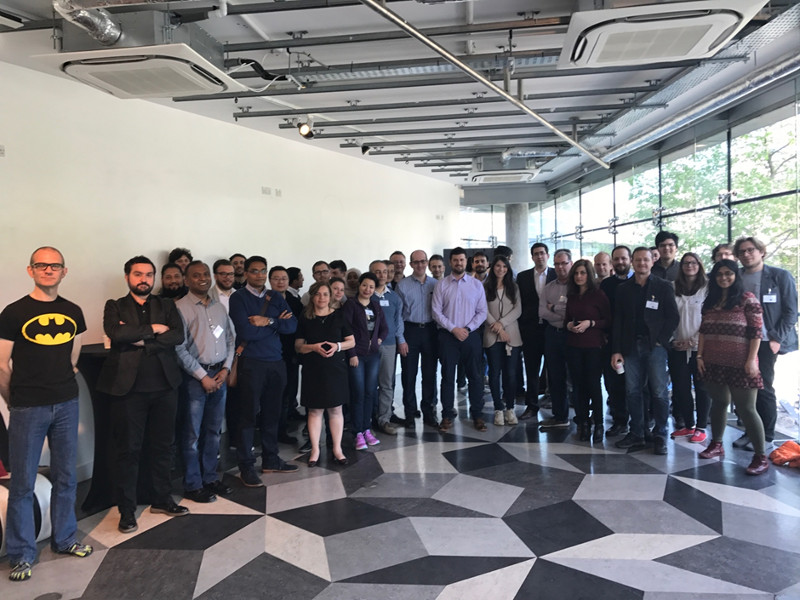
2nd Workshop on Molecular Communications - H2020 FETOpen CIRCLE Project 2016 - Dublin
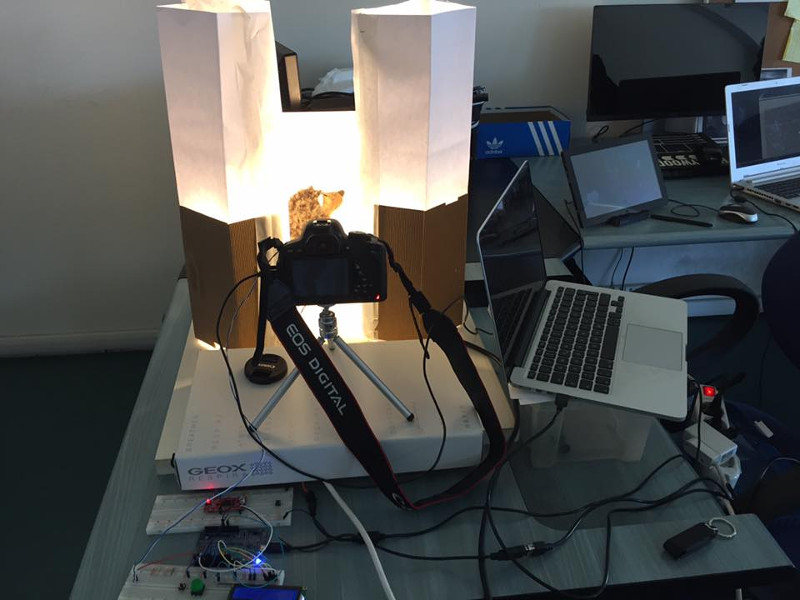
3D photo scanner in action
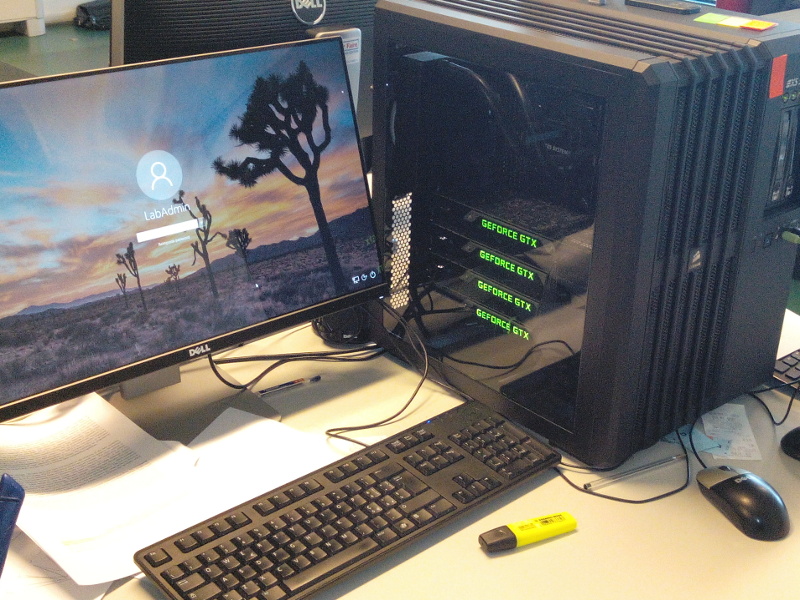
4 GPUs equipped deep learning PC
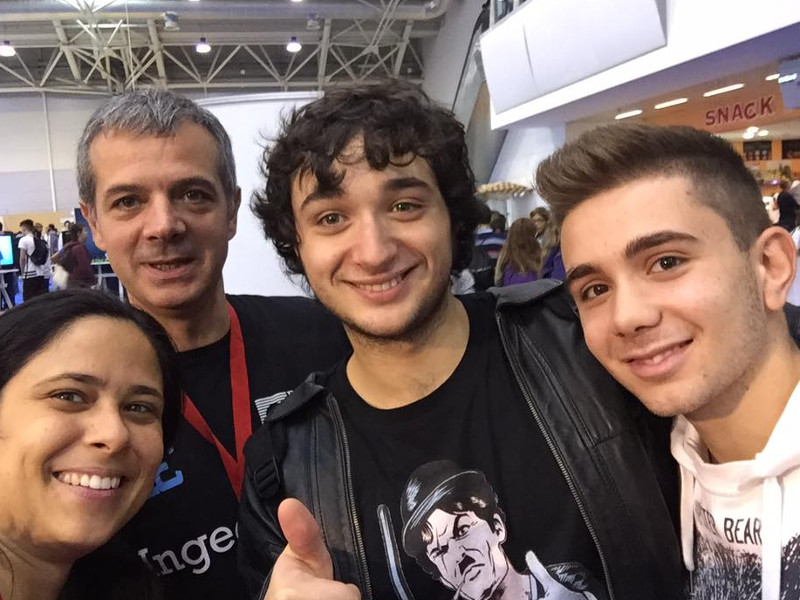
Pic. 20/33
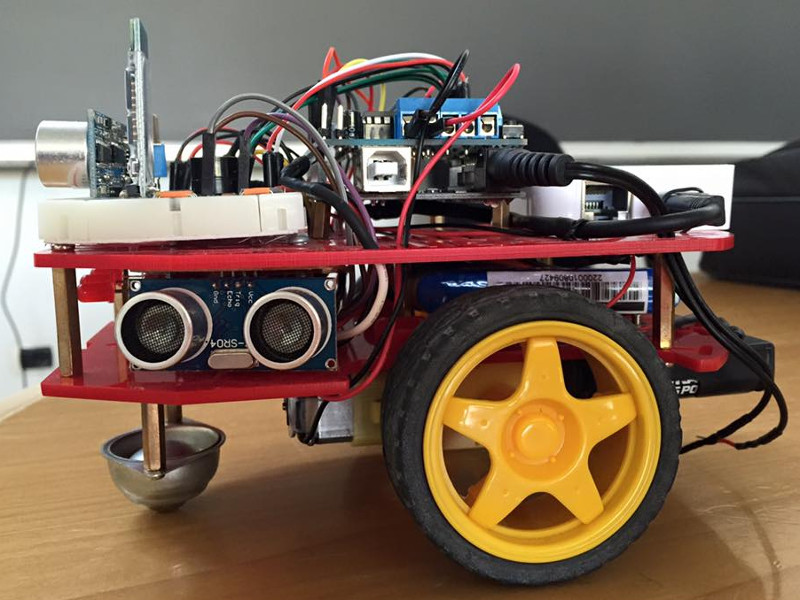
Pic. 21/33
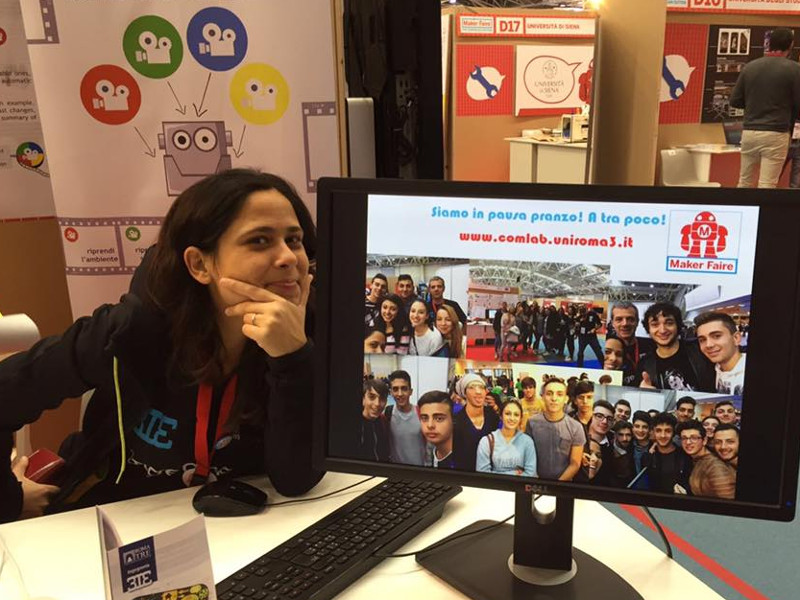
Comlab at Maker Faire 2016
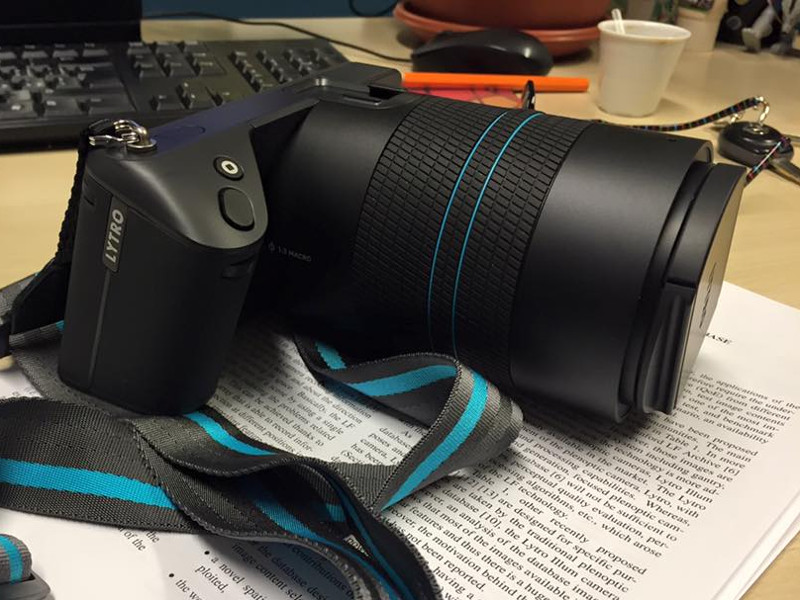
Lytro camera
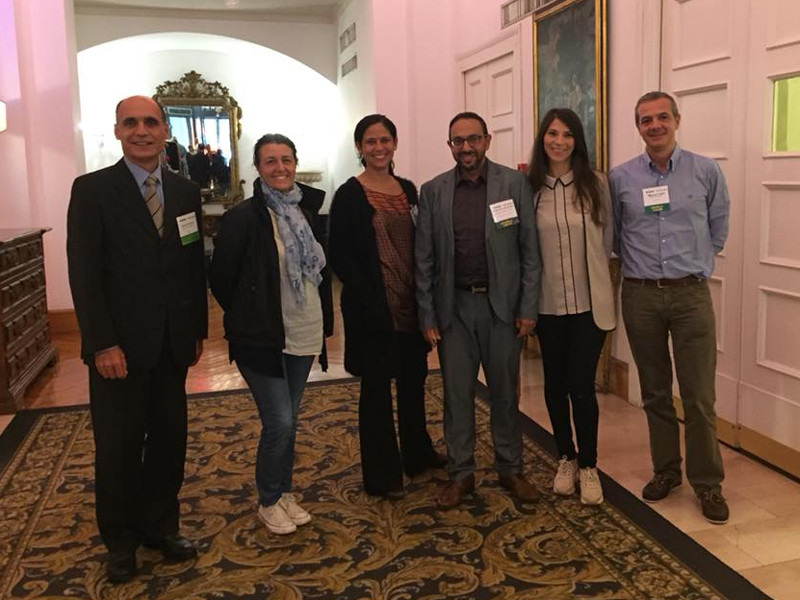
WiMob 2017
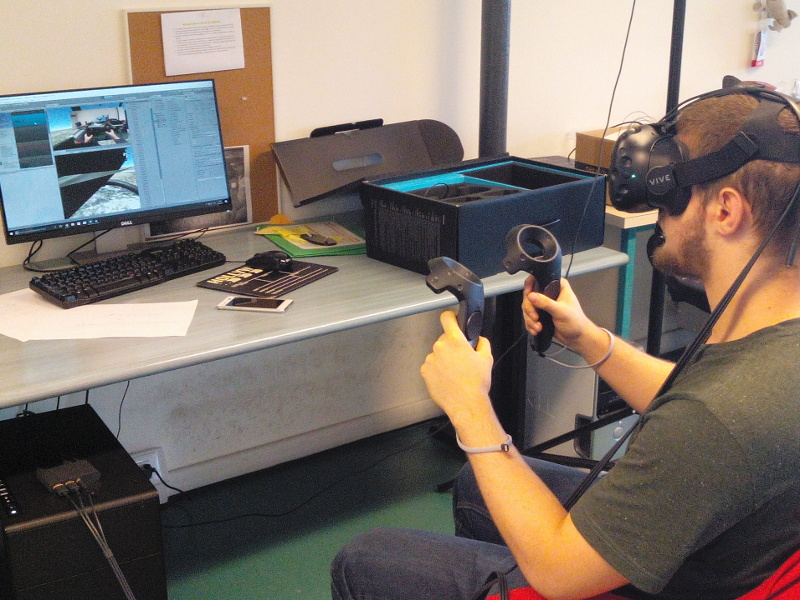
Pic. 25/33
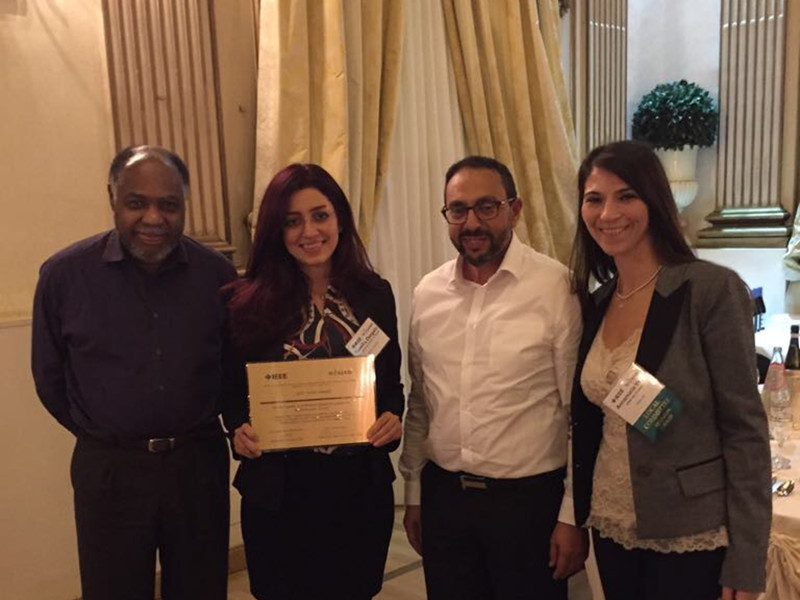
IEEE WiMob 2017 - Rome
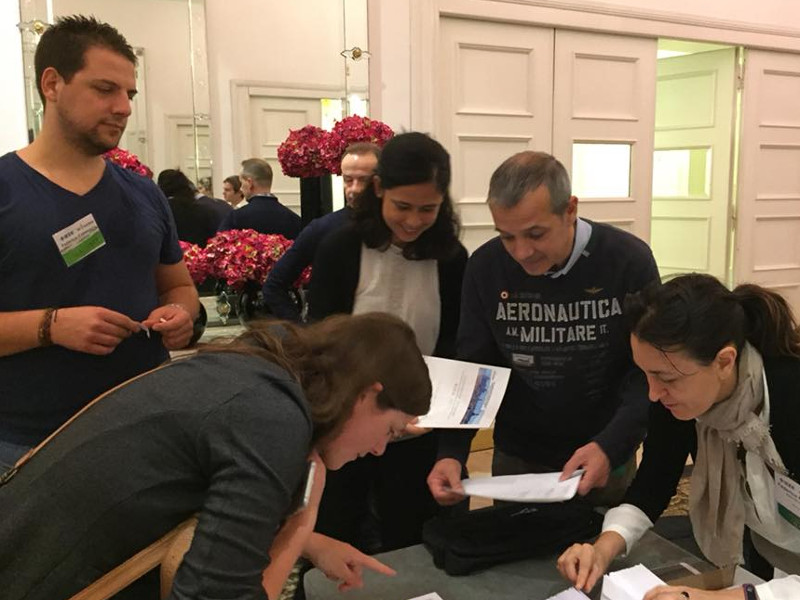
Pic. 27/33
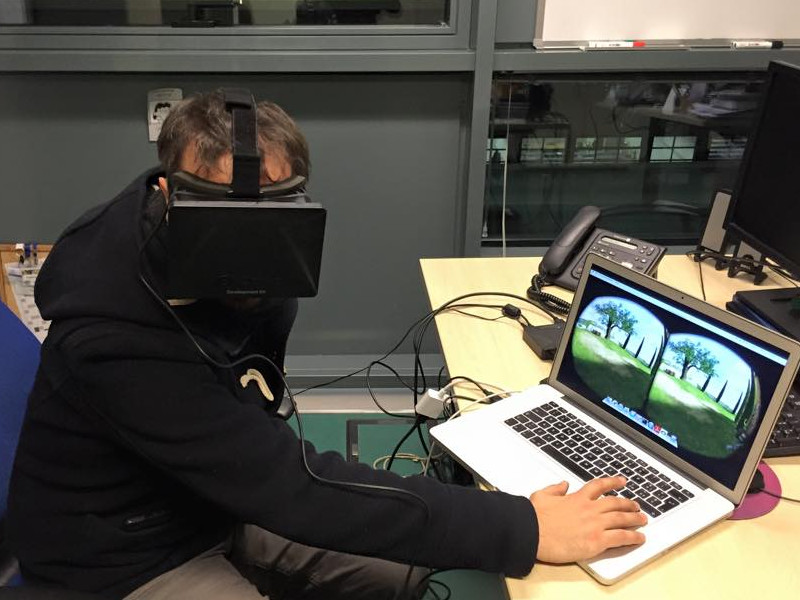
Testing the Oculus Rift
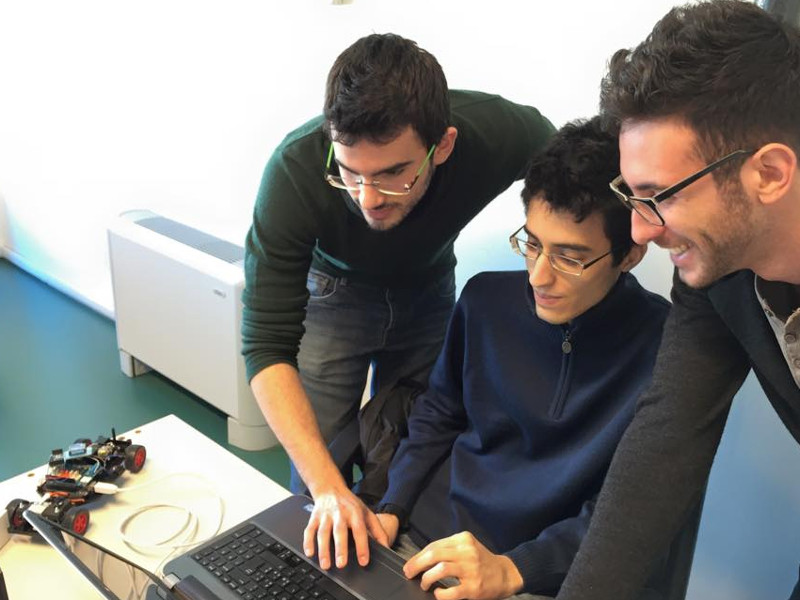
Pic. 29/33
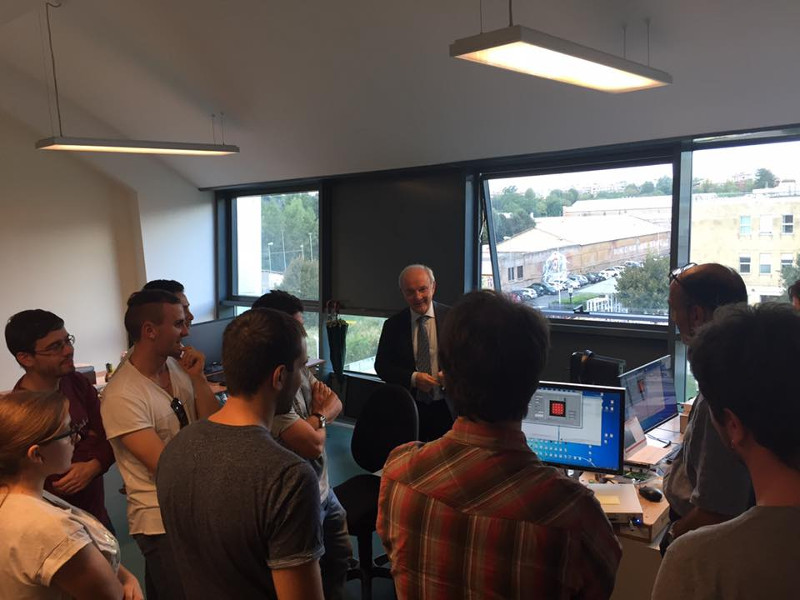
Lesson about SDR technologies
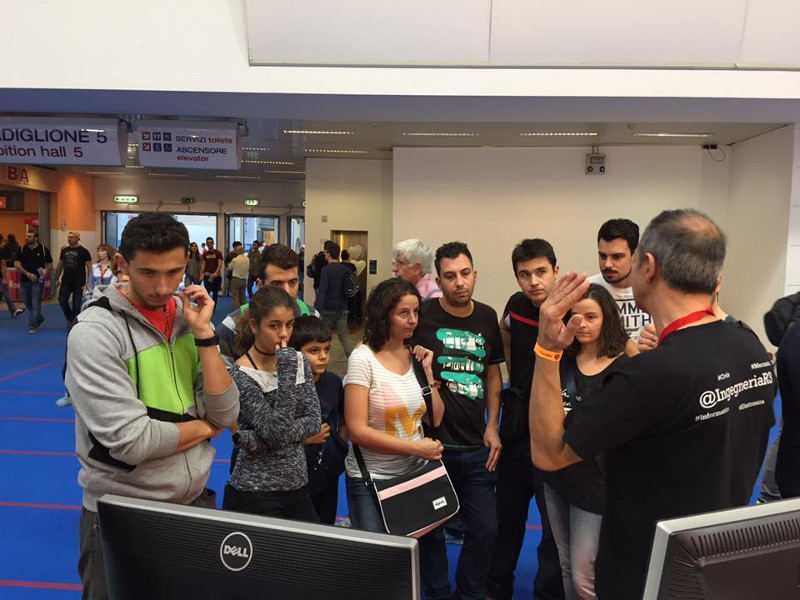
Maker Faire 2016
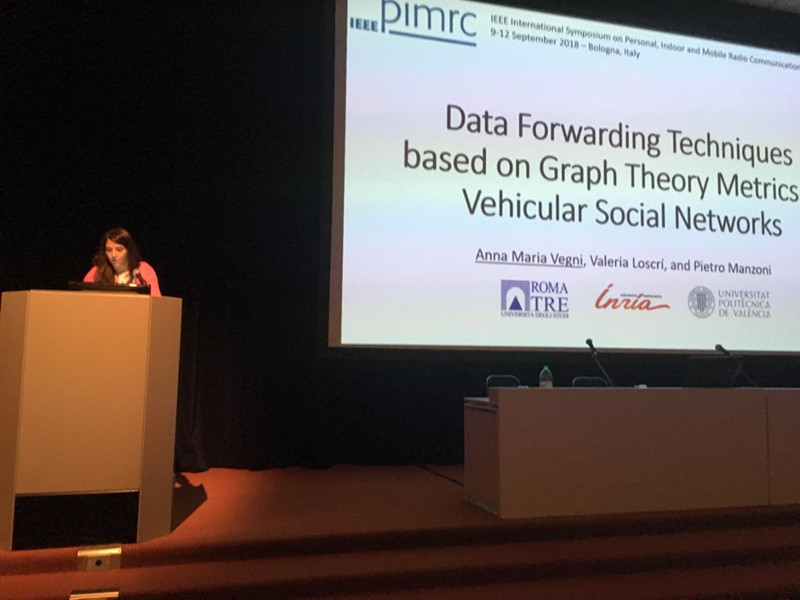
Mobile Social Networks - IEEE PIMRC 2018 - Bologna
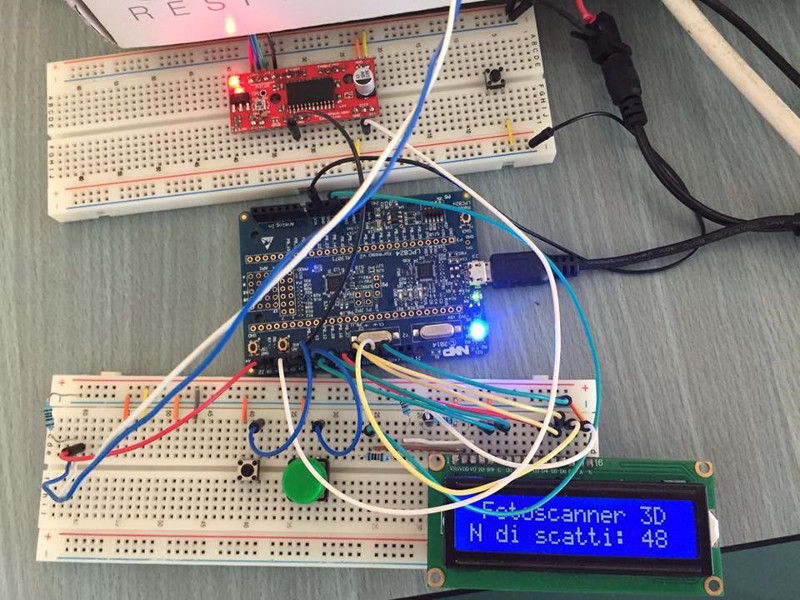
Pic. 33/33
Our research topics
Deep Learning
Machine learning is an expression used to describe systems that automatically learn to make predictions about some attributes of a data instance, such as the content of a picture or the evolution of the stock market, from a set of training data.
Deep learning describes a set of recent advancements in the fields of neural network, specifically referring to architectures and techniques leveraging an high number of hidden layers, thus described as deep neural networks.
Deep learning currently represents the state of the art in many machine learning tasks, especially in computer vision tasks, where deep architectures obtain super-human performances.
Deep neural networks have also enabled a number of surprising tasks, such as the generation of images from text descriptions and models that generate new deep architectures.
COMLAB’s publications about Deep Learning are:
- F. Colangelo, F. Battisti, M. Carli, A. Neri and F. Calabrò, "Enhancing audio surveillance with Deep Neural Networks" Advanced Video and Signal based Surveillance (AVSS) 2017, Lecce
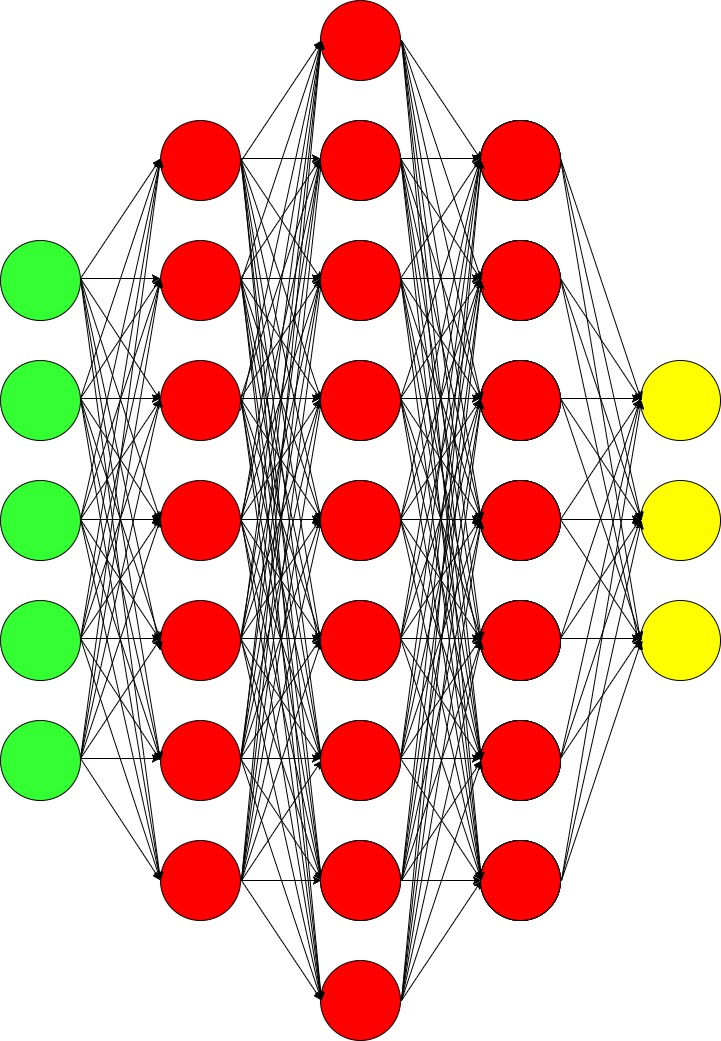
Fig. A simple, fully-connected, deep neural network with three hidden layers
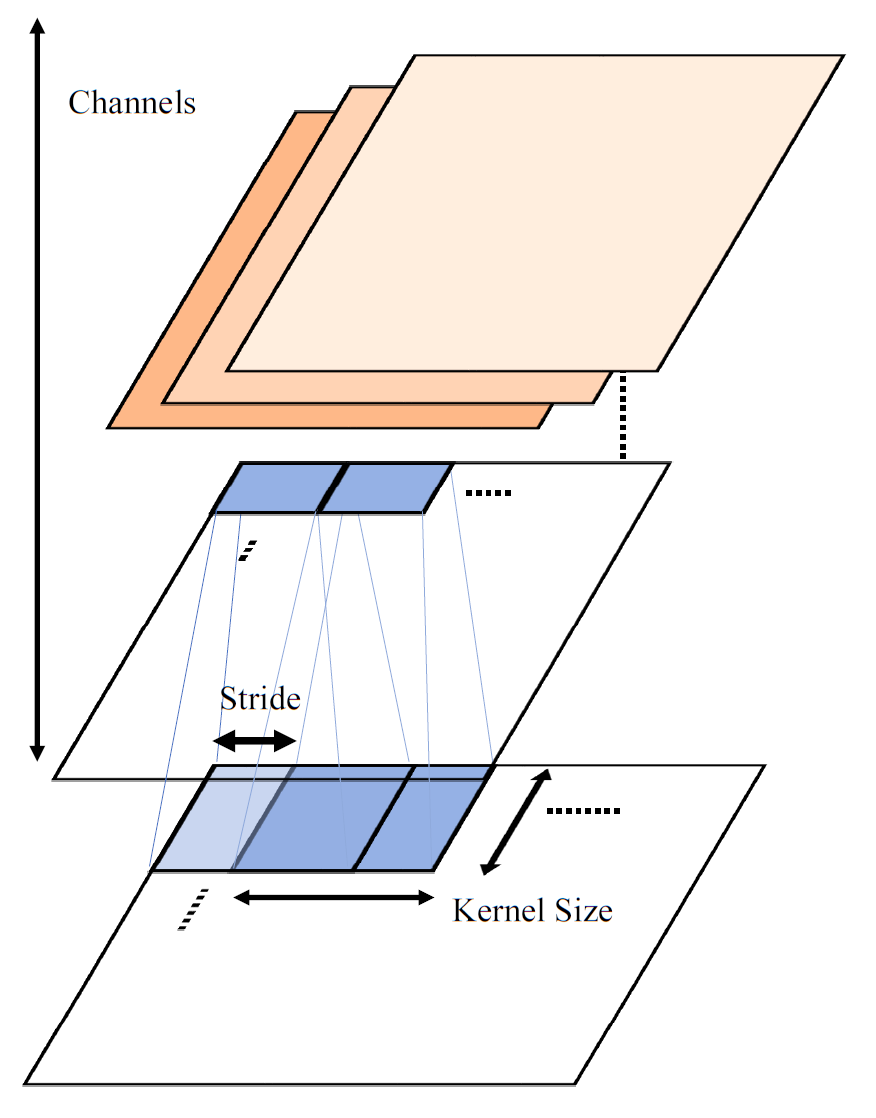
Fig. Architecture of a convolutional layer, one of the most important building blocks of deep neural networks
Internet of Things
In recent years, a huge amount of devices are connected to the Internet more than people. In 2020 there will be 50 billions of "things" connected to the Internet. It is then foreseen to have 7 devices per person. This has carried out to the evolution of a new emerging paradigm, namely the Internet of Things (IoT). In IoT scenarios, a large number of devices – and more in general objects – are seamlessly connected to each another for information sharing through the Internet.
Due to the huge amount of heterogeneous devices, information sharing among IoT devices is one of the biggest challenges. Classic Internet approaches need to be revised to address the complex requirements imposed by IoT. This asks for the development of intelligent algorithms for routing, information sharing security, novel network paradigms, new services, and advanced techniques for data fusion.
Among the main IoT applications we cite:
- Transportation and logistic domain: inventory, product management, object tracking, parking/traffic, etc.;
- Health-care domain: data collection, person/medicine tracking, etc.;
- Smart cities domain: [industrial/company side] energy and smart grid, smart metering, industrial plants, infrastructure/utilities, agriculture; [people side] smart home, smart building, environmental monitoring, security (e.g. fire and elevators) and surveillance, heating, ventilating and air-conditioning (i.e., HVAC), lighting, sensors (e.g. temperature, humidity, gases presence), etc.;
- Personal and social domain: entertainment, social networking, personal objects (losses, thefts), appliances, etc.
COMLAB’s publications about IoT are:
- C. Razafimandimby, V. Loscrì and A.M. Vegni, "Towards efficient deployment in Internet of Robotic Things", Integration, Interconnection, and Interoperability of IoT Systems, R. Gravina, C.E. Palau, M. Manso, A. Liotta, and G. Fortino (Eds.), pp. 21-37, Springer, 2017, ISBN 978-3-319-61300-0
- R. Giuliano, F. Mazzenga, A. Neri and A.M. Vegni, "Security Protocols for IoT Access Networks", Security and Privacy in Internet of Things (IoTs): Models, Algorithms, and Implementations, F. Hu (Ed.), Taylor & Francis LLC, CRC Press, March 15, 2016, ISBN: 9781498723183
- R. Giuliano, F. Mazzenga, A. Neri and A.M. Vegni, "Security Access Protocols in IoT Capillary Networks", IEEE Internet of Things Journal, Vol. 4, no. 3, pp. 645-657, June 2017, doi: 10.1109/JIOT.2016.2624824
- C. Razafimandimby, V. Loscrì, A.M. Vegni and A. Neri, "Efficient Bayesian Communication Approach For Smart Agriculture Applications", Proc. of IEEE 86th Vehicular Technology Conference: VTC2017-Fall, 24-27 September 2017, Toronto, Canada
- C. Razafimandimby, V. Loscrì, A.M. Vegni and A. Neri, "A Bayesian and Smart Gateway Based Communication For Noisy IoT Scenario", Proc. of International Conference on Computing, Networking and Communications (ICNC): Wireless Ad hoc and Sensor Networks (ICNC 2017), Silicon Valley, USA, Jan. 26-29, 2017
- A.M. Vegni, V. Loscrì, A. Neri and M. Leo, "A Bayesian Packet Sharing Approach for Noisy IoT Scenarios", Proc. of 1st Intl. Workshop on Interoperability, Integration, and Interconnection of Internet of Things Systems (I4T 2016), in conjunction with the 1st IEEE Intl. Conf. on Internet-of-Things Design and Implementation (IoTDI 2016), April 6-8, 2016, Berlin, Germany
- C. Razafimandimby, V. Loscrì and A.M. Vegni, "A neural network and IoT based scheme for performance assessment in Internet of Robotic Things", Proc. of 1st Intl. Workshop on Interoperability, Integration, and Interconnection of Internet of Things Systems (I4T 2016), in conjunction with the 1st IEEE Intl. Conf. on Internet-of-Things Design and Implementation (IoTDI 2016), April 6-8, 2016, Berlin, Germany
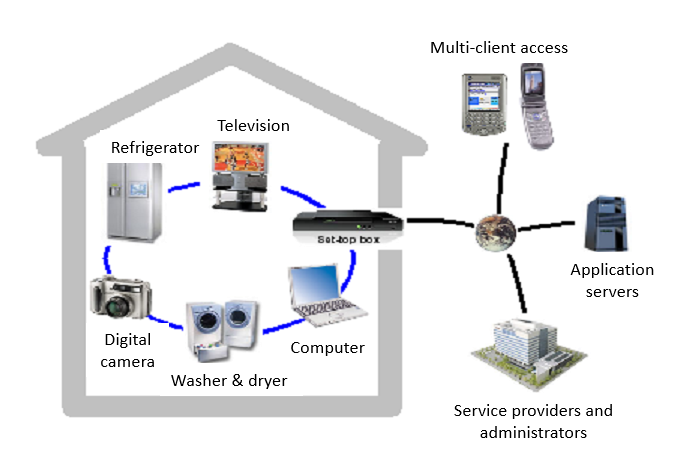
Fig. A schematic of IoT network
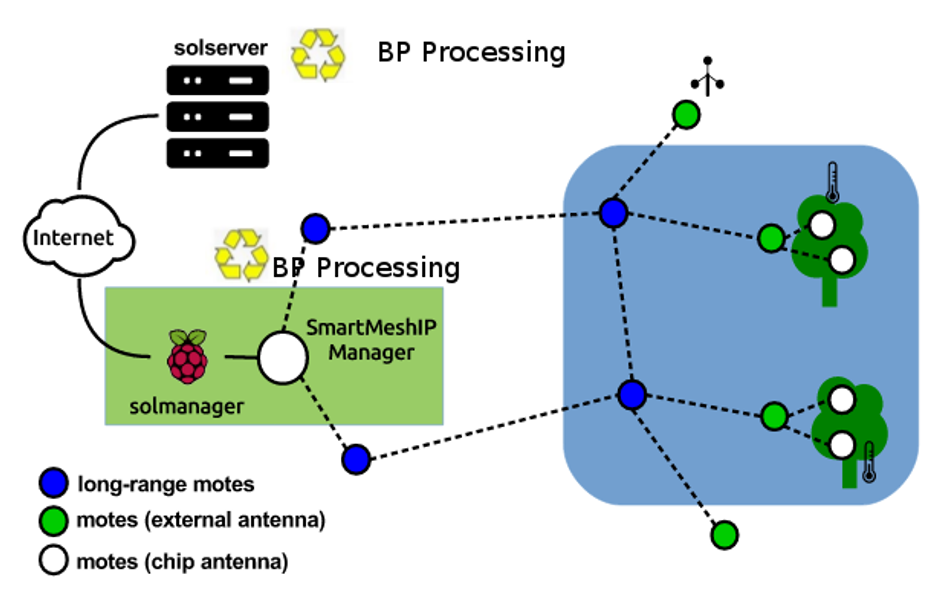
Fig. Modified PEACH (Predicting frost events in peach orchards using IoT technology) network architecture
Localization

Multimedia Quality Assessment
Multimedia quality
COMLAB’s publications about multimedia quality are:
- J. Gutiérrez, P. Paudyal, M. Carli, F. Battisti, and P. Le Callet, "Perceptual analysis and characterization of light field content", in VQEG eLetter, vol. 3, Issue 1, November 2017.
- P. Paudyal, F. Battisti, M. Sjostrom, R. Olsson, and M. Carli, "Towards the Perceptual Quality Evaluation of Compressed Light Field Images", IEEE Transactions on Broadcasting, vol.PP, no.99, pp.1-16, doi: 10.1109/TBC.2017.2704430
- P. Paudyal, F. Battisti, and M. Carli, "Evaluation of the Effects of Transmission Impairments on Perceived Video Quality by exploiting ReTRiEVED Dataset", Journal of Electronic Imaging, 26(2), 023003 (Mar 08, 2017). doi:10.1117/1.JEI.26.2.023003.
- F. Battisti and P. Le Callet, "Quality Assessment in the context of FTV: challenges, first answers and open issues", IEEE COMSOC MMTC Communications - Frontiers, Vol.11, No.2, March 2016.
- P. Paudyal, F. Battisti, and M. Carli, "Impact of video content and transmission impairments on quality of experience", Multimedia Tools and Applications, Springer, pp 1-25, January 2016. DOI: 10.1007/s11042-015-3214-0.
- N. Ponomarenko, L. Jin, O. Ieremeiev, V. Lukin, K. Egiazarian, J. Astola, B. Vozel, K. Chehdi, M. Carli, F. Battisti, C.-C. J. Kuo, "Image database TID2013: Peculiarities, results and perspectives", Signal Processing: Image Communication, doi:10.1016/j.image.2014.10.009,
- F. Battisti, E. Bosc, M. Carli, P. Le Callet, S. Perugia, "Objective image quality assessment of 3D synthesized views", Signal Processing: Image Communication, doi:10.1016/j.image.2014.10.005.
- F. Battisti, M. Carli, and A. Neri, "No reference quality assessment for MPEG video delivery over IP", EURASIP Journal on Image and Video Processing 2014, 2014:13.
- F. Battisti, M. Carli, E. Mammi and A. Neri, "A study on the impact of AL-FEC techniques on TV over IP Quality of Experience", EURASIP Journal on Advances in Signal Processing 2011, 2011:86 doi:10.1186/1687-6180-2011-86
- N. Ponomarenko, V. Lukin, A.Zelensky, K.Egiazarian, J. Astola, M. Carli, and F. Battisti, "TID2008 – A database for evaluation of full-reference visual quality assessment metrics", Journal on Achivements in Modern Radio Electronics, no. 10, pp: 30-45, October 2009
Multimedia Security
Multimedia security
COMLAB’s publications about multimedia security are:
- F. Battisti, M. Carli, F. Pascucci, "Securing Cyber Physical Systems from injection attacks by exploiting random sequences", Proc. 13th IEEE International Conference on Wireless and Mobile Computing, Networking and Communications (WiMob), 9-11 October, 2017, Rome, Italy
- G. Boato, M. Carli, F. Battisti, M. Azzoni and K. Egiazarian, "Difference expansion and prediction for high bit-rate reversible data hiding", Journal of Electronic Imaging 21, 033013 (2012), DOI:10.1117/1.JEI.21.3.033013
- M. Cancellaro, F. Battisti, M. Carli, G. Boato, F.G.B. De Natale, A. Neri, "A commutative digital image watermarking and encryption method in the tree structured Haar transform domain," Signal Processing: Image Communication, Volume 26, Issue 1, January 2011, Pages 1-12
- F. Battisti, M. Cancellaro, G. Boato, M. Carli, and A. Neri, "Joint Watermarking and Encryption of Color Images in the Fibonacci-Haar Domain," EURASIP Journal on Advances in Signal Processing, vol. 2009, Article ID 938515, 13 pages, 2009. doi:10.1155/2009/938515
Nano-scale Communications
Molecular communications
In the past few years, nanotechnology has emerged as an evolution of technology enabling the design of miniaturized nanoscale devices, i.e., nanorobots and nanoparticles. The behaviors and characteristics of nanodevices distinguish them from the well-known features of devices at the macroscale level. A nanodevice is the most basic functional unit, allowed to perform very easy tasks, like sensing or actuation, due to the passive nature of these devices.
A set of nanodevices, sharing the same medium (e.g., the human blood flow) and collaborating on a common task (e.g., to deliver a drug concentration to a receptor), forms a nanonetwork. Nanonetworks are expected to expand the capabilities of single nanodevices and then to enable new nanotechnology applications in several fields.
Communication and signal transmission techniques occurring in nanonetworks are challenging topics, due to the limited computation skill of nanodevices. Molecular communication is largely exploited for nanonetworks. This is a novel communication paradigm, envisaged as the most practical way in which nanorobots can communicate with each other by the use of molecules as information carriers.
THz-band communications
Still in the context of nano-scale communications, the potentialities of the Terahertz (THz) frequency band are largely increasing, thanks to specific features that allow issues related to the spectrum scarcity and capacity limitation to be overcome.
The Terahertz band has been identified in the range (0.06 − 10) THz and represents one of the most promising spectrum bands to enable ultra-high-speed communications. Also, since existing channel models adopted for lower frequency bands are unsuitable for THz communications, the need of novel channel models specific for this frequency range is a challenge. Differently from traditional lower frequency bands, where the propagation is mainly influenced by the spreading loss only, the physical mechanisms in a THz-band wireless transmission are a very high molecular absorption loss, spreading loss and molecular absorption loss.
COMLAB is involved in several initiatives about nano-scale communications, such as:
- The 4th ACM International Conference on Nanoscale Computing and Communication, Washington D.C., USA, September 2017. Link
- The 3rd ACM International Conference on Nanoscale Computing and Communication, New York, New York, USA, September 28-30, 2016. Link
- Special Track "Body Area NanoNetworks: Electromagnetic, Materials and Communications (BANN-EMC)", in conjunction with 10th International Conference on Body Area Networks, September 28-30, 2015 Sydney, Australia. Link
- Special Track "Electromagnetic-Body Area NanoNETworks (E-BANNET)", in conjunction with 9th International Conference on Body Area Networks, September 29-October 1, 2014 London, Great Britain. Link
COMLAB’s publications about nano-scale communications are:
- A.M. Vegni and V. Loscrì, "Analysis of the Chirality Effects on the Capacity of Wireless Communication Systems in the THz band," in IEEE Transaction on Wireless Communications, 2017, doi: 10.1109/TWC.2017.2754259
- V. Loscrì and A.M. Vegni, "Capacity evaluation of a quantum-based channel in a biological context," in IEEE Transaction on Nanobioscience, vol. 15, no. 8, pp. 901-907, Dec. 2016. doi: 10.1109/TNB.2016.2620719
- A.M. Vegni and V. Loscrì, "Chirality effects on channel modeling for THz-band wireless communications in LoS/NLoS propagation," Nano Communication Networks (Elsevier), Volume 10, December 2016, Pages 27-37, http://dx.doi.org/10.1016/j.nancom.2016.07.007
- A.M. Vegni and V. Loscrì, "Characterization and Performance Analysis of a Chiral-Metamaterial Channel with Giant Optical Activity for Terahertz Communications" Nano Communication Networks (Elsevier), Volume 9, 1 September 2016, Pages 28-35
- V. Loscrì, L. Matekovits, I. Peter and A.M. Vegni, "In-body Network Biomedical Applications: from Modeling to Experimentation," in IEEE Transaction on Nanobioscience, vol. 15, no. 1, pp. 53-61, Jan. 2016. doi: 10.1109/TNB.2016.2521386
- V. Loscrì, A.M. Vegni and G. Fortino, "On the Interaction between a Nanoparticulate System and the Human Body in Body Area Nanonetworks," Micromachines 2015, 6(9), 1213-1235; doi: 10.3390/mi6091213
- V. Loscrì and A.M. Vegni, "An Acoustic Communication Technique of Nanorobot Swarms for Nanomedicine Applications," IEEE Transaction on Nanobioscience, Volume 14, Issue 6, 1 September 2015, Pages 598-607, doi: 10.1109/TNB.2015.2423373, 2015
- A.M. Vegni and V. Loscrì, "Performance of a Chirality-affected Channel exhibiting Giant Optical Activity for Terahertz Communications," in Proc. of 3rd ACM Intl. Conf. on Nanoscale Computing and Communication (ACM NANOCOM 2016), September 28-30, 2016, New York City, New York, USA
- V. Loscrì and A.M. Vegni, "Channel Modeling in a Phonon-based Quantum Network for Nano-communications," in Proc. of 3rd ACM Intl. Conf. on Nanoscale Computing and Communication (ACM NANOCOM 2016), September 28-30, 2016, New York City, New York, USA
- V. Loscrì, L. Matekovits, I. Peter and A.M. Vegni, "Modeling and Experimental Analysis of an In-body Area Nanonetwork," in Proc. of 10th Intl. Conf. on Body Area Networks (BODYNETS 2015), September 28-30, 2015 Sydney, Australia
- V. Loscrì and A.M. Vegni, "On the Affection of the Human Immune System on a Nanoparticulate Nanomedicine System" in Proc. of 9th Intl. Conf. on Body Area Networks (BODYNETS 2014), September 29-October 1, 2014 London, Great Britain
- R. Iovine, R. Tarparelli and A.M. Vegni, "Graphene Bow-tie Nanoantenna for Wireless Communications in the Tera-hertz Band," in Proc. of 1st ACM Intl. Conf. on Nanoscale Computing and Communication, May 13-14, 2014, Atlanta GA, USA
- R. Iovine, R. Tarparelli and A.M. Vegni, "Detection of DNA alterations using Gold Nanoparticles exploiting the LSP phenomenon," in Proc. of 21st IEEE Intl. Conf. on Applied Electromagnetics and Communications (ICECOM), October 14-16, 2013, Dubrovnick, Croatia
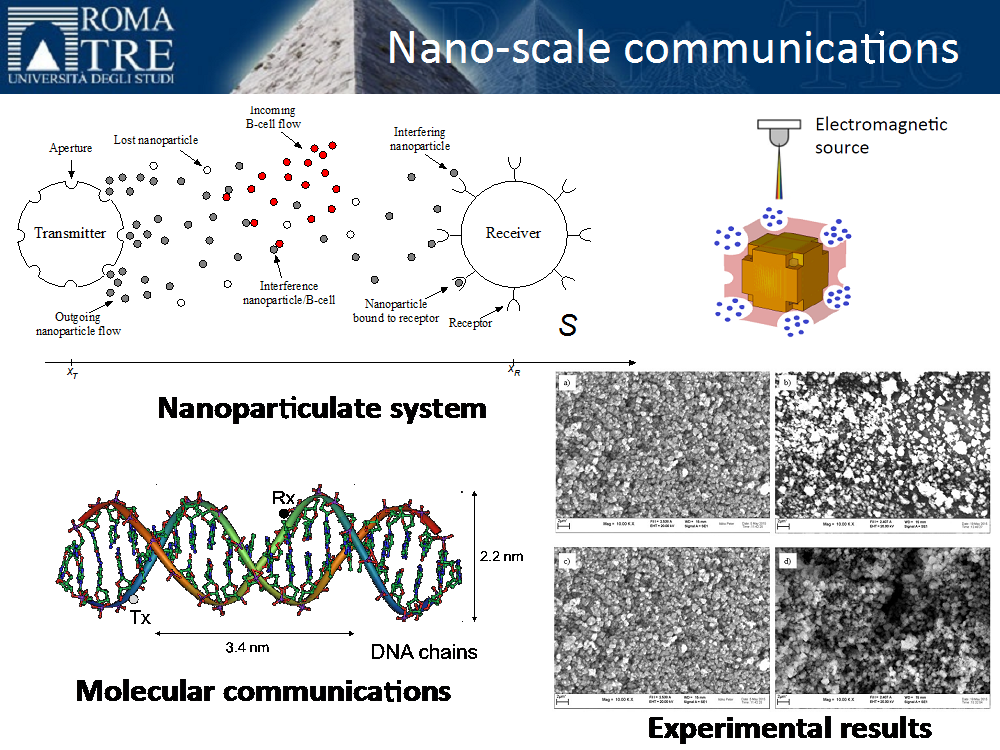
Navigation

Optical wireless communications
In recent years, wireless communications have significantly evolved due to the advanced technology of smartphones, portable devices and the rapid growth of Internet of Things, e-Health, Intelligent Transportation Systems and social networking. Forecasted by Cisco, the wireless mobile traffic will be dominant over the data network towards a new connected world in 2020, with also the upcoming 5G systems.
Optical Wireless Communications (OWC) are a complementary wireless communications technology to the more established radio frequency (RF) based systems such as cellular, Wi-Fi and Bluetooth in order to overcome the spectrum crunch and provide high data rates. The OWC technology offers advantages such as free license, wide bandwidth, inherent security and no RF-based interference, which makes it very attractive for the emerging 5G wireless communications. Nevertheless, the widespread deployment of optical wireless systems, namely infra-red, ultra-violet and visible light communications (VLC), will face a number of challenged including the weather effects (mostly outdoor), eye and skin safety regulations, compatibility with existing networks, mobility (mostly in outdoor environment), cost per device and volume and device/system performance.
COMLAB is involved in several initiatives about OWC systems, such as:
- The 4th Optical Wireless Communications workshop at IEEE ICC 2018, 20-24 May 2018, Kansas City, MO, USA. Link
- The 3rd Optical Wireless Communications workshop at IEEE ICC 2017, 21-25 May 2017, Paris, France. Link
- The 2nd Optical Wireless Communications workshop at IEEE ICC 2016, 23-27 May 2016, Kuala Lumpur, Malaysia. Link
- The 1st Workshop on Visible Light Communications and Networking (VLCN) at IEEE ICC 2015, 8 - 12 June 2015, London UK.
- Emerging Technologies Track: Light-Based Communications and Positioning at IEEE VTC 2015, September 2015, Boston MA.
COMLAB’s publications about OWC systems are:
- S. Pergoloni, Z. Mohammadi, A.M. Vegni, Z. Ghassemlooy and M. Biagi, "Metameric Indoor Localization Schemes using Visible Lights," in Journal of Lightwave Technology, vol. 35, no. 14, pp. 2933-2942, July 15, 2017, doi: 10.1109/JLT.2017.2706527
- M. Rahaim, J. Jean-Michel, C. Morleo, R. McAllister, A.M. Vegni, A. Neri and T.D.C. Little, "A flexible SDR-based testbed for indoor visible light positioning," IEEE COMSOC MMTC Communications-Frontiers, pp. 23-28, Vol. 12, No. 3, May 2017
- M. Hammouda, J. Peissig and A.M. Vegni, "A cognitive design of VLC networks," IEEE COMSOC MMTC Communications-Frontiers, pp. 34-38, Vol.12, No.3, May 2017
- J. Lui, A.M. Vegni, L. Colace, C. Menon and A. Neri, "Toward an Experimental Testbed for RSS-based Indoor Visible Light Positioning," IEEE COMSOC MMTC Communications - Frontiers, Vol.12, No.3, pp. 19-22, May 2017, 2017
- M. Biagi, S. Pergoloni and A.M. Vegni, "LAST: a framework to Localize, Access, Schedule and Transmit in Indoor VLC Systems," Journal of Lightwave Technology, vol.33, no.9, pp.1872,1887, May1, 1 2015
- M. Biagi, A.M. Vegni, S. Pergoloni, P. Butala and T.D.C. Little, "Trace-Orthogonal PPM-Space Time Block Coding under Rate Constraints for Visible Light Communication," Journal of Lightwave Technology, vol.33, no.2, pp.481,494, Jan.15, 15 2015
- A. Mostafa, A.M. Vegni, T. Oliveira, T.D.C. Little and D.P. Agrawal, "QoSHVCP: Hybrid Vehicular Communications Protocol with QoS Priorization for Safety Applications,"ISRN Communications and Networking, vol.2012, 14 pages, 2012
- A.M. Vegni and T.D.C. Little, "Hybrid Vehicular Communications based on V2V-V2I Protocol Switching", Intl. Journal of Vehicle Information and Communication Systems (IJVICS), Vol. 2, Nos. 3/4, pp.213–231, 2011, DOI 10.1504/IJVICS.2011.044263
- G. Manzacca, A.M. Vegni, X. Wang, N. Wada, G. Cincotti and K.i. Kitayama, “Performance Analysis of a Multiport Encoder/Decoder in OCDMA Scenario”, in IEEE Journal of Selected Topics in Quantum Electronics, vol. 13, no. 5, pp. 1415-1421, Sept.-oct. 2007
- M. Hammouda, J. Peissig and A.M. Vegni, "Design of a Cognitive VLC Network with Illumination and Handover Requirements," in Proc. of 2017 IEEE Intl. Conf. on Communications Workshops (ICC Workshops), Paris, France, 2017, pp. 451-456. doi: 10.1109/ICCW.2017.7962699
- S. Pergoloni, Z. Mohammadi, A.M. Vegni, Z. Ghassemlooy and M. Biagi, "Visible Light Indoor Positioning through Colored LEDs," in Proc. of 2017 IEEE Intl. Conf. on Communications Workshops (ICC Workshops), Paris, France, 2017, pp. 150-155. doi: 10.1109/ICCW.2017.7962649
- M. Biagi and A.M. Vegni, "Enabling High Data Rate VLC via MIMO-LEDs PPM," in Proc. of 4th IEEE Globecom 2013 Workshop on Optical Wireless Communications (OWC), December 9, 2013, Atlanta GA, USA
- A.M. Vegni and M. Biagi, "An Indoor Localization Algorithm in a Small-Cell LED-based Lighting System," in Proc. of 3rd Intl. Conf. on Indoor Positioning and Indoor Navigation (IPIN 2012), November 13-15, 2012, Sydney, Australia
- M. Biagi, A.M. Vegni and T.D.C. Little, "LAT Indoor MIMO-VLC —Localize, Access and Transmit—," in Proc. of Intl. Workshop on Optical Wireless Communications (IWOW 2012), October 22, 2012, Pisa, Italy
- A.M. Vegni and T.D.C. Little, "Handover in VLC Systems with Cooperating Mobile Devices," in Proc. of Mobility and Communication for Cooperation and Coordination workshop, part of the IEEE Intl. Conf. on Computing, Networking and Communications (ICNC 2012), January 30 - February 2, 2012, Maui, Hawaii, USA
- M. Rahaim, A.M. Vegni and T.D.C. Little, "A Hybrid Radio Frequency and Broadcast Visible Light Communication System," in Proc. of IEEE Globecom 2011 2nd Workshop on Optical Wireless Communications (OWC 2011), December 5-9, 2011, Houston TX, USA
- A. Mostafa, A.M. Vegni, R. Singoria, T. Oliveira, T.D.C. Little and D.P. Agrawal, "A V2X-based approach for reduction of delay propagation in Vehicular Ad-Hoc Networks," in Proc. of Intl. Workshop on Seamless Connectivity in Vehicular Networks, part of the 11th IEEE Intl. Conf. on ITS Telecommunications (ITST 2011), August 23-25, 2011, Saint-Petersburg, Russia
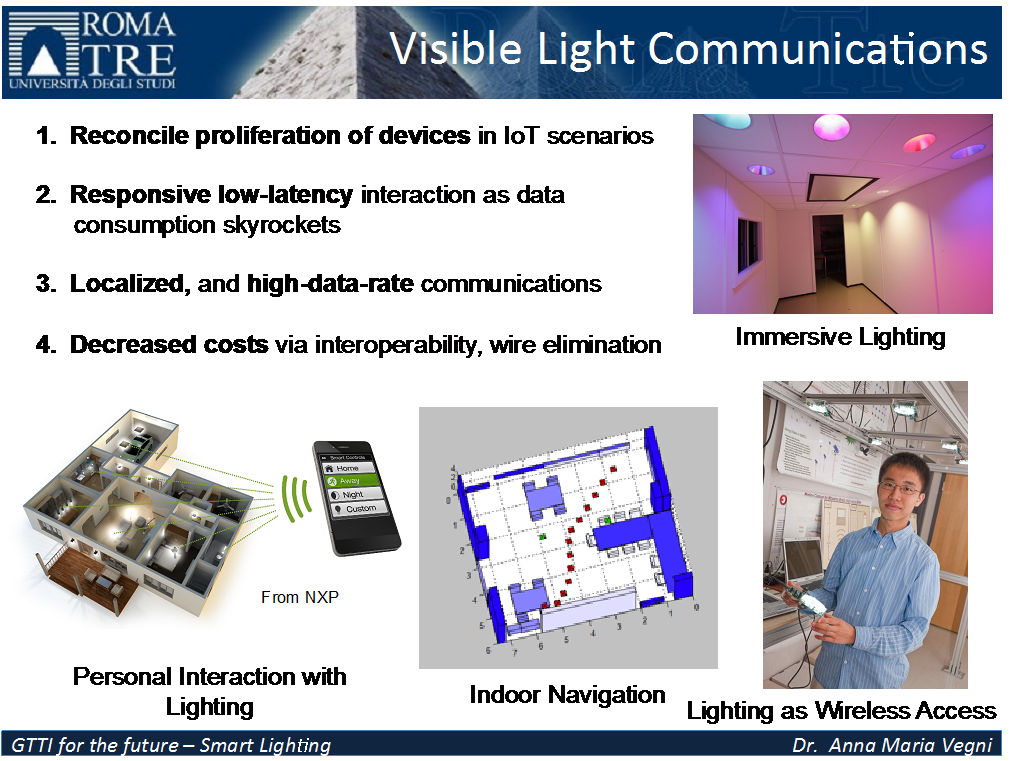

Vehicular Ad-hoc networks
Nowadays, several automotive manufacturers are looking forward to reach the goals envisioned by Vision 2020 action plan. Particularly, in 2012 the European Commission tabled the CARS 2020 Action Plan, aimed at reinforcing this industry’s competitiveness and sustainability heading towards 2020. The CAR 2020 Action Plan is supported by CARS 21 (Competitive Automotive Regulatory System for the 21 st century) Group, which provides recommendations to help car industry reaching new focuses, particularly those ones addressed to road safety. Indeed, it is known that worldwide more than one million people are killed, or injured in traffic accidents every year, mainly due to drivers’ misbehavior and bad road conditions.
Wireless ad hoc networks for vehicular environment i.e., the Vehicular Ad hoc NETworks (VANETs) are a particular class of Mobile Ad hoc NETworks (MANETs), characterized by high (variable) vehicle speed, hostile propagation environment and quickly changing network topologies. Opportunistic routing has been extended to VANETs in order to disseminate information and improve connectivity among vehicles. Message propagation occurs through (i) Vehicle-to-Vehicle (V2V) links built dynamically, where any vehicle can be used as next hop, so to form an end-to-end path toward a final destination and (ii) Vehicle-to-Infrastructure (V2I) links, assuming ubiquitous deployment of fixed road-side units.
COMLAB is involved in several initiatives about VANETs, such as:
- WiMob 2017: The 13th IEEE International Conference on Wireless and Mobile Computing, Networking and Communications, Oct 9-11, 2017, Rome, Italy. Link
- BalkanCom: Int. Balkan Conference on Communications and Networking, Tirana, Albania, June 1-3, 2017. Link
- International Conference on Selected Topics in Mobile & Wireless Networking, "MoWNet 2016," 11-13 April, 2016, Cairo, Egypt. Link
- International Conference on Civic Technologies for Smart Cities, "CivicTech 2015," collocated with Smart City 360 Summit, 13 October 2015, Bratislava, Slovakia.
COMLAB’s publications about VANETs are:
- A.M. Vegni, V. Loscrì and A.V. Vasilakos, "Vehicular Social Networks" CRC Taylor & Francis Group, March 2017, ISBN: 9781498749190
- A.M. Vegni and D.P. Agrawal, "Cognitive Vehicular Networks" CRC Taylor & Francis Group, February 2016, ISBN: 978-1498721912
- A.M. Vegni and T.D.C. Little, "VANETs as an Opportunistic Mobile Social Network," in Opportunistic Mobile Social Networks, J. Wu and Y. Wang (Eds.), CRC Press, Taylor & Francis Group, August 2014
- A.M. Vegni, C. Campolo, A. Molinaro and T.D.C. Little, "Modeling of Intermittent Connectivity in Opportunistic Networks: The Case of Vehicular Ad hoc Networks," in Routing in Opportunistic Networks, I. Woungang, S.K. Dhurandher, A. Anpalagan and A.V. Vasilakos (Eds.), Springer, 2013
- A.M. Vegni, M. Biagi and R. Cusani, "Smart Vehicles, Technologies and main Applications in Vehicular Ad hoc Networks," in Vehicular Technologies - Deployment and Applications, Dr. L. Galati Giordano (Ed.), ISBN 978-953-51-0992-1, InTech, February 2013
- A.M. Vegni and R. Cusani, "Connectivity Support in Heterogeneous Wireless Networks," in Recent Advances in Wireless Communications and Networks, ISBN 978-953-307-274-6, InTech, pages 454, August 2011
- A.M. Vegni, T. Inzerilli and R. Cusani, "Seamless Connectivity Techniques in Vehicular Ad-hoc Networks," in Advances in Vehicular Networking Technologies, ISBN 978-953-307-241-8, InTech, pages 432, April 2011
- A.M. Vegni and V. Loscrì, "A Survey on Vehicular Social Networks," IEEE Communications Surveys and Tutorials, vol.17, no.4, pp.2397-2419, Fourthquarter 2015, doi: 10.1109/COMST.2015.2453481, 2015
- A.M. Vegni and E. Natalizio, "Forwarder Smart Selection Protocol for Limitation of Broadcast Storm Problem," in Journal of Networks and Computer Applications (Elsevier), Volume 47, January 2015, pp. 61-71, ISSN 1084-8045
- A. Mostafa, A.M. Vegni and D.P. Agrawal, "A Probabilistic Routing by using Multi-hop Retransmission Forecast with Packet Collision-Aware Constraints in Vehicular Networks," Ad Hoc Networks (Elsevier) Journal, Volume 14, March 2014, pp. 118-129, ISSN 1570-8705, 2014
- V. Palma and A.M. Vegni, "On the Optimal Design of a Broadcast Data Dissemination System over VANET providing V2V and V2I Communications —The Vision of Rome as a Smart City—," Journal of Telecommunications and Information Technology (JTIT), no.1, 2013 (MS 76412)
- A. Mostafa, A.M. Vegni, T. Oliveira, T.D.C. Little and D.P. Agrawal, "QoSHVCP: Hybrid Vehicular Communications Protocol with QoS Priorization for Safety Applications,"ISRN Communications and Networking, vol.2012, 14 pages, 2012
- A.M. Vegni and T.D.C. Little, "Hybrid Vehicular Communications based on V2V-V2I Protocol Switching", Intl. Journal of Vehicle Information and Communication Systems (IJVICS), Vol. 2, Nos. 3/4, pp.213–231, 2011, DOI 10.1504/IJVICS.2011.044263
- A.M. Vegni, V. Loscrì and R. Petrolo, "SCARF: A SoCial-Aware Reliable Forwarding Technique for Vehicular Communications," in Proc. of 3rd Workshop on Experiences with the Design and Implementation of Smart Objects (SMARTOBJECTS 2017), in conjunction with ACM MobiCom 2017, October 16th, 2017, Snowbird, Utah, USA. INVITED PAPER
- A. Mostafa, A.M. Vegni, A. Bandaranayake and D.P. Agrawal, "QoS-aware Node Selection Algorithm for Routing Protocols in VANETs" in Proc. of Intl. Conf. on selected topics in Mobile and Wireless Networking (MoWNet 2014), September 8-9, 2014, Rome, Italy
- A.M. Vegni, A. Stramacci and E. Natalizio, "Opportunistic Clusters Selection in a Reliable Enhanced Broadcast Protocol for Vehicular Ad hoc Networks," in Proc. of 10th Annual Conf. on Wireless On-Demand Network Systems and Services (WONS 2013), March 18-20, 2013, Banff, Alberta, Canada
- A.M. Vegni, A. Mostafa and D.P. Agrawal, "CAREFOR: Collision-Aware REliable FORwarding Technique for Vehicular Ad hoc Networks," in Proc. of Intl. Conf. on Computing, Networking and Communications (ICNC 2013), Mobile Computing & Vehicle Comm. Symp., January 28-31, 2013, San Diego, CA, USA
- A.M. Vegni, A. Stramacci and E. Natalizio, "SRB: A Selective Reliable Broadcast Protocol for Safety Applications in VANET," in Proc. of Intl. Conf. on Selected Topics in Mobile & Wireless Networking (iCOST 2012), July 2-4, 2012, Avignon, France
- A. Mostafa, A.M. Vegni, R. Singoria, T. Oliveira, T.D.C. Little and D.P. Agrawal, "A V2X-based approach for reduction of delay propagation in Vehicular Ad-Hoc Networks," in Proc. of Intl. Workshop on Seamless Connectivity in Vehicular Networks, part of the 11th IEEE Intl. Conf. on ITS Telecommunications (ITST 2011), August 23-25, 2011, Saint-Petersburg, Russia
- V. Palma, E. Mammi, A.M. Vegni and A. Neri, "A Fountain Codes-based Data Dissemination Technique in Vehicular Ad-hoc Networks," in Proc. of Intl. Workshop on Seamless Connectivity in Vehicular Networks, part of the 11th IEEE Intl. Conf, on ITS Telecommunications (ITST 2011), August 23-25, 2011, Saint-Petersburg, Russia
- A.M. Vegni and T.D.C. Little, "A Message Propagation Model for Hybrid Vehicular Communication Protocols," in Proc. of 2nd Intl. Workshop on Communication Technologies for Vehicles (Nets4Cars 2010), in 7th IEEE Intl. Symp. on Communication Systems, Networks and DSP (CSNDSP 2010), July 21-23, 2010, Newcastle, UK
- F. Esposito, A.M. Vegni, I. Matta and A. Neri, "On Modeling Speed-Based Vertical Handovers in Vehicular Networks —Dad, slow down, I am watching the movie—," in Proc. of IEEE Globecom 2010 Workshop on Seamless Wireless Mobility (SWM 2010), December 6-10, 2010, Miami FL, USA
- A.M. Vegni, C. Vegni and T.D.C. Little, "Opportunistic Vehicular Networks by Satellite Links for Safety Applications," accepted presentation (included in the proceedings) at The Fully Networked Car Workshop @ Geneva International Motor Show, Geneva, Switzerland, March 3-4, 2010
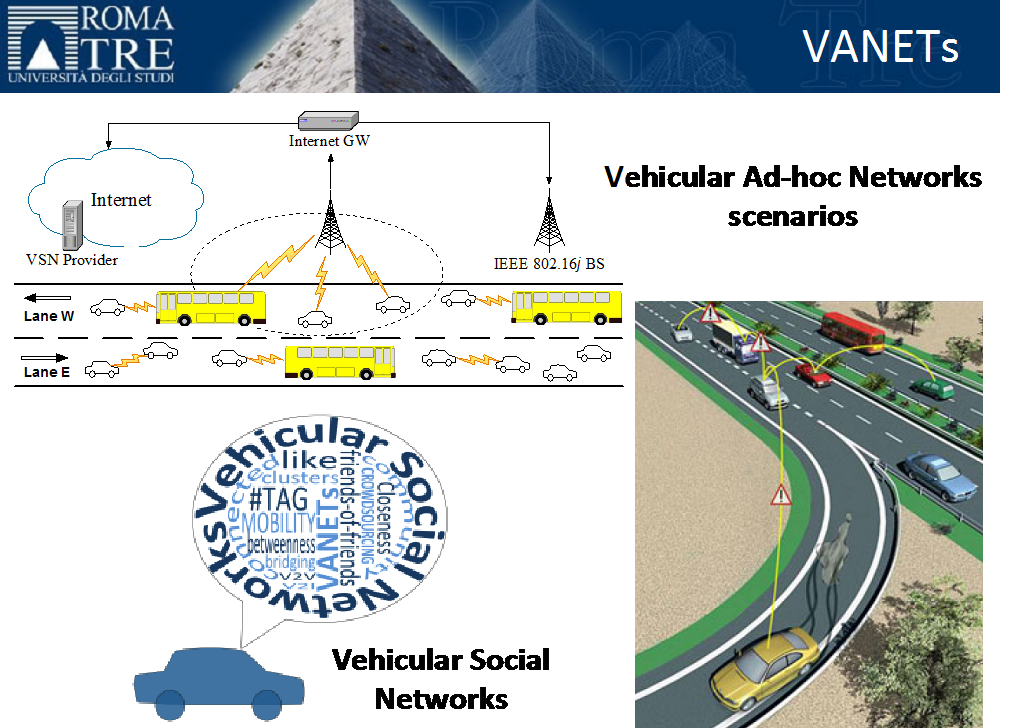
Our Team
Our alumni
Alessandro Neri - Full Professor

Contacts
![]() Department of Engineering
Department of Engineering
Applied Electronics Section
Roma TRE University
via Vito Volterra, 60 - Corpo B
00146, Roma - Italy
3rd floor - room 3.20
![]() +39 06 5733 7017
+39 06 5733 7017
![]() 81002
81002
![]() +39 06 5733 7026
+39 06 5733 7026
![]() alessandro.neri
alessandro.neri![]() uniroma3.it
uniroma3.it
Personal page updated to:
3 Sep 2019
Alessandro Neri is full professor in Telecommunications at the Engineering Department of the University 'Roma Tre' of Rome, Italy.
He was born in Viterbo in 1954. In 1977 he received the Doctoral Degree cum laude in Electronic Engineering from the University of Rome 'La Sapienza'.
In 1978 he joined the Research and Development Department of Contraves Italiana S.p.A. where he gained a specific expertise in the field of radar signal processing and in applied detection and estimation theory, becoming the chief of the advanced systems group.
In 1987 he joined the INFOCOM Department of the University of Rome 'La Sapienza' as Associate Professor in Signal and Information Theory at the Engineering Faculty. In November 1992 he joined the Electronic Engineering Department of the University of Roma TRE as Associate Professor in Electrical Communications, and became full professor in Telecommunications in semptember 2001 (in 2012 the Electronic Engineering Department and the other Engineering Departments of Roma Tre merged into the Engineering Department).
Prof. Neri is also member of the board of the Doctoral School on Electronic Engineering of the University of Roma TRE.
Since December 2008, prof. Neri is the President of the RadioLabs Consortium (Consorzio Università Industria - Laboratori di Radiocomunicazioni), a not-for-profit Research Center created in 2001 to promote tight cooperation on applied research programs between universities and industries, and currently linking the University of Rome 'Tor Vergata', the University of Roma Tre, The University of Aquila, Ansaldo STS and Hitachi Systems CBT. He is currently teaching Digital Communications, Information Theory, and Navigation and Localization Systems, at the Engineering Department of Roma Tre.
His research activity has mainly been focused on Information Theory, Detection and Estimation Theory, Digital Signal Processing, and Image Processing and their applications to both telecommunications systems, navigation, and remote sensing including
- Navigation and Localization Systems
- Mobile communications (4G, 5G, Public Protection and Disater Relief Networks)
- Internet of Things
- Communications Security
- Machine intelligence
- Multimedia
He is author of more than 300 publications (Scopus h index: 20, Scopus citation index: 1830, Google Scholar h index: 29, Google Scholar citation index: 3690, id ORCID: orcid.org/0000-0002-5911-9490).
Since 2004 he is also Professor, by courtesy, at 'Scuola Superiore di Specializzazione in Telecomunicazioni', a Post Master Degree School in Telecommunications of The Ministry of Economic Development.
From 2006 to 2008 he was Professor, by courtesy, of 'Economics and Management of Communication Technologies', at the Business School of the LUISS University, Rome (Laurea Magistralis curriculum). Since 2008 to 2010 he was Professor, by courtesy, of 'Economics and Management of Communication Technologies', of the Master in Business Administration at the Business School of the LUISS University, Rome.
Since 1992, he is responsible for coordination and management of research and teaching activities in the Telecommunication fields at the University of Roma TRE, currently leading the COMLAB - Digital Signal Processing, Multimedia and Optical Communications Laboratory.
He is a member of IEEE and of the Institute of Navigation (ION).
- H2020-Galileo-2015-1: 'RHINOS Railway High Integrity Navigation Overlay System' (H2020 Project coordinator)
- H2020-Galileo-2015-1: 'STARS: Satellite Technology for Advanced Railway Signalling'
- H2020-Galileo-2014-1: 'ERSAT EAV - ERTMS on SATELLITE - Enabling Application Validation' - PId 640747
- ESA 2016 GSTP: 'Digital Beamforming for RAIL (DB4Rail)'
- H2020 Secure Societies DS-3-2015 ATENA (Advanced Tools to assEss and mitigate the criticality of ICT compoNents and their dependencies over CIs)
- ASI 2014 'RAMPS: Railway Augmented Multisensor Positioning System'
- ESA 2014 ARTES 20: 'Space Based Services for Railway Signalling (SBS-RailS)'
- ESA 2012 ARTES 20: 'Train Integrated Safety Satellite System (3InSat)'
- EU FP7-SEC-2012-1 'ISITEP Inter System Interoperability for TETRA-TETRAPOL Networks'
- ESA 2010 'Locksat B'
- EU FP7 'CockpitCI - CyberSecurity on Scada: Risk protection, analysis and reaction tools for Critical Infrastuctures'
- EU FP7 'MICIE: Tool for sistemic risk analysis and secure mediation of data exchanged across linked CI information infrastructures'
- 'ESSOR: European Secure Software Defined Radio'
- 'DAHMS: Distributed Architecture Home Modular Multifunctional Systems'
International Journals
- Y. Liu, A. Neri, A. Ruggeri, A. M. Vegni, 'A MPTCP-Based Network Architecture for Intelligent Train Control and Traffic Management Operations'. IEEE Transactions on Intelligent Transportation Systems, vol. PP, no.99, pp.1-13, Dec. 2016
- Giuliano Romeo, Mazzenga Franco, Neri Alessandro, Vegni Anna Maria (2016). Security Access Protocols in IoT Capillary Networks. IEEE INTERNET OF THINGS JOURNAL, p. 1, ISSN: 2327-4662, doi: 10.1109/JIOT.2016.2624824
- F. Mazzenga, R. Giuliano, A. Neri, F. Rispoli, 'Integrated Public Mobile Radio Networks/Satellite for Future Railway Communications'. IEEE Wireless Communications, vol.PP, no.99, pp.2-9, November 2016
- F. Rispoli, A. Neri, F. Senesi, 'Innovative train control systems based on ERTMS and satellite-public TLC networks', WIT Transactions on the Built Environment, Volume 135, 2014, Pages 51-61, 14th International Conference on Railway Engineering Design and Optimization, COMPRAIL 2014; Rome; Italy; 24-26 June 2014
- F. Battisti, M. Carli, A. Neri, 'No reference quality assessment for MPEG video delivery over IP', EURASIP Journal on Image and Video Processing 2014, 2014:13, http://jivp.eurasipjournals.com/content/2014/1/13
- A. Neri, M. Carli and F. Battisti, 'Maximum likelihood estimation of depth field for trinocular images', Electronic Letters, Volume: 49, Issue: 6, 2013
- L. Costantini, L. Capodiferro, M. Carli M, A. Neri A, 'Texture segmentation based on Laguerre Gauss functions and k-means algorithm driven by Kullback-Leibler divergence', Journal of Electronic Imaging, vol. 22, ISSN: 1017-9909, doi: 10.1117/1.JEI.22.4.043015, November 2013
- Castrucci M, Neri A, Caldeira F, Jocelyn Aubert, Djamel Khadraoui, Matthieu Aubigny, Carlo Harpes, Paulo Sim›es, Vincenzo Suraci, Paolo Capodieci (2012). Design and implementation of a mediation system enabling secure communication among Critical Infrastructures. International Journal of Critical Infrastructure Protection, vol. 5, p. 86-97, ISSN: 1874-5482, doi: 10.1016/j.ijcip.2012.04.001, 2012
- Battisti F., Carli M., Mammi E., Neri A, 'A study on the impact of AL-FEC techniques on TV over IP Quality of Experience', Eurasip Journal on Advances In Signal Processing, vol. 2011:86, ISSN: 1687-6172, doi: 10.1186/1687-6180-2011-86, 2011
- M. Cancellaro, F. Battisti, M. Carli, G. Boato, F.G.B. De Natale, A. Neri, 'A commutative digital image watermarking and encryption method in the tree structured Haar transform domain', Signal Processing-Image Communication, vol. 26, p. 1-12, ISSN: 0923-5965, doi: 10.1016/j.image.2010.11.001, 2011
- F. Battisti, G. Boato, M. Carli, A. Neri 'Teaching multimedia data protection through an international on line competition', IEEE Transactions On Education, vol. 54, p. 381-386, ISSN: 0018-9359, doi: http://dx.doi.org/10.1109/TE.2010.2061850, 2011
- D. Cacciani, F. Garzia, A. Neri, R. Cusani, 'Optimal Territorial Resources Placement for Multipurpose Wireless Services Using Genetic Algorithms', Wireless Engineering And Technology, vol. 2, p. 184-195, ISSN: 2152-2294, doi: 10.4236/wet.2011.23026, 2011
- T. Inzerilli, A.M. Vegni, A. Neri, and R. Cusani 'A Cross-Layer Location-Based Approach for Mobile-Controlled Connectivity,' International Journal of Digital Multimedia Broadcasting, vol. 2010, Article ID 597105, 13 pages, 2010
- Alessandro Neri, Marco Carli, Veronica Palma, Luca Costantini 'Image search based on quadtree Zernike decomposition', Journal of Electronic Imaging, Vol. 19, No. 4, 2010
- E. Maiorana, P. Campisi , J. Fierrez, J. Ortega-Garcia, A. Neri ' Template Protection for Function-based Biometrics with Application to on-line Signature Recognition', IEEE System Man and Man and Cybernetics-Part A: Systems and Humans, vol.40, no.3, pp. 525-538, May 2010
- Maiorana E, Campisi P, Fierrez J, Ortega-Garcia J, A. Neri, 'Cancelable Templates for Sequence-Based Biometrics with Application to On-line Signature Recognition', IEEE Transactions On Systems Man And Cybernetics Part A-Systems And Humans, vol. 40, N. 3; p. 525-538, ISSN: 1083-4427, doi: 10.1109/TSMCA.2010.2041653, 2010
- A. Neri, A. Di Nepi, and A.M. Vegni, 'DOA and TOA Based Localization Services Protocol in IEEE 802.11 Networks', Special Issue Wireless Personal Communications Journal, Vol. 54, no. 1, pp. 155-168, DOI 10.1007/s11277-009-9719-y
- F. Battisti, M. Cancellaro, G. Boato, M. Carli, and A. Neri, 'Joint Watermarking and Encryption of Color Images in the Fibonacci-Haar Domain,' EURASIP Journal on Advances in Signal Processing, vol. 2009, Article ID 938515, 13 pages, 2009. doi:10.1155/2009/938515
- E. Maiorana, P. Campisi, A. Neri, 'Template Protection and Renewability for Dynamic Time Warping based Biometric Signature Verification', International Journal for Digital Crime and Forensic, Vol.1 No. 4, Oct-Dec 2009
- Battisti F, Cancellaro M, Boato G, Carli M, Neri A. (2009). Joint Watermarking and Encryption of Color Images in the Fibonacci-Haar Domain. EURASIP Journal On Advances In Signal Processing, vol. 2009, ISSN: 1687-6172, doi: 10.1155/2009/938515
- BENEDETTO F, GIUNTA G, Neri A. (2009). A Bayesian Business Model for Video-Call Billing for End-to-End QoS Provision. IEEE Transactions On Vehicular Technology, vol. 58 Issue: 2 Feb. 2009; p. 836-842, ISSN: 0018-9545, doi: 10.1109/TVT.2008.925316, 2009
- CAMPISI P, MAIORANA E, LO BOSCO E, Neri A. (2009). User Authentication using keystroke dynamics for cellular phones. IET Signal Processing, vol. 3; p. 333-341, ISSN: 1751-9675, doi: 10.1049/iet-spr.2008.0171
- MAIORANA E, CAMPISI P, FIERREZ J, ORTEGA-GARCI, J, Neri A. (2009). Cancelable Templates for Sequence-Based Biometrics with Application to On-line Signature Recognition. IEEE TRANSACTIONS ON SYSTEMS MAN AND CYBERNETICS PART A-SYSTEMS AND HUMANS, vol. 40 Issue 3; p. 525-538, ISSN: 1083-4427, doi: 10.1109/TSMCA.2010.2041653
- MAIORANA E, CAMPISI P, Neri A. (2008). User Adaptive Fuzzy Commitment for Signature Templates Protection and Renewability. JOURNAL OF ELECTRONIC IMAGING, vol. 17 Issue: 1 Jan-March 2008, ISSN: 1017-9909, doi: 10.1117/1.2885239
- P. CAMPISI, E. MAIORANA, Neri A., G. SCARANO (2008). Video Textures Modeling and Synthesis using Fractal Processes. IET IMAGE PROCESSING, vol. 2 Issue: 1 Feb. 2008; p. 1-17, ISSN: 1751-9659, doi: 10.1049/iet-ipr:20065010
- VEGNI A, DI NEPI A, Neri A., VEGNI C (2008). Local positioning services on IEEE 802.11 Networks. RADIOENGINEERING, vol. 17 n.2; p. 42-47, ISSN: 1210-2512
- CAMPISI P, MAIORANA E, Neri A. (2007). Video Textures Fractal Modeling. IEEE SIGNAL PROCESSING LETTERS, vol. 14; p. 405-408, ISSN: 1070-9908, doi: 10.1109/LSP.2006.890100
- F. BENEDETTO, G. GIUNTA, Neri A. (2007). QoS Assessment of 3G Video-Phone Calls by Tracing Watermarking Exploiting the New Colour Space YST. IET COMMUNICATIONS, vol. 1, ISSUE 4 August 2007; p. 696-704, ISSN: 1751-8628, doi: 10.1049/iet-com:20060331
- G. PAPARI, P. CAMPISI, N. PETKOV, Neri A. (2007). A Biologically Motivated Multiresolution Approach to Contour Detection. EURASIP JOURNAL ON ADVANCES IN SIGNAL PROCESSING, vol. 2007, ISSN: 1687-6172, doi: 10.1155/2007/71828
- M. CARLI, P. CAMPISI, Neri A. (2006). Perceptual aspects in data hiding. TELECOMMUNICATION SYSTEMS, vol. 33; p. 117-129, ISSN: 1018-4864, doi: 10.1007/s11235-006-9009-x
- S. CONFORTO, M. SCHMID, Neri A., T. DALESSIO (2006). A Neural Approach to Extract foreground from Human Movement Images. COMPUTER METHODS AND PROGRAMS IN BIOMEDICINE; p. 73-80, ISSN: 0169-2607, doi: 10.1016/j.cmpb.2006.02.005
- G. Cincotti, M. Svaluto Moreolo, Neri A., ' Optical wavelet signals processing and multiplexing'. EURASIP Journal On Applied Signal Processing, vol. 10; p. 1574-1583, ISSN: 1110-8657, doi: 10.1155/ASP.2005.1574, special issue on 'Signal Analysis Tools for Optical Information Processing'
- G. Giunta, Neri A., Vanderdorpe, 'Initial Code Synchronization of W-CDMA Mobile Systems Exploiting Local Phase Coherence and Pisarenko Estimation'. IEEE Transactions On Communications, vol. 53, Issue 1, Jan 2005; p. 48-52, ISSN: 0090-6778, doi: 10.1109/TCOMM.2004.840671
- P. Campisi, D.Kundur, Neri A., 'Robust digital watermarking in the Ridgelet domain'. IEEE Signal Processing Letters, vol. 11; No. 10, October 2004, p. 826-830, ISSN: 1070-9908
- M. Svaluto Moreolo, G. Cincotti, A. Neri, 'Synthesis of optical wavelet filters', IEEE Photonics Technology Letters, Vol. 16, Issue 7, July 2004 Page(s):1679-1681, doi: 10.1109/LPT.2004.828520
- Campisi P, Neri A., Panci G, Scarano G., 'Robust rotation-invariant texture classification using a model based approach'. IEEE Transactions On Image Processing, vol. 13, Issue: 6, June 2004; p. 782-791, ISSN: 1057-7149, doi: 10.1109/TIP.2003.822607
- G. Cincotti, A. Neri, 'Design and Performances of Logarithmic Wavelength Demultiplexers', IEEE Photonics Technology Letters, Vol. 16, Issue: 5, Pages:1325 - 1327, May 2004, ISSN: 0733-8724
- Neri A., G. Jacovitti, 'Maximum Likelihood Localization of 2D Patterns in the Gauss-Laguerre Transform Domain: Theoretic Framework and Preliminary Results'. IEEE Transactions On Image Processing, vol. 13, Issue 1, Jan. 2004; p. 72-86, ISSN: 1057-7149
- J.A. Berger, S.K. Mitra, M. Carli, Neri A., 'Visualization and Analysis of DNA Sequences Using DNA Walks'. Journal Of The Franklin Institute, Volume: 341, Issue: 1-2, January - March, 2004, pp. 37-53 ISSN: 0016-0032 doi:10.1016/j.jfranklin.2003.12.002
- G. Giunta, A. Neri, M. Carli , 'Constrained Optimization of Non-Coherent Serial Acquisition of Spread-Spectrum Code by Exploiting the Generalized Q-Functions', IEEE Transactions on Vehicular Technology, Vol. 52, Issue: 5, Pages. 1378-1385, Sept. 2003, ISSN: 0018-9545
- G. Cincotti, A. Neri, 'Logarithmic wavelength demultiplexers'', IEEE Journal of Lightwave Technology, Volume: 21, Issue: 6, Pages:1576 - 1583, June 2003
- P. Campisi, M. Carli, G. Giunta, A. Neri, 'Blind quality assessment system for multimedia communication using tracing watermarking', IEEE Transactions on Signal Processing, Vol. 51, N.4, pp. 996-1002, April 2003
- P. Campisi, D. Kundur, D. Hatzinakos, A. Neri, 'Compressive Data Hiding: An Unconventional Approach for Improved Color Image Coding', EURASIP Journal of Applied Signal Processing, vol. 2002, pp. 152-163 ISSN: 1110-8657. N. 2, February 2002
- G. Jacovitti, A. Neri, 'Multiresolution circular harmonic decomposition', IEEE Trans. on Signal Processing, Vol.. 48. No. 11, 00.3242-3247, November 2000
- P. Campisi, A. Neri, D. Hatzinakos, 'A Perceptually Lossless, Model Based, Texture Compression Technique', IEEE Trans. on Image Processing, Vol.9, No 8, pp.1325-1336, August 2000
- P. Campisi, A. Neri, G. Scarano, 'Reduced Complexity Modeling and Reproduction of Colored Textures', IEEE Trans. on Image Processing, Vol. 9 No.3, pp. 510-518, March 2000
- G. Jacovitti, A.Neri, G.Scarano, 'Texture Synthesis by analysis with hard limited Gaussian processes', IEEE Transactions on Image Processing, Vo. 7, No. 11, pp.1615-1621, Nov. 1998
- Neri, S. Colonnese, (1998), 'On the computation of warping-based motion compensation in video sequence coding', Signal Processing: Image Communication, Elsevier,Volume 13, Issue: 2, pp. 155-160, August 1998
- Neri, S. Colonnese, G. Russo, P. Talone, (1998), 'Automatic Moving Object and Background Separation', Signal Processing, Special Issue on Video Sequence Segmentation for Content-based Processing and Manipulation, Elsevier, Volume: 66, Issue: 2, pp. 219-232, April 30, 1998
- Neri, (1996) 'Optimal Detection and Estimation of Straight Patterns', IEEE Trans. on Image Processing, Vol. 5, No. 5, pp. 787-792, May 1996
- Neri, G. Russo, P. Talone, (1994) 'Inter-block Filtering and Downsampling in DCT Domain', Signal Processing: Image Communication, Elsevier, Vol. 4, N. 6, pp.303-317, 1994
- G. Jacovitti, A. Neri, (1994) 'Estimation of the Autocorrelation Function of Complex Gaussian Stationary Processes by Amplitude Clipped Signals', IEEE Trans. on Information Theory, Vol. 40, N0. 1, pp. 239-245, Jan. 1994
- Carrion, G. Jacovitti, A. Neri, 'Gaussian and Non-Gaussian Tomographic Modelling Via Simulated Annealing', Journal of Seismic Exploration 2, pp. 189-204, July 1993
- G. Giunta, G. Jacovitti, A. Neri, 'Band-pass Non-Linear System Identification by Higher Order Cross-Correlation', IEEE Trans. on Signal Processing, Vol.39 N.9, pp. 2092-2095, September 1991
- M. Imperato, G. Jacovitti, A. Neri, 'Space Variant Resolution ADCT Still Image Coding', European Trans. on Telecommunication, ETT Vol. 2 N.3, pp.209-304, May-June 1991
- G. Di Blasio, A. Neri (1991), 'Modified Q-Functions and Their Use in Detection Analysis', IEEE Trans. on Information Theory, Vol. IT-37 N.4, pp. 1123-1142, July 1991
- G. Giunta, A. Neri, 'Neural Correlation Based on IPFM Model', IEEE Trans. on System, Man and Cybernetics, Vol.20, N.1, pp. 262-268, Jan. 1990
- G. Jacovitti, A. Neri, R. Cusani, 'Methods for Estimating the Autocorrelation Function of Complex Gaussian Stationary Processes', IEEE Trans on Acoustics, Speech and Signal Processing, Vol. ASSP-35, N.8,pp.1126-1138, August 1987
- Neri (1985), 'An Approach to Clutter Residual Modeling and Estimation', Alta Frequenza, Vol. LIV N.1, pp.27-36, Jan-Feb. 1985
- G. Jacovitti, A. Neri, G. Scarano, 'Pulsed Response of Focused Arrays in Ecographic B-Mode Systems', IEEE Trans. on Sonics and Ultrasonics, Vol. SU-32, N.6, pp. 850-860, November 1985
- R. Cusani, A. Neri, 'A Modified Hybrid Sign Estimator for the Normalized Autocorrelation Function of a Gaussian Stationary Process', IEEE Trans on Acoustics, Speech and Signal Processing, Vol. ASSP-33, N.5,pp.1321-1324, October 1985
- G. Jacovitti, A. Neri, R. Cusani, 'On a Fast Digital Method of Estimating the Autocorrelation of a Gaussian Stationary Process', IEEE Trans. on Acoustic, Speech and Signal processing, Vol. ASSP-32 N.5, pp. 968-976, October 1984
Books
- Claudio Becchetti and Alessandro Neri, Medical Instrument Design and Development: From Requirements to Market Placements, Wiley, Jul 22, 2013, ISBN: 978-1-119-95240-4
Book Chapters and CDROM
- Giuliano R., Mazzenga F., Neri A., Vegni A.M. (2016). “Security Protocols for IoT Access Networks”. F. Hu, Security and Privacy in Internet of Things (IoTs): Models, Algorithms, and Implementations. ISBN: 9781498723183
- P. Campisi, E. Maiorana, and A. Neri, 'Signature Biometrics', in Encyclopedia of Cryptography and Security, Springer, 2011, doi: ISBN 978-1-4419-5905-8
- P. Campisi, E. Maiorana, H. Mouchere, C. Viard-Gaudin, and A. Neri, 'Handwriting and Writer Identification', in Encyclopedia of Cryptography and Security, Springer, 2011, doi: ISBN 978-1-4419-5905-8
- P. Campisi, A. Neri, 'Keystroke', in Encyclopedia of Cryptography and Security, Springer , 2011, doi: ISBN 978-1-4419-5905-8
- P. Campisi, E. Maiorana, and A. Neri, 'Privacy Enhancing Technologies in Biometrics' in Handbook of Research on Computational Forensics, Digital Crime and Investigation: Methods and Solutions. Editor Chang-Tsun Li, IGI Global, Hershey, PA. USA, ISBN-13: 9781605668369, January 2010
- P. Campisi, E. Maiorana, A. Neri, (2009) “Iris Template Protection”, in Encyclopedia of Biometrics, Stan Z. Li ed., Springer, ISBN: 978-0-387-73003-5, to be published (June 2009)
- P. Campisi , E. Maiorana, and A. Neri, (2009) “On-line signature based authentication: template security issues and countermeasures ”, in Biometrics: Theory, Methods, and Applications' N. V. Boulgouris, K.N. Plataniotis, and E.Micheli-Tzanakou, editors, to be published by Wiley/IEEE (January 2009)
- Maiorana E., Campisi P. , and Neri. A, “Template Protection for On-Line Signature-Based Recognition Systems” in Biometrics and Identity Management, Book Series Lecture Notes in Computer Science, Volume 5372/2008 Pages 170-180. Decenber 2008. Springer Berlin / Heidelberg ISBN 978-3-540-89990-7, doi: 10.1007/978-3-540-89991-4_18
- CAMPISI P, COLONNESE S, Neri A., PANCI G, SCARANO G (2007). Blind Image Deconvolution using Bussgang techniques: Applications to deblurring and texture synthesis. P. CAMPISI; K. EGIAZARIAN. Blind image deconvolution: theory and applications. p. 43-93, BOCA RATON: CRC Press, ISBN/ISSN: 9780849373671
- Neri A., CARLI M., MITRA S.K (2006). Perceptual aspects of image coding. BARNI M.. Document and Image Compression. p. 69-86, BOCA RATON, FL: CRC Press, ISBN/ISSN: 9780849335563
- G.Jacovitti, A. Neri, A. Laurenti, 'Tomographic reconstruction from partial angular views using Gibbsian models', in Selected SPIE Papers on CD-ROM series, Vol 8: Mathematical Imaging and Vision, Gerhard Ritter editor, December 1999
- A. Neri, P. Carrion, G. Jacovitti, A. Vesnaver 'Tomographic reconstruction from incomplete data set with deterministic and stochastic constraints', in Selected SPIE Papers on CD-ROM series, Vol 8: Mathematical Imaging and Vision, Gerhard Ritter editor, December 1999
- G. Jacovitti, A. Neri, “Multiscale image features analysis with circular harmonic wavelets”, in Selected SPIE Papers on CD-ROM series, Vol 8: Mathematical Imaging and Vision, Gerhard Ritter editor, December 1999
- G. Jacovitti, A. Neri, S. Puledda, 'Multiresolution tomographyc inversion from incomplete data set', in Selected SPIE Papers on CD-ROM series, Vol 8: Mathematical Imaging and Vision, Gerhard Ritter editor, December 1999
- G. Jacovitti, A. Neri, S. Puledda 'Stochastic Improvement of Tomographic Inversion' in Modeling The Earth for Oil Exploration, pp.509-524, Pergamon, 1994
International Conferences
- R. Copeland, S. Ahvar, N. Crespi, M. Copeland, R. Durand, J.-M. Duquerrois, F. Paganelli, F. Battisti, A. Neri, "Technology Assessment for Mission-Critical Services on Automotive Virtual Edge Communicator (AVEC)", Proc. 21st Conference on Innovation in Clouds, Internet and Networks (ICIN), 20-22 February, 2018, Paris, France
- Alessandro Neri, Federica Battisti, Federico Colangelo, Marco Carli, 'Unsupervised Video Orchestration Based on Aesthetic Features', ISCASS 2017
- Alessandro Neri, Gianluigi Fontana, Salvatore Sabina, Francesco Rispoli, Roberto Capua, Andrea Coluccia, Veronica Palma, Cosimo Stallo, Alessia Vennarini, 'High Integrity Multiconstellation Positioning in ERTMS on SATELLITE - Enabling Application Validation, ION PNT 2017
- Alessandro Neri, Roberto Capua, Massimo Massaro, Pietro Salvatori, 'Performance of Indoor Positioning based on TDOA over OFDM-like Signals in Multipath Environments', ION PNT 2017
- Vegni Anna Maria, Loscri Valeria, Neri Alessandro, Leo Marco (2016). A Bayesian Packet Sharing Approach for Noisy IoT Scenarios. IEEE First International Conference on Internet-of-Things Design and Implementation (IoTDI). p. 305-308, IEEE, ISBN: 978-1-4673-9948-7, doi: 10.1109/IoTDI.2015.28
- A. Neri, V. Palma, F. Rispoli, S. Pullen, S. Zhang, S. Lo, P. Enge, 'A Method for Multipath Detection and Mitigation in Railway Control Applications', ION GNSS+ 2016, Portland, OR, U.S.A
- A. Neri, S. Sabina, R. Capua, P. Salvatori, 'Track Constrained RTK for Railway Applications', ION GNSS+ 2016, Portland, OR, U.S.A
- A. Neri, F. Rispoli, P. Salvatori, 'A GNSS based solution for supporting virtual block operations in train control systems', IAIN-2015, Prague, Czech Republic
- Neri, A., Carli, M., Battisti, F., 'A multi-resolution approach to depth field estimation in dense image arrays,' in Image Processing (ICIP), 2015 IEEE International Conference on , vol., no., pp.3358-3362, 27-30 Sept. 2015
- Battisti, F., Carli, M., Yiwei Liu, Neri, A., Paudyal, P., 'Distortion-based no-reference quality metric for video transmission over IP,' in Signals, Circuits and Systems (ISSCS), 2015 International Symposium on , vol., no., pp.1-4, 9-10 July 2015
- Yiwei Liu, Neri, A., Ruggeri, A., 'Integration of PLMN and satellite networks for train control and traffic management via MPTCP,' in ITS Telecommunications (ITST), 2015 14th International Conference on , vol., no., pp.75-79, 2-4 Dec. 2015
- F. Mazzenga, R. Giuliano, A. Neri, F. Rispoli, A. Ruggeri, M. Salvitti, E. Del Signore, V. Fontana, 'The Adoption of Public Telecom Services for the Evolution of the ERTMS-ETCS Train Control Systems: Challenges and Opportunities', Int. Workshop Comm. Tech. Veh. (Nets4Cars / Nets4Trains / Nets4Aircraft 2015), Sousse (Tunisia), May 2015. Published in the Springer Lecture Notes in Computer Science (LNCS), Communication Technologies for Vehicles, Vol. 9066, 2015, pp 177-188
- A. Neri, F. Rispoli, P. Salvatori, 'The perspective of adopting the GNSS for the evolution of the european train control system (ERTMS): a roadmap for standardized and certifiable platform', ION GNSS+ 2015, Tampa, FL, U.S.A
- A. Neri, S. Sabina, U. Mascia, 'GNSS and odometry fusion for high integrity and high available train control systems', ION GNSS+ 2015, Tampa, FL, U.S.A
- A. Neri, F. Rispoli, and P. Salvatori, 'An analytical assessment of a GNSS based train integrity solution in typical ERTMS level 3 scenario', ENC 2015, Bordeaux, France
- P. Salvatori, A. Neri, C. Stallo, and F. Rispoli, 'Ionospheric Incremental Delay Models in Railway Applications', IEEE International Workshop on Metrology for AeroSpace, 2015, Benevento, Italy
- Neri, A., Capua, R., Salvatori, P., 'High Integrity Two-tiers Augmentation Systems for Train Control Systems', ION Pacific PNT 2015, Honolulu, April 20-23 2015
- Vegni, C., Neri, A., 'GNSS Interference: Effects and Solutions', ION Pacific PNT 2015, Honolulu, April 20-23 2015
- M. Leo, F. Battisti, M. Carli, A. Neri, 'Face retrieval in video sequences using Web images database', Proc. SPIE. 9399, Image Processing: Algorithms and Systems XIII, 93990Y. (March 16, 2015) doi: 10.1117/12.2083316
- Leo, Marco, Battisti, Federica, Carli, Marco, Neri, Alessandro, 'A federated architecture approach for Internet of Things security,' Euro Med Telco Conference (EMTC), 2014 , vol., no., pp.1,5, 12-15 Nov. 2014 doi: 10.1109/EMTC.2014.6996632
- Smith, Edward, Ugolini, Mauro, Neri, Alessandro, 'The business requirements and technical fabric for the Smart City,' Euro Med Telco Conference (EMTC), 2014 , vol., no., pp.1,6, 12-15 Nov. 2014, doi: 10.1109/EMTC.2014.6996653
- F. Battisti, M. Carli, A. Neri, 'Subjective Evaluation of 3D Video Enhancement Algorithm', Eusipco 2014
- Salvatori, P., Neri, A., Stallo, C., Palma, V., Coluccia, A., Rispoli, F., 'Augmentation and Integrity Monitoring Network and EGNOS performance comparison for train positioning,' Signal Processing Conference (EUSIPCO), 2014 Proceedings of the 22nd European, vol., no., pp.186,190, 1-5 Sept. 2014
- Palma, V., Salvatori, P., Stallo, C., Coluccia, A., Neri, A., Rispoli, F., 'Performance evaluation in terms of accuracy positioning of local augmentation and integrity monitoring network for railway sector,' Metrology for Aerospace (MetroAeroSpace), 2014 IEEE, vol., no., pp.394, 398, 29-30 May 2014, doi: 10.1109/MetroAeroSpace.2014.6865956
- R. Giuliano, F. Mazzenga, A. Neri, A.M. Vegni, 'Security Access Protocols in IoT Networks with Heterogenous Non-IP Terminals', IoT'2014, 2nd Int. Workshop on Internet of Things - Ideas and Perspectives '14. May 2014
- A. Neri, F. Rispoli, P. Salvatori, 'CENELEC SIL-4 compliant approach for discriminating railway parallel tracks based on EGNOS-GALILEO receivers', ENC-GNSS 2014, April 2014
- E. Del Signore, R. Giuliano, F. Mazzenga, M. Petracca, M. Vari, F. Vatalaro, A. Neri, F. Rispoli, 'On the Suitability of Public Mobile Networks for Supporting Train Control/Management Systems', IEEE WCNC 2014
- E. Maiorana, P. Campisi, A. Neri, 'Iris Template Protection Using a Digital Modulation Paradigm', ICASSP 2014
- F. Battisti, M. Carli, and A. Neri, 'Detecting influence of digital image contrast modification in subjective opinion', ISCCSP 2014
- Federica Battisti, Marco Carli, Marco Leo, Alessandro Neri, 'Probabilistic person identification in TV news programs using image web database', Part of IST/SPIE Electronic Imaging 03 Feb 2014
- Rispoli, F., Filip, A., Castorina, M., Di Mambro, G. , Neri, A. , Senesi, F. 'Recent progress in application of GNSS and advanced communications for railway signaling', Radioelektronika (RADIOELEKTRONIKA), 2013 23rd International Conference Digital Object Identifier: 10.1109/RadioElek.2013.6530882 , Year: 2013 , Page(s): 13-22
- A. Neri, A.M. Vegni, and F. Rispoli, 'A PVT Estimation for the ERTMS Train Control Systems in presence of Multiple Tracks,' in Proc. of ION GNSS 2013, September 16-20, 2013, Nashville, TN, USA
- A. Neri, V. Palma, F. Rispoli, and A.M. Vegni, 'Track Constrained PVT Estimation based on the Double-Difference Technique for Railway Applications,' in Proc. of EUSIPCO 2013, September 9-13, 2013, Marrakech, Morocco
- A. Neri, C. Stallo, A. Coluccia, V. Palma, M. Ruggieri, F. Toni, P. Salvatori, F. Rispoli, 'On Board Unit Design For Train Positioning By GNSS' in Proc. of EUSIPCO 2013, September 9-13, 2013, Marrakech, Morocco
- L. Costantini, L. Capodiferro, A. Neri, 'A comparison between space-time video descriptors', Proc. SPIE. 8655, Image Processing: Algorithms and Systems XI 865513 (February 19, 2013) doi: 10.1117/12.2007575
- F. Battisti, M. Carli, G. Farinella, A. Neri, 'Target re-identification in low-quality camera networks', Proc. SPIE 8655: Image Processing: Algorithms and Systems XI, February 2013
- Basili, A., Ghisu, L., Rispoli, F., Buttarazzi, B., Neri, A., Senesi, F., 'A roadmap for the adoption of space assets for train control systems: The Test Site in Sardinia,' Satellite Telecommunications (ESTEL), 2012 IEEE First AESS European Conference on, vol., no., pp.1,6, 2-5 Oct. 2012,doi: 10.1109/ESTEL.2012.6400066
- A. Neri, A. Filip, F. Rispoli, A.M. Vegni, 'An Analytical Evaluation for Hazardous Failure Rate in a Satellite-based Train Positioning System with Reference to the ERTMS Train Control Systems', ION GNSS 2012, Nashville, 18-21 Sept. 2012
- Giuliano, R., Neri, A., Valletta, D., 'End-to-end secure connection in heterogeneous networks for critical scenarios,' Information Forensics and Security (WIFS), 2012 IEEE International Workshop on , vol., no., pp.264,269, 2-5 Dec. 2012, doi: 10.1109/WIFS.2012.6412660
- Giuliano, R., Mazzenga, F., Neri, A., Vegni, A.M., Valletta, D., 'Security implementation in heterogeneous networks with long delay channel,' Satellite Telecommunications (ESTEL), 2012 IEEE First AESS European Conference on, pp.1,6, 2-5 Oct. 2012, doi: 10.1109/ESTEL.2012.6400176
- Rigazzi, G., Palma, V., Tarnea, G., Santucci, F., Neri, A., 'A cross-layer routing protocol with Quality of service support for flexible deployment in MANETs,' Globecom Workshops (GC Wkshps), 2012 IEEE , vol., no., pp.508,512, 3-7 Dec. 2012, doi: 10.1109/GLOCOMW.2012.6477625
- F. Battisti, M. Carli, F. G. B. De Natale, Neri A (2012). 'Ear recognition based on edge potential function.', in SPIE Proceedings Vol. 8295 Image Processing: Algorithms and Systems X; and Parallel Processing for Imaging Applications II. San Francisco CA USA, 5 February 2012, ISBN: 9780819489425
- Luca Costantini, Licia Capodiferro, Marco Carli, Neri A (2012). 'Textured areas detection and segmentation in circular harmonic functions domain', SPIE Proceedings Vol. 8295 Image Processing: Algorithms and Systems X; and Parallel Processing for Imaging Applications II. San Francisco CA USA, 5 February 2012, ISBN: 9780819489425, doi: 10.1117/12.908123
- F. Battisti, M. Carli, Neri A (2012). Image forgery detection by means of no-reference quality metrics. Proceedings SPIE Vol. 8303 Media Watermarking, Security, and Forensics 2012,. ISBN: 9780819489500, doi: 10.1117/12.910778
- Anna Maria Vegni, Veronica Palma, Elena Mammi, Alessandro Neri (2011). A Fountain Codes-based Data Dissemination Technique in Vehicular Ad-hoc Networks. Proc. of Intl. Workshop on Seamless Connectivity in Vehicular Networks (SCVN 2011), part of the 11th IEEE Intl. Conference on ITS Telecommunications (ITST 2011). St. Petersburg, 23-25 Aug. 2011, p. 750-755, IEEE, ISBN: 9781612846682, doi: http://dx.doi.org/10.1109/ITST.2011.6060154
- Federica Battisti, Marco Carli, Alessandro Neri (2011). Secure annotation for medical images based on reversible watermarking in the Integer Fibonacci-Haar transform domain. Proc. SPIE International Conference on Electronic Imaging 2011, Image Processing: Algorithms and Systems IX, 23 - 27 January 2011, San Francisco, California, USA.. SPIE, doi: 10.1117/12.876631
- Battisti, F., Carli, M., Neri, A., Boato, G., 'Catch the mark: Teaching data hiding by gaming,' EUROCON - International Conference on Computer as a Tool (EUROCON), 2011 IEEE , vol., no., pp.1,4, 27-29 April 2011, doi: 10.1109/EUROCON.2011.5929180
- Costantini L, Sità P, Carli M, Neri A (2011). Features extraction based on Fisher's information. Proc. SPIE 7870, 787016 (2011). San Francisco, January 2011, ISBN: 9780819484079, doi: 10.1117/12.876581
- Palma V, Carli M, Neri A (2011). 3D scene reconstruction based on multi-view distributed video coding in the Zernike domain for mobile applications. Proc. SPIE 7881, 788106 (2011). ISBN: 9780819484185, doi: 10.1117/12.876460
- Palma V, Cancellaro M, Neri A (2011). Joint distributed source-channel coding for 3D videos. Proc. SPIE 7870, 787014 (2011). ISBN: 9780819484079, doi: 10.1117/12.872878
- Maiorana E, Campisi P, Neri A (2011). Bioconvolving: Cancelable templates for a multi-biometrics signature recognition system. Systems Conference (SysCon), 2011 IEEE International . p. 495-500, ISBN: 9781424494941, doi: 10.1109/SYSCON.2011.5929064
- Mammi E, Palma V, Neri A, Carli M (2011). Fountain code based AL-FEC for multicast services in MANETs. Wireless Telecommunications Symposium (WTS), 2011. ISBN: 978-1-4577-0162-7, doi: 10.1109/WTS.2011.5960868
- Neri, A., Ugolini, M., Allegretti, M., 'Agent-based modeling as a tool to investigate the viability of Next-Generation Networks,' FITCE Congress (FITCE), 2011 50th , vol., no., pp.1,7, Aug. 31 2011-Sept. 3 2011, doi: 10.1109/FITCE.2011.6133420
- L. Costantini, L. Capodiferro, M. Carli, A. Neri, 'IMPACT OF EDGES CHARACTERIZATION ON IMAGE CLUSTERING', EUVIP 2010, 2nd European Workshop on Visual Information Processing, July 5-7, 2010, Paris, France
- Luca Costantini, Paolo Sitˆ, Licia Capodiferro, Alessandro Neri, 'Laguerre Gauss analysis for image retrieval based on color texture', IST-SPIE Electronic Imaging Science and Technology, 17-21 January 2010, San Jose, California, USA
- Luca Costantini, Federica Mangiatordi, Licia Capodiferro, Alessandro Neri, 'Key points selection by using Zernike polynomials', IST/SPIE Electronic Imaging Science and Technology, 17-21 January 2010, San Jose, California, USA
- Luca Costantini, Paolo Sitˆ, Marco Carli, Alessandro Neri, 'Features Extraction Based on Fisher's Information', IST/SPIE Electronic Imaging Science and Technology, 23-27 January 2011, San Francisco Airport, California, USA
- F. Battisti, M. Carli, G. Boato, and A. Neri, 'Catch the Mark: teaching data hiding by gaming', Proc. EUROCON 2011, 27-29 April 2011, Lisbon, Portugal
- F. Battisti, M. Carli, and A. Neri, 'Secure annotation for medical images based on reversible watermarking in the Integer Fibonacci-Haar transform domain', Proc. SPIE International Conference on Electronic Imaging 2011, Image Processing: Algorithms and Systems IX, 23 - 27 January 2011, San Francisco, California, USA
- Mammi, E., Palma, V., Neri, A., Carli, M., Fountain code based AL-FEC for multicast services in MANETs, Wireless Telecommunications Symposium (WTS), 2011 Digital Object Identifier: 10.1109/WTS.2011.5960868 Publication Year: 2011 , Page(s): 1-7
- V. Palma, E. Mammi, A.M. Vegni, A. Neri, 'A Fountain Codes-based Data Dissemination Technique in Vehicular Ad-hoc Networks', SCVN 2011, August 2011, San Petersburg, Russia
- E. Mammi, G. Russo, A. Neri, 'Evaluation of AL-FEC performance for IP television services QoS', SPIE 2010, California, USA
- Neri, A., Circular Harmonic Functions: A unifying mathematical framework for image restoration, enhancement, indexing, retrieval and recognition, Visual Information Processing (EUVIP), 2010 2nd European Workshop on Digital Object Identifier: 10.1109/EUVIP.2010.5699150 Publication Year: 2010 , Page(s): 269 - 276
- Battisti, F., Carli, M., Neri, A., Video error concealment based on data hiding in the 3D wavelet domain, Visual Information Processing (EUVIP), 2010 2nd European Workshop on Digital Object Identifier: 10.1109/EUVIP.2010.5699123 Publication Year: 2010 , Page(s): 134 - 139
- Vegni, A.M., Carli, M., Neri, A., 'Localization services in hybrid self-organizing networks', Indoor Positioning and Indoor Navigation (IPIN), 2010 International Conference on Digital Object Identifier: 10.1109/IPIN.2010.5647330 Publication Year: 2010 , Page(s): 1-7
- Esposito, F., Vegni, A.M., Matta, I., Neri, A., 'On modeling speed-based vertical handovers in vehicular networks: 'Dad, slow down, I am watching the movie',' GLOBECOM Workshops (GC Wkshps), 2010 IEEE , vol., no., pp.11,15, 6-10 Dec. 2010,doi: 10.1109/GLOCOMW.2010.5700126
- CANCELLARO M, M. CARLI, Neri A. (2009). A distributed coding approach for stereo sequences in the Tree Structured Haar Transform domain. Proc. SPIE Image Processing: Algorithms and Systems VII. San Jose, California, January 2009
- E. MAMMI, BATTISTI F, M. CARLI, Neri A., AND K. EGIAZARIAN (2009). Substitutive Steganography in the Generalized Fibonacci Domain. Proc. SPIE International Conference on Electronic Imaging 2009, Image Processing: Algorithms and Systems. San Jose, California, January 2009SPIE
- Neri A., M.CARLI, PALMA V, L.COSTANTINI (2009). Template Matching Based on Quadtree Zernike Decomposition. SPIE 09 - IST SPIE's Annual Symposium Electronic Imaging Science and Technology. San Jose, California, January 18-22 2009
- Neri A., P. CAMPISI, BATTISTI F (2009). Fuzzy Edge Enhancement in the Complex Wavelet Domain. Proc.2009 International Workshop on Video Processing and Quality Metrics. Phoenix, Arizona, January 2009
- E. MAIORANA, CAMPISI P, J. ORTEGA-GARCIA, Neri A. Cancelable Biometrics for HMM-based signature Recognition. IEEE Second International Conference on Biometrics: Theory, Applications and Systems. Crystal City, Virginia, USA, 29 Septemberâ 1 October 2008, Digital Object Identifier 10.1109/BTAS.2008.4699360
- INZERILLI T, VEGNI A. M, Neri A., CUSANI R., A Location-Based Vertical Handover Algorithm for Limitation of the Ping-Pong Effect. Proc. of Networking and Communications, 2008. WIMOB '08. IEEE International Conference on Wireless and Mobile Computing, 12-14 Oct. 2008IEEE, p. 385-389, doi: 10.1109/WiMob.2008.64
- Neri A., D. BLASI, L. GIZZI, P. CAMPISI. Joint Security And Channel Coding For OFDM Communications. Proc. of 16 th European Signal Processing Conference (EUSIPCO 2008). Lausanne SWITZERLAND, August 2008
- MAIORANA E, MARTINEZ-DIAZ M, CAMPISI P, ORTEGA-GARCIA J, Neri A. Template protection for HMM-based on-line signature authentication. IEEE Computer Society Conference on Computer Vision and Pattern Recognition Workshops, 2008. CVPR Workshops 2008., 23-28 June 2008IEEE, p. 1-6, doi: 10.1109/CVPRW.2008.4563114
- E. MAMMI, F. BATTISTI, M. CARLI, Neri A., K. EGIAZARIAN, A spatial data hiding scheme based on generalized Fibonacci sequences. Proc. of SPIE Defense and Security 2008. Orlando, Florida, 16-20 March 2008 SPIE
- F. BATTISTI, M. CANCELLARO, M. CARLI, G. BOATO, Neri A. , Watermarking and encryption of color images in the Fibonacci domain. Proc. SPIE Image Processing: Algorithms and Systems VII. San Jose, California, January 2008SPIE
- ERCOLE C., CAMPIS P., Neri A. , Bayesian anisotropic denoising in the Laguerre Gauss domain. Proc. SPIE Image Processing: Algorithms and Systems VII. San Jose, California, January 2008SPIE
- M. CANCELLARO, BATTISTI F, M. CARLI, G. BOATO, F. G. B. DE NATALE, Neri A. . A Joint Digital Watermarking and Encryption Method. SPIE Security, Forensics, Steganography, and Watermarking of Multimedia Contents X. San Jose, California, January 2008 SPIE
- M. VEGNI, A. DI NEPI, AND A. Neri, 'DoA versus ToA based localization services in IEEE 802.11 networks', Proc. of 10th International Symposium on Wireless Personal Multimedia Communications (WPMC 2007), CD-ROM no. of pages: 4, Jaipur (India), 3-6 December 2007, ISSN 1882-5621
- Neri A., BLASI D., CAMPISI P., 'Implementing Authentication and Integrity in OFDM UWB Physical Layer', Proc. of 10th International Symposium on Wireless Personal Multimedia Communications (WPMC 2007), CD-ROM no. of pages: 4, Jaipur (India), 3-6 December 2007, ISSN 1882-5621
- M. VEGNI, M. CARLI, A. Neri, AND G. RAGOSA, 'QoS-based vertical handoff in heterogeneous networks', Proc. of 10th International Symposium on Wireless Personal Multimedia Communications (WPMC 2007), CD-ROM no. of pages: 4, Jaipur (India), 3-6 December 2007, ISSN 1882-5621
- ERCOLE C, CAMPISI P, Neri A. Iris-based authentication system with template protection and renewability. Proceedings Vol. 6741, Proceedings of SPIE Volume: 6741, Optics and Photonics for Counterterrorism and Crime Fighting III, Colin Lewis, Editors, 67410H, October 8, 2007, vol. 6741, ISBN/ISSN: 9780819468994, doi: 10.1117/12.737849
- Neri A., CAMPISI P, BLASI D . Secure OFDM communications based on hashing algorithms. Proceedings of SPIE Vol. 6741, Optics and Photonics for Counterterrorism and Crime Fighting III, Colin Lewis, Editors, 67410X, 8 October 2007, vol. 6741, ISBN/ISSN: 9780819468994, doi: 10.1117/12.738319
- DE SIMONE, F., CARLI, M., NERI, A., HORNSBY, A., DEFEE, I. , 'Robust Data Hiding Technique For Video Error Concealment Over Dvb-H Channel', Multimedia Signal Processing, 2007. MMSP 2007. IEEE 9th Workshop on 1-3 Oct. 2007 Page(s): 430-433 doi: 10.1109/MMSP.2007.4412908
- Vegni, A.M., Di Nepi, A., Neri, A., Vegni, C., 'Local positioning services on IEEE 802.11 networks', Applied Electromagnetics and Communications, 2007. ICECom 2007. 19th International Conference on 24-26 Sept. 2007 Page(s): 1-4 Digital Object Identifier 10.1109/ICECOM.2007.4544420
- BATTISTI F, CARLI M, Neri A., EGIAZARIAN K. Image watermarking in the Fibonacci-Haar transform domain. Proceedings of NSIP 2007- International Workshop on Nonlinear Signal and Image Processing. Bucharest, Romania, September 10-12, 2007, Cristea, P.D. et al. (eds.), p. 15-19, ISBN/ISSN: 978-973-708-254-1
- MAIORANA E, PATRIZIO CAMPISI P, Neri A. Signature-based authentication system using watermarking in the ridgelet and Radon-DCT domain. Proceedings of SPIE Volume: 6741, Optics and Photonics for Counterterrorism and Crime Fighting III, Colin Lewis, Editors, 67410I, October 8 2007, vol. 6741, ISBN/ISSN: 9780819468994, doi: 10.1117/12.738013
- E. MAIORANA, P. CAMPISI, Neri A. Biometric Signature Authentication Using Radon Transform-Based Watermarking Techniques. IEEE Biometric Symposium, September 2007. Baltimore , MD , USA, September 2007. Page(s): 1-6 doi: 10.1109/BCC.2007.4430543 BEST PAPER AWARD
- CAMPISI P, Neri A. 3D-DCT Video Watermarking Using Quantization-Based Methods. Proc. of 15th European Signal Processing Conference. Poznan, Poland, September 3-7, 2007
- Neri A., BLASI D., 'Time Hopping CSMA Persistent Systems with Physical Level Security Management'. Signals, Circuits and Systems, 2007. ISSCS 2007. International Symposium on. Iasi, Romania, 13-14 July, 2007, vol. 2, p. 1-4, ISBN/ISSN: 1-4244-0969-1, doi: 10.1109/ISSCS.2007.4292732
- BENEDETTO, F., GIUNTA, G., NERI, A., 'A Business Model founded on Bayes' Decision Procedure for Video-Call Billing from the Estimated End-to-End QOS', Signals, Circuits and Systems, 2007. ISSCS 2007. International Symposium on, Volume: 2 13-14 July 2007 Page(s): 1-4 doi: 10.1109/ISSCS.2007.4292732
- BENEDETTO F, CURCIO A, GIUNTA G, Neri A., Collaborative Networking for Dynamic QoS Management in 3G Communications by 'Boomerang' Watermarking. Digital Signal Processing, 2007 15th IEEE International Conference on, July 1-4, 2007, p. 227-230, doi: 10.1109/ICDSP.2007.4288560
- D. BLASI, P. CAMPISI, Neri A., OFDM securitization by phase carrier random offset. Proceedings of SPIE, Vol. 6579, Mobile Multimedia/Image Processing for Military and Security Applications 2007, Sos S. Agaian, Sabah A. Jassim, Editors, 65790T. Orlando, FL, USA, May 2 , 2007, ISBN/ISSN: 9780819467010, doi: 10.1117/12.719160
- F. BATTISTI, K. EGIAZARIAN, M. CARLI, Neri A., Data hiding based on Fibonacci-Haar transform. Proceedings of SPIE Vol. 6579, Mobile Multimedia/Image Processing for Military and Security Applications 2007, Sos S. Agaian, Sabah A. Jassim, Editors, 65790G, May 2, 2007, vol. 6579, ISBN/ISSN: 9780819467010, doi: 10.1117/12.720173
- M. CANCELLARO, M. CARLI, K. EGIAZARIAN, Neri A. Secure access control to hidden data by biometric features. Proceedings of SPIE Volume: 6579, Mobile Multimedia/Image Processing for Military and Security Applications 2007, May 2, 2007, vol. 6579, ISBN/ISSN: 9780819467010, doi: 10.1117/12.720904
- M. CARLI, A. DE CASTRO, Neri A. Secret communication by using data hiding in IPv6. Proceedings of SPIE Vol. 6538, Sensors, and Command, Control, Communications, and Intelligence (C3I) Technologies for Homeland Security and Homeland Defense VI, Edward M. Carapezza, Editors, 653803, May 4, 2007, SPIE, vol. 6538, ISBN/ISSN: 9780819466600, doi: 10.1117/12.720708
- MAIORANA E, CAMPISI P, Neri A. Multi-level signature based biometric authentication using watermarking. Proceedings Vol. 6579, Proceedings of SPIE Volume: 6579, Mobile Multimedia/Image Processing for Military and Security Applications 2007, Sos S. Agaian, Sabah A. Jassim, Editors, 65790J. Orlando, FL, USA, May 2, 2007, vol. 6579, ISBN/ISSN: 9780819467010, doi: 10.1117/12.718673
- CAMPISI P, MAIORANA E, PRATS M.G, Neri A., Adaptive and distributed cryptography for signature biometrics protection. Proceedings Vol. 6505, Proceedings of SPIE Volume: 6505, Security, Steganography, and Watermarking of Multimedia Contents IX, Edward J. Delp III; Ping Wah Wong, Editors, 650510, February 26, 2007, vol. 6505, ISBN/ISSN: 9780819466181, doi: 10.1117/12.703940
- A. NERI, F. BATTISTI, M. CARLI, M.SALATINO, M. GOFFREDO, T. D'ALESSIO 'Perceptually Lossless Ultrasound Video Coding for Telemedicine Applications' - Proc. 2007 International Workshop on Video Processing and Quality Metrics (VPQM 2007), Jan. 2007, Phoenix, Arizona (invited paper)
- G. Boato, M. Carli, N. Conci, F.G.B. De Natale, A. Neri 'Improving perceptual quality of multiple description coding by data hiding,' - Proc. Third International Workshop on Video Processing and Quality Metrics (VPQM), Jan. 2007, Scottsdale, AZ
- F. BATTISTI, M. CARLI, Neri A., K. EGIAZIARIAN, A Generalized Fibonacci LSB Data Hiding Technique. Proc. 3rd International Conference on Computers and Devices for Communication (CODEC-06). Kolkata, India, December 18-20, 2006
- G. Papari, P. Campisi, A. Neri, N. Petkov, 'Multiresolution Contour Detection Using Two-level Surround Inhibition', New Deli, India , Dec. 2006, (invited paper)
- L. SORGI N. CIMMINIELLO, Neri A., Keypoints Selection in the Gauss Laguerre Transformed Domain. BMVC06 Proceedings. Edinburgh, September 4-7 2006, BMVC 2006, vol. II, p. 539-548
- PAPARI G, CAMPISI P, PETKOV N, Neri A., Contour Detection by Multiresolution Surround Inhibition. Image Processing, 2006 IEEE International Conference on, 8-11 Oct. 2006, doi: 10.1109/ICIP.2006.312500. Best Paper Award
- SORGI L, Neri A., Bidirectional Dynamic Programming for Stereo Matching. Image Processing, 2006 IEEE International Conference on. Atlanta, GA, Oct. 8-11, 2006, p. 1013-1016, ISBN/ISSN: 1522-4880, doi: 10.1109/ICIP.2006.312671
- F. BENEDETTO, G. GIUNTA, A. Neri, L. VANDENDORPE, 'Enhanced code acquisition in global positioning radio systems', 3rd Workshop on Positioning, Navigation and Communication 2006 (WPNC'06)
- BENEDETTO, F., GIUNTA, G., NERI, A. 'End-to-End QoS Provision and Control in Wireless Communication Systems by Means of Digital Watermarking', Signal Processing, Wireless Communication Systems, 2006. ISWCS '06. 3rd International Symposium on. 6-8 Sept. 2006 Page(s): 655-659 Digital Object Identifier 10.1109/ISWCS.2006.4362382
- G. PAPARI, P. CAMPISI, N. PETKOV, A. Neri, 'Contour detection by surround inhibition in the Circular Harmonic Functions domain', Proc. 14th European Signal Processing Conference (EUSIPCO-2006), Firenze, Italy
- F. BENEDETTO, G. GIUNTA, A. Neri C. BELARDINELLI 'Digital audio watermarking for QoS assessment of MP3 music signals', Proc. 14th European Signal Processing Conference (EUSIPCO-2006), Firenze, Italy
- M. CARLI, R. MAZZEO, A. Neri, 'Video watermarking in 3DCT domain', - Proc. 14th European Signal Processing Conference (EUSIPCO-2006), Firenze, Italy
- A. NERI, M. CARLI, M. MONTENOVO, F. COMI 'No reference quality assessment of Internet multimedia services'- Proc. 14th European Signal Processing Conference (EUSIPCO-2006), Sept. 2006, Firenze, Italy
- M. SVALUTO MOREOLO, G. CINCOTTI, A. Neri, 'All-Optical Filters for Discrete Wavelet Transform, Wavelet Packet Decomposition and Discrete Fourier Transform', International Workshop on Spectral Methods and Multirate Signal Processing, SMMSP 2006, Florence, Italy, September 2006
- M. CANCELLARO, M. CARLI, A. Neri, K. EGIAZARIAN, 'A robust data hiding scheme in tree-structured Haar transform', - Proc. 2006 International Workshop on Spectral Methods and Multirate Signal Processing (SMMSP 2006), Sept. 2006, Firenze, Italy
- F. BENEDETTO, G. GIUNTA, A. Neri, ' Digital Watermarking Signal Processing for QoS Assessment using Wavelet Transform', - Proc. 2006 International Workshop on Spectral Methods and Multirate Signal Processing (SMMSP 2006), Sept. 2006, Firenze, Italy
- DI NEPI, G. MASSARO, M. CARLI, A. Neri 'MAC location services for IEEE802.11 networks,' Proc. IEEE International Conference on Networking, International Conference on Systems and International Conference on Mobile Communications and Learning Technologies, 2006. ICN/ICONS/MCL 2006. 23-29 April 2006 Page(s): 142- 142 Digital Object Identifier 10.1109/ICNICONSMCL.2006.139
- M. CARLI, P. CAMPISI, A. Neri, 'Data hiding driven by perceptual features for secure communications,' Proc. IEEE International Conference on Networking, International Conference on Systems and International Conference on Mobile Communications and Learning Technologies, 2006. ICN/ICONS/MCL 2006. 23-29 April 2006 Page(s): 85- 85 Digital Object Identifier 10.1109/ICNICONSMCL.2006.70
- M. GOFFREDO, S. CONFORTO, M. SCHMID, A. Neri, T. D'ALESSIO, 'Markerless evaluation of sit-to-stand strategy in Gauss-Laguerre domain', XVI Congress of the International Society of Electrophysiology and Kinesiology (ISEK2006), Torino, Italy, 2006
- M. MONTENOVO, A. PEROT, M. CARLI, P. CICCHETTI, A. Neri, 'Objective quality evaluation of video services,' Proc. Second International Workshop on Video Processing and Quality Metrics (VPQM), Jan. 2006, Scottsdale, AZ
- R. CALDELLI, P. CAMPISI, M. CARLI, A. DE ROSA, A. Neri - 'Perceptual aspects exploitation in video data hiding', Proc. Second International Workshop on Video Processing and Quality Metrics (VPQM), Jan. 2006, Scottsdale, AZ
- CAMPISI P., Neri A., 'Video Watermarking Using Quantization Index Modulation In The 3d-Dct Domain' Proc. Second International Workshop on Video Processing and Quality Metrics (VPQM), Jan. 2006, Scottsdale, AZ
- M. CARLI, D. GUIDA, A. Neri, 'No-reference jerkiness evaluation method for multimedia communications', Proc. SPIE Vol. 6059, p. 350-359, Image Quality and System Performance III; Luke C. Cui, Yoichi Miyake; Eds. Jan 2006
- M. GOFFREDO, M. CARLI, M. SCHMID, A. Neri, Study of muscular deformation based on surface slope estimation, Image Processing: Algorithms and Systems V - Electronic Imaging 2006 San Jose, California, USA 2006
- G. Papari, P. Campisi, A. Neri, N. Petkov, 'A multiscale approach to contour detection surrounding inhibition of texture' SPIE Electronic Imaging 2006, Proc. SPIE Vol. 6064, p. 107-118, Image Processing: Algorithms and Systems, Neural Networks, and Machine Learning; Edward R. Dougherty, Jaakko T. Astola, Karen O. Egiazarian, Nasser M. Nasrabadi, Syed A. Rizvi; Eds. January 2006, Jan Jos, CA, USA
- M. Carli, C. Adsumilli, V. Razzauti, A. Neri 'Video watermarking in 3D DCT domain,' -Proc. IEEE 2005 International Workshop on Spectral Methods and Multirate Signal Processing, SMMSP 2005, Riga, Latvia, June 20-22, 2005
- M. Goffredo, M. Schmid, S. Conforto, M. Carli, A. Neri, T. D'Alessio, 'Coarse-to-Fine Markerless Gait Analysis based on PCA and Gauss-Laguerre Decomposition', Proceedings ISandT/SPIE's International Symposium on Medical Imaging, Proc. SPIE Vol. 5747, p. 1076-1084, Medical Imaging 2005: Image Processing; J. Michael Fitzpatrick, Joseph M. Reinhardt; Eds San Diego, California, USA Apr. 2005
- M. Goffredo, M. Carli, S. Conforto, D. Bibbo, A. Neri, T. D'Alessio, 'Evaluation of Skin and Muscular Deformations in a non-rigid motion analysis', Proceedings ISandT/SPIE's International Symposium on Medical Imaging, Proc. SPIE Vol. 5746, p. 535-541, Medical Imaging 2005: Physiology, Function, and Structure from Medical Images; Amir A. Amini, Armando Manduca; Eds., San Diego, California, USA. Apr. 2005
- F. Benedetto, G. Giunta, A. Neri, 'QoS Provisioning and Control in Real-Time Interactive Multimedia Communications Using Digital Watermarking', Tyrrhenian International Workshop on Digital Communications, TIWDC, Sorrento, Italy, 2005
- F. Benedetto, G. Giunta, A. Neri, D. Blasi, 'Ultra-wide-band receiver based on turbo-equalization', Int. conference on Signal and Image Processing, GRETSI'05, Louvain La Neuve (Belgio), 2005
- Carli M., Gastaldi F., Neri A., Chin C. Koh, Mitra S.K.'Compression of videos captured via Bayerned Color Filter Arrays', EUSIPCO 2005. September 4-8 2005. Antalya
- F. Benedetto, G. Giunta, A. Neri, L. Vandendorpe, 'Effective PN Code Acquisition in Global Positioning Systems for New Generation Wireless Networks and Services', Proceedings of the IEE Conference on 3G Mobile Communication Technologies, London, UK, 2005
- M. Carli, P. Campisi, A. Neri, 'Data hiding driven by perceptual features', IEEE International Workshop on Multimedia Signal Processing 2005 (MMSP 2005), October 30-November 2, 2005, Shanghai, China
- P. Campisi, A. Neri, 'Perceptual video watermarking in the 3D-DWT domain using a multiplicative approach', International workshop on digital watermarking (IWDW 2005), September 15-17, 2005, Siena Italy
- F. Benedetto, G. Giunta, A. Neri, 'A new color space domain for digital watermarking in multimedia applications', IEEE int. conference Image Processing, ICIP 2005, Volume: 1 11-14 Sept. 2005 Page(s): I- 249-52 Genova (Italia), 2005 Digital Object Identifier 10.1109/ICIP.2005.1529734
- CARLI, M., FARAIS, M.C.Q., DRELIE GELASCA, E., TEDESCO, R., NERI, A., 'Quality assessment using data hiding on perceptually important areas', Image Processing, 2005. ICIP 2005. IEEE International Conference on. Volume: 3 11-14 Sept. 2005 Page(s): III- 1200-3 Digital Object Identifier 10.1109/ICIP.2005.1530613
- P. Campisi, A. Neri, 'Video Watermarking in the 3D-DWT domain using perceptual masking', IEEE International Conference on Image Processing (ICIP 2005), September 11-14 2005, Genova, Italy, Volume: 1 11-14 Sept. 2005 Page(s): I- 997-1000 Digital Object Identifier 10.1109/ICIP.2005.1529921
- G. Iacovoni, S. Morsa, A. Neri, 'Entropy Reduction of Foveated DCT Images', Proc. of 7th Int. Conf. on Advanced Concepts for Intelligent Visuion Systems (ACIVS) 2005, Antwerp, Belgium, Sept. 2005
- Tonci, F., Adsumilli, C.B., Carli, M., Neri, A., Mitra, S.K., 'Buffer constraints for rate-distortion optimization in mobile video communications', Signals, Circuits and Systems, 2005. ISSCS 2005. International Symposium on Volume: 1 14-15 July 2005 Page(s): 71- 74 Vol. 1 Digital Object Identifier 10.1109/ISSCS.2005.1509853
- F. Benedetto, M. Carli, G. Giunta, A. Neri, 'Performance Benefits of Fractional Sampling in the Initial Code Synchronization for the Wireless Access of 3G Mobile Communications', IEEE int. conference Vehicular Technology, VTC 2005-Spring, Stoccolma (Svezia), 2005. Volume: 1 30 May-1 June 2005 Page(s): 377- 381 Vol. 1 Digital Object Identifier 10.1109/VETECS.2005.1543315
- A. Neri,P. Campisi, M. Carli, E. Drelie Gelasca, 'Watermarking hiding in video sequences' (invited paper), First international workshop on video processing and quality metrics for consumer electronics, Scottsdale, Arizona, USA, January 23-25, 2005
- P. Campisi, E. Maiorana, A. Neri, 'Video texture synthesis using fractal processes', SPIE Electronic Imaging 2005, Proc. SPIE Vol. 5672, p. 349-357, Image Processing: Algorithms and Systems IV; Edward R. Dougherty, Jaakko T. Astola, Karen O. Egiazarian; Eds. , January 2005, Jan Jos, CA, USA
- Marco Carli, S. Laureti, Alessandro Neri 'Multimedia proxy adaptive scheduler driven by perceptual quality for multi-user environment' Proceedings of SPIE Volume: 5685 Image and Video Communications and Processing 2005, Amir Said, John G. Apostolopoulos; Eds. p. 551-559, Mar 2005
- M. Carli, F. Cappabianca, A. Tenca, A. Neri, 'Mobility Management for the Next Generation of Mobile Cellular Systems', Proc. of IEEE Int. Conf. on Telecommunications ICT'04, August 01-06, 2004, Fortaleza, Brasil
- L. Capodiferro, A. Neri, M. Nibaldi, G. Jacovitti, 'Robust detail recognition and location technique for image retrieval in digital repositories', Proceedings. Eighth IEEE International Conference on Information Visualisation IV 04 , Vol. IV, Pages 439-443, 14-16 July 2004
- M. Svaluto Moreolo, G. Cincotti, A. Neri, 'All optical multiplexing scheme for multiple access networks based on wavelet packets filter banks', SPIE International Symposium Integrated Photonics Europe, Strasbourg, France, 2004
- S. Pallavaram, J.A. Berger, S.K. Mitra, M. Carli and A. Neri, 'Spot Identification In Microarray Images Using Gauss-Laguerre Wavelets', Proc. IEEE Workshop on Genomic Signal Processing and Statistics 2004 (GENSIPS 2004), May 26-27, Baltimore, Mariland, USA
- M. Farias, S. K.Mitra, M. Carli, A. Neri, 'Data Hiding and Video Quality Assessment ', invited paper, Proc.IEEE Int. Conf. on Digital Signal Processing and its Applications (DSPA 2004), March 31 - April 02, 2004, Moscow, Russia
- G. Giunta, A. Neri, 'Initial DS/SS Code Synchronization by Two-Dimensional Techniques and MIMO Systems', IEEE Int. Conference on Vehicular Technology, IEEE VTC 2004-Spring, May 2004
- D. Giorgi, A. Di Nepi, A. Neri, 'OFDM localization technique', IEEE 3rd International Conference on Networking ICN'04, February 29 - March 4, 2004, Gosier, Guadeloupe, French Caribbean
- C. Schiavello, A. Di Nepi, M. Carli, A.Neri, 'Location-aided MAC level for NeuRFon networks', IEEE 3rd International Conference on Networking ICN'04, February 29 - March 4, 2004, Gosier, Guadeloupe, French Caribbean
- M.C.Q. de Farias, M. Carli, A. Neri, S.K. Mitra - ' Video quality assessment based on data hiding driven by optical flow information'- Proc. SPIE Electronic Imaging 2004, 18-22 January 2004, San Jose, California, USA
- T. Masetti, A. Salvini, M. Carli, A. Neri, 'A fast learning neural network approach to protein secondary structure identification', Proceedings of the 3rd International Symposium on Image and Signal Processing and Analysis, 2003, ISPA 2003, Volume: Volume: 2 , Pages:696-701, Sept. 18-20, 2003
- P. Campisi, A. Neri, G. Scarano, 'Bussgang deconvolution for texture synthesis and classification', Proceedings of the 3rd International Symposium on Image and Signal Processing and Analysis, 2003, ISPA 2003, Volume: 1, Pages:90-95, Sept. 18-20, 2003
- P. Campisi, G. Giunta, A. Neri, 'Quality of service assessment for MPEG-2/4 videos in multimedia mobile communications using digital watermarking', IEEE SIP conf., Honolulu, USA, 2003
- G. Giunta, A. Neri, 'Initial Synchronization in 3G Mobile Communication Systems by 2D Code Acquisition Methods using Multiple Antennas and MIMO Signal Processing Techniques', Proceedings of the 10th IEEE Symposium on Communications and Vehicular Technology, Eindhoven, Netherland, 2003
- G. Cincotti, A. Neri, 'Design and analysis of passive wavelength routers with flat passband and low crosstalk and their dispersion compensation', 29th European Conference on Optical Communication ECOC and 14th International Conference on Integrated Optics and Optical Fibre Communication IOOC, Rimini, Italy, 2003
- G. Giunta, A. Neri, 'Two-dwell code acquisition techniques by advanced spatio-temporal antennas for the radio access of 3G mobile communications', Proceedings of the IEE Conference on 3G Mobile Communication Technologies, London, UK, 2003
- S. Colonnese, G. Scarano, A. Neri, 'Spatially adaptive HOS-based Motion Detection', Visual Communications and Image Processing, 2003, Lugano, 8-11 July 2003
- M. Carli, A. Rossetti, A. Neri 'Integrated Security Architecture for WLAN' Proc. IEEE 10th International Conference on Telecommunications ICT'2003, February 23 - March 1, Pages:943 - 947 vol.2, 2003, Tahiti, Papeete, French Polynesia
- M. Carli, E. de Santis, G. Iacovitti, A. Neri - 'Mean Field Theory Based Motion Estimation in the Laguerre Gauss Domain'- Proc. SPIE Electronic Imaging 2003, 20- 24 January 2003, Santa Clara, California USA
- P. Campisi, A. Neri, S. Sorgi, 'Wipe effect detection for video sequences', Proc. IEEE 2002 Workshop on Multimedia Signal Processing MMSP 2002, Pages:161-164, December 9-11, 2002, St. Thomas, US Virgin Islands
- J.G.R.C. Gomes, M. Carli, S.K. Mitra, A. Neri 'Vector quantization-based automatic shot boundary detection', Proc. IEEE 2002 Workshop on Multimedia Signal Processing MMSP 2002, Pages:216-219, December 9-11, 2002, St. Thomas, US Virgin Islands
- G. Giunta, A. Neri, 'Exploiting Two-Dwell Algorithms to Improve Two-Dimensional Spread-Spectrum Code Acquisition', Proceedings of the 9th IEEE Symposium on Communications and Vehicular Technology, (SCVT 2002), Pages: 53-59, Louvain la Neuve, Belgium, October 2002
- J.A. Berger, S. Mitra, M. Carli, A. Neri, 'New approaches to genome sequence analysis based on digital signal processing', Proc. IEEE Workshop on Genomic Signal Processing and Statistics (GENSIPS), October 12-13, 2002, Raleigh, North Carolina, USA
- P.Campisi, G. Giunta, A. Neri, 'Object-based quality of service assessment using semi-fragile tracing watermarking in mpeg-4 video cellular services', IEEE International Conference on Image Processing 2002 (ICIP 2002), Vol. 2, pp 881-884, Rochester, September 22-25, 2002
- P.Campisi, A. Neri, G. Scarano, 'Model based rotation-invariant texture classification', IEEE International Conference on Image Processing 2002 (ICIP 2002), Vol.3 pp 117-120, Rochester, September 22-25, 2002
- M.C.Q. Farias, S. Mitra, M. Carli, A. Neri, 'A comparison between an objective quality measure and the mean annoyance values of watermarked videos', IEEE International Conference on Image Processing 2002 (ICIP 2002), Vol. 3, pp 469-472, Rochester, September 22-25, 2002
- P. Campisi, M. Carli, G. Giunta, A. Neri, 'Tracing watermarking techniques for multimedia wireless communications'- IWDC 2002 Advanced Methods for Multimedia Signal Processing, September 8-11, 2002, Capri, ITALY
- Laureti-Palma, A. Neri, 'Point Coordination Algorithms for Dynamic Service Class in Wireless Packet Networks', IWDC 2002 Advanced Methods for Multimedia Signal Processing, Capri 8-11 Sept. 2002
- G. Jacovitti, A. Neri, 'Anisotropic Wavelet Thresholding For Bayesian Image Denoising', EUSIPCO 2002, XI European Signal Processing Conference, Toulouse, France, September 3-6, 2002
- P. Campisi, A. Neri, L. Sorgi, 'Automatic dissolve and fade detection for video sequences', 14th Int. Conf. on Digital Signal Processing, pages 567-570, Santorini, Greece, 1-3 July 2002
- F.M. Cappabianca, M. Carli, A. Neri, A. RemPicci, 'Integration of Mobile IP and Cellular IP for Handoff Management Between Access Networks in Mobile Communications of Third Generation and Beyond', 3Gwireless '2002, San Francisco
- P. Campisi, M. Carli, G. Giunta, A. Neri, 'Tracing Watermarking for Multimedia Communication Quality Assessment', IEEE Int. Conference on Communications, ICC 2002, New York City, 28 April-2 May 2002
- P. Campisi, D. Kundur, D. Hatzinakos, A. Neri, 'Hiding-based Compression for Improved Color Image Coding', Proc. SPIE Electronic Imaging 2002, 20-25 January 2002, San Jose, California USA
- F. Calcopietro, M. Carli, L. Lucchese, A. Neri, 'An Algorithm for Viewpoint Estimation and Registration of Perspective Views' in Visual Communications and Image Processing 2002, Proc. SPIE Vol. 4671, Electronic Imaging 2002, 20-25 January 2002, San Jose, California USA
- M. Carli, A. Degli Esposti, A. Micarelli, A. Neri 'Structural Segmentation For Multimedia Content-based Information Retrieval'- Storage and Retrieval for Media Databases 2002, Proc. SPIE Vol. 4676, Electronic Imaging 2002, 20-25 January 2002, San Jose, California USA
- M. Carli, F. Coppola, A. Neri 'Translation, Orientation and Scale Estimation Based on Laguerre-Gauss Circular Harmonic Pyramids', in Image Processing: Algorithms and Systems, Proc. SPIE Vol. 4667, Electronic Imaging 2002, 20-25 January 2002, San Jose, California USA
- M. Carli, G. Giunta, A. Neri, M. Scalia - 'A simple short-length interleaver mixing convolutional and turbo coders' - Proc. 8th IEEE Symposium on Communications and Vehicular Technology (SCTV 2001), Pages: 74-78, October 18, 2001, Delft, Netherlands
- M. Carli, G. Giunta, A. Neri, F. Manini, 'Robust Detection of Spread-Spectrum Signals under Frequency Uncertainty ' - Proc. 8th IEEE Symposium on Communications and Vehicular Technology (SCVT 2001), Pages: 18-23, October 18, 2001, Delft, Netherlands
- M. Carli, G. Giunta, A. Neri, S. Cocco, 'Optimization of Serial Search Procedures for Spread-Spectrum Code Synchronization', Proc. 8th IEEE Symposium on Communications and Vehicular Technology (SCVT 2001), Pages: 79-84, October 18, 2001, Delft, Netherlands
- M. Carli, F. Luciani, A. Neri, 'Colour Region Based Method for Image Database Retrieval'- Proc. IEEE Second International Workshop on Content Based Multimedia and Indexing, CBMI 2001, September 19-21, 2001, Brescia, ITALY
- M. Carli, G. Giunta, A. Neri, A. Pinti, 'Improving the Performance of Initial Code Synchronization in the Wireless Access of W-CDMA Personal Multimedia Communication Systems', 4th int. IEEE Symp. on Wireless Personal Multimedia Communications WPMC'01, Aalborg, Denmark, Sept. 9-12, 2001
- G. Giunta, A. Neri, M. Tulliani, 'A New Super-Equalizer Enhancing Wireless Access Performance in W-CDMA Personal Multimedia Communications by Blind Space-Time Rake Receivers', 4th int. IEEE Symp. on Wireless Personal Multimedia Communications, Aalborg, Denmark, Sept. 9-12, 2001
- D. Barretta, M. Lancia, A. Laureti-Palma, A. Neri, 'Integrate Dynamic Service Classes for Real Time Multimedia Communication on Cellular IP Environment', 2001 WSES/IEEE, SIM, MIV, SSIP and RODLICS, Malta, Sept. 1-6, 2001
- M. Carli, A. Neri, S. Hatipoglu, S. K. Mitra, 'Texture Based Classification and Segmentation Using the Laguerre-Gauss Transform' - Proc. IEEE 2nd Int'l Symposium on Image and Signal Processing and Analysis ISPA 01, 19-21 June 2001, Pula, Croatia
- M. Carli, A. Neri, Rem Picci -'Mobile IP and Cellular IP Integration for Inter Access Networks Handoff'-Proc. IEEE International Conference on Communications ICC2001, 11-14 June 2001 Helsinki, Finland
- M. Carli, G. Jacovitti, A. Neri, 'Markovian Motion Field Regularization Based on the Gauss-Laguerre Transform', Visual Communications and Image Processing 2001, Proceedings of SPIE Vol. 4310, pp.372-381, Photonic West, IST/SPIE Symp. on Electronic Imaging: Visual Communications and Image Processing 2001, San Jose, January 2001
- M. Carli, G. Jacovitti, A. Neri, 'Pattern Recognition based on the Gauss-Laguerre Transform', in Multimedia Systems and Applications III , Proceedings of SPIE Vol. 4209, pp.335-343, Photonic East, SPIE International Symposium on Voice, Video, and Data Communications, Boston, November 2000
- P. Campisi, A. Neri, M. Visconti, 'A wavelet based method for high frequency subbands watermark embedding', in Multimedia Systems and Applications III , Proceedings of SPIE Vol 4209 pp.344-353, Photonic East, SPIE International Symposium on Voice, Video, and Data Communications, Boston, November 2000
- G. Giunta, A. Neri, M. Carli, 'Efficient Direct-Sequence Code Acquisition in Spread-Spectrum Communication Systems', Proc. int. IEEE Symposium on Communications and Vehicular Technology, Leuven (Belgium), pp. 20-26, Oct. 19, 2000, IMEC publ., Leuven, Belgio, 2000
- Micarelli, A. Neri, S. Panzieri, G. Sansonetti 'A Case-Based Approach to Indoor Navigation Using Sonar Maps', in Proc. of the IFAC Symposium on Robot Control SYROCO-2000, Vienna, Austria, 21-23 settembre 2000
- Micarelli, A. Neri, G. Sansonetti. 'A Case-Based Approach to Image Recognition', in Proc. of the Fifth European Workshop on Case-Based Reasoning EWCBR2K, Trento, IRST, 6-9 settembre 2000
- P. Campisi, A. Neri, 'Synthetic summaries of video sequences using a multiresolution based key frame selection technique in a perceptually uniform color space', IEEE International Conference on Image Processing 2000 (ICIP 2000), Vancouver, Canada, 10-13 September 2000
- P. Campisi, A. Neri, 'Linear prediction in the 2D Wold decomposition for texture modeling', IEEE International Conference on Image Processing 2000 (ICIP 2000), Vancouver, Canada, 10-13 September 2000
- P. Campisi, M. Gentile, A. Neri, 'Three Dimensional Wavelet Based Approach for a Scalable Video Conference System', IEEE International Conference on Image Processing 1999 (ICIP 99), Kobe, Giappone, 25-28 Ottobre 1999
- P. Campisi, M. Gentile, A. Neri, 'A Wavelet transform based videoconferencing system with spatio-temporal scalabilty', in Wavelet Applications in Signal and Image Processing VII, Proceedings of SPIE Vol. 3813, pp. 850-860, SPIE's International Symposium on Optical Science, Engineering, and Instrumentation, Denver, Colorado (USA), 18-23 July 1999
- P. Campisi, A. Longari, A. Neri, 'Automatic key frame selection using a wavelet based approach', in Wavelet Applications in Signal and Image Processing VII, Proceedings of SPIE Vol. 3813, pp. 861-872, SPIE's International Symposium on Optical Science, Engineering, and Instrumentation, Denver, Colorado (USA), 18-23 July 1999
- Giovanni Jacovitti, Alessandro Neri, 'Motion field estimation based on Laguerre-Gauss Circular Harmonic Pyramids', in Wavelet Applications VI, Proceedings of SPIE Vol. 3723, pp. 361-372, SPIE's AeroSense '99, Orlando, 6-8 April 1999
- P. Campisi, G. Iacovitti, A. Neri, 'Optimised Wold-Like Decomposition of 2D Random Fields', Signal Processing IX: Theories and Applications - Proc. of Eusipco '98. pp. 1681-1684, Rhodes, Greece, 8-11 September 1998
- P. Campisi, A. Neri, G. Scarano, 'A Single Input, Three Output Model based Approach To Color texture Generation', Proc. of 1998 International Conference on Image Processing - ICIP 98, pp. 67-71, Chicago, Illinois, 4-7 October 1998
- G. Jacovitti, A.Neri, 'Content based Image Classification with Circular Harmonic Wavelets', in Hybrid Image and Signal Processing VI, Proceedings of SPIE Vol. 3389, pp. 202-213, Orlando, Florida, 16 April 1998P. Campisi, A. Neri, D. Hatzinakos, 'An Analysis Based, Perceptually Lossless, Texture Compression Method', Proc. of 1998 International Conference on Image Processing - ICIP 98, pp. 423-427, Chicago, Illinois, 4-7 October 1998
- G. Jacovitti, A.Neri, 'Circular Harmonic Wavelets: a Tool for Optimum Scale-Orientation Independent Pattern Recognition', in Wavelet Applications V, Proceedings of SPIE Vol. 3391, pp.348-357, Orlando, Florida, 14-16 April 1998
- A.Neri, S.Colonnese, G.Russo, C.Tabacco 'Adaptive Segmentation of Moving Objects versus Background for Video Coding', in Applications of Digital Image Processing XX, Andrew G. Tescher, Editor, Proceedings of SPIE Vol. 3164, pp. 443-453, San Diego, California, 30 July -1 August 1997
- A. Neri, S. Colonnese, G. Russo 'Video Sequence Segmentation for Object-based Coders using Higher Order Statistics', 1997 IEEE International Symposium on Circuits and Systems, pp. 1245-1248, Honk Hong, 9-12 June 1997
- A. Neri, S. Colonnese, 'Fractal dimension driven Bit-rate allocation strategy for video sequence coding', 1997 13th International Conference on Digital Signal processing Proceedings - DSP 97, pp. 789-792, Santorini, Greece, 2-4 July 1997
- P. Campisi, A. Neri, G. Scarano, 'Two Channels Synthesis by Analysis of Coloured Textures', Sixth International Conference on Image Processing and its Applications - IPA 97, pp. 604-608, Dublin, 14-17 July 1997
- A. Neri, S. Colonnese, G. Russo 'Automatic Moving Object and Background Segmentation by means of Higher Order Statistics', IST/SPIE Symp. on Electronic Imaging: Science and Technology, Proceedings of SPIE Vol. 3024, pp. 246- 256, San Jose, California, Feb. 1997
- P. Campisi, A. Neri, G. Scarano, 'Synthesis-by-analysis of Complex Textures', Signal Processing VIII: Theories and Applications - Proceedings of EUSIPCO 96, pp.1889-1892, Trieste, 10-13 Sept. 1996
- G. Jacovitti, A. Manca, A. Neri 'Multiresolution Image Decomposition with Complex Steerable Pyramids', Signal Processing VIII: Theories and Applications - Proceedings of EUSIPCO 96, pp.891-894, Trieste, 10-13 Sept. 1996
- G. Jacovitti, A. Manca, A.Neri, 'Hypercomplete circular harmonic pyramids', in Wavelets Appl. in Signal and Image Processing IV, Proc. SPIEs Vol. 2825, pp. 352-363, Denver, Colorado, 6-9 August 1996
- A. Neri, S. Colonnese, 'Affine warping using H263 overlapped motion compensation with proper weighting coefficients', in Digital Video Compression: Algorithms and Technologies 1996, part of IST/SPIE Symp. on Electronic Imaging: Science and Technology, Proc. SPIEs Vol. 2668, pp. 334-344, San Jose, California, Feb. 1996
- G. Jacovitti, A. Neri, S. Scarano, 'Texture Synthesis with Bussgang Techniques', IEEE International Conference on Image Processing (ICIP-95), pp.644-647, Washington, D. C., 23-26 Oct. 1995
- S. Colonnese, A. Neri, G. Scarano 'Performance evaluation of estimates of higher order moments: application to time delay estimation in coloured noise', Fifteenth GRETSI Symposium on Signal and Image Processing, pp. 61-64, Juan les Pins, Francia, 18-22 Settembre 1995
- Menozzi, A. Neri, G. Russo, G. Scarano, P. Talone, 'A Spatial Scalability Technique in Quantized DCT Domain', International Conference on Digital Signal Processing - DSP 95, pp. 602-607, Limassol, Cyprus, June 26-28, 1995
- G. Jacovitti, A. Neri, 'Multiscale image features analysis with circular harmonic wavelets', in Wavelet Applications in Signal and Image Processing III, Proc. SPIE's 2569, pp. 363-374, 1995 (Int Symp. on Optical Applied Science and Engineering, S. Diego, 12-14 July 1995)
- G. Jacovitti, A. Neri, 'Bayesian removal of coding-block artifacts in the harmonic-angular filters features domain', in Nonlinear Image Processing VI, Proc. SPIE's 2424, pp. 139-150, 1195 (IST/SPIE Symp. on Electronic Imaging: Science and Technology, San Jose, 6-9 Feb. 1995)
- S. Colonnese, A. Neri, G. Russo, P. Talone, '3D-DCT Pipe Coding', in Application od Digital Image Processing XVII, Proc. SPIE's Vol. 2298, pp. 107-118, 1994 (Int Symp. on Optical Applied Science and Engineering, S. Diego, 26-29 July 1994)
- A. Neri, S. Colonnese, G. Russo, P. Talone 'Time-space segmentation and motion estimation based on higher-order statistics', in Advanced Signal Processing Algorithms, Architectures, and Implementations V, Proc. SPIE's Vol. 2296, pp. 60-71, 1994 (Int Symp. on Optical Applied Science and Engineering, S. Diego, July 1994)
- A. Neri, G. Jacovitti, A. Minniti, T. Tasselli 'Radon Transform based Velocity Estimation of Vehicles with linear arrays', in Advanced Signal Processing Algorithms, Architectures, and Implementations IV, Proc. SPIE's 2027, pp.39-50, 1993 (Int Symp. on Optical Applied Science and Engineering, S. Diego, 11-13 July 1993)
- G. Jacovitti, A. Minniti, A. Neri, T. Tasselli, 'Imaging of vehicles with linear arrays', Image Processing: Theory and Applications, pp. 313-316, Elsevier, San Remo, Italy, June 14-16 1993
- G. Jacovitti, A. Laurenti, A. Neri, 'A generalized AR operator for non uniform noise compensation in DOA signal enhancement', Sixt IEEE SP Workshop on Statistical Signal and Array Processing, pp.292-294, Victoria, Canada, October 7-9, 1992
- G. Scarano, F. Corina, A. Neri, G. Jacovitti, 'Gaussian Noise insensitive FIR system identification', Signal Processing VI: Theories and Applications, Proceedings of EUSIPCO 92, pp. 735-738, J. Vandewalle, R. Boite, M. Moonen, A. Oosterlinck (eds.), 1992 Elsevier Science Publisher
- P. Carrion, G. Jacovitti, A. Neri, 'Markov Operator in Constrained Tomography', 54th Meeting of E.A.E.G., pp. 244-24, Paris, 1-5 june 1992
- A. Neri, A. Laurenti, G. Pelosio, 'B.S.D.S. An Integrated Surveillance System for Vegetation Fire Detection', Workshop on Advanced Infrared Technology and Applications, Florence, Italy, April 13-14 1992
- G. Jacovitti, A. Neri, 'Adaptive DCT coding by entropy guided segmentation', Treizime Colloque sur le Traitement du Signal et des Images, GRETSI, pp. 905-908, Juan Les Pins, 10-20 Sept. 1991
- S. Del Lungo, G. Jacovitti, A. Neri, T. Tasselli, 'Vehicle classification by passive optical linear arrays', Digital Signal Processing '91, pp. 708-713, Elsevier, 1991 (Proc. of the International Conference - Florence, Italy, 4-6 Sept. 91)
- A. Neri, G. Scarano, G. Jacovitti, 'Bayesian iterative method for blind deconvolution', Adaptive Signal Processing, Simon Haykin, Editor, Proc. SPIE 1565, pp. 196-208, 1991 (Proc. of SPIE's 1991 Int Symp. on Optical Applied Science and Engineering), S. Diego, July 1991
- A. Neri, G. Scarano, 'Hierarchical 2D random Field Modeling Using HNL Moments', International Signal Processing Workshop on Higher Order Statistics, pp. 75-78, Chamrousse, France, July 10-12 1991
- G. Jacovitti, A. Neri, 'A Bayesian Approach to 2D non minimum phase AR identification', Proceedings of IEEE ASSP Workshop on Spectrum Estimation and Modeling, pp.79-83, Rochester, October 1990
- G. Jacovitti, A. Neri, G. Scarano, 'An Iterative Approach to Non-Minimum Phase AR Identification by Non-linear Moments', presentato a Workshop on Higher-Order Spectral Analysis, Vail, Colorado, June 1989
- G. Jacovitti, A. Laurenti, G. Marcoccio, A. Neri, 'Analytical Evaluation of the Performance of the Square-Law Receiver for Gaussian Targets in Gaussian Clutter', twelfth GRETSI Symposium on Signal and Image Processing, pp. 173-176, Juan-Les-Pins, France, June 1989
- G. Jacovitti, A. Laurenti, G. Marcoccio, A. Neri, 'Recognition of Rotating Objects from Radar Echoes,' 3rd International Workshop on Time-Varying Image Processing and Moving Objects Recognition, Florence, pp.147-154, May 1989
- G. Jacovitti, A. Neri, G. Scarano, 'A Deconvolution Technique based on Non-Linear Estimation of Hidden Markov Chains', IEEE Int. Conf. on Acoustic, Speech and Signal Processing, pp. 2357-2360, Glasgow, May 1989
- G. Giunta, G. Jacovitti, A. Neri, 'Identification of systems containing zero-memory non linearities using cross-correlation techniques', in Signal Processing IV: theories and applications, Proceedings of EUSIPCO-88, Fourth European Signal Processing Conference, pp.655-658, Grenoble, France, September 5-8, 1988
- G. Jacovitti, A. Neri 'Special techniques for the estimation of the acf of spherically invariant random processes', Proceedings of IEEE ASSP Workshop on Spectrum Estimation and Modeling, pp.379-382, August 3-5, 1988
- G. Di Blasio, A. Neri 'Error Probabilities in Partially Phase-Coherent Detection of Equicorrelated M-ary Signals', Digital Signal Processing '87 (Proc. of an Iternational Conference, Florence, Italy, Sept. 7-10, 1987), Eds. V. Cappellini and G. Constantinides, pp. 426-430, 1987
- G. Jacovitti, A. Neri, G. Scarano, 'Ultrasonics B-mode Scan Imaging: A comaparison with SAR techniques', Digital Signal Processing '87 (Proc. of an Iternational Conference, Florence, Italy, Sept. 7-10, 1987), Eds. V. Cappellini and G. Constantinides, pp. 618-622, 1987
- G. Jacovitti, A. Neri, G. Scarano, 'Complex reflectivity based non-minimum phase deconvolution', Deconvolution and Inversion, (Proc. of D and I 86, Research Workshop on Deconvolution and Inversion, Roma 3-5 September, 1986), Blackwell Scientific Pub., pp. 145-161, 1987
- G. Jacovitti, A. Neri, 'A Bayesian approach to the iterative deconvolution of complex seismic traces', presentato a 47th Meeting of A.E.A.E.G., Paper A-49, Budapest, June 1985
- G. Jacovitti, A. Neri, M. Pappalardo, 'Cross coupling compensation in acoustic arrays by lateral deconvolution', IEEE Ultrasonic Symposium, pp. 800-804, October 1982
Marco Carli - Assistant Professor

Contacts
![]() Department of Engineering
Department of Engineering
Applied Electronics Section
Roma TRE University
via Vito Volterra, 60 - Corpo B
00146, Roma - Italy
3rd floor - room 3.22
![]() +39 06 5733 7061
+39 06 5733 7061
![]() +39 06 5733 7026
+39 06 5733 7026
![]() marco.carli
marco.carli![]() uniroma3.it
uniroma3.it
![]() marcoskype5169
marcoskype5169
![]() linkedin.com/in/mcarli
linkedin.com/in/mcarli
Personal page updated to:
4 Sep 2019
Marco Carli is Associate Professor with the Department of Engineering at the Università degli Studi 'Roma TRE', Roma, Italy. He received the Laurea degree in Telecommunication Engineering from the Università degli Studi di Roma 'La Sapienza', Roma, Italy and the Ph.D. degree from Tampere University of Technology, Tampere, Finland.
He was a Visiting Researcher with the Image Processing Laboratory, directed by prof. S.Mitra, UCSB, University of California, Santa Barbara, California, USA (2000-2004).
His research interests are in the area of digital signal and image processing with applications to multimedia communications. Specifically, he has been working on digital watermarking, multimedia quality evaluation, information security.
He is an Associate Editor of EURASIP Journal on Image and Video Processing (2011 - present) and Area Editor of Elsevier Signal Processing: Image Communication.
He is an IEEE Senior Member.
European projects
- ImmerSAFE - Immersive Visual Technologies for Safety-Critical Applications, H2020 Marie Sklodowska-Curie Innovative Training Network (January 2018-December 2021).
- ATENA - Advanced tools to assess and mitigate the criticality of ICT components and their dependencies over critical infrastuctures funded under the H2020 Programme (May 2016-May 2019).
- ISITEP - Inter system interoperability for TETRA-TETRAPOL networks is an FP7 EU funded iniative that aims at developing procedures, technology and legal agreements to achieve a cost effective global solution for PPDR interoperability. (October 2013-October 2016).
National projects
- ViS - Virtualized Analysis of Audio/Video Communication is a national project funded by Filas: Finaziaria laziale di sviluppo (September 2012 - March 2014).
- DAHMS - Distributed Architecture Home Modular Multifunctional Systems, project funded by the Ministero per lo Sviluppo Economico in the field of 'Nuove Tecnologie per il Made in Italy' (New Technologies for the Made in Italy.
- Fin-Box - is a MindSh@re Software Community project, based on the analysis of the interoperability among systems belonging to different application domains (2010-2011).
- GAPACOM - Galileo Advanced Payload Addressing COmmunication Mission, realized by Thales Alenia Space Italia S.p.A and co-funded by MIUR in the framework of the industrial research in the region Lazio, managed by CNIT - Consorzio Nazionale Interuniversitario per le Telecomunicazioni (2006-2009)..
- Integrated Multimedia System for the automatic management of telemedicine services DDPACS (Demand Data Picture Archiving and Communication System) - Sistema integrato multimediale di gestione automatica dei servizi di telemedicina DDPACS; 2005-2006.
International Conferences
- ??
- ??
Journal publications
- ??
- ??
Federica Battisti - Assistant Professor
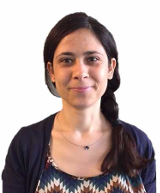
Contacts
![]() Department of Engineering
Department of Engineering
Applied Electronics Section
Roma TRE University
via Vito Volterra, 62 - Corpo B
00146, Roma - Italy
3rd floor - room 3.24
![]() +39 06 5733 7356
+39 06 5733 7356
![]() federica.battisti
federica.battisti![]() uniroma3.it
uniroma3.it
Personal page updated to:
4 Sep 2019
Federica Battisti received the Laurea (Master of Science) in Electronic Engineering from Università degli Studi Roma Tre, Rome, Italy, in July 2006.
From August 2005 to February 2006 she worked as a Research Assistant at Tampere International Center for Signal Processing (TICSP) in Tampere University of Technology (TUT) located in Tampere, Finland. Her work in TICSP resulted in her master thesis titled 'Data hiding techniques in the Fibonacci domain'. During her staying in TICSP, she had been involved in a Human Visual System based image quality assessment project. This work was a part of a bigger research to obtain perceptually reliable objective image quality metrics.
From November 2006 to November 2009, she has been a Ph.D. student in Telecommunication Engineering at Università degli Studi Roma Tre. During this period, from June to July 2008 she was a visiting researcher in the Groupe Multimedia, in the Département Traitement du Signal et des Images of the Ecole Nationale Supérieure des Télécommunications in Paris under the supervision of Prof. B. Pesquet- Popescu.
From May to August 2009 she was a visiting researcher in the Departamento de Teoría de la Señal y las Comunicaciones of the Universidad de Vigo in Spain under the supervision of Prof. P. Comesana Alfaro.
In March 2010 she received the Ph.D. degree with a thesis titled 'Multimedia data hiding based on human perception characteristics'.
From December 2010 she is non-tenured Assistant Professor in the Department of Engineering at Università degli Studi Roma Tre.
She is an IEEE Senior member (2015 - present).
She is an Associate Editor of EURASIP Journal on Image and Video Processing (2017 - present).
She is an Associate Editor of ELSEVIER Signal Processing: Image Communication (2018 - present).
She is an Associate Editor of SPIE Journal of Electronic Imaging (JEI) (2018 - present).
She is member of the Visual Information Processing Special Area Team of EURASIP (2017 - present).
Her main research interests are signal and image processing with focus on subjective quality analysis of visual contents.
Her research activity started with the design and implementation of watermarking techniques for granting the ownership protection of images.
The investigation on this topic led to the study of quality issues related to the watermark invisibility that resulted in the definition of new image quality metrics and in the contribution to the creation of a widely used database for quality metrics benchmark.
The interest on image quality was later extended to video and multi-view imaging.
Currently, the area of interest is in the light-field imaging both for efficient depth map estimation and for quality assessment.
European projects
- RESISTO - Resilience enhancement and risk control platform for communication infrastructure operators funded under the European Union’s Horizon 2020 Research and Innovation Programme under Grant Agreement No786409 (May 2018-May 2021).
- FITOPTIVIS - From the cloud to the edge - smart IntegraTion and OPtimisation Technologies for highly efficient Image and VIdeo processing Systems funded under the ECSEL Joint Undertaking programme (June 2018-June 2019).
- ImmerSAFE - Immersive Visual Technologies for Safety-Critical Applications, H2020 Marie Sklodowska-Curie Innovative Training Network (January 2018-December 2021).
- ATENA - Advanced tools to assess and mitigate the criticality of ICT components and their dependencies over critical infrastuctures funded under the H2020 Programme (May 2016-May 2019).
- ISITEP - Inter system interoperability for TETRA-TETRAPOL networks is an FP7 EU funded iniative that aims at developing procedures, technology and legal agreements to achieve a cost effective global solution for PPDR interoperability. (October 2013-October 2016).
- SANDRA - Seamless Aeronautical Networking through integration of Data links Radios and Antennas, funded under the Seventh Framework Programme (2009-2013).
- MINERVAA - Mid-Term Networking Technologies In-Flight and Rig Validation for Avionic Applications, funded under the Sixth Framework Programme (2007-2010).
National projects
- ViS - Virtualized Analysis of Audio/Video Communication is a national project funded by Filas: Finaziaria laziale di sviluppo (September 2012 - March 2014).
- DAHMS - Distributed Architecture Home Modular Multifunctional Systems, project funded by the Ministero per lo Sviluppo Economico in the field of 'Nuove Tecnologie per il Made in Italy' (New Technologies for the Made in Italy.
- Fin-Box - is a MindSh@re Software Community project, based on the analysis of the interoperability among systems belonging to different application domains (2010-2011).
- GAPACOM - Galileo Advanced Payload Addressing COmmunication Mission, realized by Thales Alenia Space Italia S.p.A and co-funded by MIUR in the framework of the industrial research in the region Lazio, managed by CNIT - Consorzio Nazionale Interuniversitario per le Telecomunicazioni (2006-2009).
- Integrated Multimedia System for the automatic management of telemedicine services DDPACS (Demand Data Picture Archiving and Communication System) - Sistema integrato multimediale di gestione automatica dei servizi di telemedicina DDPACS; 2005-2006.
Journal publications
- A. Neri, M. Carli, and F. Battisti, "A Maximum Likelihood Approach for Depth Field Estimation Based on Epipolar Plane Images", in IEEE Transactions on Image Processing, 28(2), pp. 827-840, February 2019.
- S. Smirnov, F. Battisti, and A. Gotchev,"Layered approach for improving the quality of free-viewpoint depth-image-based rendering images", in Journal of Electronic Imaging, 28(1), 2019.
- P. Paudyal, F. Battisti, and M. Carli,"Reduced Reference Quality Assessment of Light Field Images", in IEEE Transactions on Broadcasting, 65(1), pp. 152-165, February 2019.
- D. Bibbo, M. Carli, S. Conforto, and F. Battisti, "A Sitting Posture Monitoring Instrument to Assess Different Levels of Cognitive Engagement", in Sensors, 19(3), January 2019.
- F. Battisti, M. Carli, P. Le Callet, and P. Paudyal "Toward the assessment of quality of experience for asymmetric encoding in immersive media", in IEEE Transactions on Broadcasting, 64(2), pp. 392-406, June 2018.
- F. Battisti, S. Baldoni, M. Brizzi, and M. Carli, "A feature-based approach for saliency estimation of omni-directional images", in Signal Processing: Image Communication, Elsevier, In press.
- F. Adamsky, M. Aubigny, F. Battisti, M. Carli, F. Cimorelli, T. Cruz, A. Di Giorgio, C. Foglietta, A. Galli, A. Giuseppi, F. Liberati, A. Neri, S. Panzieri, F. Pascucci, J. Proenca, P. Pucci, L. Rosa, and R. Soua, "Integrated Protection of Industrial Control Systems from Cyber-attacks: the ATENA Approach", in International Journal of Critical Infrastructure Protection, Elsevier, In press.
- J. Gutiérrez, P. Paudyal, M. Carli, F. Battisti, and P. Le Callet, "Perceptual analysis and characterization of light field content", in VQEG eLetter, vol. 3, Issue 1, November 2017.
- P. Paudyal, F. Battisti, M. Sjostrom, R. Olsson, and M. Carli, "Towards the Perceptual Quality Evaluation of Compressed Light Field Images", IEEE Transactions on Broadcasting, vol.63, no.3, pp.507-522, September 2017, doi: 10.1109/TBC.2017.2704430
- P. Paudyal, F. Battisti, and M. Carli, "Evaluation of the Effects of Transmission Impairments on Perceived Video Quality by exploiting ReTRiEVED Dataset", Journal of Electronic Imaging, 26(2), 023003 (Mar 08, 2017). doi:10.1117/1.JEI.26.2.023003. [.pdf]
- F. Battisti and P. Le Callet, "Quality Assessment in the context of FTV: challenges, first answers and open issues", IEEE COMSOC MMTC Communications - Frontiers, Vol.11, No.2, March 2016. [.pdf]
- P. Paudyal, F. Battisti, and M. Carli, "Impact of video content and transmission impairments on quality of experience", Multimedia Tools and Applications, Springer, pp 1-25, January 2016. DOI: 10.1007/s11042-015-3214-0. [.pdf]
- N. Ponomarenko, L. Jin, O. Ieremeiev, V. Lukin, K. Egiazarian, J. Astola, B. Vozel, K. Chehdi, M. Carli, F. Battisti, C.-C. J. Kuo, "Image database TID2013: Peculiarities, results and perspectives", Signal Processing: Image Communication, doi:10.1016/j.image.2014.10.009, [.pdf]
- F. Battisti, E. Bosc, M. Carli, P. Le Callet, S. Perugia, "Objective image quality assessment of 3D synthesized views", Signal Processing: Image Communication, doi:10.1016/j.image.2014.10.005, [.pdf]
- F. Battisti, M. Carli, and A. Neri, "No reference quality assessment for MPEG video delivery over IP", EURASIP Journal on Image and Video Processing 2014, 2014:13. [.pdf]
- A. Neri, M. Carli and F. Battisti, "Maximum likelihood estimation of depth field for trinocular images", Electronic Letters, Volume: 49, Issue: 6, 2013. [.pdf]
- G. Boato, M. Carli, F. Battisti, M. Azzoni and K. Egiazarian, "Difference expansion and prediction for high bit-rate reversible data hiding", Journal of Electronic Imaging 21, 033013 (2012), DOI:10.1117/1.JEI.21.3.033013
- F. Battisti, M. Carli, E. Mammi and A. Neri, "A study on the impact of AL-FEC techniques on TV over IP Quality of Experience", EURASIP Journal on Advances in Signal Processing 2011, 2011:86 doi:10.1186/1687-6180-2011-86
- M. Cancellaro, F. Battisti, M. Carli, G. Boato, F.G.B. De Natale, A. Neri, "A commutative digital image watermarking and encryption method in the tree structured Haar transform domain," Signal Processing: Image Communication, Volume 26, Issue 1, January 2011, Pages 1-12
- F. Battisti, G. Boato, M. Carli and A. Neri, “Teaching multimedia data protection through an international on line competition”, IEEE Transactions on Education, vol. 54, no.3, pag.381, August 2011
- F. Battisti, M. Cancellaro, G. Boato, M. Carli, and A. Neri, "Joint Watermarking and Encryption of Color Images in the Fibonacci-Haar Domain," EURASIP Journal on Advances in Signal Processing, vol. 2009, Article ID 938515, 13 pages, 2009. doi:10.1155/2009/938515
- N. Ponomarenko, V. Lukin, A.Zelensky, K.Egiazarian, J. Astola, M. Carli, and F. Battisti, "TID2008 – A database for evaluation of full-reference visual quality assessment metrics", Journal on Achivements in Modern Radio Electronics, no. 10, pp: 30-45, October 2009
International Conferences
- G. Arru, M. Carli, and F. Battisti,"Evaluating the effectiveness of image quality metrics in a light field scenario", Proc. of Electronic Imaging, Image Processing: Algorithms and Systems XVII Interactive Posters Session, 13-17 January, 2019, San Francisco, California.
- F. Battisti, and M. Carli, "Depth-based saliency estimation for omnidirectional images", Proc. of Electronic Imaging, Image Processing: Algorithms and Systems XVII Interactive Posters Session, 13-17 January, 2019, San Francisco, California.
- F. Battisti, and C. Di Stefano, "Virtual Reality meets Degas: an immersive framework for art exploration and learning", Proc. of the 7th European Workshop on Visual Information Processing (EUVIP), 26-28 November, 2018, Tampere, Finland.
- F. Battisti, M. Carli, and P. Le Callet, "A study on the impact of visualization techniques on Light Field perception", Proc. of European Signal Processing Conference (EUSIPCO), pp. 2155-2159, 3-7 September,2018, Rome, Italy.
- D. Bibbo, F. Battisti, S. Conforto, and M. Carli, "A non-intrusive system for seated posture identification", Proc. of IEEE 20th International Conference on e-Health Networking, Applications and Services, Healthcom, 17-20 September,2018, Ostrava, Czech Republic.
- F. Battisti, and G. Nur Yilmaz, "Depth Perception Prediction of 3D Video for Ensuring Advanced Multimedia Services", Proc. of 3DTV Conference, 3-5 June, 2018, Stockholm, Sweden.
- F. Battisti, G. Bernieri, M. Carli, M. Lopardo, and F. Pascucci, "Detecting integrity attacks in IoT-based Cyber Physical Systems: a case study on Hydra testbed", Proc. of the Global Internet of Things Summit (GIoTS), 4-7 June, 2018, Bilbao, Spain.
- R. Copeland, S. Ahvar, N. Crespi, M. Copeland, R. Durand, J.-M. Duquerrois, F. Paganelli, F. Battisti, A. Neri, "Technology Assessment for Mission-Critical Services on Automotive Virtual Edge Communicator (AVEC)", Proc. 21st Conference on Innovation in Clouds, Internet and Networks (ICIN), 20-22 February, 2018, Paris, France
- F. Battisti, M. Carli, E. De Paola, and K. Egiazarian, "Deep p-Fibonacci scattering networks", Proc. Electronic Imaging: Image Processing: Algorithms and Systems XVI, 28 January – 2 February, 2018, Burlingame, California.
- F. Battisti, M. Carli, F. Pascucci, "Securing Cyber Physical Systems from injection attacks by exploiting random sequences", Proc. 13th IEEE International Conference on Wireless and Mobile Computing, Networking and Communications (WiMob), 9-11 October, 2017, Rome, Italy
- P. Paudyal, F. Battisti, and M. Carli, "Effect of Visualization Techniques on Subjective Quality of Light Field Images", Proc. IEEE International Conference on Image Processing (ICIP), 17-20 September, 2017, Beijing, China.
- F. Colangelo, F. Battisti, M. Carli, A. Neri, F. Calabrò "Enhancing audio surveillance with hierarchical recurrent neural networks", Proc. 14th IEEE International Conference on Advanced Video and Signal Based Surveillance (AVSS), 29 August - 1 September, 2017, Lecce, Italy.
- F. Colangelo, F. Battisti, M. Carli, A. Neri, "A Multi-Objective Optimization for Video Orchestration", Proc. 25th European Signal Processing Conference (EUSIPCO), 28 August - 2 September, 2017, Kos, Greece
- O. Johannsen, K. Honauer, B. Goldluecke, A. Alperovich, F. Battisti, Y. Bok, M. Brizzi, M. Carli, et al, "A Taxonomy and Evaluation of Dense Light Field Depth Estimation Algorithms", the IEEE Conference on Computer Vision and Pattern Recognition (CVPR) Workshops, July 2017, Hawaii, USA
- C. Di Stefano and F. Battisti, "Caravaggio in Rome: a QoE-based proposal for a Virtual Gallery", Proc. 3DTV Conference: the true vision - Capture, Transmission and Display of 3D Video, 7-9 June 2017, Copenhagen, Denmark
- P. Paudyal, J. Gutierrez, P. Le Callet, M. Carli, and F. Battisti, "Characterization and selection of light field content for perceptual assessment", Proc. 9th International Conference on Quality of Multimedia Experience, 31 May-02 June 2017, Erfurt, Germany
- A. Neri, F. Battisti, F. Colangelo, and M. Carli, "Unsupervised Video Orchestration Based on Aesthetic Features", Proc. IEEE International Symposium on Circuit and Systems, 28-31 May 2017, Baltimore, USA
- P. Paudyal, Y. Liu, F. Battisti, and M. Carli, "Video Quality of Experience metric for streaming services", Proc. Electronic Imaging, Image Processing: Algorithms and Systems XIV, pp. 1-5(5), 14 February, 2016, San Francisco, USA
- P. Paudyal, R. Olsson, M. Sjostrom, F. Battisti, and M. Carli, "SMART: a Light Field image quality dataset", Proc. 7th International Conference on Multimedia Systems, 10 - 13 May, 2016, Klagenfurt, Austria
- M. Bonomi, M. Barreda-Angeles, F. Battisti, G. Boato, P. Le Callet, and M. Carli, "Towards QoE Estimation of 3D Contents through Non-Invasive Methods", Proc. 3DTV-Conference: The True Vision - Capture, Transmission and Display of 3D Video, 4-6 July 2016, Hamburg, Germany
- D. Sandic-Stankovic, P. Le Callet, F. Battisti , M. Carli, and D. Kukolj, "Free Viewpoint Video Quality Assessment based on Morphological Multiscale Metrics", Proc. 8th International Conference on Quality of Multimedia Experience, 6-8 June, Lisbon, Portugal
- A. Neri, M. Carli, and F. Battisti, "A multi-resolution approach to depth field estimation in dense image arrays", Proc. IEEE International Conference on Image Processing, 27-30 September 2015, Quebec City, Canada
- F. Battisti, M. Carli, Y. Liu, A. Neri, and P. Paudyal, "Distortion-based No-Reference quality metric for video transmission over IP", 12th International Symposium on Signals, Circuits and Systems, 9 - 10 July, 2015, Iasi, Romania
- F. Colangelo, F. Battisti, M. Carli, A. Neri, F. Frosali, and C. Olivieri, "Enhanced Terminal for Secure Mobile Communication over TETRA and TETRAPOL networks", Procs. of IEEE International Conference on Multimedia and Expo, June 29 - July 3, 2015, Torino, Italy
- F. Battisti, M. Carli, A. Stramacci, A. Boev, A. Gotchev, "A perceptual quality metric for high-definition stereoscopic 3D video", Proc. SPIE 9399, Image Processing: Algorithms and Systems XIII, 8-12 February 2015, San Francisco, Califor nia, USA
- M. Leo, F. Battisti, M. Carli, and A. Neri, "Face retrieval in video sequences using Web images database", Proc. SPIE 9399, Image Processing: Algorithms and Systems XIII, 8-12 February 2015, San Francisco, California, USA
- P. Paudyal, F. Battisti, and M. Carli, " A Study on the effects of Quality of Service Parameters on Perceived Video Quality ", Proc. 5th European Workshop on Visual Information Processing, 10-12 December 2014, Paris, France. [.pdf]
- M. Leo, F. Battisti, M. Carli, and A. Neri, "A federated architecture approach for Internet of Things security", Proc. Euro Med Telco Conference, 12-15 November 2014, Naples, Italy
- M. Leo, F. Battisti, M. Carli, and A. Neri, "Video news face retrieval based on Web image datasets", Proc. Euro Med Telco Conference, 12-15 November 2014, Naples, Italy
- F. Battisti, M. Carli, and P. Paudyal, "QoS to QoE Mapping Model for Wired/Wireless Video Communication", Proc. Euro Med Telco Conference, 12-15 November 2014, Naples, Italy
- F. Battisti, M. Carli, and A. Neri, "Subjective Evaluation of 3D Video Enhancement Algorithm", Proc. 22nd European Signal Processing Conference (EUSIPCO), 1-5 September 2014, Lisbon, Portugal. [.pdf]
- F. Battisti, M. Carli, and A. Neri, " Detecting Influence of Digital Image Contrast Modification in Subjective Opinion ", Proc. 6th International Symposium on Communications, Control and Signal Processing (ISCCSP), 21-23 May 2014, Athens, Greece. [.pdf]
- I. Amerini, F. Battisti, R. Caldelli, M. Carli, and A. Costanzo, "Exploiting Perceptual Quality Issues in Countering SIFT-Based Forensic Methods", Proc. IEEE International Conference on Acoustics, Speech and Signal Processing (ICASSP), 4-9 May 2014, Firenze, Italy. [.pdf]
- F. Battisti, M. Carli, M. Leo, and A. Neri, "Probabilistic Person Identification in TV News Programs using Image Web Database", Proc. SPIE International Conference on Electronic Imaging 2014: Algorithms and Systems XII, 2-6 February 2014, San Francisco, California, USA. [.pdf]
- N. Ponomarenko, O. Ieremeiev, V. Lukin, L. Jin, K. Egiazarian, J. Astola, B. Vozel, K. Chehdi, M. Carli, F. Battisti, and C.-C. J. Kuo, "A new color Image Database TID 2013: innovations and results", Proc. Advanced Concepts for Intelligent Vision Systems (ACIVS), 28-31 October 2013, Poznan, Poland. [.pdf]
- N. Ponomarenko, O. Ieremeiev, V. Lukin, K. Egiazarian, L. Jin, J. Astola, B. Vozel, K. Chehdi, M. Carli, F. Battisti, and C.-C. J. Kuo, "Color Image Database TID 2013: peculiarities and preliminary results", Proc. of the European Workshop on Visual Information Processing (EUVIP), Paris, France, June 10-12, 2013. [.pdf]
- E. Bosc, F. Battisti, M. Carli, and P. Le Callet, "A wavelet-based image quality metric for the assessment of 3D synthesized views", Proc. SPIE International Conference on Electronic Imaging 2013: Stereoscopic Displays and Applications XXIV, 4-6 February 2013, San Francisco, California, USA. [.bib][.pdf]
- F. Battisti, M. Carli, G. Farinella, and A. Neri, "Target Re-Identication in Low Quality Camera Networks", Proc. SPIE International Conference on Electronic Imaging 2013, Image Processing: Algorithms and Systems XI, 4-6 February 2013, San Francisco, California, USA. [.bib][.pdf]
- B. Parrein, N. Normand, M. Ghareeb, G. D'Ippolito, and F. Battisti, "Finite Radon coding for content delivery over hybrid client-server and P2P architecture", Proc. 5th International Symposium on Communications, Control and Signal Processing (ISCCSP), 2-4 May 2012, Rome, Italy. [.pdf]
- F. Battisti, M. Carli, and A. Neri, "No-Reference Quality Metric for Color Video Communication", Proc. 2012 International Workshop on Video Processing and Quality Metrics (VPQM 2012), Jan. 2012, Phoenix, Arizona. [.bib][.pdf]
- F. Battisti, M. Carli, and A. Neri, "Image forgery detection by means of no-reference quality metrics,", Proc. SPIE International Conference on Electronic Imaging 2012, Media Watermarking, Security, and Forensics 2012, 22 - 26 January 2012, San Francisco, California, USA. [.bib][.pdf]
- F. Battisti, M. Carli, F.G.B. De Natale, and A. Neri, "Ear recognition based on Edge Potential Function", Proc. SPIE International Conference on Electronic Imaging 2012, Image Processing: Algorithms and Systems X, 22 - 26 January 2012, San Francisco, California, USA. [.bib][.pdf]
- F. Battisti, M. Carli, G. Boato, and A. Neri, "Catch the Mark: teaching data hiding by gaming", Proc. EUROCON 2011, 27-29 April 2011, Lisbon, Portugal. [.bib]
- F. Battisti, M. Carli, and A. Neri, "Secure annotation for medical images based on reversible watermarking in the Integer Fibonacci-Haar transform domain", Proc. SPIE International Conference on Electronic Imaging 2011, Image Processing: Algorithms and Systems IX, 23 - 27 January 2011, San Francisco, California, USA. [.bib]
- L. Azzari, F. Battisti, A. Gotchev, M. Carli, and K. Egiazarian, "A Modified Non-local Mean Inpainting Technique for Occlusion Filling in Depth-Image Based Rendering", Proc. SPIE International Conference on Electronic Imaging 2011, Stereoscopic Displays and Applications XXII, 23 - 27 January 2011, San Francisco, California, USA. [.bib]
- L. Azzari, F. Battisti, and A. Gotchev, "Comparative analysis of occlusion-filling techniques in depth image-based rendering for 3D videos", Proc. ACM Multimedia 2010 - MoViD: ACM Workshop on Mobile Video Delivery, 25- 29 October 2010, Florence, Italy. [.bib]
- F. Battisti, M. Carli, and A. Neri, "Video Error Concealment Based on Data Hiding in the 3D Wavelet Domain", Proc. Second European Workshop on Visual Information Processing (EUVIP 2010), 5-7 July 2010, Paris, France. [.bib]
- F. Battisti, M. Carli, and A. Neri, “Reversible data hiding in the Fibonacci-Haar transform domain", Proc. SPIE International Conference on Electronic Imaging 2010, Image Processing: Algorithms and Systems VIII, 17-21 January 2010, San Jose, California, USA. [.bib]
- A. Neri, P. Campisi, E. Maiorana, and F. Battisti, "3D Video Enhancement Based on Human Visual System Characteristics" Proc. International Workshop on Video Processing and Quality Metrics (VPQM 2010), Jan. 2010, Phoenix, Arizona.[.bib][.pdf]
- F. Battisti, M. Carli, and A. Neri, “QIM-DM Watermarking Optimization Based on Inter-frequency Contrast Masking in the DCT Domain”, Proc. First IEEE Workshop on Information Forensics and Security, 6-9 December 2009, London, United Kingdom. [.bib]
- E. Mammi, F. Battisti, M. Carli, A. Neri, and K. Egiazarian, ”Substitutive Steganography in the Generalized Fibonacci Domain”, Proc. SPIE International Conference on Electronic Imaging 2009, Image Processing: Algorithms and Systems VII, 18-22 January 2009, San Jose, California, USA. [.bib]
- A. Neri, P. Campisi, and F. Battisti, ”Fuzzy Edge Enhancement in the Complex Wavelet Domain”, Proc.2009 International Workshop on Video Processing and Quality Metrics (VPQM 2009), Jan. 2009, Phoenix, Arizona. [.bib] [.pdf]
- N. Ponomarenko, F. Battisti, K. Egiazarian, J. Astola, and V.Lukin, ”Metrics performance comparison for color image database”, Proc.International Workshop on Video Processing and Quality Metrics (VPQM 2009), Jan. 2009, Phoenix, Arizona. [.bib][.pdf]
- N. Ponomarenko, V. Lukin, K. Egiazarian, J. Astola, M. Carli, and F. Battisti, ”Color Image Database for Evaluation of Image Quality Metrics”, International Workshop on Multimedia Signal Processing, Cairns (Australia), October 2008. [.bib]
- E. Mammi, F. Battisti, M. Carli, A. Neri, and K. Egiazarian, A spatial data hiding scheme based on generalized Fibonacci sequences, Proc. SPIE Defense and Security 2008, Mobile Multimedia/Image Processing, Security, and Applications 2008, 16 - 20 March 2008 Orlando, Florida USA. [.bib]
- F. Battisti, M. Cancellaro, M. Carli, G. Boato, and A. Neri, Watermarking and encryption of color images in the Fibonacci domain, Proc. SPIE International Conference on Electronic Imaging 2008, Image Processing: Algorithms and Systems VII, 27-31 January 2008, San Jose, California, USA. [.bib]
- M. Cancellaro, F. Battisti, M. Carli, G. Boato, and F. G. B. De Natale and A. Neri, A Joint Digital Watermarking and Encryption Method Proc. SPIE International Conference on Electronic Imaging 2008, Security, Forensics, Steganography, and Watermarking of Multimedia Contents X, 27-31 January 2008, San Jose, California, USA.[.bib]
- S. Maranò, F. Battisti, A. Vaccari, G. Boato, and M. Carli, Perceptual data hiding exploiting between-coeffcient contrast masking, Proc. SPIE International Conference on Electronic Imaging 2008, Security, Forensics, Steganography, and Watermarking of Multimedia Contents X, 27-31 January 2008, San Jose, California, USA. [.bib]
- F. Battisti, M. Carli, A. Neri, and K. Egiazarian - "Image watermarking in the Fibonacci-Haar transform domain" - Proc. International Workshop on Nonlinear Signal and Image Processing September 10-12, 2007 Bucharest, Romania. [.bib]
- A. Neri, F. Battisti, M. Carli, M.Salatino, M. Goffredo, and T. DAlessio Perceptually Lossless Ultrasound Video Coding for Telemedicine Applications - Proc.2007 International Workshop on Video Processing and Quality Metrics (VPQM 2007), Jan. 2007, Phoenix, Arizona. [.bib]
- F. Battisti, K. Egiazarian, M. Carli, and A. Neri, "Data hiding based on Fibonacci-Haar transform" - Proc. SPIE Defense and Security 2007, Mobile Multimedia/Image Processing For Military And Security Applications 2007, 9 - 13 April 2007 Orlando, Florida USA . [.bib]
- F. Battisti, M. Carli, K. Egiazarian, and J. Astola, 'Attack resilient watermarking in the Haar wavelet domain' - Proc. 2006 International Workshop on Spectral Methods and Multirate Signal Processing (SMMSP 2006), Sept. 2006, Firenze, Italy. [.bib]
- D. De Luca Picione, F. Battisti, K. Egiazarian, M. Carli, and J. Astola, 'A Fibonacci LSB data hiding tecnique' - Proc. 14th European Signal Processing Conference (EUSIPCO 2006), Sept. 2006, Firenze, Italy. [.bib]
- K. Egiazarian, J. Astola, N. Ponomarenko, V. Lukin, F. Battisti, and M.Carli, New full-reference quality metrics based on HVS Proc.2006 International Workshop on Video Processing and Quality Metrics (VPQM 2006), Jan. 2006, Phoenix, Arizona. [.bib]
- M. Carli, F. Battisti, K. Egiazarian, and J. Astola, Data hiding in Fibonacci domain, invited talk at the Workshop on Recent Trends in Signal Processing, New Delhi, December 14, 2006. [.bib]
- F. Battisti, M. Carli, A. Neri, and K. Egiaziarian, A Generalized Fibonacci LSB Data Hiding Technique, IEEE International Conference on Computers and Devices 2006 (CODEC 06), December 18 - 20, 2006. KOLKATA, INDIA. [.bib][.pdf]
Books
- M. Barreda-Ángeles, F. Battisti, et al., "Quality of Experience and Quality of Service Metrics for 3D Content " In: Assunção P., Gotchev A. (eds) 3D Visual Content Creation, Coding and Delivery. Signals and Communication Technology. Springer, Cham. ISBN 978-3-319-77841-9.
- K. Fliegel, F. Battisti, et al., "3D Visual Content Datasets " In: Assunção P., Gotchev A. (eds) 3D Visual Content Creation, Coding and Delivery. Signals and Communication Technology. Springer, Cham. ISBN 978-3-319-77841-9.
a.a. 2017-2018
- Elementi di crittografia - Cryptography basics (6 CFU)
Il corso consente di acquisire le nozioni e i concetti che sono alla base della Crittografia moderna. Fornisce inoltre gli strumenti concettuali e teorici che consentono di comprendere le tecniche avanzate attualmente utilizzate per proteggere la trasmissione e la memorizzazione di informazioni in presenza di agenti ostili o di rumore presente nel canale. L'obiettivo principale è di permettere agli studenti di capire il funzionamento di un crittosistema o di un protocollo crittografico. Questo porterà alla capacità di scegliere gli strumenti crittografici adatti per proteggere i dati durante la loro trasmissione e/o memorizzazione. - Laboratorio di multimedialità - Multimedia laboratory (6 CFU)
Il corso ha l'obiettivo di illustrare le metodologie più avanzate per la caratterizzazione ed il trattamento dei segnali multimediali. In particolare si approfondirà lo studio di segnali video e di immagini sia nel caso bidimensionale che in quello tridimensionale. Il corso sarà suddiviso in due parti: la prima per fornire agli studenti le conoscenze teoriche di base sugli strumenti per l’elaborazione dei segnali multimediali e sulla programmazione in Matlab, la seconda consiste in esperienze pratiche, di gruppo e individuali, sia su calcolatori che tramite dispositivi messi a disposizione degli studenti (Kinect, sistemi di restituzione 3D, webcam stereo). L’utilizzo in laboratorio di sistemi di acquisizione, elaborazione e restituzione, consentirà allo studente di ottenere le conoscenze di base per il progetto di sistemi di comunicazione multimediali efficaci in termini di qualità, del costo e della sicurezza. Il corso prevede seminari monografici dedicati ad approfondire esempi di applicazione dei segnali multimediali come e-learning, cinema, IP-tv e comunicazioni mobili.
Anna Maria Vegni - Assistant Professor

Contacts
![]() Department of Industrial, Electronic and Mechanical Engineering
Department of Industrial, Electronic and Mechanical Engineering
Applied Electronics Section
Roma TRE University
via Vito Volterra, 62 - Corpo B
00146, Roma - Italy
2nd floor - room 2.23
![]() +39 06 5733 7357
+39 06 5733 7357
![]() +39 333 6570 348
+39 333 6570 348
![]() +39 06 5733 7026
+39 06 5733 7026
![]() annamaria.vegni
annamaria.vegni![]() uniroma3.it
uniroma3.it
![]() annamaria.vegni
annamaria.vegni
Personal page updated to:
23 Dec 2024
Anna Maria Vegni is Associate Professor in Telecommunications at the Department of Industrial, Electronic and Mechanical Engineering (DIIEM) of Roma Tre University, since March 2023. She received the Laurea degree (cum laude) in Electronics Engineering and the Ph.D. degree in Biomedical Engineering, Electromagnetics, and Telecommunications from Roma Tre University, Rome, Italy, in 2006 and 2010, respectively. From 2010 to 2020, she was an Assistant Professor in Telecommunications at the Department of Engineering of Roma Tre University. From March 2020 to September 2021 she hold a Tenure-Track Assistant Professorship in Telecommunications at the Department of Engineering, Roma Tre University, and then was affiliated to DIIEM till today.
In 2009, she was a Visiting Researcher with the Prof. Thomas D.C. Little, at the Department of Electrical and Computer Engineering, Boston University, Boston, MA, USA. Her research activity focused on vehicular networking and optical wireless communications (i.e., Visible Light Communications).
Since 2010, she has been in charge of the Telecommunications Networks Laboratory course, Roma Tre University. She is the author of more than 100 publications in journals, conferences, workshops, and book chapters. She co-edited the book Cognitive Vehicular Networks (CRC Taylor & Francis Group, 2016), and the book Vehicular Social Networks (CRC Taylor & Francis Group, 2017).
Her research interests include social networking, optical and RF wireless communications. She is involved in several European and National projects and organizing committees of international conferences. She is a member of ACM and IEEE, and a member of GTTI (Gruppo Telecomunicazioni e Tecnologie dell'Informazione).
Since September 2016, she is an IEEE Senior Member. She is also Award Co-chair of 2020-2021 N2WOMEN board, a discipline-specific community of researchers in the fields of networking and communications, supported by several major professional associations such as ACM SIGCOMM, ACM SIGMOBILE and IEEE ComSoc.
In March 2018, she got the Italian Habilitation (Abilitazione Scientifica Nazionale) for Associate Professorship in Telecommunication Engineering (SC: 09/F2; SSD: ING-INF/03).
In June 2021, she got the Italian Habilitation (Abilitazione Scientifica Nazionale) for Full Professorship in Telecommunication Engineering (SC: 09/F2; SSD: ING-INF/03).
Research interests:
- Wireless and vehicular networks
- Optical wireless communications
Awards and recognitions:
- N2Women: Rising Stars in Networking and Communications, 2019.
- Virtual Special Issue on Women in Computer Science, 2018.
- Telespazio Innovation Award 2010 for the proposal "Communication using LockSat for IP Satellite Operations (LOCKSAT)," by F. Di Stadio, A. Neri, D. Valletta, R. Giuliano, and A.M. Vegni.
Visiting Researchers at COMLAB:
- Milica Petkovic, University of Novi Sad, Serbia, (September 2024).
- Chaker Abdelaziz Kerrachez, Université Amar Telidji de Laghouat, Algeria, (April 2023).
- Carlos Borrego Iglesias, Universitat Autònoma de Barcelona, Spain, (September 2019).
- Petros Nicopolitidis, Aristotle University of Thessaloniki, Greece, (September 2017).
- Marwan Hammouda, University of Hannover, Germany, (April-May 2016).
Call for papers:
- CSNDSP 2024, 14th International Symposium on Communication Systems, Networks and Digital Signal Processing, 17-19 July 2024 - Rome, Italy. Paper submission: March 1, 2024.
- IEEE WiMob 2024, 20th International Conference on Wireless and Mobile Computing, Networking and Communications, 9-11 October 2024, Paris, France. Paper submission: May 15, 2024.
News and Events
- 2nd Management Committee (MC) Meeting of the COST Action CA19111 "European NEtWork on Future Generation Optical Wireless CommUnication TechnologieS (NEWFOCUS)", 26-27 April 2021, online event.
- Anna Maria Vegni will serve as Co-chair of Mobile & Wireless Networks Symposium at IEEE ICC 2022, 16-20 May 2022, Seoul, South Korea.
- WIS3 International Day of Women and Girls in Science, February 11, 2021, online event Registration deadline: January 31, 2020.
Editorial Board - Associate Editor
- Editor for IEEE Transactions on Communications, since July 2022.
- Editor for IEEE Communications Magazine, since September 2019.
- Editor for IEEE/KICS Journal of Communications and Networks, since May 2020.
- Editor for AD HOC NETWORKS Elsevier, since July 2016.
- Editor for NANOCOMNETS (Nano Communication Networks) Elsevier, February 2016 - June 2023.
- Editor for Frontiers in Communications and Networks Journal, NETWORKS section, since May 2020.
- Editor for JNCA (Journal of Networks and Computer Applications) Elsevier, since July 2015.
- Editor for Transaction on Emerging Telecommunications Technologies Wiley, since March 2018.
- Editor for Sensors, since November 2019.
- Editor for IET Smart Cities Journal, since December 2018.
- Editor for International Journal of Multimedia Intelligence and Security, since April 2018.
- Co-Editor for the TCSN (Technical Committee on Social Networks) Newsletter, 2019.
Editorial Board - Guest Editor
- Lead Guest Editor for ITU Journal-Feature and Evolving Technologies, Special Issue on Towards vehicular networks in the 6G era, to be published in 2022.
- Guest Editor for Springer Multimedia Tools and Applications, Special Issue on Information Technology for Social Good, to be published in 2021.
- Lead Editor for the IEEE Communications Magazine journal Feature Topic on Networking Technologies to Combat the COVID-19 Pandemic, 2021.
- Guest Editor for the Elsevier Vehicular CommunicationsSpecial Issue on Revolutionary Paradigms for Smart Connected Vehicles in the 6G Era”, 2021.
- Guest Editor for the Elsevier Computer Networks journal Special Issue on Recent Advances in Connected and Autonomous Unmanned Aerial/Ground Vehicles, 2021.
- Guest Editor for the Elsevier Pervasive and Mobile Computing journal Special Issue on Mobile and Social Sensing, 2020.
- Guest Editor for the Elsevier Cognitive Systems Research journal Special Issue on Cognition in Software Defined Sensor Networks for the Next Generation Cellular Services, 2020.
- Guest Editor for the IEEE Access journal Special Section on Protocols for Nanocommunication Networks, 2019.
- Guest Editor for the IEEE Internet of Things journal Special Issue on Recent Advances on Social Internet of Vehicles, 2018.
- Guest Editor for the Ad Hoc Networks (Elsevier) Journal Special Issue on Internet of Things security and privacy: design methods, detection, prevention and countermeasures, 2014.
Conference Chair
- Industry co-chair for IEEE Globecom 2025, Taipei, Taiwan.
- Chair of Selected Area in Communication “Social Networks”, IEEE Globecom 2024, Cape Town, South Africa, December 8-12, 2024.
- Publicity Co-chair of ACM Mobihoc 2024 - Athens, Greece.
- Executive Co-chair of the IEEE WiMob 2024, 9-11 October 2024, Paris, France.
- Track co-chair for Digital Twins at WF-IoT 2024.
- Local Organizer of CSNDSP 2024, Rome (Italy), July 2024.
- Publicity Co-chair of IEEE MASS 2024, Seoul, Sept. 23-25, 2024.
- Steering Committee Member of the 4th South American Conference on Visible Light Communications, 8-10 November 2023, Santiago, Chile.
- Executive Co-chair and Travel Grant Chair of the IEEE WiMob 2023, Montreal, Canada, 2023.
- Co-chair of The First Workshop on Underwater Communication, Access and Networking (UCAN) at IEEE ICC 2023, Rome, Italy.
- Chair of the session "Federated Learning and Edge Computing," at the conference IEEE MSN 2022, December 2022, (virtual conference).
- Workshop co-chair of the IEEE Intl. Conf. on High Performance Switching and Routing (HPSR 2023), 5–7 June 2023, Albuquerque, NM, USA.
- Publicity co-chair of ACM MobiHoc 2023, Washington D.C. (USA), October 2023.
- N2Women co-chair of the 24th IEEE Intl. Symp. on a World of Wireless, Mobile and Multimedia Networks (WoWMoM 2023).
- Co-chair of Mobile & Wireless Networks Symposium at IEEE ICC 2022.
- Member of the Organizing Committee of the 5th International Workshop on Optical Wireless Communications (IWOW), in conjunction with the 17th International Symposium on Wireless Communication Systems, 6-9 September 2021, Berlin, Germany.
- Executive chair and Workshop co-chair of IEEE WiMob 2021, 11-13 October 2021, Bologna, Italy.
- TPC and Local arrangement chair of ACM International Conference on Information Technology for Social Good (GoodIT 2021), 9-11 September 2021, Rome, Italy.
- Publicity co-chair of the 12th Wireless Days Conference (WD 2021), 30 June - 02 July, 2021, Paris, France.
- Co-chair of Mobile & Wireless Networks Symposium at IEEE GLOBECOM 2020, 7-11 December 2020, Xinyi District, Taipei City Taiwan.
- Social media Co-chair of IEEE GLOBECOM 2020, 7-11 December 2020, Xinyi District, Taipei City Taiwan.
- Executive co-chair of the 16th WiMob Conference (IEEE International Conference on Wireless and Mobile Computing, Networking and Communications), October 12-14, 2020, Thessaloniki, Greece.
- Workshop co-chair of the 9th Networking Networking Women (N2WOMEN) Workshop, co-located with the 16th International Conference on Wireless and Mobile Computing, Networking and Communications, 12 October 2020, Thessaloniki, Greece.
- Special session co-chair on Simulation of Urban Traffic Management and ITS at IEEE/ACM DS-RT 2020, the 24th International Symposium on Distributed Simulation and Real Time Applications, September 14-16, 2020, Prague, Czech Republic.
- Organizer of the 1st Workshop on Pervasive Systems in the IoT era (PERSIST-IoT) in conjunction with ACM MobiHoc 2019, Catania, Italy, July 2-5, 2019.
- Workshop chair of the Twelfth International Workshop on Selected Topics in Wireless and Mobile computing (STWiMob 2019) in conjunction with IEEE WiMob 2019, Barcelona, Spain, 21-23 October 2019.
- Special session co-chair on Simulation of Urban Traffic Management and ITS at IEEE/ACM DS-RT 2019, the 23rd International Symposium on Distributed Simulation and Real Time Applications, October 7-9, 2019, Cosenza, Italy.
- Local Arrangements Co-Chairs at ICHMS 2020 conference, the 1st IEEE International Conference on Human-Machine Systems, April 6-8, 2020, Rome, Italy.
- Publicity Co-chair and Travel Grant Chair of the 15th International Conference on Wireless and Mobile Computing, Networking and Communications (IEEE WiMob), 21-23 October 2019, Barcelona, Spain.
- Local Organization Co-chair of the 15th International Conference on Wireless and Mobile Computing, Networking and Communications (IEEE WiMob), 21-23 October 2019, Barcelona, Spain.
- Conference Co-chair of the 4th IEEE International Conference on Computing Communication and Security (ICCCS 2019), 10-12 October 2019, Rome, Italy.
- Chair of the Keynote: Back to the Future: Hardware-specialized Cloud Networking, Giuseppe Bianchi (University of Rome Tor Vergata, Italy), at the 4th IEEE International Conference on Computing Communication and Security (ICCCS 2019), 10-12 October 2019, Rome, Italy.
- Chair of the Technical Session: Security and Privacy, at the 4th IEEE International Conference on Computing Communication and Security (ICCCS 2019), 10-12 October 2019, Rome, Italy.
- Technical Program Co-chair of the 6th ACM/IEEE Intl. Conf. on Nanoscale Computing and Communication (ACM/IEEE NANOCOM), 23-25 September 2019, Dublin, Ireland.
- Track Co-chair of Social Networks and Computing (SNC) track at the 28th Intl. Conf. on Computer Communications and Networks (ICCCN 2019), July 29 - August 1, 2019, Valencia, Spain.
- Publicity Co-chair of IEEE International Conference on Sensing, Communication and Networking (IEEE SECON), 10-13 June 2019, Boston, Massachusetts, USA.
- Organizer of the 5th Workshop on Optical Wireless Communications (OWC), in conjunction with IEEE International Conference on Communications (ICC), 20-24 May 2019, Shanghai, China.
- Organizer of the Special Session on Mobile Social Networks at IEEE PIMRC 2018, September 9-12, 2018, Bologna, Italy.
- TPC Co-Chair of the 4th Workshop on Experiences with the Design and Implementation of Smart Objects (SMARTOBJECTS) at ACM MobiHoc 2018, June 26-29, 2018, Los Angeles, California, USA.
- Workshop Co-Chair of the 14th Intl. Conf. on Wireless and Mobile Computing, Networking and Communications (WiMob 2018), October 15-17, 2018, Limassol, Cyprus.
- Finance Co-Chair of the 5th ACM Intl. Conf. on Nanoscale Computing and Communication, Reykjavik, Iceland, September 5-7, 2018.
- Finance Co-Chair of BalkanCom: Second Intl. Balkan Conference on Communications and Networking, Podgorica, Montenegro, June 4-8, 2018.
- Organizer of the Fourth Workshop on Optical Wireless Communications (OWC), in conjunction with IEEE International Conference on Communications (ICC), 20-24 May 2018, Kansas City, MO, USA.
- Local Chair of WiMob 2017: The 13th IEEE International Conference on Wireless and Mobile Computing, Networking and Communications, Oct 9-11, 2017, Rome, Italy.
- Finance Chair of BalkanCom: Int. Balkan Conference on Communications and Networking, Tirana, Albania, June 1-3, 2017.
- Finance Chair of the 4th ACM International Conference on Nanoscale Computing and Communication, Washington D.C., USA, September 2017.
- Organizer of the Third Workshop on Optical Wireless Communications (OWC), in conjunction with IEEE International Conference on Communications (ICC), 21-25 May, 2017 Paris, France.
- Financial Co-chair of the 3rd ACM International Conference on Nanoscale Computing and Communication, New York, New York, USA, September 28-30, 2016.
- Organizer of the Second Workshop on Optical Wireless Communications (OWC), in conjunction with IEEE International Conference on Communications (ICC), 23-27 May, 2016 Kuala Lumpur, Malaysia.
- TPC Co-Chair for the International Conference on Selected Topics in Mobile & Wireless Networking, MoWNet 2016, 11-13 April, 2016, Cairo, Egypt.
- General Chair for the International Conference on Civic Technologies for Smart Cities, CivicTech 2015, collocated with Smart City 360 Summit, 13 October 2015, Bratislava, Slovakia.
- Chair of the Emerging Technologies Track: Light-Based Communications and Positioning - VTC 2015, September 2015, Boston MA.
- Organizer of the First Workshop on Visible Light Communications and Networking (VLCN), in conjunction with IEEE International Conference on Communications (ICC), 8-12 June, 2015 London, Great Britain.
- Chair of the Session TOF TDOA" at the IEEE Intl. Conf. on Indoor Positioning and Indoor Navigation (IPIN 2010), September 15-17, 2010, Zurich, Switzerland.
- Member of the organizing committee of the 2nd Edition of the IEEE SPS Italy Chapter Summer School on Signal Processing (SPSS 2014), July 7-11, 2014, Frascati, Italy.
- Publicity co-chair of the Intl. Conf. on Selected Topics in Mobile & Wireless Networking (iCOST 2012), July 2-4, 2012, Avignon, France.
- Publicity co-chair of the 3rd Intl. Conf. on Selected Topics in Mobile & Wireless Networking (MoWNet'2013), August 19-21, 2013, Montreal, Canada.
Technical program committees
- TPC member of IEEE INFOCOM 2024.
- TPC member of IEEE SECON 2021.
- TPC member of IEEE INFOCOM 2020.
- TPC member of Social Networks and Computing (SNC) track at the 29th IEEE Intl. Conf. on Computer Communications and Networks (ICCCN 2020), August 3 - August 6, 2020, Honolulu, Hawaii, USA.
- TPC member of IEEE MedComNet 2020, 17-19 June 2020, Arona, Italy.
- TPC member of IEEE SECON 2019.
- TPC member of IEEE GLOBECOM 2019 - Selected Areas in Communications: Internet of Things.
- TPC member of Med-Hoc-Net 2018, the 17th Annual Mediterranean Ad Hoc Networking Workshop, June 20-22, 2018.
- TPC member of ACM NANOCOM 2017, the 4th ACM International Conference on Nanoscale Computing and Communication, Washinghton, USA, September 28-30, 2017.
- TPC member of ACM NANOCOM 2016, the 3rd ACM International Conference on Nanoscale Computing and Communication, New York, New York, USA, September 28-30, 2016.
- TPC member of CCNC 2016 - Vehicular Communications and Applications in Water, Land and Sky track, in conjunction with the 13th Annual IEEE Consumer Communications and Networking Conference.
- TPC member of 5th colloquium on Optical Wireless Communications, to be held in conjunction with the 10th IEEE IET International Symposium on Communication Systems, Networks and DSP, Prague, Czech Republic, 20-22 July 2016.
- TPC member of the First IEEE International Smart Cities Conference (ISC2-2015), Guadalajara, Mexico, October 25-28, 2015.
- TPC member of 3rd International workshop on Internet of Things - Ideas and Perspectives (IoTIP-15), June 12th, 2015 - Fortaleza, Brazil, in conjunction with IEEE DCOSS 2015.
- TPC member of Smart Spaces and IoT Networking track, in conjunction with IEEE Consumer Communications & Networking Conference (CCNC), 9-12 January, 2015 Las Vegas, USA.
- TPC member of IEEE TENSYMP conference (theme: Internet of Things), May 13-15. 2015, Ahmedabad, India.
- TPC member of SWANSITY workshop (SMART WIRELESS ACCESS NETWORKS FOR SMART CITY), IEEE Intl. Conf. on Sensing, Communication, and Networking (SECON 2015), 22-25 June 2015, Seattle, USA.
- TPC member of Self-organizing Wireless Access Networks for Smart City Workshop 2014 (SWANSITY) in conjunction with IEEE SECON 2014.
- TPC member of IEEE Workshop on Wireless Ad hoc and Sensor Networks (WWASN 2011, WWASN 2012, WWASN 2013, and WWASN 2014).
- TPC member of 2nd Intl. Conf. on Connected Vehicles & Expo (ICCVE 2013)
- TPC member of Intl. Workshop on Internet of Things - Ideas and Perspectives (IoTIP-13), in conjunction with IEEE DCOSS 2013
- TPC member of the 4th Intl. Workshop on Recent Advances in Broadband Access Networks (RABAN) in conjunction with the 13th Intl. Conf. on Intelligent Transportation Systems Telecommunications (ITST)
- TPC member of International Conference on Indoor Positioning and Indoor Navigation (2010-2014).
European projects
- COST Action CA19111 NEWFOCUS - European Network on Future Generation Optical Wireless Communication Technologies (OC-2019-1-23857). The COST Action NEWFOCUS aims to establish optical wireless communications (OWC) as an efficient technology that can satisfy the demanding requirements of backhaul and access network levels in beyond 5G networks. NEWFOCUS will develop (i) OWC-based solutions capable of delivering ubiquitous, ultra-high-speed, low-power consumption, highly secure, and low-cost wireless access in diverse application scenarios, and (ii) flexible and efficient backhaul/fronthaul OWC links with low latency and compatible with access traffic growth. Anna Maria Vegni is a country representative and a member of the steering committee as Science Communication Manager for COST Action CA 19111 - NEWFOCUS. September 2020-September 2024.
- AB4Rail - (Alternative Bearers for railway), funded under the European Union’s Horizon 2020 Shift2Rail (H2020-S2RJU-OC-2020). Roma Tre University participates to the project as In-Kind party, for what concerns WP2 activities related to the analysis of Alternative Bearers for ACS. Total budget 350k€. January 2021 - January 2023.
- RESISTO - Resilience enhancement and risk control platform for communication infrastructure operators funded under the European Union’s Horizon 2020 Research and Innovation Programme under Grant Agreement No786409. May 2018-May 2021
- ISITEP - Inter system interoperability for TETRA-TETRAPOL networks is an FP7 EU funded initiative that aims at developing procedures, technology and legal agreements to achieve a cost effective global solution for Public Protection & Disaster Relief (PPDR) networks interoperability. October 2013 - October 2016.
- D-BOX, Demining tool-BOX for humanitarian clearing of large scale area from anti-personal landmines and cluster munitions" - FP 7 security 2011. D-BOX intends to address the issue of the clearance of anti-personnel land mines and cluster munitions through innovative easy-to-use, cost-effective solutions, contained in a comprehensive toolbox.
- SAFEDEM (Space Assets For Enhanced DEMining), applied research project ESA AO 1-6392, January 2011 - January 2014.
- 3inSat, Train Integrated Safety Satellite System - ESA IAP project, aiming at developing and validating a new satellite-based platform to be integrated into a SIL4 Train Control and Management System.
- Free-Space-Optical Visible-Spectrum Communications (Visible Light Communications) scientific-technical cooperation with Boston University. This project investigates the adaptation of novel LED-based materials and devices for the support of visible-light-based communication and communications networking. More details on the larger scope of this effort are found at NSF Smart Lighting Engineering Research Center
National projects
- LAGO-ON - opticaL wireless undewAter positioninG for marine mOnitOriNg (PRIN 2022). Project team: Roma Tre (Anna Maria Vegni as Principal Investigator), Istituto di Ingegneria del Mare Consiglio Nazionale delle Ricerche (CNR), and University of Rome Sapienza (Dept. of Environmental Biology and ecology). September 2023
- EDESMART - Efficientamento e diagnostica energetica negli Smart Building: progettazione, monitoraggio integrato e analisi comportamentale. September 2018 - September 2020
- DAHMS - Distributed Architecture Home Modular Multifunctional Systems, project funded by the Ministero per lo Sviluppo Economico in the field of 'Nuove Tecnologie per il Made in Italy' (New Technologies for the Made in Italy.
- GAPACOM (Galileo Advanced Payloads network Addressing COmmunication Mission) applied research project, cofounded by MIUR, and under realization by Thales Alenia Space. Design of a communication payload for the European Navigation system GALILEO, from September 2012 to May 2013. Lectures on Satellite Navigation and Mobility Management.
- GEOSENSE, applied research project. Design of an integrated platform with a network of sensors installed on board of vehicles for the seismic observation, dedicated to the elaboration of maps of ground motions for events of medium intensity earthquakes, June 2011 - December 2011.
- TiLab Seamless (mobile-home, mobile-office) scientific-technical cooperation between Telecom Italia and the three Roman universities (Sapienza, Tor Vergata, Roma Tre), September 2006 - September 2009.
Journal Papers
- Y. Ata, X. Yi, Y. Li, X. Tao, and A.M. Vegni, "A Unified Channel Model for IRS-Aided Underwater OWC with Combined Attenuation Losses," accepted in IEEE Journal on Selected Areas in Communications Special Issue on "Next-Generation Optical Communications and Networking", May 2025
- A.M. Vegni, Y. Ata, and M.S. Alouini, "Enhancement of Handover Management through Reconfigurable Intelligent Surfaces in a 3D Ground-Aerial-Space Network Scenario," in IEEE Transactions on Wireless Communications, vol. 23, no. 12, pp. 18637-18652, Dec. 2024, doi: 10.1109/TWC.2024.3471393. [pdf]
- Y. Ata, A.M. Vegni, and M.S. Alouini, "RIS-Embedded UAVs Communications for Multi-Hop Fully-FSO Backhaul Links in 6G Networks," in IEEE Transactions on Vehicular Technology, vol. 73, no. 10, pp. 14143-14158, Oct. 2024, doi: 10.1109/TVT.2024.3414850. [pdf]
- K.W.S. Palitharathna, N.D. Wickramasinghe, A.M. Vegni, and H.A. Suraweera, "Neural Network-Based Optimization for a SLIPT-Enabled VLC Indoor System with Energy Constraints," in IEEE Transactions on Green Communications and Networking, vol. 8, no. 2, pp. 839-851, June 2024, doi: 10.1109/TGCN.2023.3343491. [pdf]
- A.M. Vegni, C. Leoni, V. Loscrì, and A. Benslimane, "A Reputation-based Trustworthiness Concept for Wireless Networking in Vehicular Social Networks," in IEEE Communications Magazine, vol. 62, no. 5, pp. 28-34, May 2024, doi: 10.1109/MCOM.001.2300249 [pdf]
- M. Meysam, V. Loscrì, and A.M.Vegni, "INVISIBLE 2.0: an Enhanced Interference-based Handover Technique for Visible Light Communications in Vehicular Networks," to appear in Elsevier Computer Networks, 2024.
- L. De Lucia, C.E. Palazzi, and A.M. Vegni, "ENSING: Energy Saving based Data Transmission in Internet of Drones for 3D Connectivity in 6G networks," Ad Hoc Networks, Volume 149, 2023, 103211, ISSN 1570-8705, doi: 10.1016/j.adhoc.2023.103211 [pdf].
- A.M. Vegni and M. Biagi, "Threefold layered optical wireless network: illumination, communication and positioning," Optics Express Vol. 31, Issue 12, pp. 19189-19214 (2023), doi: 10.1364/OE.482935 [pdf].
- V. Loscrì, C. Rizza, A. Benslimane, A.M. Vegni, E. Innocenti, and R. Giuliano, "BEST-RIM: A mmWave Beam Steering Approach based on Computer Vision-enhanced Reconfigurable Intelligent Metasurfaces," in IEEE Transaction on Vehicular Technology, vol. 72, no. 6, pp. 7613-7626, June 2023, doi: 10.1109/TVT.2023.3243358 [pdf]
- R. Giuliano, A.M. Vegni, V. Loscrì, E. Innocenti, A. Vizzarri, and F. Mazzenga, "MuSLi: a Multi Sensor LiDAR Detection for C-V2X Networks," in Elsevier Computer Networks, Volume 221, 2023, ISSN 1389-1286, doi: 10.1016/j.comnet.2022.109514 [pdf].
- F. Fabra, A.M. Vegni, V. Loscrì, C. T. Calafate, J.-C. Cano, and P. Manzoni, "Collision-free Cooperative UAV Protocols for Sustainable Aerial Services," in IET Smart Cities - Special Issue on Drones for Smart Cities, 2022 [pdf].
- R. Giuliano, E. Innocenti, F. Mazzenga, A.M. Vegni, and A. Vizzarri, "IMPERSONAL: an Iot-aided coMPutER viSiON framework for sociAL distancing for health safety," in IEEE Internet of Things, vol. 9, no. 10, pp. 7261-7272, 15 May15, 2022, doi: 10.1109/JIOT.2021.3097590 [pdf].
- A.M. Vegni, C. Borrego, and V. Loscrì, "MOVES: a MemOry-based VEhicular Social Forwarding Technique," in Elsevier Computer Networks, Volume 197, 2021, 108324, ISSN 1389-1286, doi: 10.1016/j.comnet.2021.108324 [pdf].
- A.M. Vegni, V. Loscrì, P. Manzoni and C.T. Calafate, "Communication Technologies Enabling Effective UAV Networks: a Standards Perspective," in IEEE Communications Standards Magazine, vol. 5, no. 4, pp. 33-40, December 2021, doi: 10.1109/MCOMSTD.0001.2000074 (IF: 4.23) [pdf]
- D. Mishra, A.M. Vegni, V. Loscrì, and E. Natalizio, "Drone Networking in 6G Era - A Technology Overview," in IEEE Communications Standards Magazine, vol. 5, no. 4, pp. 88-95, December 2021, doi: 10.1109/MCOMSTD.0001.2100016 (IF: 4.23) [pdf]
- M. Hammouda, A.M. Vegni, and V. Loscrì, "On the Noise Effect on Fingerprinting-based Positioning Error in Underwater Visible Light Networks," Sensors 2021, 21, 5398, doi: 10.3390/s21165398 (IF: 3.576)
- V. Loscrì, and A.M. Vegni, "Enabling Molecular Communication through Chirality of Enantiomers," in ITU Journal on Future and Evolving Technologies - Special issue on Internet of Bio-NanoThings for Health Applications, Volume 2 (2021), Issue 3. [pdf]
- M. Ojaroudi, V. Loscrì, and A.M. Vegni, "Design and Analysis of a Reconfigurable Intelligent Metasurface for Vehicular Networks," in ITU Journal on Future and Evolving Technologies, Volume 1 (2020), Issue 1, 11 December 2020. [pdf]
- A.M. Vegni, C. Souza, V. Loscrì, E. Hernandez-Orallo, and P. Manzoni, "Data Transmissions Using Hub Nodes in Vehicular Social Networks," in IEEE Trans. on Mobile Computing, vol. 19, no. 7, pp. 1570-1585, 1 July 2020, doi: 10.1109/TMC.2019.2928803. [pdf]
- L. Chancay-Garcia, E. Hernandez-Orallo, P. Manzoni, A.M. Vegni, V. Loscrì, J.C. Cano, and C.T. Calafate, "Optimising Message Broadcasting in Opportunistic Networks," in Elsevier Computer Communications, Volume 157, 1 May 2020, Pages 162-178. [pdf]
- A.M. Vegni, V. Loscrì, and A. Benslimane, "SOLVER: A Framework for the Integration of Online Social Networks with Vehicular Social Networks," in IEEE Network, vol. 34, no. 1, pp. 204-213, January/February 2020. doi: 10.1109/MNET.001.1900259. [pdf]
- N.B. Hassan, Z. Ghassemlooy, S. Zvanovec, M. Biagi, A.M. Vegni, M. Zhang, and Y. Huang, "Interference Cancellation in MIMO NLOS Optical Camera Communication-based Intelligent Transport Systems," in Applied Optics 58, 9384-9391 (2019).
- A.M. Vegni and M. Biagi, "Optimal LED placement in indoor VLC Networks," OSA Optics Express, 27, 8504-8519 (2019). [pdf]
- J. Lui, A.M. Vegni, L. Colace, A. Neri, and C. Menon, "Preliminary design and characterization of a low-cost and low-power visible light positioning system," Applied Optics, 58, 7181-7188 (2019). [pdf]
- N.B. Hassan, Z. Ghassemlooy, S. Zvanovec, M. Biagi, A.M. Vegni, M. Zhang, and P. Luo, "Non-Line-of-Sight MIMO Space-Time Division Multiplexing Visible Light Optical Camera Communications," in IEEE/OSA Journal of Lightwave Technology, vol. 37, no. 10, pp. 2409-2417, 15 May, 2019. doi: 10.1109/JLT.2019.2906097. [pdf]
- C.A. Kerrache, N. Lagraa, R. Hussain, S. Hassan Ahmed, A. Benslimane, C.T. Calafate, J.-C. Cano, and A.M. Vegni, "TACASHI: Trust-Aware Communication Architecture for Social Internet of Vehicles," in IEEE Internet of Things Journal, vol. 6, no. 4, pp. 5870-5877, Aug. 2019. doi: 10.1109/JIOT.2018.2880332. [pdf]
- C. Razafimandimby, V. Loscrì, A.M. Vegni, and A. Benslimane, "Neuro-Dominating Set Scheme for a Fast and Efficient Robot Deployment in Internet of Robotic Things," Ad Hoc Networks (Elsevier), Volume 86, 2019, Pages 36-45, ISSN 1570-8705, https://doi.org/10.1016/j.adhoc.2018.08.016 [pdf]
- V. Loscrì, B. Unluturk, and A.M. Vegni, "A Molecular Optical Channel Model based on Phonon-Assisted Energy Transfer Phenomenon," in IEEE Transactions on Communications, vol. 66, no. 12, pp. 6247-6259, Dec. 2018. doi: 10.1109/TCOMM.2018.2865895 [pdf]
- M. Hammouda, A.M. Vegni, J. Peissig, and H. Haas, "Resource Allocation for Interference Management in VLC Networks with Fairness Aspects," in Elsevier Physical Communication: Special Issue on Optical Wireless Communications, 2018. [pdf]
- M. Hammouda, S. Akin, A.M. Vegni, H. Haas, and J. Peissig, "Link Selection in Hybrid RF/VLC Systems under Statistical Queueing Constraints," in IEEE Transactions on Wireless Communications, vol. 17, no. 4, pp. 2738-2754, April 2018. doi: 10.1109/TWC.2018.2802937. [pdf]
- M. Hammouda, A.M. Vegni, J. Peissig, and M. Biagi, "Resource Allocation in a multi-color DS-OCDMA VLC Cellular Architecture," in Optics Express, 26(5), 5940-5961, 2018, doi: 10.1364/OE.26.005940. [pdf]
- A.M. Vegni, and V. Loscrì, "Analysis of the Chirality Effects on the Capacity of Wireless Communication Systems in the THz band," in IEEE Transactions on Wireless Communications, vol. 16, no. 12, pp. 7848-7858, Dec. 2017, doi: 10.1109/TWC.2017.2754259. [pdf]
- S. Pergoloni, Z. Mohammadi, A.M. Vegni, Z. Ghassemlooy, and M. Biagi, "Metameric Indoor Localization Schemes using Visible Lights," in Journal of Lightwave Technology, vol. 35, no. 14, pp. 2933-2942, July15, 15 2017, doi: 10.1109/JLT.2017.2706527. [pdf]
- Y. Liu, A. Neri, A. Ruggeri, and A.M. Vegni, "A MPTCP-based Network Architecture for Intelligent Train Control and Traffic Management Operations," in IEEE Transactions on Intelligent Transportation Systems, 2016, doi: 10.1109/TITS.2016.2633531. [pdf]
- R. Giuliano, F. Mazzenga, A. Neri, and A.M. Vegni, "Security Access Protocols in IoT Capillary Networks," in IEEE Internet of Things Journal, Vol. 4, no. 3, pp. 645-657, June 2017, doi: 10.1109/JIOT.2016.2624824. [pdf]
- V. Loscrì, and A.M. Vegni, "Capacity evaluation of a quantum-based channel in a biological context," in IEEE Transactions on Nanobioscience, vol. 15, no. 8, pp. 901-907, Dec. 2016. doi: 10.1109/TNB.2016.2620719. [pdf]
- A.M. Vegni, and V. Loscrì, "Chirality effects on channel modeling for THz-band wireless communications in LoS/NLoS propagation," Nano Communication Networks (Elsevier), Volume 10, December 2016, Pages 27–37, http://dx.doi.org/10.1016/j.nancom.2016.07.007. [pdf]
- A.M. Vegni, and V. Loscrì, "Characterization and Performance Analysis of a Chiral-Metamaterial Channel with Giant Optical Activity for Terahertz Communications" Nano Communication Networks (Elsevier), Volume 9, 1 September 2016, Pages 28-35. [pdf]
- V. Loscrì, L. Matekovits, I. Peter, and A.M. Vegni, "In-body Network Biomedical Applications: from Modeling to Experimentation," in IEEE Transactions on Nanobioscience, vol. 15, no. 1, pp. 53-61, Jan. 2016. doi: 10.1109/TNB.2016.2521386. [pdf]
- A.M. Vegni, and V. Loscrì, "A Survey on Vehicular Social Networks," IEEE Communications Surveys and Tutorials, vol.17, no.4, pp.2397-2419, Fourthquarter 2015, doi: 10.1109/COMST.2015.2453481, 2015. [pdf]
- V. Loscrì, A.M. Vegni, and G. Fortino, "On the Interaction between a Nanoparticulate System and the Human Body in Body Area Nanonetworks," Micromachines 2015, 6(9), 1213-1235; doi: 10.3390/mi6091213. [pdf]
- V. Loscrì, and A.M. Vegni, "An Acoustic Communication Technique of Nanorobot Swarms for Nanomedicine Applications," IEEE Transactions on Nanobioscience, Volume 14, Issue 6, 1 September 2015, Pages 598-607, doi: 10.1109/TNB.2015.2423373, 2015. [pdf]
- M. Biagi, S. Pergoloni, and A.M. Vegni, "LAST: a framework to Localize, Access, Schedule and Transmit in Indoor VLC Systems," Journal of Lightwave Technology, vol.33, no.9, pp.1872,1887, May1, 1 2015. [pdf]
- M. Biagi, A.M. Vegni, S. Pergoloni, P. Butala, and T.D.C. Little, "Trace-Orthogonal PPM-Space Time Block Coding under Rate Constraints for Visible Light Communication," Journal of Lightwave Technology, vol.33, no.2, pp.481,494, Jan.15, 15 2015. [pdf]
- A.M. Vegni, and E. Natalizio, "Forwarder Smart Selection Protocol for Limitation of Broadcast Storm Problem," in Journal of Networks and Computer Applications (Elsevier), Volume 47, January 2015, pp. 61-71, ISSN 1084-8045. [pdf]
- A. Mostafa, A.M. Vegni, and D.P. Agrawal, "A Probabilistic Routing by using Multi-hop Retransmission Forecast with Packet Collision-Aware Constraints in Vehicular Networks," Ad Hoc Networks (Elsevier), Volume 14, March 2014, pp. 118-129, ISSN 1570-8705, 2014. [pdf]
- A.M. Vegni, and E. Natalizio, "A Hybrid (N/M)CHO Soft/Hard Vertical Handover Technique for Heterogeneous Wireless Networks," Ad Hoc Networks (Elsevier), Volume 14, March 2014, pp. 51-70, ISSN 1570-8705, 2014. [pdf]
- R. Iovine, V. Loscrì, S. Pizzi, R. Tarparelli, and A.M. Vegni, "Model of Multi-source Nanonetworks for the Detection of BRCA1 DNA Alteration based on LSPR Phenomenon," Advances in Nanoparticles Journal, vol. 2, no. 4, pp. 301-312, 2013. [pdf]
- C. Vegni, M. Tosti, and A.M. Vegni, "Innovative Radiating Systems for Train Localization in Interference Conditions," Intl. Journal of Antennas and Propagation, 2013.
- V. Palma, and A.M. Vegni, "On the Optimal Design of a Broadcast Data Dissemination System over VANET providing V2V and V2I Communications —The Vision of Rome as a Smart City—," Journal of Telecommunications and Information Technology (JTIT), no.1, 2013 (MS 76412). [pdf]
- A. Mostafa, A.M. Vegni, T. Oliveira, T.D.C. Little, and D.P. Agrawal, "QoSHVCP: Hybrid Vehicular Communications Protocol with QoS Priorization for Safety Applications,"ISRN Communications and Networking, vol.2012, 14 pages, 2012. [pdf]
- A.M. Vegni and T.D.C. Little, "Hybrid Vehicular Communications based on V2V-V2I Protocol Switching", Intl. Journal of Vehicle Information and Communication Systems (IJVICS), Vol. 2, Nos. 3/4, pp.213–231, 2011, DOI 10.1504/IJVICS.2011.044263. [pdf]
- T. Inzerilli, A.M. Vegni, A. Neri, and R. Cusani, "A Cross-Layer Location-Based Approach for Mobile-Controlled Connectivity," Hindawi Intl. Journal of Digital Multimedia Broadcasting, Vol. 2010, Article ID 597105, 13 pages, 2010, DOI 10.1155/2010/597105. [pdf]
- A. Neri, A. Di Nepi, and A.M. Vegni, "DOA and TOA Based Localization Services Protocol in IEEE 802.11 Networks," Special Issue Wireless Personal Communications Journal, Vol. 54, no. 1, pp. 155-168, 2009, DOI 10.1007/s11277-009-9719-y. [pdf]
- A.M. Vegni, A. Di Nepi, A. Neri, and C. Vegni, "Local Positioning Services on IEEE 802.11 Networks," Radioengineering - Proc. of Czech and Slovak Technical Universities and URSI Committees, Vol. 17, no. 2, June 2008, pp. 42-47. [pdf]
- A. Neri, A.M. Vegni, and A. Di Nepi, "TOA and DOA based Localization Services in IEEE 802.11 networks," Atti dell'Istituto Italiano di Navigazione - Rivista di Navigazione Aerea, Spaziale, Marittima e Terrestre, no.187, January/February 2008, pp.81-90.
- G. Manzacca, A.M. Vegni, X. Wang, N. Wada, G. Cincotti and K.i. Kitayama, “Performance Analysis of a Multiport Encoder/Decoder in OCDMA Scenario,” in IEEE Journal of Selected Topics in Quantum Electronics, vol. 13, no. 5, pp. 1415-1421, Sept.-oct. 2007 [pdf]
Conference Papers
- C. Leoni and A.M. Vegni, "Impact of Control-Plane Uplink in Asymmetric RF/RIS-Aided VLC Indoor Systems," to appear in Proc. of IEEE Wireless Communications and Networking Conference (WCNC), 24–27 March 2025, Milan, Italy.
- A. Alioua, M. Yellas, R. Hemaidi, and A.M. Vegni, "Deep Reinforcement Learning Based Trustworthy Computation Offloading for Digital Twins Empowered Interactive Metaverse," in Proc. of IEEE Wireless Communications and Networking Conference (WCNC), 24–27 March 2025, Milan, Italy.
- A.M. Vegni and Y. Ata, "Ergodic Channel Capacity Analysis for Underwater OWC under Different Detection Schemes," in Proc. of IEEE International Mediterranean Conference on Communications and Networking (MeditCom), 8–11 July 2024, Madrid, Spain.
- M. Petkovic, A.M. Vegni, E. H. Orallo, P. Manzoni, and D. Vukobratovic, "Novel Design of Two-Tier Slotted-ALOHA OWC/RF IoT Networks with Adaptive Control," in Proc. of 2024 14th International Symposium on Communication Systems, Networks and Digital Signal Processing (CSNDSP), Rome, Italy, 2024, pp. 400-405, doi: 10.1109/CSNDSP60683.2024.10636674
- A.M. Vegni, A. Romano, and H. A. Suraweera, "IRS-Aided Handover Technique in Indoor VLC Blockage-Affected Systems," in Proc. of 2024 14th International Symposium on Communication Systems, Networks and Digital Signal Processing (CSNDSP), Rome, Italy, 2024, pp. 147-152, doi: 10.1109/CSNDSP60683.2024.10636617.
- A.M. Vegni, V. Loscrì, and M. Biagi, "On the Reshape and Comparison of Medium Access Strategies for Infrared Indoor Uplink," in Proc. of 2024 14th International Symposium on Communication Systems, Networks and Digital Signal Processing (CSNDSP), Rome, Italy, 2024, pp. 244-249, doi: 10.1109/CSNDSP60683.2024.10636512.
- A.M. Vegni, P. Manzoni, and M. Petkovic, "IRON: an Integrated RF-OWC System for Interoperability in IoT Systems," in Proc. of the Seventh International Balkan Conference on Communications and Networking (BalkanCom 2024), Ljubljana, Slovenia, June 3-6, 2024.
- C. Leoni, A.M. Vegni, V. Loscrì, and A. Benslimane, "Reputation-based Trustworthiness Degree in Interference-variable Vehicular Networks," in Proc. of 1st International Workshop on Trustworthy and Explainable Artificial Intelligence for Networks (TX4Nets), in conjunction with International Federation for Information Processing (IFIP) Networking 2024 Conference (IFIP), 3-6 June 2024, Thessaloniki, Greece.
- R. Giuliano, A.M. Vegni, V. Loscrì, E. Innocenti, A. Vizzarri, and F. Mazzenga, "A Cooperative C-V2X System with UAV-aided Enhanced Connectivity," in Proc. of the 20th International Wireless Communications & Mobile Computing Conference (IWCMC 2024), 27-31 May 2024, Cyprus.
- K. Palitharathna, A.M. Vegni, P.D. Diamantoulakis, H.A. Suraweera, and I. Krikidis, "Handover Management through Reconfigurable Intelligent Surfaces for VLC under Blockage Conditions," in Proc. of IEEE International Symposium on Circuits and Systems (ISCAS 2024), 19-22 May 2024, Singapore.
- K. Palitharathna, A.M. Vegni, and H. Suraweera, "SLIVER: A SLIPT-enabled IRS-assisted VLC System for Energy Optimization," in Proc. of the 20th IEEE International Conference on Mobile Ad-Hoc and Smart Systems (MASS 2023), September 25-27, 2023, Toronto, Canada.
- A. Dowhuszko, L. Rodrigues, L. Nero Alves, M. Morales Cespedes, V. Matus, R. Perez-Jimenez, J. Rufo, A. Romano, A.M. Vegni, and I. Chinazaekpere Ijeh, "Optical Wireless Communications for underwater monitoring and smart indoor farming applications," in Proc. of IEEE 9th World Forum on Internet of Things, 12–27 October 2023, Aveiro, Portugal.
- A.M. Vegni, M. Biagi, and V. Loscrì, "On the Impact of Mobility on the Underwater Optical IoT Architecture for Positioning and Communication," in Proc. of the 1st Workshop on Optical Wireless Communication and Networking in conjunction with IEEE PIMRC 2023, September 5-8, 2023, Toronto, Canada.
- R. Xiao, A. M. Vegni, P. Combeau, V. Loscrì, and L. Aveneau, "Performance Evaluation of Underwater Visible Light Positioning Algorithms using Realistic Propagation Model," in Proc. of the 1st Workshop on Underwater Communication, Access and Networking (U-CAN), in conjunction with IEEE ICC 2023, 28 May 2023, Rome, Italy.
- Y. Sahraoui, L. De Lucia, A.M. Vegni, C. Abdelaziz Kerrache, M. Amadeo, and A. Korichi, "Clique-based Contact Tracing in OSNs for Prevention of COVID-19 Outbreaks," in Proc. of IEEE Consumer Communications & Networking Conference (CCNC 2023), Las Vegas, NV, USA, 2023, pp. 188-193, doi: 10.1109/CCNC51644.2023.10060466.
- A.M. Vegni and P. Diamantoulakis, "Proactive Handover Mechanism for Blockage Avoidance in Indoor VLC Networks," in Proc. Of the 18th International Conference on Mobility, Sensing and Networking (MSN 2022), December 14-16, 2022, Guangzhou, China. INVITED PAPER.
- A.M. Vegni and V. Loscrì, "Adaptive Visible Light Positioning with MSE Inner Loop for Underwater Environment," in Proc. Of 13th IEEE/IET Intl. Symp. On Communication Systems, Networks and Digital Signal Processing (CSNDSP 2022), 20-22 July 2022, Porto, Portugal.
- M. Hammouda, A.M. Vegni, and V. Loscrì, "Optimal Localization Design for Indoor Non-Interfering LED-based System," in Proc. Of 13th IEEE/IET Intl. Symp. On Communication Systems, Networks and Digital Signal Processing (CSNDSP 2022), 20-22 July 2022, Porto, Portugal.
- M. Mayahi, A. Costanzo, V. Loscrì, and A.M. Vegni, "An Interference to Noise Ratio Handover Mechanism for Mobile Visible Light Communication Networks," in Proc. Of 13th IEEE/IET Intl. Symp. On Communication Systems, Networks and Digital Signal Processing (CSNDSP 2022), 20-22 July 2022, Porto, Portugal.
- R. Giuliano, F. Mazzenga, A. Vizzarri, and A.M. Vegni, "Future Communication Systems for Railway: the AB4Rail project in H2020 Shift2Rail Programme," in Proc. Of the 9th Transport Research Arena (TRA), Lisbon 2022, 14-17 November 2022, Lisbon, Portugal.
- S. Yesin, C. Abdelaziz Kerrache, A. Korichi, A.M. Vegni, and M. Amadeo, "LearnPhi: a Real-Time Learning Model for Early Prediction of Phishing Attacks in IoV," in Proc. of IEEE Consumer Communications & Networking Conference (CCNC 2022), 8-11 January 2022.
- S. Yesin, L. De Lucia, A.M. Vegni, C. Abdelaziz Kerrache, M. Amadeo, and A. Korichi, "TraceMe: Real- Time Contact Tracing and Easly Prevention of COVID-19 based on Online Social Networks," in Proc. of IEEE Consumer Communications & Networking Conference (CCNC 2022), 8-11 January 2022.
- A. Vizzarri, R. Giuliano, F. Mazzenga, F. Vatalaro, and A.M. Vegni, "Adaptable Communication System to the emergency scenario: challenges and opportunities for first responders," in Proc. of 2021 4th IEEE 5G Workshop on First Responder and Tactical Networks (WFRTN), December 14, 2021.
- R. Giuliano, F. Mazzenga, A. Vizzarri, and A.M. Vegni, "Adaptable Communication System (ACS) for Flexible Communications in the Transport Sector: the AB4Rail project experience," in Proc. of Automotive 2021, 17-19 November 2021.
- A.M. Vegni, M. Hammouda, and V. Loscrì, "A VLC-based Footprinting Localization Algorithm for Internet of Underwater Things in 6G networks," in Proc. of the 5th Intl. Workshop on Optical Wireless Communications (IWOW), in conjunction with the 17th Intl. Symp. on Wireless Communication Systems (ISWCS), 6-9 September 2021, Berlin, Germany.
- H. Nguyen Minh, A.M. Vegni, V. Loscrì, and A. Benslimane, "Connectivity Management in an Integrated Heterogeneous Social Networks Framework in Vehicular Environments," in Proc. of ACM International Conference on Information Technology for Social Good (GoodIT 2021), 9-11 September 2021, Rome, Italy.
- F. Fabra, A.M. Vegni, V. Loscrì, C.T. Calafate, J.C. Cano, and P. Manzoni, "Collision-free Cooperative UAV Protocols for Sustainable Aerial Services," in Proc. of Workshop on Sustainable Environmental Sensing Systems (SESSy), in conjunction with IEEE Global Communication Conference 2021, 7-11 December 2021, Madrid, Spain.
- C. Borrego, E. Hernandez-Orallo, P. Manzoni, and A.M. Vegni, "LAPSE: A Machine Learning Message Forwarding Approach based on Node Centrality Estimation in Sparse Dynamic Networks," in Proc. of the 12th Wireless Days Conference, 30 June – 2 July, 2021, virtual conference.
- A.M. Vegni and V. Loscrì, "Evaluation of Channel Capacity of a 3D Curvilinear Metasurface in the THz band," in Proc. of the 12th Wireless Days Conference, 30 June – 2 July, 2021, virtual conference. [pdf]
- V. Loscrì, A.M. Vegni, E. Innocenti, R. Giuliano and F. Mazzenga, "A joint Computer Vision and Reconfigurable Intelligent Meta-surface Approach for Interference Reduction in Beyond 5G Networks," in Proc. of IEEE International Conference on High Performance Switching and Routing, 7-9 June 2021, Paris, France. [pdf]
- R. Giuliano, F. Mazzenga, A. M. Vegni, and A. Vizzarri, "Future Railway Communication Systems: the FRMCS and the ACS two contrasting approaches," in IEEE Future Network Security: Challenges & Opportunities Workshop (IEEE FNSEC), 22-24 March 2021, virtual conference.
- A. Taibi, A. Durant, V. Loscrì, A.M. Vegni, and L. La Spada, "Controlling Light by Curvilinear MetaSurfaces," in Proc. of ACM Nanocom 2019, September 25-27, 2019, Dublin, Ireland.
- V. Loscrì, P. Manzoni, M. Nitti, G. Ruggeri, and A. M. Vegni, "A Social Internet of Vehicles Sharing SIoT Relationships," in Proc. of ACM MobiHoc Workshop on Pervasive Systems in the IoT Era (PERSIST-IoT), July 2-5, 2019, Catania, Italy.
- L. La Spada, V. Loscrì, and A.M. Vegni, "MetaSurface Structure Design and Channel Modelling for THz Band Communications," in Proc. of INFOCOM 2019 Workshop, 1st IEEE Workshop on Ultra-High Broadband Terahertz Communication for 5G and Beyond Networks (UBTCN 2019), April 29-May 2, Paris, France.
- A.M. Vegni, V. Loscrì, and P. Manzoni, "Analysis of Small-World Features in Vehicular Social Networks," in Proc. of IEEE Consumer Communications Networking Conference, 11-14 January 2019, Las Vegas, USA.
- L. La Spada and A.M. Vegni, "MetaSurface Structures for Sensing and Communications," in Proc. of 13th European Conference on Antennas and Propagation (EuCAP), 31 March-5 April 2019, Krakow, Poland.
- V. Loscrì and A.M. Vegni, "Error Probability Derivation in a Phonon-based Quantum Channel," in Proc. of IEEE Globecom 2018 Workshop on Quantum Communications and Information Technology, 9-13 December 2018, Abu Dhabi, UAE.
- L. La Spada and A.M. Vegni, "A Tool for Modeling, Design and Applications of MetaSurfaces," in Proc. of OSA Latin America Optics and Photonics Conference (LAOP 2018), 12-15 November 2018, Lima, Peru.
- A.M. Vegni, V. Loscrì, and P. Manzoni, "Data Forwarding Techniques Based on Graph Theory Metrics in Vehicular Social Networks," in Proc. of IEEE 29th Annual Intl. Symp. on Personal, Indoor, and Mobile Radio Communications (PIMRC), 9-12 September 2018, Bologna, Italy.
- V. Loscrì, G. Ruggeri, A.M. Vegni, and I. Cricelli, "Social Structure Analysis in Internet of Vehicles," in Proc. of CoWPER Workshop (Toward A City-Wide Pervasive EnviRonment), in conjunction with IEEE Intl. Conf. on Sensing, Communication and Networking (SECON), 11-13 June 2018, Hong Kong.
- M. Hammouda, S. Akın, A.M. Vegni, H. Haas, and J. Peissig, "Hybrid RF/VLC Systems under QoS Constraints" in Proc. of the 25th Intl. Conf. on Telecommunication, Saint-Malo, France, June 26-28, 2018.
- T.D.C. Little, M. Rahaim, I. Abdalla, E. Lam, R. Mcallister, and A.M. Vegni, "A Multi-Cell Lighting Testbed for VLC and VLP" in Proc. of GLOBAL LIFI CONGRESS - 1st Edition, Visible Light Communications, Paris, France, February 8-9, 2018.
- A.M. Vegni, V. Loscrì, and R. Petrolo, "SCARF: A SoCial-Aware Reliable Forwarding Technique for Vehicular Communications," in Proc. of 3rd Workshop on Experiences with the Design and Implementation of Smart Objects (SMARTOBJECTS 2017), in conjunction with ACM MobiCom 2017, October 16th, 2017, Snowbird, Utah, USA. INVITED PAPER.
- C. Razafimandimby, V. Loscrì, A.M. Vegni, and A. Neri, "Efficient Bayesian Communication Approach For Smart Agriculture Applications," in Proc. of VTC-Fall 2017, Toronto, Canada.
- M. Hammouda, J. Peissig, and A.M. Vegni, "Design of a Cognitive VLC Network with Illumination and Handover Requirements," in Proc. of ICC 2017, 21-25 May, Paris, France.
- S. Pergoloni, Z. Mohammadi, A.M. Vegni, Z. Ghassemlooy, and M. Biagi, "Visible Light Indoor Positioning through Colored LEDs," in Proc. of ICC 2017, 21-25 May 2017, Paris, France.
- C. Razafimandimby, V. Loscrì, A.M. Vegni, and A. Neri, "A Bayesian and Smart Gateway Based Communication For Noisy IoT Scenario," in Proc. of Intl. Conf. on Computing, Networking and Communications (ICNC): Wireless Ad hoc and Sensor Networks (ICNC 2017), Silicon Valley, USA, Jan. 26-29, 2017.
- V. Loscrì, L. Matekovits, I. Peter, and A.M. Vegni, "Recent Advances in Body Area NanoNetworks: Electromagnetic, Materials and Communications," in Proc. of 11th Intl. Conf. on Body Area Networks (Bodynets 2016), December 15-16, 2016, Turin, Italy.
- A.M. Vegni, and V. Loscrì, "Performance of a Chirality-affected Channel exhibiting Giant Optical Activity for Terahertz Communications," in Proc. of 3rd ACM Intl. Conf. on Nanoscale Computing and Communication (ACM NANOCOM 2016), September 28-30, 2016, New York City, New York, USA.
- V. Loscrì, and A.M. Vegni, "Channel Modeling in a Phonon-based Quantum Network for Nano-communications," in Proc. of 3rd ACM Intl. Conf. on Nanoscale Computing and Communication (ACM NANOCOM 2016), September 28-30, 2016, New York City, New York, USA.
- A.M. Vegni, V. Loscrì, A. Neri, and M. Leo, "A Bayesian Packet Sharing Approach for Noisy IoT Scenarios," in Proc. of 1st Intl. Workshop on Interoperability, Integration, and Interconnection of Internet of Things Systems (I4T 2016), in conjunction with the 1st IEEE Intl. Conf. on Internet-of-Things Design and Implementation (IoTDI 2016), April 6-8, 2016, Berlin, Germany.
- C. Razafimandimby, V. Loscrì, and A.M. Vegni, "A neural network and IoT based scheme for performance assessment in Internet of Robotic Things," in Proc. of 1st Intl. Workshop on Interoperability, Integration, and Interconnection of Internet of Things Systems (I4T 2016), in conjunction with the 1st IEEE Intl. Conf. on Internet-of-Things Design and Implementation (IoTDI 2016), April 6-8, 2016, Berlin, Germany.
- V. Loscrì, L. Matekovits, I. Peter, and A.M. Vegni, "Modeling and Experimental Analysis of an In-body Area Nanonetwork," in Proc. of 10th Intl. Conf. on Body Area Networks (BODYNETS 2015), September 28-30, 2015 Sydney, Australia.
- V. Loscrì, and A.M. Vegni, "On the Affection of the Human Immune System on a Nanoparticulate Nanomedicine System" in Proc. of 9th Intl. Conf. on Body Area Networks (BODYNETS 2014), September 29-October 1, 2014 London, Great Britain. [pdf], [bib].
- A. Mostafa, A.M. Vegni, A. Bandaranayake, and D.P. Agrawal, "QoS-aware Node Selection Algorithm for Routing Protocols in VANETs" in Proc. of Intl. Conf. on selected topics in Mobile and Wireless Networking (MoWNet 2014), September 8-9, 2014, Rome, Italy. [pdf], [bib].
- A. Neri, F. Rispoli, P. Salvatori, and A.M. Vegni, "A Train Integrity Solution Based on GNSS Double-Difference Approach" in Proc. of ION GNSS+ 2014, September 8-12, 2014, Tampa, FL, USA. [pdf], [bib].
- R. Giuliano, F. Mazzenga, A. Neri, and A.M. Vegni, "Security Access Protocols in IoT Networks with Heterogenous Non-IP Terminals" in Proc. of IEEE Intl. Conf. on Distributed Computing in Sensor Systems (DCOSS), vol., no., pp. 257-262, May 26-18, 2014, Marina Del Rey, CA, USA. [pdf], [bib].
- R. Iovine, R. Tarparelli, and A.M. Vegni, "Graphene Bow-tie Nanoantenna for Wireless Communications in the Tera-hertz Band," in Proc. of 1st ACM Intl. Conf. on Nanoscale Computing and Communication, May 13-14, 2014, Atlanta GA, USA. [pdf], [bib].
- M. Biagi, and A.M. Vegni, "Enabling High Data Rate VLC via MIMO-LEDs PPM," in Proc. of 4th IEEE Globecom 2013 Workshop on Optical Wireless Communications (OWC), December 9, 2013, Atlanta GA, USA. [pdf], [bib].
- R. Iovine, R. Tarparelli, and A.M. Vegni, "Detection of DNA alterations using Gold Nanoparticles exploiting the LSP phenomenon," in Proc. of 21st IEEE Intl. Conf. on Applied Electromagnetics and Communications (ICECOM), October 14-16, 2013, Dubrovnick, Croatia. [pdf], [bib].
- C. Vegni, A. Caporale, and A.M. Vegni, "Design of Miniaturized Radiating Systems for GNSS Applications in Interference Conditions," in Proc. of 21st IEEE Intl. Conf. on Applied Electromagnetics and Communications (ICECOM), October 14-16, 2013, Dubrovnik, Croatia.
- A. Neri, A.M. Vegni, and F. Rispoli, "A PVT Estimation for the ERTMS Train Control Systems in presence of Multiple Tracks," in Proc. of ION GNSS 2013, September 16-20, 2013, Nashville, TN, USA. [pdf], [bib].
- A. Neri, V. Palma, F. Rispoli, and A.M. Vegni, "Track Constrained PVT Estimation based on the Double-Difference Technique for Railway Applications," in Proc. of EUSIPCO 2013, September 9-13, 2013, Marrakech, Morocco. [pdf], [bib].
- A.M. Vegni, A. Stramacci, and E. Natalizio, "Opportunistic Clusters Selection in a Reliable Enhanced Broadcast Protocol for Vehicular Ad hoc Networks," in Proc. of 10th Annual Conf. on Wireless On-Demand Network Systems and Services (WONS 2013), March 18-20, 2013, Banff, Alberta, Canada. [pdf], [bib].
- A.M. Vegni, A. Mostafa, and D.P. Agrawal, "CAREFOR: Collision-Aware REliable FORwarding Technique for Vehicular Ad hoc Networks," in Proc. of Intl. Conf. on Computing, Networking and Communications (ICNC 2013), Mobile Computing & Vehicle Comm. Symp., January 28-31, 2013, San Diego, CA, USA. [pdf], [bib].
- A.M. Vegni, and M. Biagi, "An Indoor Localization Algorithm in a Small-Cell LED-based Lighting System," in Proc. of 3rd Intl. Conf. on Indoor Positioning and Indoor Navigation (IPIN 2012), November 13-15, 2012, Sydney, Australia. [pdf], [bib].
- M. Biagi, A.M. Vegni, and T.D.C. Little, "LAT Indoor MIMO-VLC —Localize, Access and Transmit—," in Proc. of Intl. Workshop on Optical Wireless Communications (IWOW 2012), October 22, 2012, Pisa, Italy. [pdf], [bib].
- R. Giuliano, F. Mazzenga, A. Neri, A.M. Vegni, and D. Valletta, "Security Implementation in Heterogeneous Networks with Long Delay Channel," in Proc. of the 1st Intl. IEEE-AESS Conf. in Europe about Space and Satellite Telecommunications (ESTEL 2012), special track on Security and Privacy, October 2-5, 2012, Rome, Italy. [pdf], [bib].
- A. Neri, A. Filip, F. Rispoli, and A.M. Vegni, "An Analytical Evaluation for Hazardous Failure Rate in a Satellite-based Train Positioning System with reference to the ERTMS Train Control Systems," in Proc. of ION GNSS 2012, September 17-21, 2012, Nashville, TN, USA. [pdf], [bib].
- F. Lupi, V. Palma, and A.M. Vegni, "Performance Evaluation of Broadcast Data Dissemination over VANETs —A Case Study in the City of Rome—," in Proc. of 51st FITCE Congress "Everything in the Net - IPv6 and Internet of the Future Prospects", September 5-8, 2012, Poznan, Poland. [pdf], [presentation].
- A.M. Vegni, A. Stramacci, and E. Natalizio, "SRB: A Selective Reliable Broadcast Protocol for Safety Applications in VANET," in Proc. of Intl. Conf. on Selected Topics in Mobile & Wireless Networking (iCOST 2012), July 2-4, 2012, Avignon, France. [pdf], [bib].
- T. Oliveira, F. Greve, A.M. Vegni, and D.P. Agrawal, "Reliability Tradeoffs for Energy Efficient Wireless Networks," in Proc. of Intl. Workshop on Mobile Ad-Hoc Wireless Networks (iWMANET 2012), part of Int.l Conf. on Selected Topics in Mobile & Wireless Networking (iCOST 2012), July 2-4, 2012, Avignon, France. [pdf], [bib].
- Z. Alazawi, M.B. Abdljabar, S. Altowaijri, A.M. Vegni, and R. Mehmood, "ICDMS: An Intelligent Cloud based Disaster Management System for Vehicular Networks," in Proc. of Nets4Cars-2012, 4th Intl. Workshop on Communication Technologies for Vehicles, April 25-27, 2012, Vilnius, Lithuania. [pdf], [bib].
- A.M. Vegni, and T.D.C. Little, "Handover in VLC Systems with Cooperating Mobile Devices," in Proc. of Mobility and Communication for Cooperation and Coordination workshop, part of the IEEE Intl. Conf. on Computing, Networking and Communications (ICNC 2012), January 30 - February 2, 2012, Maui, Hawaii, USA. [pdf], [bib].
- M. Rahaim, A.M. Vegni, and T.D.C. Little, "A Hybrid Radio Frequency and Broadcast Visible Light Communication System," in Proc. of IEEE Globecom 2011 2nd Workshop on Optical Wireless Communications (OWC 2011), December 5-9, 2011, Houston TX, USA. [pdf], [bib].
- A. Mostafa, A.M. Vegni, R. Singoria, T. Oliveira, T.D.C. Little, and D.P. Agrawal, "A V2X-based approach for reduction of delay propagation in Vehicular Ad-Hoc Networks," in Proc. of Intl. Workshop on Seamless Connectivity in Vehicular Networks, part of the 11th IEEE Intl. Conf. on ITS Telecommunications (ITST 2011), August 23-25, 2011, Saint-Petersburg, Russia. [pdf], [bib].
- V. Palma, E. Mammi, A.M. Vegni, and A. Neri, "A Fountain Codes-based Data Dissemination Technique in Vehicular Ad-hoc Networks," in Proc. of Intl. Workshop on Seamless Connectivity in Vehicular Networks, part of the 11th IEEE Intl. Conf, on ITS Telecommunications (ITST 2011), August 23-25, 2011, Saint-Petersburg, Russia. [pdf], [bib].
- F. Esposito, A.M. Vegni, I. Matta, and A. Neri, "On Modeling Speed-Based Vertical Handovers in Vehicular Networks —Dad, slow down, I am watching the movie—," in Proc. of IEEE Globecom 2010 Workshop on Seamless Wireless Mobility (SWM 2010), December 6-10, 2010, Miami FL, USA. [pdf], [bib].
- C. Vegni, I. Stojkovic, M. Tosti, and A.M. Vegni, "Dilution of Precision Factor in Galileo and GPS MEOSAR Constellations for European Coverage," in Proc. of IEEE 20th Intl. Conf. on Applied Electromagnetics and Communications (ICECOM 2010), September 20-23, 2010, Dubrovnik, Croatia. [bib]
- A.M. Vegni, M. Carli and A. Neri, "Localization Services in Hybrid Self-Organizing Networks," in Proc. of IEEE Intl. Conf. on Indoor Positioning and Indoor Navigation (IPIN 2010), September 15-17, 2010, Zurich, Switzerland. [pdf], [bib].
- A.M. Vegni, and T.D.C. Little, "A Message Propagation Model for Hybrid Vehicular Communication Protocols," in Proc. of 2nd Intl. Workshop on Communication Technologies for Vehicles (Nets4Cars 2010), in 7th IEEE Intl. Symp. on Communication Systems, Networks and DSP (CSNDSP 2010), July 21-23, 2010, Newcastle, UK. [pdf], [bib].
- A.M. Vegni, and F. Esposito, "A Speed-based Vertical Handover Algorithm for VANET," in Proc. of 7th Intl. Workshop on Intelligent Transportation (WIT 2010), March 23-24, 2010, Hamburg, Germany. [pdf], [bib].
- A.M. Vegni, C. Vegni, and T.D.C. Little, "Opportunistic Vehicular Networks by Satellite Links for Safety Applications," accepted presentation (included in the proceedings) at The Fully Networked Car Workshop @ Geneva International Motor Show, Geneva, Switzerland, March 3-4, 2010. Abstract [pdf], Presentation [pdf].
- A.M. Vegni, G. Tamea, T. Inzerilli, and R. Cusani, "A Combined Vertical Handover Decision Metric for QoS Enhancement in Next Generation Networks," in Proc. of 5th IEEE Int. Conf. on Wireless and Mobile Computing, Networking and Communications (WiMob 2009), pp. 233-238, Marrakech, Morocco, October 12-14, 2009. [pdf], [bib].
- A.M. Vegni, and F. Esposito, "Location Aware Mobility Assisted Services for Heterogeneous Wireless Technologies," in Proc. of IEEE MTT-S Intl. Microwave Workshop on Wireless Sensing, Local Positioning, and RFID (MTT-S IMWS 2009), CD-ROM no. of pages: 4, Cavtat, Croatia, September 24-25, 2009. [pdf], [bib].
- G. Tamea, A.M. Vegni, T. Inzerilli, and R. Cusani, "A Probability based Vertical Handover Approach to Prevent Ping-Pong Effect," in Proc. of 6th Intl. Symp. on Wireless Communication Systems 2009 (ISWCS 2009), pp. 181-185, Siena, Italy, September 7-10, 2009. [pdf], [bib].
- T. Inzerilli, A.M. Vegni, A. Neri, and R. Cusani, "A Location-based Vertical Handover algorithm for limitation of the ping-pong effect," in Proc. of 4th IEEE Intl. Conf. on Wireless and Mobile Computing, Networking and Communications (WiMob 2008), pp. 385-389, Avignon, France, October 12-14, 2008. [pdf], [bib].
- T. Inzerilli, and A.M. Vegni, "A reactive vertical handover approach for WiFi-UMTS dual-mode terminals," in Proc. of 12th Annual IEEE Intl. Symp. on Consumer Electronics (ISCE 2008), CD-ROM no. of pages: 4, Vilamoura, Portugal, April 14-16, 2008. [pdf], [bib].
- A. Neri, A. Di Nepi, and A.M. Vegni, "DoA versus ToA based localization services in IEEE 802.11 networks," in Proc. of 10th Intl. Symp. on Wireless Personal Multimedia Communications (WPMC 2007), CD-ROM no. of pages: 4, Jaipur, India, December 3-6, 2007. [pdf], [bib].
- A.M. Vegni, M. Carli, A. Neri, and G. Ragosa, "QoS-based vertical handoff in heterogeneous networks," in Proc. of 10th Intl. Symp. on Wireless Personal Multimedia Communications (WPMC 2007), CD-ROM no. of pages: 4, Jaipur, India, December 3-6, 2007. [pdf], [bib].
- P.G. Bosco, T. Inzerilli, M. Leo, and A.M. Vegni, "Extended UPnP architecture for emergency applications," in Proc. of Wireless Rural and Emergency Communications (WRECOM 2007), CD-ROM no. of pages: 4, Rome, Italy, October 1-2, 2007. [pdf], [bib].
- A.M. Vegni, A. Di Nepi, A. Neri, and C. Vegni, "Local positioning services on IEEE 802.11 Networks," in Proc. of IEEE 19th Intl. Conf. on Applied Electromagnetics and Communications (ICECOM 2007), pp. 63-66, Dubrovnik, Croatia, September 24-26, 2007. [pdf], [bib].
- A.M. Vegni, and A. Di Nepi, "Localization on IEEE 802.11 Networks," Riunione Annuale 2007 del Gruppo nazionale Telecomunicazioni e Teoria dell'Informazione (GTTI), Rome, Italy, June 18-20, 2007.
- F. Benedetto, G. Giunta, and A.M. Vegni, "Performing xDSL for QoS Requirements," in Proc. of International Conference IEEE 11th Symp. on Communications and Vehicular Technology (SCVT 2004), CD-ROM no. of pages: 5, Gent, Belgium, November 9, 2004.
Editorial Papers
- A.M. Vegni, C. Kerrache, W. Ejaz, E. Natalizio, J. Chen, and H. Song, "Recent Advances in Connected and Autonomous Unmanned Aerial/Ground Vehicles," in Elsevier Computer Networks, 2022, 109012, ISSN 1389-1286
- A.M. Vegni, V. Loscrì, F. Restuccia and D.-N. Yang, "Series Editorial: Networking Technologies to Combat the COVID-19 Pandemic," in IEEE Communications Magazine, vol. 59, no. 9, pp. 14-15, September 2021, doi: 10.1109/MCOM.2021.9566516.
- A. Saifullah, A.M. Vegni, and H. Zhang, "Mobile and social sensing," in Pervasive and Mobile Computing, Volume 75, 2021, 101435, ISSN 1574-1192, https://doi.org/10.1016/j.pmcj.2021.101435
- M. Amadeo, A. Benslimane, C. Kwang-Cheng, V. Loscrì, S. Ucar, and A.M. Vegni, "Special issue on Revolutionary Paradigms for Smart Connected Vehicles in the 6G Era," Vehicular Communications, 2021, 100422, ISSN 2214-2096, https://doi.org/10.1016/j.vehcom.2021.100422.
- A.M. Vegni, V. Loscrì, G. Ruggeri, A. Benslimane and K. Chen, "Guest Editorial Special Issue on Recent Advances on Social Internet of Vehicles," in IEEE Internet of Things Journal, vol. 5, no. 4, pp. 2420-2422, Aug. 2018. doi: 10.1109/JIOT.2018.2860341
- Y. Challal, E. Natalizio, S. Sen, and A.M. Vegni, "Internet of Things security and privacy: Design methods and optimization," in Ad Hoc Networks (Elsevier), Volume 32, 1 September 2015, Article number 1231, Pages 1-2. doi: 10.1016/j.adhoc.2015.05.010
Invited Talks
- A.M. Vegni, H. A. Suraweera, and M. Biagi, "Toward the Internet of Lighting Things," Tutorial at the 6th Conf. on Cloud and Internet of Things, March 20-22, 2023 (Lisbon, Portugal).
- A.M. Vegni, "Visible Light Positioning in Underwater Scenarios," at the IEEE 2022 Intl. Conf. on Computer, Information and Telecommunication Systems, July 13-15, 2022, Athens, Greece, (virtual talk).
- A.M. Vegni, "Visible Light Positioning: from indoor to underwater scenarios," invited technical talk organized by IEEE Communications Society Sri Lanka Chapter, May 11, 2022, (virtual talk).
- A.M. Vegni and V. Loscrì, "Intelligent Connected Vehicles in 6G networks: Features, Technologies, and Open issues", invited seminar at Michigan State University, Department of Electrical Engineering and Biomedical Engineering at Michigan State University, (virtual talk).
- A.M. Vegni, "Intelligent Connected Vehicles in 6G Networks," invited technical talk organized by IEEE Communications Society Oman – Department of Electrical and Computer Engineering (ECE), SQU, December 9, 2021, (virtual talk).
- A.M. Vegni, "Exploiting Visible Spectrum for Localization Services in Future 6G Networks," invited technical talk at SACVLC 2021 – South American Colloquium On Visible Light Communications conference, November 11, 2021, Brazil, (virtual talk).
- A.M. Vegni, "Multimedia Mobile Communications in Heterogeneous Wireless Networks," invited presentation partially from Ph.D. thesis at ESA-ESTEC, Noordwijk, The Netherlands, March 25-26, 2010.
Books
- V. Loscrì, L. Chiaraviglio, and A.M. Vegni, "The Road towards 6G: Opportunities, Challenges and Applications – A comprehensive view of the enabling technologies," Springer Nature, in press 2023
- A.M. Vegni, V. Loscrì, and A.V. Vasilakos, "Vehicular Social Networks" CRC Taylor & Francis Group, March 2017, ISBN: 9781498749190. Book.
- A.M. Vegni, and D.P. Agrawal, "Cognitive Vehicular Networks" CRC Taylor & Francis Group, February 2016, ISBN: 978-1498721912. Book.
Book Chapters
- L. De Lucia and A.M. Vegni, "IoUT and UAV main applications: from military to agriculture fields,” in “Emerging Technologies for Internet of Unmanned Things (IoUT) and Mission-based Networking," accepted to be published by Springer series "Internet of Things: Technology, Communications and Computing", 2023.
- E. Bout, A. Gallais, V. Loscrì, and A.M. Vegni, "Energy Saving as a Security Threat in LPWANs," in LPWANs: Opportunities, Challenges, Risks and Threats – From A to Z Low Power Wide Area Networks, Springer Nature, Eds. I. Butun and I.F. Akyildiz (in press).
- C. Razafimandimby, V. Loscrì, and A.M. Vegni, "Towards efficient deployment in Internet of Robotic Things" in R. Gravina, G. Palau, M. Manso, A. Liotta, G. Fortino (eds) Integration, Interconnection, and Interoperability of IoT Systems. Internet of Things (Technology, Communications and Computing). Springer, 2018.
- R. Iovine, V. Loscrì, S. Pizzi, R. Tarparelli, and A.M. Vegni, "Electromagnetic Nanonetworks for Sensing and Drug Delivery," in Modeling, Methodologies and Tools for Molecular and Nano-scale Communications, Volume 9, 2017, Pages 473-501, J. Suzuki, T. Nakano and M.J. Moore (Eds.), Springer Verlag ISSN:2196-7326, 2017.
- R. Giuliano, F. Mazzenga, A. Neri, and A.M. Vegni, "Security Protocols for IoT Access Networks" in Security and Privacy in Internet of Things (IoTs): Models, Algorithms, and Implementations, F. Hu (Ed.), Taylor & Francis LLC, CRC Press, March 15, 2016, ISBN: 9781498723183. Book
- A. Mostafa, D.P. Agrawal, and A.M. Vegni, "Towards a Cognitive Vehicular Network," in Cognitive Vehicular Networks, A.M. Vegni, and D.P. Agrawal (Eds.), CRC Taylor & Francis Group, 2016, ISBN: 978-1498721912. Book [pdf]
- V. Loscrì, A.M. Vegni, and D.P. Agrawal, "Opportunistic Cognitive Networks" in Cognitive Vehicular Networks, A.M. Vegni, and D.P. Agrawal (Eds.), CRC Taylor & Francis Group, 2016, ISBN: 978-1498721912. Book [pdf]
- V. Loscrì, A. Maskooki, N. Mitton, and A.M. Vegni, "Wireless Cognitive Networks Technologies and Protocols" in Modeling and Simulation of Computer Networks and Systems: Methodologies and Applications, M.S. Obaidat, F. Zarai and P. Nicopolitidis (Eds.), Elsevier, 2015. ISBN: 9780128011584. Book [pdf]
- A.M. Vegni, and T.D.C. Little, "VANETs as an Opportunistic Mobile Social Network," in Opportunistic Mobile Social Networks, J. Wu, and Y. Wang (Eds.), CRC Press, Taylor & Francis Group, August 2014. Book [pdf].
- A.M. Vegni, C. Campolo, A. Molinaro, and T.D.C. Little, "Modeling of Intermittent Connectivity in Opportunistic Networks: The Case of Vehicular Ad hoc Networks," in Routing in Opportunistic Networks, I. Woungang, S.K. Dhurandher, A. Anpalagan, and A.V. Vasilakos (Eds.), Springer, 2013. Book, Springer link
- A.M. Vegni, M. Biagi, and R. Cusani, "Smart Vehicles, Technologies and main Applications in Vehicular Ad hoc Networks," in Vehicular Technologies - Deployment and Applications, Dr. L. Galati Giordano (Ed.), ISBN 978-953-51-0992-1, InTech, February 2013. Chapter [pdf], Book [pdf]
- A.M. Vegni, and R. Cusani, "Connectivity Support in Heterogeneous Wireless Networks," in Recent Advances in Wireless Communications and Networks, ISBN 978-953-307-274-6, InTech, pages 454, August 2011. Chapter [pdf], Book [pdf]
- A.M. Vegni, T. Inzerilli, and R. Cusani, "Seamless Connectivity Techniques in Vehicular Ad-hoc Networks," in Advances in Vehicular Networking Technologies, ISBN 978-953-307-241-8, InTech, pages 432, April 2011. Chapter [pdf], Book [pdf]
A.A. 2022-2023
- Wireless Networking and IoT (LM27): Il corso introduce gli aspetti fondamentali delle reti di comunicazioni wireless di tipo device-to-device (D2D) e introduce le nuove tecnologie emergenti per sistemi di comunicazione avanzati. Gli obiettivi del corso prevedono che gli studenti acquisiscano (i) la conoscenza necessaria sulle tecnologie di comunicazione mobili e wireless, anche in scenari emergenti Beyond5G (B5G), e (ii) l’abilità di applicare tale conoscenza per lo sviluppo di servizi per gli scenari applicativi di tipo Internet of Things (IoT). Particolare attenzione viene posta alla tecnologia WiFi, alle comunicazioni D2D e alle tecnologie emergenti in scenari B5G. Per ogni scenario applicativo (e.g., smart city, smart car, environmental monitoring), verranno studiate le principali tecnologie di rete, insieme alle loro performance e ai problemi aperti per i quali ancora si necessita di una soluzione.
A.A. 2021-2022
- Laboratorio di Reti per Telecomunicazioni / Telecommunication Networks Laboratory (L8): Il corso farà riferimento a diversi tipi di reti di telecomunicazioni, a partire dalle reti sociali (i.e., Facebook, LinkedIn, ecc.) fino ad arrivare alle reti wireless ad-hoc (i.e., reti veicolari). Particolare interesse verrà dato al tema dell'Internet of Things e ai sistemi di comunicazioni wireless ottici nel range del visible (Visible Light Communications). Il corso ha i seguenti obiettivi: (i) presentare concetti base di teoria delle reti (i.e., reti sociali, rete Internet, reti ad-hoc, etc.), (ii) illustrare le metodologie più avanzate per l'analisi dei sistemi di Telecomunicazioni, attraverso programmi di simulazione, quali Network Simulator 2, Matlab, The Opportunistic Network Environment, Wireshark, (iii) attività di laboratorio in gruppo tramite software.
Massimo Massaro - PhD

Contacts
![]() Department of Engineering
Department of Engineering
Applied Electronics Section
Roma TRE University
via Vito Volterra, 60 - Corpo B
00146, Roma - Italy
3rd floor - room 3.3
![]() +39 06 5733 7061
+39 06 5733 7061
![]() +39 331 6073 924
+39 331 6073 924
![]() +39 06 5733 7026
+39 06 5733 7026
![]() massimo.massaro
massimo.massaro![]() uniroma3.it
uniroma3.it
![]() massimo.massaro.uniroma3
massimo.massaro.uniroma3
![]() linkedin.com/in/
linkedin.com/in/
Personal page updated to:
4 Sep 2019
Massimo Massaro received the Ph.D. degree in Applied Electronics from Università degli studi "Roma Tre" in May 2017 and the Laurea Degree summa cum laude in Electronics Engineering from Università degli studi di Roma "Tor Vergata", Rome, Italy, in July 1991
In 2007 he joined the Università degli studi "Roma Tre", Rome, Italy as a technician where he worked in several informatics projects.
From 2005 to 2006 he worked for Ericsson Lab Italy the R&D company of Ericsson Italy where he was responsible for the technology updating and adaptation to the new european directives RoHS of some electronic board mounted in the AXE telephone exchange.
From 2000 to 2004 he worked for Rima Recognition Products where he was responsible of the hardware development department.
From 1999 to 2000 he worked for ADtranz Italy (now Bombardier) as project engineer for the supply of the railway signaling equipment, the on-board computer system and the communication system for the new Porto underground transportation system.
In 1992 he joined Alenia Spazio (now Thales Alenia Space) as digital designer of satellite on-board equipments where he worked for several international projects, like:
- Cassini-Huygens, where he designed the SIC interface board which was part of the PSA equipment;
- Skyplex, where he designed the circuitry for the DVB compliant digital signal processing of the downlink signal.
His research interests are in the areas of smart environments, indoor positioning, sensor networks and internet of things.
- "Cassini-Huygens mission" - NASA-ESA aerospace exploration mission, aiming at discovering and studying Saturn and its satellite Titan.
- "ESA Skyplex" - An ESA satellite equipment developed to simplify the TV programs broadcasting.
International Conferences
- A. Neri, R. Capua, M. Massaro, P. Salvatori, "Performance of Indoor Positioning based on TDOA over OFDM-like Signals in Multipath Environments; in ION PNT 2017, May 1-4, 2017, Honolulu, Hawaii (USA)
- P. Farilla, M. Massaro, R. Novello, V. Piloni, "Skyplex equipment: a satellite implementation of the digital video broadcasting (DVB) standard" in European conference on satellite communications, November 18-20, 1997, Rome, Italy
- R. Novello, M. Massaro, R. Di Iulio, M. Capannolo, "ASIC chip set for satellite DVB multiplexing" in ESA workshop on microelectronics for satellite applications, December 2-4, 1996, Noordwijk, The Netherlands
- R. Novello, M. Massaro, R. Di Iulio, M. Capannolo, "Skyplex multiplexer: an on board implementation of digital video broadcasting (DVB) standard" in Digital Signal Processing techniques applied to space communications, September 25-27, 1996, Barcelona, Spain
Claudia Leoni - PhD Student (XL cycle)

Contacts
![]() Department of Engineering
Department of Engineering
Applied Electronics Section
Roma TRE University
via Vito Volterra, 60 - Corpo B
00146, Roma - Italy
Personal page updated to:
27 Jan 2025
Claudia Leoni is a Ph.D. student (XL cycle) in Applied Electronics at Roma Tre University at the Department of Industrial, Electronic and Mechanical Engineering.
She got her B.Sc. degree in Electronics Engineering in December 2022 and her M.Sc. degree in Telecommunications Engineering in November 2024, both from the same university.
Her research interests include optical and RF wireless communications, with a focus on the application of RIS for sixth-generation wireless networks.
International Journals
- A.M. Vegni, C. Leoni, V. Loscrì and A. Benslimane. "A Reputation-Based Trustworthiness Concept for Wireless Networking in Vehicular Social Networks" in IEEE Communications Magazine, Volume 62, no. 5, May 2024, Pages 28-34, doi: 10.1109/MCOM.001.2300249.
International Conferences
- C. Leoni, A.M. Vegni, V. Loscrì and A. Benslimane. "Reputation-based Trustworthiness Degree in Interference-variable Vehicular Networks" 2024 IFIP Networking Conference (IFIP Networking), Thessaloniki, Greece, 2024, pp. 775–780, doi:10.23919/IFIPNetworking62109.2024.10619062.
- C. Leoni and A.M. Vegni. "Impact of Control-plane Uplink in Asymmetric RF/RIS-aided VLC Network System" IEEE Wireless Communications and Networking Conference (WCNC) 2025, Mico Milano Congressi, Milan, Italy, 24–27 March 2025, 6G Horizons: Bridging Beyond Wireless 03/2025.
Federico Colangelo - Post Doc

Contacts
![]() Department of Engineering
Department of Engineering
Applied Electronics Section
Roma TRE University
via Vito Volterra, 60 - Corpo B
00146, Roma - Italy
3rd floor - room 3.3
![]() +39 06 5733 7370
+39 06 5733 7370
![]() +39 06 5733 7026
+39 06 5733 7026
![]() federico.colangelo
federico.colangelo![]() uniroma3.it
uniroma3.it
Personal page updated to:
4 Sep 2019
Federico Colangelo received the first level degree, Laurea in Electronic Engineering from Roma Tre University on October 2012, with a thesis on Quantum Cryptography.
He received the second level degree, Laurea Magistrale in Information and Communication Technology Engineering from Roma Tre University on October 2014, with a thesis about security of Software Defined Networks.
From november 2014 to november 2017 he has been a Ph.D. student in the Roma Tre University.
His main research interests are in Communication Security and Machine Learning-based Semantic Processing of multimedia data.
International Conferences
- A. Neri, F. Battisti, F. Colangelo and M. Carli, "Unsupervised video orchestration based on aesthetic features" in IEEE International Symposium on Circuits and Systems (ISCAS), Baltimore, MD, USA, 2017, pp. 1-4
- F. Colangelo, F. Battisti, M. Carli and A. Neri, "A Multi-Objective Optimization for Video Orchestration" in the 25th European Signal Processing Conference (EUSIPCO), 2017, Kos island, Greece
- F. Colangelo, F. Battisti, M. Carli, A. Neri and F. Calabrò, "Enhancing audio surveillance with Deep Neural Networks" in Advanced Video and Signal based Surveillance (AVSS), 2017, Lecce
- F. Colangelo, et al. "Enhanced terminal for secure mobile communication over tetra and tetrapol networks" in IEEE International Conference on Multimedia & Expo Workshops (ICMEW), 2015
Pramit Mazumdar - Post Doc
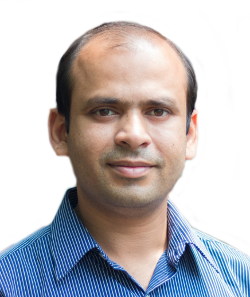
Contacts
![]() Department of Engineering
Department of Engineering
Applied Electronics Section
Roma TRE University
via Vito Volterra, 60 - Corpo B
00146, Roma - Italy
3rd floor - room 3.3
![]() +39 06 5733 7370
+39 06 5733 7370
![]() +39 06 5733 7026
+39 06 5733 7026
![]() pramit.mazumdar
pramit.mazumdar![]() uniroma3.it
uniroma3.it
Personal page updated to:
4 Sep 2019
Pramit Mazumdar received his Bachelor of Technology (B.Tech) degree in Information Technology from West Bengal University of Technology (WBUT), Kolkata, India in 2008 and Master of Technology (M.Tech) degree in Information Technology from Jadavpur University (JU), Kolkata, India in 2012.
He has submitted Thesis for Doctor of Philosophy (Ph.D.) degree in Computer Science and Engineering from National Institute of Technology Rourkela (NITR), Rourkela, India in 2018.
From May 2018 he is Post Doc in Roma Tre University.
His research interests are Human-Computer Interaction, Machine Learning, Data Science and Information Retrieval.
International Conferences
Giuliano Arru - PhD Student (XXXIII cycle)
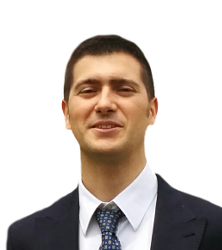
Contacts
![]() Department of Engineering
Department of Engineering
Applied Electronics Section
Roma TRE University
via Vito Volterra, 60 - Corpo B
00146, Roma - Italy
3rd floor - room 3.3
![]() +39 06 5733 7026
+39 06 5733 7026
![]() giuliano.arru
giuliano.arru![]() uniroma3.it
uniroma3.it
Personal page updated to:
4 Sep 2019
Giuliano Arru received the Bachelor's Degree in 2009 in Computer Science from Roma Tre University with a thesis on Semantic Web.
During the Master's Degree, in particular the following fields were investigated: software developing, machine learning, information retrieval, user modelling, and information extraction in intelligent system on web context.
He obtained the Master's Degree in Computer Science from Roma Tre University on October 2012, with a thesis about user modelling and information retrieval titled 'Signal-Based User Recommendation on Twitter'
After degree he started his professional career in software developing specialized in Microsoft technology.
He became Ph.D. student in November 2017 in the research field 'Machine Learning for light field processing'.
His research field is Machine Learning for light field processing.
International Conferences
- G. Arru, D. Feltoni Gurini, F. Gasparetti, A. Micarelli, and G. Sansonetti. "Signal-based user recommendation on twitter" in Proceedings of the 22Nd International Conference on World Wide Web, WWW '13 Companion, pages 941–944, New York, NY, USA, 2013. ACM
Sara Baldoni - PhD Student (XXXIV cycle)
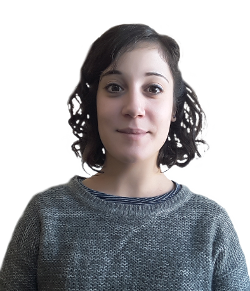
Contacts
![]() Department of Engineering
Department of Engineering
Applied Electronics Section
Roma TRE University
via Vito Volterra, 60 - Corpo B
00146, Roma - Italy
3rd floor - room 3.3
![]() +39 06 5733 7026
+39 06 5733 7026
![]() sara.baldoni
sara.baldoni![]() uniroma3.it
uniroma3.it
Personal page updated to:
4 Sep 2019
Sara Baldoni received her Bachelor degree in Electronics Engineering from Roma Tre University in 2016 and Master degree in Information and Communication Technology Engineering from Roma Tre University in 2018.
From november 2018 she is a Ph.D. student in Applied Electronics at the Engineering Department of Roma Tre University.
Her main research interests are in the area of Communication Security and Navigation and Localization Systems.
International Journals
- F. Battisti, S. Baldoni, M. Brizzi, and M. Carli. "A feature-based approach for saliency estimation of omni-directional images" in Signal Processing: Image Communication, Elsevier, Volume 69, November 2018, Pages 53-59.
International Conferences
- A. Neri, S. Baldoni, and R. Capua. "On Cyber-security of Augmentation Networks" in Proceedings of the 2019 International Technical Meeting of The Institute of Navigation, Reston, Virginia, January 2019, pp. 408-422.
Michele Brizzi - PhD Student (XXXIV cycle)
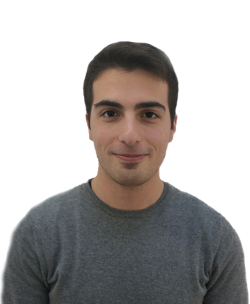
Contacts
![]() Department of Engineering
Department of Engineering
Applied Electronics Section
Roma TRE University
via Vito Volterra, 60 - Corpo B
00146, Roma - Italy
3rd floor - room 3.3
![]() +39 06 5733 7026
+39 06 5733 7026
![]() michele.brizzi
michele.brizzi![]() uniroma3.it
uniroma3.it
Personal page updated to:
4 Sep 2019
Michele Brizzi received the Laurea (B.Sc.) in Electronics Engineering and the Laurea Magistrale (M.Sc) in Information and Communication Technology Engineering from Roma Tre University in 2016 and 2018, respectively.
Starting November 2018, he is a Ph.D. student in Applied Electronics at the Engineering Department of Roma Tre University.
His main reasearch interests are in the area of multimedia signal processing.
International Journals
- F. Battisti, S. Baldoni, M. Brizzi, and M. Carli. "A feature-based approach for saliency estimation of omni-directional images" in Signal Processing: Image Communication, Elsevier, Volume 69, November 2018, Pages 53-59.
International Conferences
- O. Johannsen, K. Honauer, B. Goldluecke, A. Alperovich, F. Battisti, Y. Bok, M. Brizzi, M. Carli, et al. "A Taxonomy and Evaluation of Dense Light Field Depth Estimation Algorithms" the IEEE Conference on Computer Vision and Pattern Recognition (CVPR) Workshops, Honolulu, HI, USA, July 2017.
Moses Mariajoseph - Marie Curie fellow

Contacts
![]() Department of Engineering
Department of Engineering
Applied Electronics Section
Roma TRE University
via Vito Volterra, 60 - Corpo B
00146, Roma - Italy
3rd floor - room 3.3
![]() +39 06 5733 7370
+39 06 5733 7370
![]() +39 06 5733 7026
+39 06 5733 7026
![]() moses.mariajoseph
moses.mariajoseph![]() uniroma3.it
uniroma3.it
Personal page updated to:
4 Sep 2019
Moses Mariajoseph, received his bachelor degree (B.Eng) in Electronics and Communication from Sathyabama University, Chennai, India in 2010. Due to his great quest, he also did his dual bachelor degree (B.Eng) in Computer Science Engineering from Sathyabama University, Chennai, India in 2011. Through his motivation and self-interest he did his Master degree (M.Tech) in Mechatronics from VIT University, Vellore, India in 2013, with a thesis about System design and development of new machining setup for energy efficient turning process. During his master study in VIT University, he was a student’s representative.
In further he obtained an opportunity to do his second masters in Computational Engineering from University of Rostock, Rostock, Germany. During his master study, he has worked as a research assistant in clean room ISO class 5.
He worked as a student researcher in Celisca, Rostock, Germany with the research focus on localization of Mobile Robots. Later he was worked as System Design and Control research engineer, in TPRC, Enschede, the Netherlands with a project focus on Robotized feedback system for induction welding in the thermoplastic composite material.
From November 2018 he is PhD student in Roma Tre University.
His research interests are .
International Conferences
Umair Arif - Marie Curie fellow
Contacts
![]() Department of Engineering
Department of Engineering
Applied Electronics Section
Roma TRE University
via Vito Volterra, 60 - Corpo B
00146, Roma - Italy
3rd floor - room 3.3
![]() +39 06 5733 7370
+39 06 5733 7370
![]() +39 06 5733 7026
+39 06 5733 7026
Personal page updated to:
4 Sep 2019
Mr. Syed M. Umair Arif was born in Pakistan on 1988. In 2008, he completed his Diploma of Associate Engineering in Electrical Engineering from Science Institute of Technology, Pakistan. Major Subject
In 2012, he completed his Bachelor of Science in Computer Science with Specialization of Computer Network systems from Federal Urdu University Art Sciences and Technology, Pakistan. Major Subjects
In 2018, he completed his Masters of Science with Distinction in Bio Technical System & Technology with Bio Medical Engineering from Tomsk Polytechnic University Tomsk Russia. It was collaborative study between Siberian State Medical University and Tomsk Polytechnic University. He completed his 21 credit hours of study in Medical University
In Bachelors he studied Computer Science and chose his specialization computer networks and he have hand on experience on Cisco Systems, Juniper, Motorola, D-Link, Ericson, Huawei, ZTE, TP Link, Linksys, Netgear and NEC Routers and Switches. He also studied Cisco Courses CCNA Routing & Switching, Cisco Wireless, Cisco Introduction, and MCSE. Moreover he studied Computer Programming & Fundamentals, Data Structures & Algorithms, Operating System, Databases, Computer Networks & Advance computer networks, Network Programing, Network Management, Network Simulation & Modeling, Network Security & Encryption Algorithms, Telecommunication Protocol Network 1 & 2, Wireless Communication, Traffic forecast and network Planning. In bachelor I got experience used Network Simulator and Emulators
In Masters he studied Bio Medical Engineering and worked in Medical Hospital and Medical University during his practices and completed 60 Credit Hours of study. He also worked in Tomsk Polytechnic Research center & RASA Center in Tomsk almost one and half year and provided his voluntary services to automate Medical machines for remote uses
In Masters he worked on Telemedicine Application “Telemedicine application for remote hearing evaluation and speech therapy for deaf people after cochlear implantation”. In Master Project he built his own network for provide Online Classes & VoIP services with secure communication and connect Doctor to Patients, Doctors to Doctors through mobile phone devices and Personal Computers and record all audio sessions. Before using Audio Codecs he performed different simulations and he recorded live audio sessions and check different parameters of audio signals and analyze which codec is best for providing Telespeech therapy after cochlear implant surgery via internet. Same he simulated network all over the Russia and tested network on OPNET simulator which routing algorithm and which communication media is best for providing medical services on remote areas on low bandwidth internet
Graduate Research Engineer at Tomsk Polytechnic University (Tomsk Russia) February 2017 to June 2018
Technical Support Engineer at Future Now Technology Project May 2016 to November 2016 (Prime communications AT&T U.S) http://www.primecomms.com
Network Support Engineer at Inovedia Technology Project December 2014 to February 2106 (ULTRA MOBILE MVNO U.S) https://ultramobile.com
IT Admin at QATAR DESCON Engineering Doha, Qatar Feb 2014 to May 1st 2014
IT Support Engineer/Network Engineer at PRIME ENGINEERING & TESTING CONSULTANTS, Islamabad, Pakistan March 2013 to 26 Feb 2014
Cisco CCNA (NUST, Pakistan)
Work Management System (RasGas Qatar)
MCSE (F.U.U.A.S.T, Pakistan)
MTA (F.U.U.A.S.T, Pakistan)
Cisco Wireless (F.U.U.A.S.T, Pakistan)
SBC GENBAND QUANTIX Q20( INOVEDIA TECHNOLOGIES)
INGATE SIParator (INOVEDIA TECHNOLOGIES)
Best Performance certificate of the month ( RasGas Qatar)
Best Performance certificate for completing training (RasGas Qatar)
Scholarship from Russia educational ministry and science for Masters
3rd Prize Medal in Digital Hackthon in Tomsk Russia
Gold Medal in Masters studies from Tomsk Polytechnic University
1st prize in photography competition for capturing nature of Siberia
He got pedagogical practice for 6 months with one Professor to teach biocompatible materials subject to students
Pietro Salvatori - XXIX PhD Cycle

Pradip Paudyal - XXIX PhD Cycle

Contacts
![]() Department of Engineering
Department of Engineering
Applied Electronics Section
Roma TRE University
via Vito Volterra, 60 - Corpo B
00146, Roma - Italy
3rd floor - room 3.3
![]() +39 06 5733 7370
+39 06 5733 7370
![]() +39 06 5733 7026
+39 06 5733 7026
![]() pradip.paudyal
pradip.paudyal![]() uniroma3.it
uniroma3.it
![]() pradip.paudyal
pradip.paudyal
Personal page updated to:
4 Sep 2019
Pradip Paudyal received his PhD from Department of Engineering at the Università degli Studi 'Roma TRE', Roma, Italy in 2017 and M.Sc. in Information and Communication Engineering from Tribhuvan University, Kathmandu, Nepal in 2010.
He has also completed Masters in Business Administration (MBA-Executive) in 2014 from Ace Institute of Management, Kathmandu Nepal.
Now, he is serving as an Asst. Director at Nepal Telecommunications Authority (NTA), Kathmandu, Nepal.
Multimedia signal processing and communication, Perceptual quality assessment, and Quality of Experiance (QoE).
Yiwei Liu - XXIX PhD Cycle
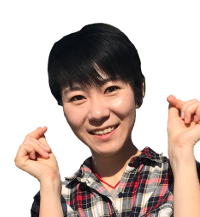
Contacts
![]() Department of Engineering
Department of Engineering
Applied Electronics Section
Roma TRE University
via Vito Volterra, 60 - Corpo B
00146, Roma - Italy
3rd floor - room 3.3
![]() +39 06 5733 7370
+39 06 5733 7370
![]() +39 06 5733 7026
+39 06 5733 7026
Personal page updated to:
4 Sep 2019
Yiwei Liu, graduated from "Tianjin University" with bachelor degree in information engineering in 2008. In the same year she entered Huawei, wireless marketing department, working as product pre-sales engineer. After that, she moved to the New Land Group, working as overseas pre-sales engineer. Then she decided to go back to school for further study.
From October 2011 to October 2013, she studied in "Roma Tre University" for Master's degree. Later, from January 2014 to May 2017, she continuous her study in the same university, and received her PhD degree in November 2017.
She mainly involved her research in train control communication support system. During her Ph.D study, she finished two projects, including the MPTCP project and MPUDP project. Both of them is in partnership with Selex S.P.A.
The MPTCP project proposed a new train communication system architecture, which uses the public network and satellite communication technology under the umbrella of the MPTCP transmission protocol to realize the transmission of train control signaling data. The new architecture can achieve the same transmission reliability, availability level as the current dedicated GSM-R network.
The MPUDP solution uses multiple links to transmit the voice packets during train control using scenario. This solution, combined with RaptorQ encoding, can fulfill the system reliability and real-time transport requirements. Moreover, it can well solve packet loss and out-of-order issues during the transmission as well.
Journal Papers
- Y. Liu, A. Neri, A. Ruggeri, and A.M. Vegni, "A MPTCP-based Network Architecture for Intelligent Train Control and Traffic Management Operations," in IEEE Transaction on Intelligent Transportation Systems, 2016, doi: 10.1109/TITS.2016.2633531.
Conference Papers
- P. Paudyal, Y. Liu, F. Battisti, and M. Carli, "Video Quality of Experience metric for streaming services", Proc. Electronic Imaging, Image Processing: Algorithms and Systems XIV, pp. 1-5(5), 14 February, 2016, San Francisco, USA.
- Y. Liu, Neri, A., Ruggeri, A., "Integration of PLMN and satellite networks for train control and traffic management via MPTCP", in 14th IEEE International Conference on Intelligent Transportation Systems, vol., no., pp.75-79, 2-4 Dec. 2015
- F. Battisti, M. Carli, Y. Liu, A. Neri, and P. Paudyal, "Distortion-based No-Reference quality metric for video transmission over IP", 12th International Symposium on Signals, Circuits and Systems, 9 - 10 July, 2015, Iasi, Romania.
Our courses
Module
Internet & multimedia
- Start 01/03/2019
Duration 42 hours
Code 20810059End 14/06/2019
Language ITA
Channel SingleCredits 6
SSD ING-INF/03
Timetable Already finishedCertification Attestato di profittoType of activity Attività formative a scelta dello studente (art.10, comma 5, lettera a)
Type of course Traditional
Test - GOMP page link
- Moodle page link
- Teacher Marco Carli
- Objectives
Il corso ha l'obiettivo di descrivere le caratteristiche dei sistemi di telecomunicazioni, a partire dalla rete telefonica alle reti per dati a commutazione di pacchetto alle reti wireless.
Verranno affrontati aspetti di prestazioni in funzione della qualità, del costo e della sicurezza dei servizi offerti.
Nel corso sarà dato ampio spazio ai sistemi per la trasmissione di segnali multimediali e al sistema Internet of Things (IoT).
Parte delle esercitazioni sarà dedicata al progetto ed alla realizzare dei sistemi di comunicazione IoT basati su microcontrollori e protocolli a basso consumo energetico - Contents
Argomenti del corso- Architettura protocollare e modelli di servizio
- Modelli OSI e Internet
- Definizione di Internet
- Ritardo, sicurezza e Qualità del Servizio (QoS)
- Protocolli di livello Applicativo e modello client-server
- Trasmissione affidabile. Livello di trasporto
- Principi di routing. Protocollo IP
- Strato di collegamento
- IEEE 802.3 Ethernet
- Livello fisico
- IEEE 802.11
- Introduzione alla sicurezza
Hot topics- Sensor networks e Software Defined Networks
- Internet of Things
Realizzazione pratica di architettura IoT utilizzando schede basate su architettura Arduino-Fishino - Materials
- J. Kurose and K. Ross, Computer Networking: A Top-Down Approach, 6th edition (ISBN-13: 978-0132856201)
Module
Laboratorio di multimedialitÃ
(Multimedia laboratory)- Start 01/03/2019
Duration 48 hours
Code 20802061End 31/05/2019
Language ITA
Channel SingleCredits 6
SSD ING-INF/03
Timetable Already finishedCertification Attestato di profittoType of activity Attività formative a scelta dello studente (art.10, comma 5, lettera a)
Type of course Traditional
Test Prova scritta - GOMP page link
- Web page link
- Moodle page link
- Teacher Federica Battisti
- Objectives
Il corso ha l'obiettivo di illustrare le metodologie più avanzate per la caratterizzazione e il trattamento dei segnali multimediali.
Il corso è suddiviso in due parti:- la prima per fornire le conoscenze teoriche di base sugli strumenti per l'elaborazione dei segnali multimediali e sulla programmazione in Matlab,
- la seconda consiste in esperienze pratiche, di gruppo e individuali, sia su calcolatori che tramite dispositivi messi a disposizione degli studenti
- Contents
- Introduzione alla programmazione in Matlab
- Caratteristiche del sistema visivo umano
- Elaborazione e filtraggio delle immagini nel dominio spaziale
- Elaborazione e filtraggio delle immagini nel dominio trasformato
- Tecniche di compressione delle immagini
- Sistemi stereoscopici
- Introduzione al video analogico e digitale
- Tecniche di codifica video
- Tecniche di elaborazione del segnale plenottico
- Interfacce uomo/macchina di ultima generazione
- Esercitazioni di laboratorio
- Materials
- R.C. Gonzalez, R.E. Woods, and S. L. Eddins, Digital Image Processing Using MATLAB, 2e, Publisher: Prentice-Hall
- B. Block and P. McNally, 3D storytelling: how stereoscopic 3D works and how to use it, Publisher: Focal Press
- C. W. Chen, Z. Li and S. Lian, Intelligent Multimedia Communication: Techniques and Applications (Studies in Computational Intelligence), Publisher: Springer
- Dispense monografiche su alcune parti del corso
Module
Laboratorio di reti per telecomunicazioni
(Telecommunication networks laboratory)- Start 01/03/2019
Duration 42 hours
Code 20802062End 14/06/2019
Language ITA
Channel SingleCredits 6
SSD ING-INF/03
Timetable Already finishedCertification Attestato di profittoType of activity Attività formative a scelta dello studente (art.10, comma 5, lettera a)
Type of course Traditional
Test Prova scritta, prova orale - GOMP page link
- Moodle page link
- Teacher Anna Maria Vegni
- Objectives
Il corso ha il duplice obiettivo di presentare concetti base di teoria delle reti (tra cui reti cellulari, reti ad hoc, reti sociali, etc.) e quello di illustrare le metodologie più avanzate per l'analisi dei sistemi di telecomunicazioni, sia attraverso programmi di simulazione (Network Simulator 2) sia attraverso l'installazione e configurazione di reti wireless e wired.
La simulazione permette di valutare le prestazioni delle reti di telecomunicazioni progettate, mentre l'utilizzo di sistemi di monitoraggio del traffico fornisce un riscontro reale dell'efficacia delle reti progettate
Lo studio delle reti per telecomunicazioni prevede anche le reti wireless ottiche nella banda del visibile (visible light communications) - Contents
- Introduzione al corso - Cosa sono le reti?
- Le prestazioni di reti - Delay, Packet loss, Throughput, Jitter
- Lo strato trasporto - Richiami a TCP, Timer, Controllo di flusso, Congestione di rete
- Le sorgenti di informazione - Rate di emissione medio e rate di picco, Fattore di burstiness, Sorgenti in NS2 (CBR e VBR)
- Le applicazioni di rete - Architetture delle applicazioni (modello Client-Server e P2P), applicazioni P2P (BitTorrent e Skype), HTTP e FTP, DNS
- VANETs - Le reti veicolari, caratteristiche e differenze con le MANETs, applicazioni e protocolli di comunicazione
- Motori di ricerca - Metriche dei motori di ricerca (Link structure, TF-IDF), tecniche di Page Ranking (HITS, PageRank)
- Comunicazioni wireless ottiche - Visible Light Communications
- Small worlds e le reti sociali - Materials
- J.F. Kurose, and K.W. Ross, Computer Networking: A Top-Down Approach, 6th Edition, Addison Wesley
- A.S. Tanenbaum, Computer Networks, 4th Edition, Prentice Hall 2002
- D. Easley, and J. Kelinberg, Networks, Crowds, and Markets: Reasoning about a Highly Connected World, Cambridge University Press, 2010
- Z. Ghassemlooy, W. Popoola, and S. Rajbhandari, Optical wireless communications, System and Channel modeling with MATLAB, CRC Press
- Dispense a cura del docente
Module
Trasmissioni numeriche
(Digital Communications)- Start 01/10/2018
Duration 48 hours
Code 20801998End 25/01/2019
Language ITA
Channel SingleCredits 6
SSD ING-INF/03
Timetable Already finishedCertification Attestato di profittoType of activity Attività formative caratterizzanti
Type of course Traditional
Test Prova scritta - GOMP page link
- Moodle page link
- Teacher Alessandro Neri
- Objectives
Acquisire conoscenze specifiche sulle tecniche di base per la trasmissione dell'informazione su collegamenti numerici.
Apprendere le principali metodologie per il dimensionamento e la progettazione di collegamenti punto-punto e punto-multipunto in tecnica numerica - Contents
- Teoria classica della ricezione: procedura di Bayes, procedura minimax
- Verifica di ipotesi binaria
- Rivelazione di segnali in rumore additivo gaussiano
- Verifica di ipotesi M-aria
- Rivelazione M-aria in rumore gaussiano
- Modulazioni numeriche: interferenza intersimbolica
- Modulazione ASK: principi e prestazioni
- Casi particolari: ricevitore ottimo, ricevitore subottimo, esempi di modulazione ASK
- Modulazione QAM: principi e prestazioni
- Modulazione PSK: principi e prestazioni
- Modulazioni derivate dalla modulazione PSK: OQPSK e MSK
- Tecniche di modulazione basate sull'espansione dello spettro: multiplazione CDMA
- DS-CDMA
- Codici d'espansione OVSF, Walsh-Hadamard
- Sequenze da registro a scorrimento, M-sequences
- Codici di Gold e Kasami
- Tecniche per il controllo dinamico della velocità di trasmissione
- Analisi delle prestazioni: casi sincrono e asincrono
- Canali affetti da fading e da cammini multipli: modello Wide Sense Stationary Uncorrelated scattering (WWSSU)
- Ricevitore Rake
- DS-CDMA: analisi delle prestazioni in un multipath fading channel con ricevitore Rake
- Modulazione OFDM: rappresentazione nel dominio del tempo e della frequenza, architettura di modulazione
- Algoritmo FFT per il calcolo della trasformata discreta di Fourier
- Equalizzazione nel dominio della trasformata discreta di Fourier
- Uso del prefisso ciclico
- Architettura di demodulazione
- Prestazioni
- Caratterizzazione del rumore nei circuiti
- Rumore termico nei bipoli passivi
- Rumore termico nelle reti 2 porte
- Materials
- A. Neri, Appunti dalle lezioni di trasmissioni numeriche. Scaricabile gratuitamente dal sito http://elearning.ing.uniroma3.it
Module
Comunicazioni multimediali
- Start 01/03/2019
Duration 36 hours
Code 20801690End 14/06/2019
Language ITA
Channel SingleCredits 6
SSD ING-INF/03
Timetable Already finishedCertification Attestato di profittoType of activity Attività formative caratterizzanti
Type of course Traditional
Test Prova orale, valutazione di un progetto - GOMP page link
- Moodle page link
- Teacher Marco Carli
- Objectives
L'insegnamento ha l'obiettivo di presentare gli aspetti sistematici e modellistici legati al supporto di servizi multimediali nelle reti di telecomunicazioni.
Verranno definite le caratteristiche del dato multimediale e delle varie tipologie di sorgente (sistema visivo umano, sistema uditivo, ecc.).
Saranno trattati gli aspetti architetturali e protocollari legati a specifici esempi di rete, aspetti di codifica di sorgente, di protezione dell'informazione mediante codifica di canale e di integrazione di informazioni di natura differente (video, audio, dati).
Parte dell insegnamento sarà dedicata ai sistemi innovativi di codifica e trasmissione - Contents
- Introduzione al multimediale
- Formazione dell'immagine
- Sistema visivo umano
- Codifica di sorgente per segnali multimediali (JPEG, MPEG H264, HEVC...)
- Codifica audio
- sistemi di comunicazione vs. multimedia
- Qualità del servizio
- Interfacce uomo macchina - HTC VIVE
- Materials
- P. Havaldar and G. Medioni, Multimedia Systems: Algorithms, Standards and Industry Practices, Cengage Learning 978-1-4188-3594-1
- Ohm, Multimedia Communication Technology, Springer, ISBN: 978-3-642-62277-9 (Print) 978-3-642-18750-6 (Online)
Module 1
Elementi di crittografia
- Start 04/03/2019
Duration 36 hours
Code 20801702-1End 31/05/2019
Language ITA
Channel SingleCredits 6
SSD ING-INF/03
Timetable Already finishedCertification Attestato di profittoType of activity Attività formative affini ed integrative
Type of course Traditional
Test Prova scritta - GOMP page link
- Moodle page link
- Teacher Federica Battisti
- Objectives
Il corso consente di acquisire le nozioni e i concetti che sono alla base della Crittografia moderna
Fornisce inoltre gli strumenti concettuali e teorici che consentono di comprendere le tecniche avanzate attualmente utilizzate per proteggere la trasmissione e la memorizzazione di informazioni in presenza di agenti ostili o di rumore presente nel canale.
L'obiettivo principale è di permettere agli studenti di capire il funzionamento di un crittosistema o di un protocollo crittografico.
Questo porterà alla capacità di scegliere gli strumenti crittografici adatti per proteggere i dati durante la loro trasmissione e/o memorizzazione - Contents
- Introduzione alla crittografia
- Definizione di crittosistema, cifrari additivi, cifrari a sostituzione, cifrari a trasposizione
- Modi di funzionamento dei crittosistemi simmetrici
- Crittosistemi simmetrici standard: DES, 3DES e AES
- Crittografia asimmetrica (RSA, Diffie-Hellman), vantaggi e svantaggi
- Funzioni Hash e Message Digest
- Firma digitale, i certificati digitali, le autorità di certificazione, lo standard X.509/PKI (Public Key Infrastructure)
- Materials
- A. Stanoyevitch, Introduction to Cryptography
- A. J. Menezes, P. C. van Oorschot e S. A. Vanstone, Handbook of Applied Cryptography
- N. Ferguson e B. Schneier, Crittografia pratica
- W. Stallings, Cryptography and Network Security - Principles and Practices, Seventh Edition
- Dispense monografiche su alcune parti del corso
Module 2
Sicurezza delle telecomunicazioni
- Start 01/03/2019
Duration 36 hours
Code 20801702-2End 14/06/2019
Language ITA
Channel SingleCredits 6
SSD ING-INF/03
Timetable Already finishedCertification Attestato di profittoType of activity Attività formative caratterizzanti
Type of course Traditional
Test - GOMP page link
- Moodle page link
- Teacher Marco Carli
- Objectives
Il corso ha come obiettivo l'analisi dei principali meccanismi e protocolli utilizzati nell ambito della sicurezza nelle reti di telecomunicazioni.
Verranno analizzati i principali meccanismi per autenticazione, accesso, integrità, privacy nelle reti tlc.
In particolare vengono presentati i concetti di crittografia, i protocolli di autenticazione e comunicazione sicura, architetture di rete sicure.
Inoltre, verrà fornita allo studente la conoscenza delle tecnologie per la sicurezza dei contenuti multimediali (steganografia e watermarking digitale).
Verranno anche sviluppate le conoscenze matematiche necessarie a comprendere il funzionamento e a costruire crittosistemi e protocolli, in particolare a chiave pubblica - Contents
- Kerberos e Diameter
- IP Security
- Sicurezza nel web
- Sistemi di autenticazione
- Intrusion detection
- Honey pot
- Android security
- Cloud security
- Big data security
- Analisi Forense di immagini digitali
- Analisi e rilevazione di modifiche di dati multimediali
- Tecniche di analisi statistica
- Tecniche geometriche
Sono previste esercitazioni in Matlab su marchiatura digitale e attacchi su sistemi di comunicazione - Materials
W. Stallings, Cryptography and Network Security - Principles and Practices, Seventh Edition
Module 1
Sistemi di localizzazione e navigazione
(Localization and navigation systems)- Start 01/10/2018
Duration 48 hours
Code 20810072-1End 25/01/2019
Language ITA
Channel SingleCredits 6
SSD ING-INF/03
Timetable Already finishedCertification Attestato di profittoType of activity Attività formative caratterizzanti
Type of course Traditional
Test Prova scritta - GOMP page link
- Teacher Alessandro Neri
- Objectives
Obiettivo del corso è l'acquisizione da parte dello studente dei fondamenti teorici, delle metodologie e delle tecnologie alla base dei sistemi di navigazione, sia in ambienti esterni che in ambienti interni, inclusi i sistemi di navigazione satellitare globale (GNSS), ovvero GPS, GALILEO, GLONASS e BEIDOU, i sistemi regionali IRNSS, QZSS, i sistemi di radio-localizzazione terrestri basati su reti radiomobili 4G e 5G e su reti locali (WiFi, Bluetooth, ZigBee, UWB, RF-ID, etc.), i sistemi di localizzazione basati su sensori inerziali (accelerometri e giroscopi) ed i sistemi di localizzazione eterogenei (ad es.
GNSS+INS).
Ulteriore obiettivo è la contestualizzazione delle metodologie e delle tecnologie di cui sopra ai settori applicativi di maggior interesse quali: sistemi di trasporto intelligenti (aeronautici, ferroviari, marittimi, stradali), infomobilità, guida autonoma di autoveicoli, servizi basati sulla localizzazione per smartphone, tablet e computer mobili, monitoraggio dell'ambiente. - Contents
- Sistemi di navigazione satellitare: concetti generali e le tendenze evolutive
- Caratteristiche principali dei sistemi di navigazione satellitare globale (GNSS GPS, GALILEO, GLONASS e BEIDOU), e dei sistemi regionali (IRNSS, QZSS)
- Architetture
- Metodologie per il calcolo delle posizioni dei satelliti
- Caratteristiche dei segnali trasmessi, architetture, le soluzioni circuitali e gli algoritmi dei ricevitori GNSS
- Tecniche per la determinazione della posizione e della velocità di un oggetto
- Architetture e gli algoritmi per servizi ad alta accuratezza e con garanzia della qualità e dell'affidabilità dei dati (incluse reti di augmentation)
- Sistemi di radio-localizzazione terrestri basati su reti radiomobili 4G e 5G e su reti locali (WiFi, Bluetooth, ZigBee, UWB, RF-ID, etc.)
- Sistemi di localizzazione basati su sensori inerziali (accelerometri e giroscopi)
- Integrazione tra sistemi di localizzazione eterogenei (ad es. GNSS+INS)
- Applicazioni di maggiore rilevanza: sistemi di trasporto intelligenti (aeronautici, ferroviari, marittimi, stradali), infomobilità, guida autonoma di autoveicoli, servizi basati sulla localizzazione per smartphone, tablet e computer mobili, monitoraggio dell'ambiente
- Materials
- P. Misra and P. Enge, Global Positioning System: Signals, Measurements, and Performance, Revised Second Edition (2011) ISBN 0-9709544-1-7 Ganga-Jamuna Press
- J. Sanz Subirana, J.M. Juan Zornoza and M. Hernández-Pajares, GNSS DATA PROCESSING, Vol. I e Vol. II. Scaricabile gratuitamente dal sito http://www.navipedia.net/GNSS_Book
Module 2
Telecomunicazioni wireless
- Start 01/10/2018
Duration 54 hours
Code 20810072-2End 25/01/2019
Language ITA
Channel SingleCredits 6
SSD ING-INF/03
Timetable Already finishedCertification Attestato di profittoType of activity Attività formative caratterizzanti
Type of course Traditional
Test - GOMP page link
- Teacher Gaetano Giunta
- Objectives
Acquisire conoscenze generali sui sistemi wireless come parte integrante di reti di comunicazione.
Fornire una panoramica sui principali sistemi di reti mobili cellulari di nuova generazione (3G e 4G), descrivendo sommariamente l'architettura delle reti di accesso e del core network sulla base di concetti operativi fondamentali.
Acquisire conoscenze di base sulle tecniche wireless di accesso multiplo alla risorsa radio e di copertura cellulare.
Acquisire conoscenze specifiche sulla gestione della rete strutturata condivisa, della mobilità e della sicurezza delle comunicazioni.
Descrivere i criteri fondamentali di procedure, protocolli e servizi per l'interoperabilità con reti eterogenee e/o virtuali. - Contents
- Le reti wireless radiomobili
- Requisiti e servizi
- Mobilità
- Sicurezza
- Gestione della rete e dei dispositivi mobili
- Architetture ed accesso alla risorsa di rete 2G e 3G
- Architetture ed accesso alla risorsa di rete 4G
- Evoluzione verso il 5G
- Materials
- G. Giunta, Lucidi del corso di Telecomunicazioni Wireless. 2017
- G. Columpsi, M. Leonardi, A. Ricci, UMTS: Tecniche e architetture per le reti ci comunicazioni mobili multimediali, seconda edizione; Hoepli informatica; Novembre 2005
- S. Sesia, I. Toufik, M. Baker, LTE - The UMTS Long Term Evolution: From Theory to Practice, 2nd Edition, Wiley publ.; July 2011
Module
Teoria dell'informazione e codici
- Start 01/10/2018
Duration 72 hours
CodeEnd 25/01/2019
Language ITA
Channel SingleCredits 9
SSD ING-INF/03
Timetable Already finishedCertification Attestato di profittoType of activity Attività formative caratterizzanti
Type of course Traditional
Test Prova scritta - GOMP page link
- Moodle page link
- Teacher Alessandro Neri
- Objectives
Acquisizione dei fondamenti teorici della teoria dell'informazione e delle metodologie e delle tecnologie per la codificazione di sorgente di segnali mono e multimediali ai fini della riduzione di ridondanza sia senza perdita d'informazione che con perdita controllata.
Acquisizione dei fondamenti teorici, delle metodologie e delle tecnologie per la protezione dell'informazione nei confronti di errori, distorsioni e rumori introdotti dai sistemi di telecomunicazione numerici - Contents
Elementi di teoria dell'informazione:- Entropia di una sorgente, entropia relativa
- Entropia congiunta e entropia condizionata
- Statistica sufficiente
- Codifica di sorgente senza perdita di informazione: Codici ottimi
- Limiti sulla lunghezza delle parole di codice per i codici ottimi
- Diseguaglianza di Kraft per codici univocamente decodificabili
- Codificatori di Huffman e di Shannon-Fano-Elias
- Codifica di sorgente Universale
- Codificatori aritmetici
- Codificatore di Lempel-Ziv Equivocazione, tasso di informazione mutua, capacità di canale
- Capacità dei canali binari simmetrici e dei canali limitati in banda affetti da rumore additivo gaussiano
- Teorema di Shannon sulla codifica di canale
- Diseguaglianza di Fano
- Teorema della separazione tra codifica di sorgente e la codifica di canale
- Codificazione dei segnali audio
- Caratteristiche del sistema uditivo umano, soglia assoluta di udibilità, percezione dei suoni complessi, banda critica e mascheramento simultaneo, caratteristiche temporali dei meccanismi di mascheramento
- Tecniche di codifica del segnale vocale
- Codiche temporali: G.711, G.726 e G.727
- Codifiche basate su modelli: G.729
- Codifiche nel dominio della frequenza: MPEG 1 layer I, II e III, MPEG-2 e MPEG-4
- Elementi di codifica delle immagini: la trasformata coseno discreta (DCT) e la codifca JPEG
- Definizione, matrice generatrice, controlli di parità, codici sistematici
- Rivelazione e correzione d'errore per codici lineari a blocco
- Sindrome
- Codice duale di un codice lineare a blocco
- Decodificatore ottimo
- Rivelazione e correzione d'errore per canali binari simmetrici
- Schieramento standard
- Prestazioni
- Campi di Galois: definizioni e proprietà
- Codici ciclici
- Codici d Hamming
- Codici di Reed-Solomon
- Codici convoluzionali: definizioni e proprietà
- Decodifica a massima verosimiglianza: canali binari simmetrici e canali gaussiani
- Serie di Markov: definizioni e prorietà
- Algoritmo di Viterbi: principio, implementazione e prestazioni
- Algoritmo di Viterbi: prestazioni
- Turbocodici: definizioni e principio di funzionamento
- Codici concatenati
- Codificatori convoluzionali ricorsivi sistematici
- Interallacciatori per codici convoluzionali
- Calcolo della probabilità a posteriori (AAP) per i turbocodici
- Principio di funzionamento dei protocolli ARQ ibridi
- Decodificatori per turbo codici: algoritmo di decodifica
- Codici punturati
- Reti bayesiane
- Grafi orientati aciclici
- Algoritmo di Pearl
- Alberi bayesiani
- Codici lineari a blocco a bassa densità (LDPC): definizioni e proprieta
- Decodicatore per LDPC
- Cenni sulla codifica di canale orientata al pacchetto: codici a fontana e codici Raptor
- Stima a minimo errore quadratico medio: soluzione generale, caso Gaussiano in Gaussiano
- Trasformata discreta di Fourier per processi ciclostazionari
- Filtro di Wiener: caso Gaussiano in Gaussiano
- Stima a minimo errore assoluto medio (MMAE)
- Stima a massima probabilità a posteriori (MPA)
- Stima a massima verosimiglianza (ML)
- Diseguaglianza di Cramér-Rao mono e pluridimensionale
- Stimatori efficienti
- Matrice di informazioen di Fisher
- Stima di tempo d'arrivo
- Stima congiunta di tempo d'arrivo e spostamento Doppler
- Trasformata wavelet e analisi multirisoluzione
- Restauro del segnale nel dominio della trasformata Wavelet
- A. Neri, Appunti dalle lezioni di Teoria dell'Informazione e Codici. Scaricabile gratuitamente dal sito http://elearning.ing.uniroma3.it
- T. M. Cover, J. A. Thomas, Elements of information theory 2nd ed., 2006 John Wiley & Sons, Ltd. Scaricabile gratuitamente dal sito http://host.uniroma3.it/biblioteche/page.php?page=e-books_w
- J. C. Moreira, P. G. Farrell, Essentials of error-control coding c2006 John Wiley & Sons, Ltd. Scaricabile gratuitamente dal sito http://host.uniroma3.it/biblioteche/page.php?page=e-books_w
Our Projects and Collaborations
ImmerSAFE
Open positions decription
ESR6: Assessing the effectiveness of immersive visual technologies in an industrial machine framework
More Information: Euraxess
Application Deadline: 31/03/2018
ESR7: Evaluating the Quality of Experience of immersive visual systems in operative control rooms
More Information: Euraxess
Application Deadline: 31/03/2018
If you want more information please visit the official ImmerSAFE site
Webpage content updated to: 30 November 2017 12:59
Resources
Description
Deep learning is one of the fastest-growing segments of the machine learning or artificial intelligence field and a key area of innovation in computing. With researchers creating new deep learning algorithms and industries producing and collecting unprecedented amounts of data, computational capability is the key to unlocking insights from data
The DIGITS DevBox is a deep learning machine designed and built by NVIDIA to give researchers all the computational power they need in a compact box that fits easily under any desk

Specifications
| Hardware |
|---|
| Four TITAN X GPUs with 12GB of memory per GPU |
| 64GB DDR4 |
| Asus X99-E WS workstation class motherboard with 4-way PCI-E Gen3 x16 support |
| Core i7-5930K 6 Core 3.5GHz desktop processor |
| Three 3TB SATA 6Gb 3.5" Enterprise Hard Drive in RAID5 |
| 512GB PCI-E M.2 SSD cache for RAID |
| 250GB SATA 6Gb Internal SSD |
| 1600W Power Supply Unit from premium suppliers including EVGA |
| Software |
| Ubuntu 14.04 |
| NVIDIA-qualified driver |
| NVIDIA® CUDA® Toolkit |
| NVIDIA® DIGITS™ SW |
| NVIDIA® cuDNN™ |
| Caffe, Theano, Torch, BIDMach |
Description
Once you put on the Vive headset, you are immersed in a world full of surprises

Walk around freely and explore everything while the Chaperone guidance system keeps you within the bounds of your play area. Stunning graphics make it feel so real and surreal simultaneously
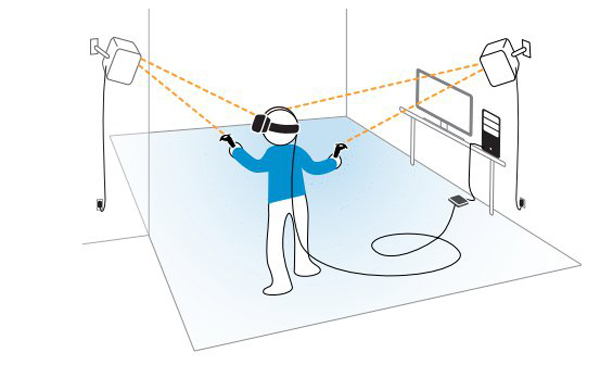
The HTC VIVE VR system is composed by several parts:
- An headset to see the incredible virtual world presented you by VIVE
- Two wireless controllers, one in each hand, to interact with the virtual environment
- Optional tracker to track the position of any object you like
- Two base stations to precisely track the position of headset, controller, trackers inside your play area
- Earphones to enjoy an experience even more immersive with hi-fi audio
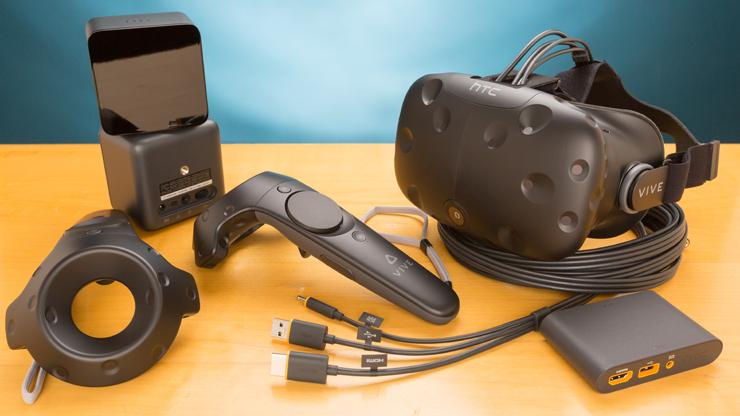
Specifications
| Headset |
|---|
| 110° field of view |
| 2160 x 1200 combined resolution and 90 Hz refresh rate |
| Front camera to blend the real-world around you into the virtual world you are immersed in |
| 32 sensors for 360° motion tracking |
| Controllers |
| Multi-function hi-resolution trackpad with haptic feedback |
| 24 sensors for 360° motion tracking on each controller |
| Tracker (optional) |
| Sensors for 360° motion tracking |
| Can be attached to any object you want to carry into the virtual world |
| Base stations |
| Laser coverage of the play area for 360° tracking of headset, controllers and tracker with millimeter accuracy |
| Wireless connection, only a power cable is required |
Description
The Leap Motion controller is a small USB peripheral device designed to be placed on a physical desktop, facing upward or onto a virtual reality headset, whose purpose is to determine the position and gestures of the user's hands

The device frames an approximately hemispherical area at a distance of about 1 meter through two IR cameras and three IR LEDs. The LEDs generate IR light, the two cameras capture reflected light and generate about 200 frames per second that are analyzed and processed by the software that produces a 3D map of user hands moving into space in front of the device with a precision of about 0.7 mm
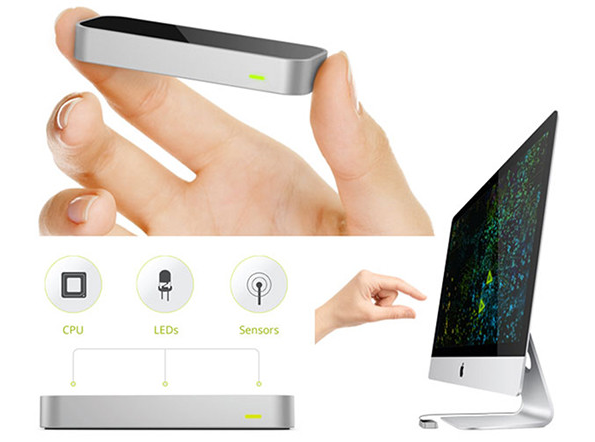
The device can be used as a contactless Human-Machine-Interface which possible uses are:
- navigating a website
- exploring a map using pinch-to-zoom gestures
- drawing with high-precision
- manipulating complex 3D data visualizations
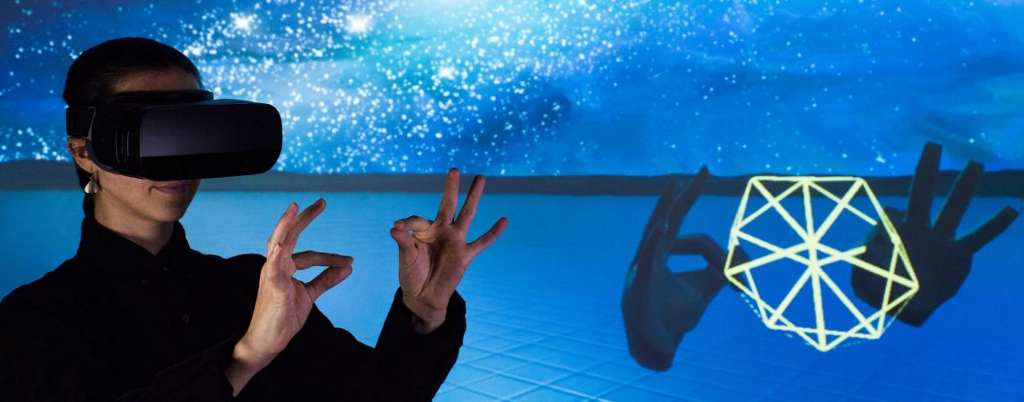
The interaction in a virtual environment requires a proper VR set
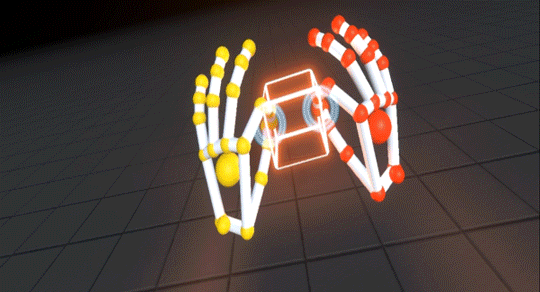
Example of interaction in a virtual environment
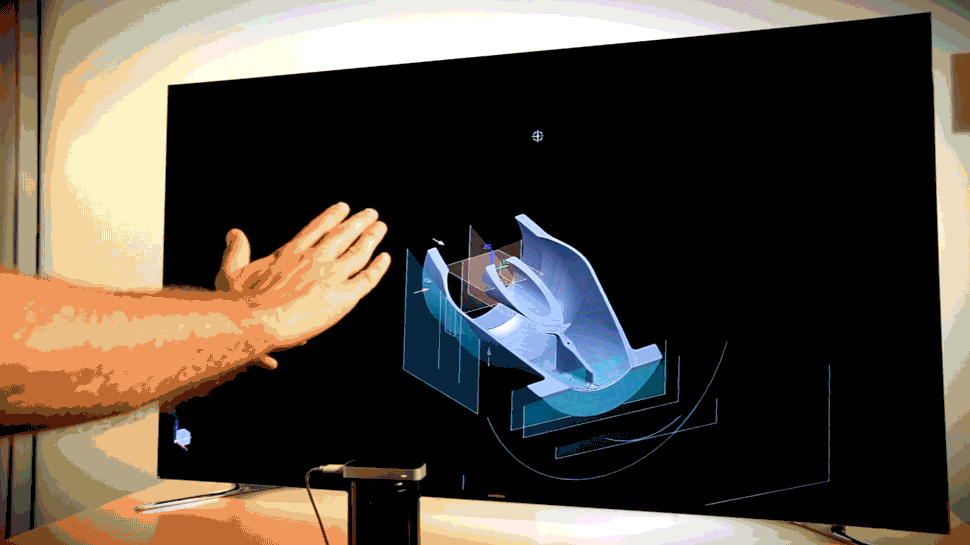
A possible application in a CAD program

A new way to interact with PC
Description
Lytro ILLUM is a light field camera and software platform designed to redefine the way we portray the world around us. Harnessing the full power of the light field, the Lytro ILLUM gives photographers a unique way of capturing visual experiences - not as a static cross-section of reality but an interactive window into their world through Light Field Photography
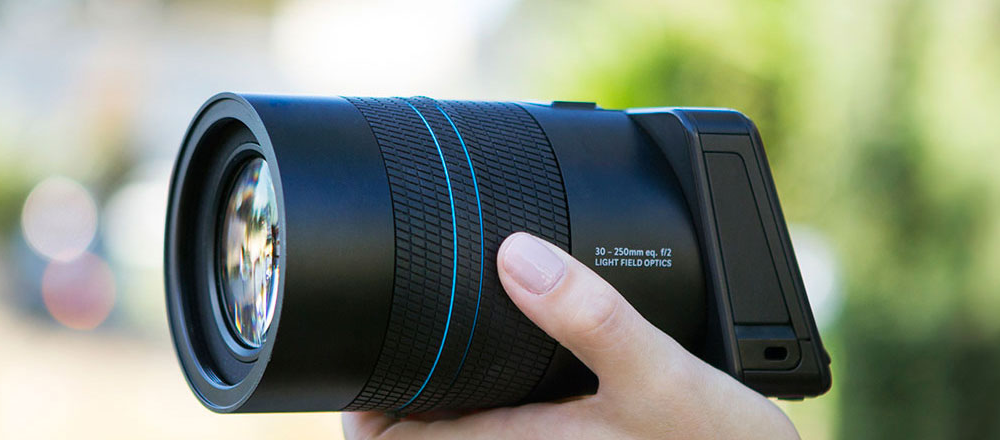
Unlike a conventional digital camera, the Lytro ILLUM captures the light field, which includes the direction of light. Most recently, light field cameras lived only in academic labs - via a roomful of cameras tethered to a supercomputer. Lytro's scientists and engineers have optimized this technology so that the power of the light field can fit right in your hands
Capturing this fundamentally new data gives consumers unprecedented capabilities, including the ability to focus, change the perspective, change the aperture, and view in 3D - all after a picture is taken. Photographers using the Lytro ILLUM have new creative opportunities to tell stories and capture moments, delivering Living Pictures to friends, family, and clients

Example of refocusing

Another example of refocusing

Using different points of view
Specifications
| Weight and Dimensions |
|---|
| Height: 3.4 inches (86 mm) |
| Width: 5.7 inches (145 mm) |
| Depth: 6.5 inches (166 mm) |
| Weight: 2.07 pounds (940 g) |
| Display |
| 4" Back-lit LCD rear touchscreen with capacitive multi-touch |
| 480-by-800-pixel resolution at 235 ppi |
| Adjustable Brightness |
| Live View Rendering |
| Dual hinge tilting articulation mechanism |
| Articulated Angles: -10 to +90 degrees |
| Angle of View: Up to 80 degrees |
| Image sensor |
| Light field sensor based on CMOS technology |
| Light Field Resolution: 40 Megaray |
| Sensor Format: 1/1.2" |
| Active Area: 10.82 x 7.52 mm |
| ISO Range: 80-3200 |
| Processor |
| Snapdragon® 800 processor by QUALCOMM® Incorporated |
| Lens |
| Focal Length: 9.5 - 77.8 mm (30 - 250 mm equivalent) |
| Crop Factor: 3.19 |
| Zoom: 8x optical |
| Lens Aperture: Constant /2.0 |
| Macro: Focus to 0 mm from lens front |
| Macro Ratio: 1 : 3 |
| Wireless |
| Wi-Fi (802.11a/b/g/n/ac) |
| Image format |
| Light Field RAW Format (.lfr) |
| 3 : 2 Aspect Ratio |
| 2D export resolution: 2450 x 1634 pixels |
| Shutter |
| Focal Plane Shutter |
| Fastest Shutter Speed: 1/4000 sec |
| Longest Shutter Speed: 32 seconds |
| Flash Sync Speed: 1/250 sec |
| Drive Modes: Single, continuous or self-timer |
| Self-Timer: Yes (2 or 10 seconds) |
| Continuous Drive: 3 fps |
| Power and battery |
| Removable 3.7 V, 3760 mAH Li-ion battery |
| Battery Charging via Standalone wall charger and USB |
Description
The NI USRP-2943R software defined radio platform provides an integrated hardware and software solution for rapidly prototyping high-performance wireless communication systems
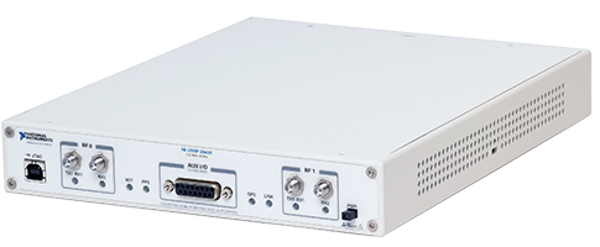
Each device is composed by one large digital motherboard, with a Xilinx Kintex-7 (410T) FPGA, and two RF transceivers, also called daughterboards, and it is housed in a half-1U rack-mountable form factor metallic case
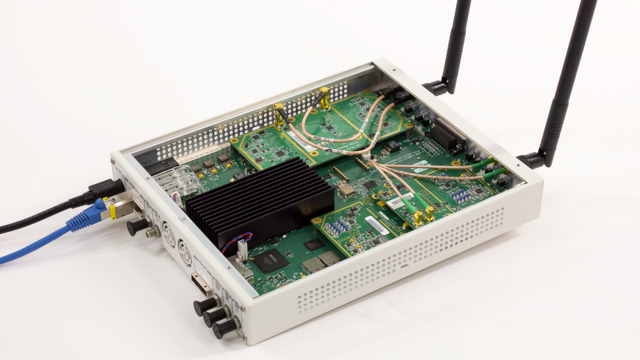
The Kintex-7 FPGA is a reconfigurable LabVIEW FPGA target that incorporates DSP48 coprocessing for high-rate, low-latency applications. With the flexible hardware architecture and the LabVIEW unified design flow, researchers can prototype faster and significantly shorten time to results
It is used to prototype a wide range of advanced research applications that include multiple input, multiple output (MIMO); synchronization of heterogeneous networks; LTE relaying; RF compressive sampling; spectrum sensing; cognitive radio; beamforming; and direction finding
The NI USRP-2943R main characteristics are:
- 2x2 MIMO RF transceivers with independently tunable options from 1.2 GHz to 6 GHz
- 120 MHz per channel real-time bandwidth featuring up to 80 dB of dynamic range
- Optimized RF performance with corrections for DC offset, I/Q imbalance, and amplitude accuracy
- Large reconfigurable DSP-oriented Xilinx Kintex-7 (410T) FPGA
- Unified LabVIEW design flow for host and FPGA
- Integrated support for .m file scripts, C libraries, and VHDL IP
- High-speed, low-latency PCI Express x4 (~800 MB/s) connection to the host computer
- Compatible with LabVIEW and the LabVIEW Communications System Design Suite

NI USRP-2943R Block diagram
The device can be programmed with National Instruments LabVIEW, that is a graphical programming tool

Example of LabVIEW program
Each device can be equipped with several daughterboards, depending on the needs and the system requirements. Comlab owns three different kind of daughterboards: the CBX-40, the CBX-120 and the WBX-120

CBX-40 daughterboard
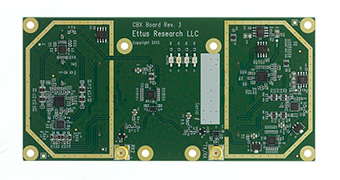
CBX-120 daughterboard
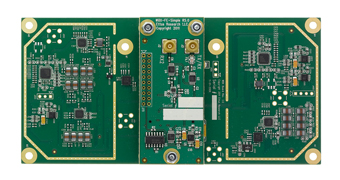
WBX-120 daughterboard
NI USRP-2943R specifications
| Transmitter section | |
|---|---|
| Number of channels | 2 |
| Frequency range (with the CBX daughterboards) | 1.2 GHz to 6 GHz |
| Frequency range (with the WBX-120 daughterboard) | 50 MHz to 2.2 GHz |
| Frequency step | <1 kHz |
| Maximum output power (Pout) (with the CBX daughterboards) 1.2 GHz to 3.5 GHz 3.5 GHz to 6 GHz | 50 mW ÷ 100 mW (17 dBm ÷ 20 dBm) 5 mW ÷ 32 mW (7 dBm ÷ 15 dBm) |
| Maximum output power (Pout) (with the WBX-120 daughterboard) 50 MHz to 1.2 GHz 1.2 GHz to 2.2 GHz | 50 mW ÷ 100 mW (17 dBm ÷ 20 dBm) 30 mW ÷ 70 mW (15 dBm ÷ 18 dBm) |
| Gain range (with the CBX daughterboards) | 0 dB to 31.5 dB |
| Gain range (with the WBX-120 daughterboard) | 0 dB to 31 dB |
| Gain step (with the CBX daughterboards) | 0.5 dB |
| Gain step (with the WBX-120 daughterboard) | 1.0 dB |
| Frequency accuracy - based on temperature-compensated crystal oscillator (TCXO) - based on optional GPS receiver | 2.5 ppm 25 ppb |
| Maximum instantaneous real-time bandwidth (with the CBX-120 and WBX-120 daughterboards) | 120 MHz |
| Maximum instantaneous real-time bandwidth (with the CBX-40 daughterboard) | 40 MHz |
| Maximum I/Q sample rate | 200 MS/s |
| Digital-to-analog converter (DAC) - Resolution - Spurious-free dynamic range (sFDR) | 16 bit 80 dB |
| Receiver section | |
| Number of channels | 2 |
| Frequency range (with the CBX daughterboards) | 1.2 GHz to 6 GHz |
| Frequency range (with the WBX-120 daughterboard) | 50 MHz to 2.2 GHz |
| Frequency step | <1 kHz |
| Gain range | 0 dB to 37.5 dB |
| Gain step | 0.5 dB |
| Maximum input power (Pin) | -15 dBm |
| Noise figure | 5 dB to 7 dB |
| Frequency accuracy - based on temperature-compensated crystal oscillator (TCXO) - based on optional GPS receiver | 2.5 ppm 25 ppb |
| Maximum instantaneous real-time bandwidth (with the CBX-120 and WBX-120 daughterboards) | 120 MHz |
| Maximum instantaneous real-time bandwidth (with the CBX-40 daughterboard) | 40 MHz |
| Maximum I/Q sample rate | 200 MS/s |
| Digital-to-analog converter (DAC) - Resolution - Spurious-free dynamic range (sFDR) | 14 bit 88 dB |
Description
Bringing innovation to the imaging experience. Record and recreate the real world in 360 degrees
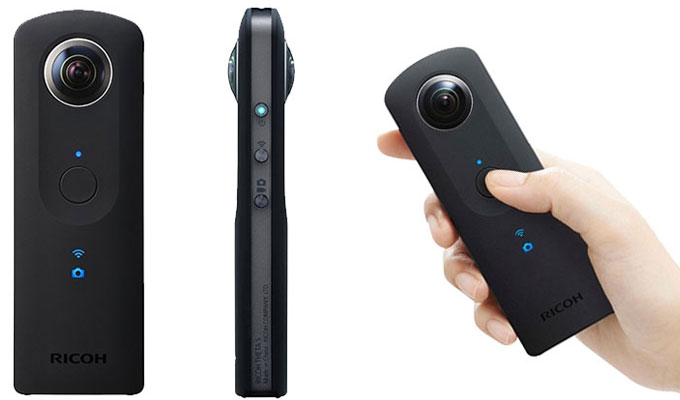
Deprecated: Function utf8_encode() is deprecated in /var/www/vhosts/comlab.uniroma3.it/httpdocs/comlab/resources/theta.php on line 5
High quality image with improved resolution delivers a more natural three-dimensional experience and coloring. 360º spatial audio lets you record sound from all directions. Realistically record images and audio of the world surrounding youto recreate inspiring moments
Deprecated: Function utf8_encode() is deprecated in /var/www/vhosts/comlab.uniroma3.it/httpdocs/comlab/resources/theta.php on line 6
Image data recorded on THETA S can be played back in 360º on a monitor such as TV. The THETA S also functions as a remote control which can be used to select the image file and move displayed 360º image up, down, left, and right. It can also zoom-in and out
Enjoy high-sensitivity shooting from ISO 3200 (still images) to ISO 6400 (videos, live streaming). This range of sensitivity is highly effective for shooting in dark scenes
This model is equipped with a new gyro sensor in addition to the conventional acceleration sensor. Tilt detection precision has been significantly improved, along with top/bottom correction precision enhancements and the ability for Remote Playback
Advanced image processing technology cultivated over the years in camera development deliver image quality with minimal loss of shadow detail and highlight blowout even in scenes with varying levels of contrast. The white balance algorithm has been completely retuned to achieve natural hues for a wide range of scenes
Deprecated: Function utf8_encode() is deprecated in /var/www/vhosts/comlab.uniroma3.it/httpdocs/comlab/resources/theta.php on line 10
This model supports 4K compatible 360 degree live streaming. Output the 4K (3840x1920 pixels), 360º image in real-time
RICOH THETA S is compatible with the Google Street View app. The app enables you to record and publish 360 video (as Street View) to Google Maps
RICOH THETA S specifications
| Object distance | Approx. 10cm - ∞ (from front of lens) |
| Shooting mode | Still image: Auto, shutter priority, ISO priority, manual Video: Auto Live streaming: Auto |
| Exposure control mode | Program AE, Shutter speed priority AE, ISO sensitivity AE, Manual exposure |
| Exposure compensation | Still image: Manual compensation (-2.0 - +2.0EV, 1/3EV step) |
| ISO sensitivity (standard output sensitivity) | Still image: ISO 100 - 1600 Video: ISO 100 - 1600 Live streaming: ISO 100 - 1600 |
| White balance mode | Still image: Auto, Outdoor, Shade, Cloudy, Incandescent light 1, Incandescent light 2, Daylight color fluorescent light, Natural white fluorescent light, White fluorescent light, Light bulb color fluorescent light, Color temperature specification shots Video: Auto Live streaming: Auto |
| Shutter speed | Still image: (Excluding Mnual mode) 1/6400 - 1/8 seconds, (Manual mode) 1/6400 - 60 seconds Video: (L) 1/8000 - 1/30 seconds, (M) 1/8000 - 1/15 seconds Live streaming: (USB) 1/8000 - 1/15 seconds, (HDMI) 1/8000 - 1/30 seconds |
Some examples of 3D images
Click the images above to see them in Panoramic mode
Depth-Image-Based-Rendering (DIBR) techniques are essential for three dimensional (3D) video applications such as 3D Television (3DTV) and Free-Viewpoint Video.
However, this process is based on 3D warping and can induce serious distortions whose impact on the perceived quality is far different from the one experienced in the 2D imaging processes.
Since quality evaluation of DIBR-synthesized views is fundamental for the design of perceptually-friendly 3D video systems, an appropriate objective quality metric targeting the assessment of DIBR-synthesized views is momentous.
Most of 2D objective quality metrics fail in assessing the visual quality of DIBR-synthesized views because they have not been conceived for addressing the specificities of DIBR-related distortions.
In this paper, a new fullreference objective quality metric dedicated to artifacts detection in DIBR-synthesized view-points is presented.
The proposed scheme relies on a comparison of statistical features of wavelet subbands of two input images: the original image and the DIBR-based synthesized image.
A registration step is included before the comparison step so that best matching blocks are always compared to ensure "shifting-resilience".
In addition, a skin detection step weights the final quality score in order to penalize distorted blocks containing "skin-pixels" based on the assumption that a human observer is most sensitive to impairments affecting human subjects.
We are making the objective metric available to the research community free of charge.
If you use this database in your research, we kindly ask that you reference our paper listed below:
F. Battisti, E. Bosc, M. Carli, P. Le Callet, and S. Perugia 'Objective Image Quality Assessment of 3D Synthesized Views', Signal Processing: Image Communication, Volume 30, January 2015, Pages 78-88, doi:10.1016/j.image.2014.10.005.
The investigators in this research are:
- Dr. Federica Battisti
- Dr. Emilie Bosc
- Dr. Marco Carli
- Prof. Patrick Le Callet
- Simone Perugia
16 Light Field (LF) images are included in the SMART LF dataset.
The images are from both indoor and outdoor category, and cover general image content related features (colorfulness, spatial information, and texture) but also LF specific aspects such as reflection, transparency and depth of field variation.
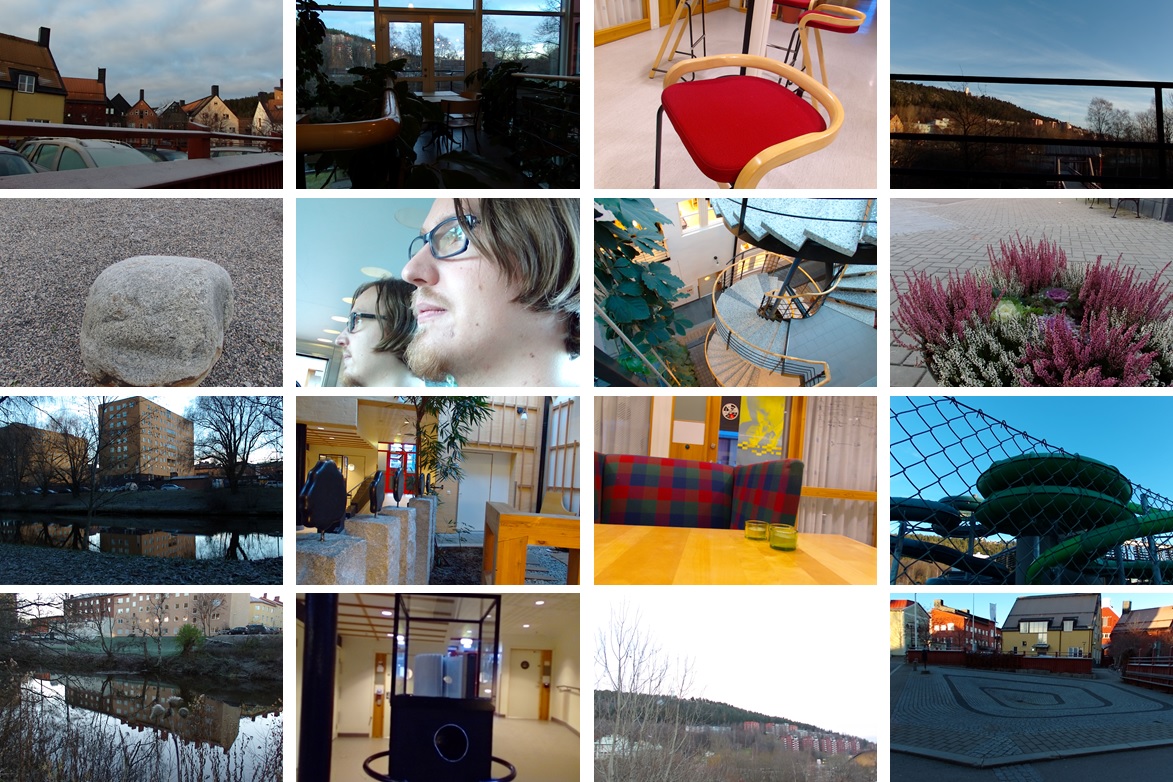
If you use this dataset please cite the following papers:
- P. Paudyal, F. Battisti, M. Sjöström, R. Olsson, and M. Carli, 'Towards the Perceptual Quality Evaluation of Compressed Light Field Images', in IEEE Transactions on Broadcasting, vol.PP, no.99, pp.1-16, doi: 10.1109/TBC.2017.2704430
- P. Paudyal, R. Olsson, M. Sjöström, F. Battisti, M. Carli, 'SMART: a Light Field image quality dataset', Procs. of the ACM Multimedia Systems 2016 Conference (MMSys 2016), Austria, May 10-13, 2016
Download LF dataset
The investigators in this research are:
- Dr. Federica Battisti
- Dr. Marco Carli
- Dr. Roger Olsson
- Dr. Pradip Paudyal
- Prof. Mårten Sjöström
Contacts
How to contact us
Building Corpo B
3rd floor - room 3.3
00146 - Rome - Italy
Deprecated: Function utf8_encode() is deprecated in /var/www/vhosts/comlab.uniroma3.it/httpdocs/comlab/subpages/dove_siamo.php on line 31
N 41?51'17.593"
Deprecated: Function utf8_encode() is deprecated in /var/www/vhosts/comlab.uniroma3.it/httpdocs/comlab/subpages/dove_siamo.php on line 32
E 12?28'15.164"
Where we are
How to reach us
 By taxi
By taxi
The cost is about 15 Euro.
 By bus
By bus
In Piazza dei Cinquecento, take bus 170 and get off at the stop Marconi/Bortolotti in Viale Guglielmo Marconi, 446.
Continue walking in the same direction for a few meters to reach via Corrado Segre, walk 50 meters until the end of the street and you will reach via Vito Volterra, 60 (see below).
The bus/subway ticket costs 1,50 Euro and it is valid for one subway trip and unlimited bus ride for 75 minutes.
 By subway (Metropolitana)
By subway (Metropolitana)
Take linea B (direction Laurentina) and get off at Basilica S.Paolo.
From the subway station take the exit for via Ostiense and Basilica S.Paolo, walk through viale Giustiniano Imperatore (leaving the church San Paolo on your right).
At the second traffic-light turn left to via Tullio Levi-Civita and go straight to reach viale Guglielmo Marconi cross it and take via Corrado Segre, walk 50 meters until the end of the street and you will reach via Vito Volterra, 60 (see below).
The bus/subway ticket costs 1,50 Euro and it is valid for one subway trip and unlimited bus ride for 75 minutes.
 By taxi
By taxi
The cost is about 45 Euro.
 By train
By train  By bus
By bus
Take train FL1 and get off at Roma Trastevere railway station. Then bus 170 (follow the indication from Termini Station).
The one way train ticket costs 8 Euro.
How to avoid getting lost
At the gate (via Vito Volterra, 60) enter and continue straight following the internal pahway
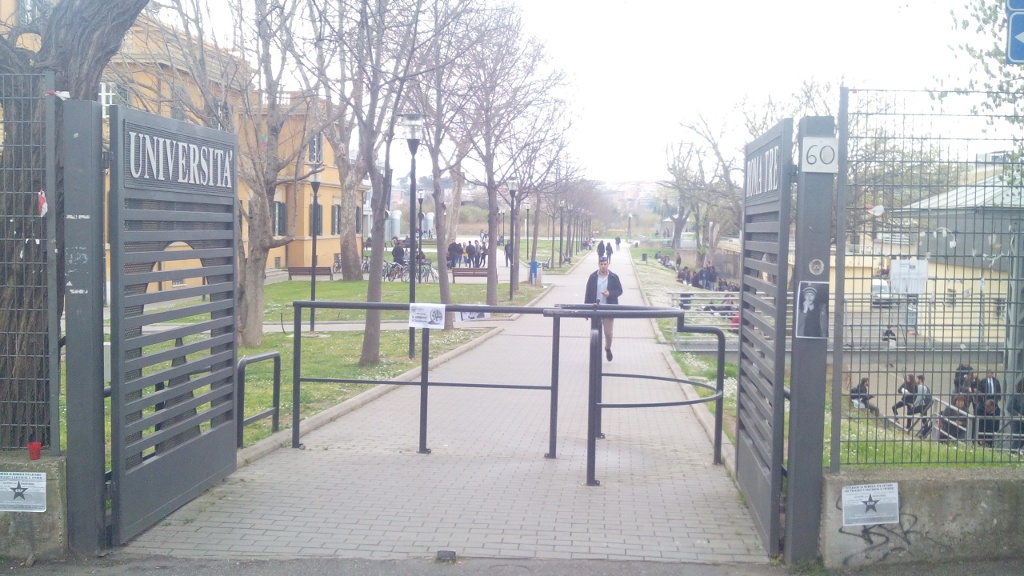
Via Vito Volterra, 60
The building we are in is the metal and glass modern building on the left
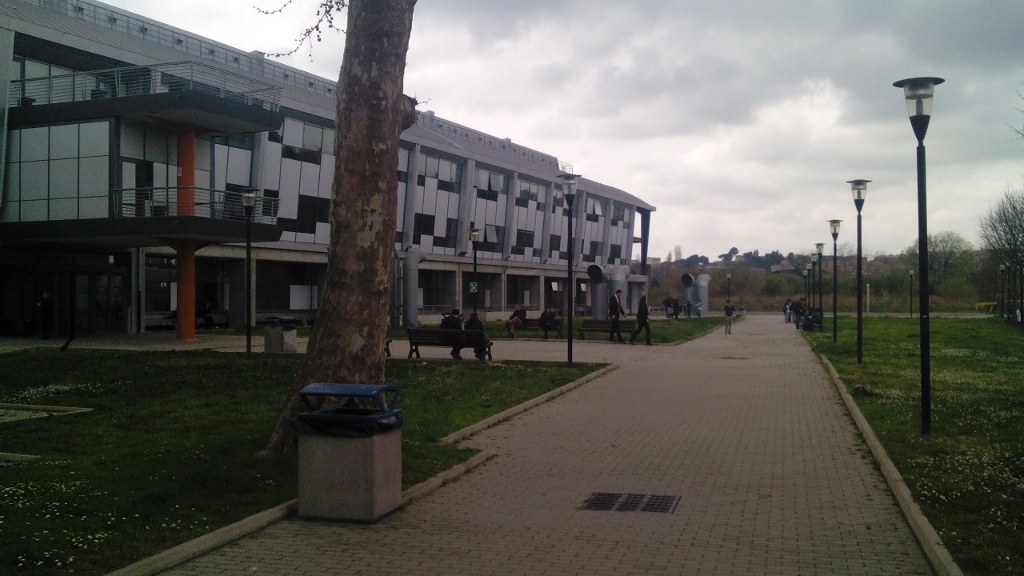
Internal pathway
Enter the door, overpass the reception desk and take the elevator on the right
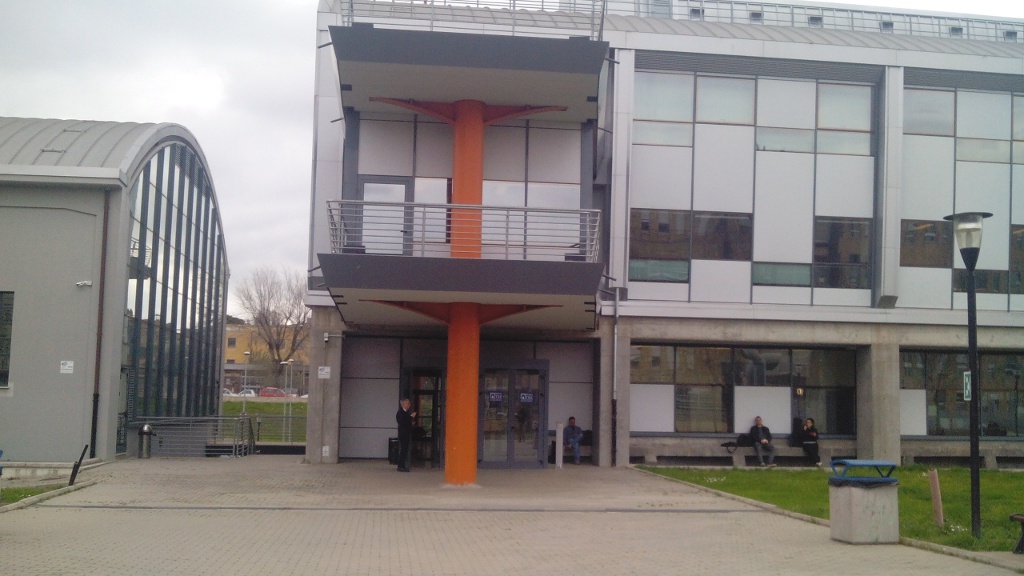
Building entrance
On the third floor, get off the elevator, turn right, go past the orange door and follow the corridor
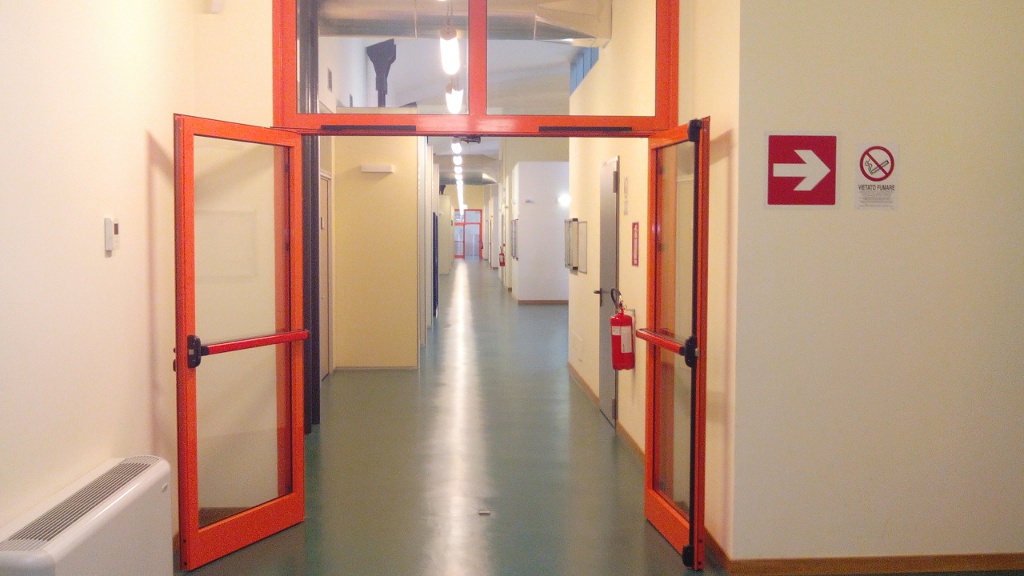
Third floor corridor
The Comlab entrance (room 3.3) is on the right opposite room 3.21 and is immediately after the men's bathroom
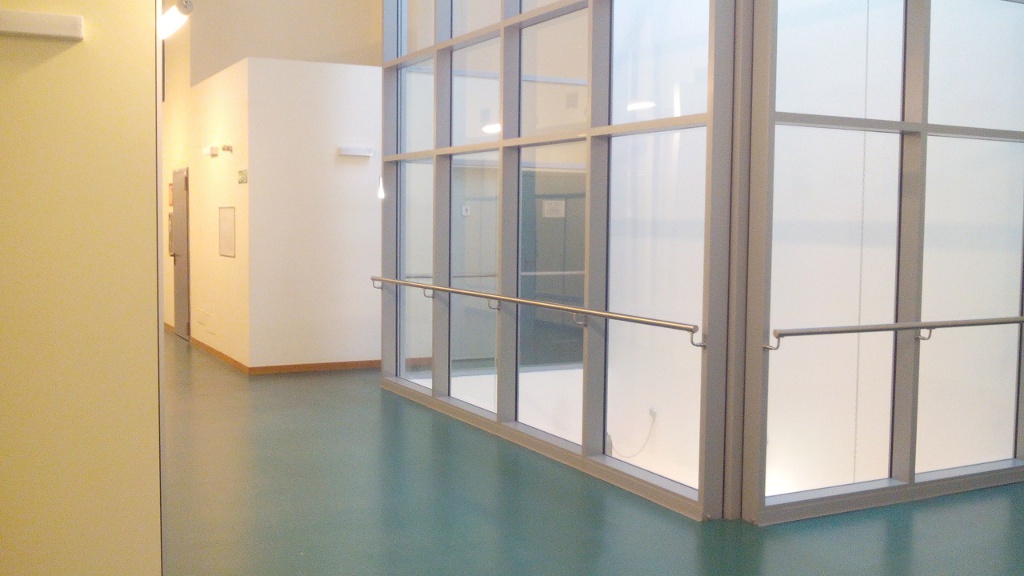
Comlab entrance
Where to sleep
Since Engineering Department is in one of the most touristic places in Rome, near the Basilica of St. Paul outside the Walls, there are several possibilities to stay in the immediate surroundings.
How will be the weather
Webpage content updated to: 30 March 2023 09:15





